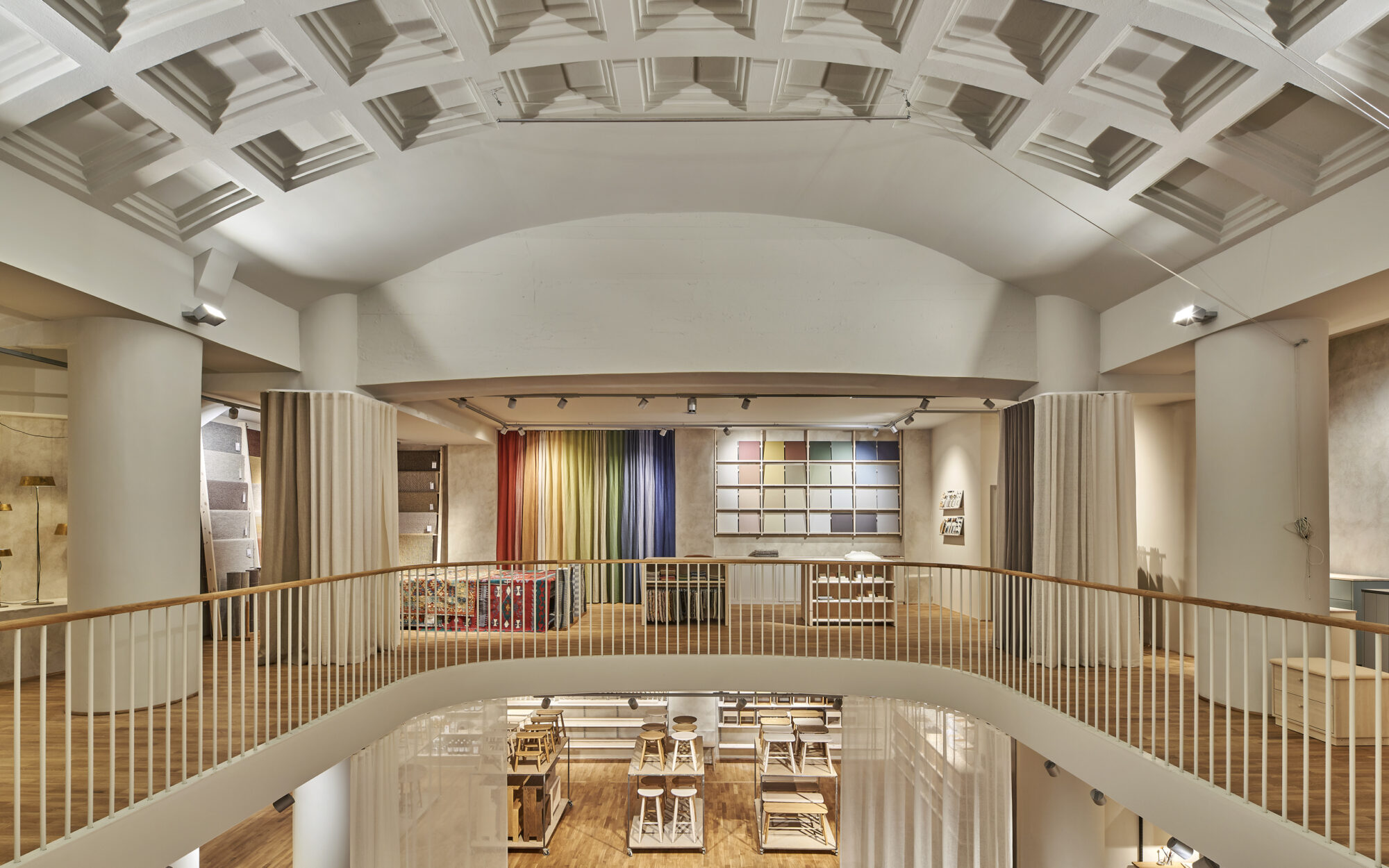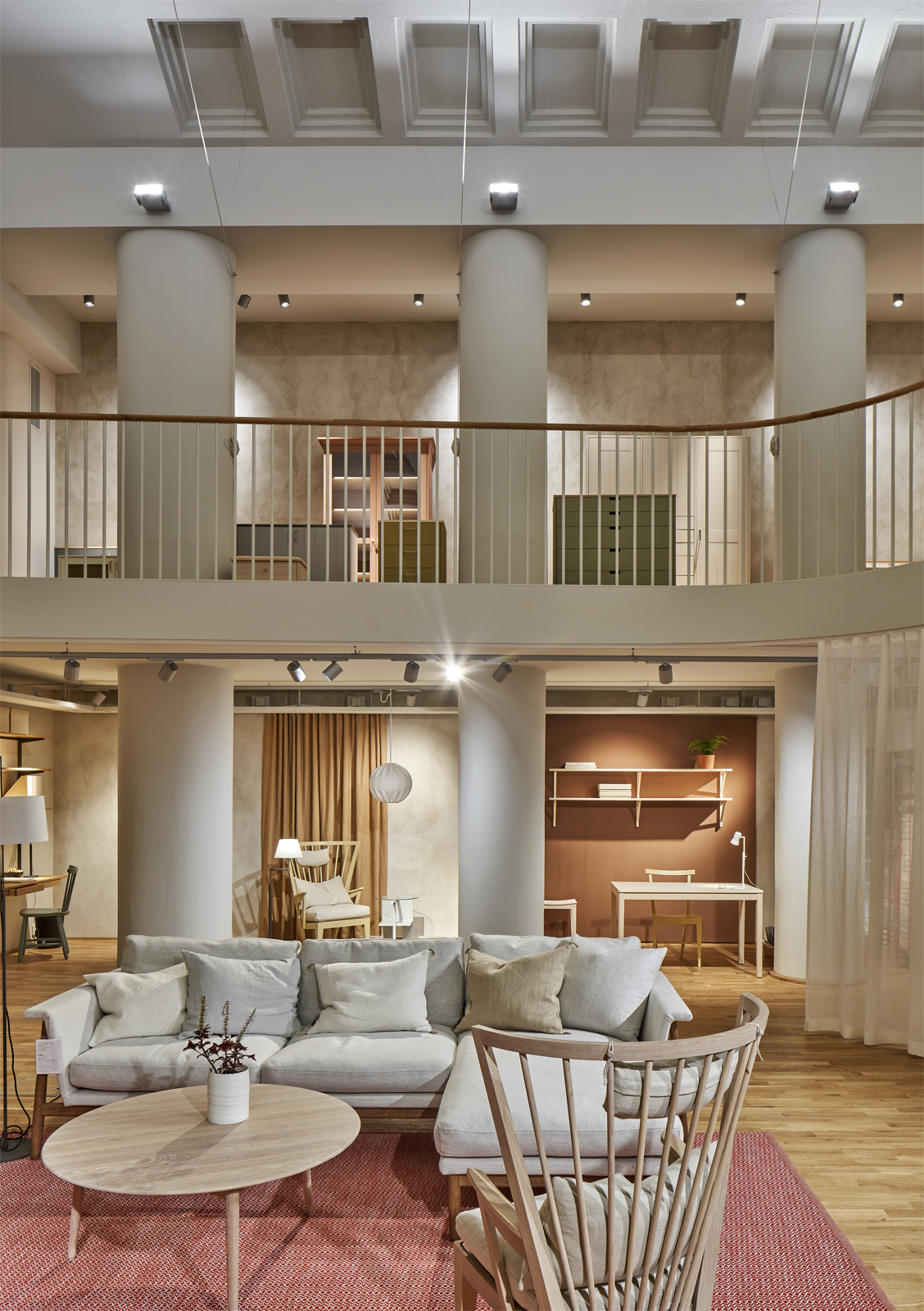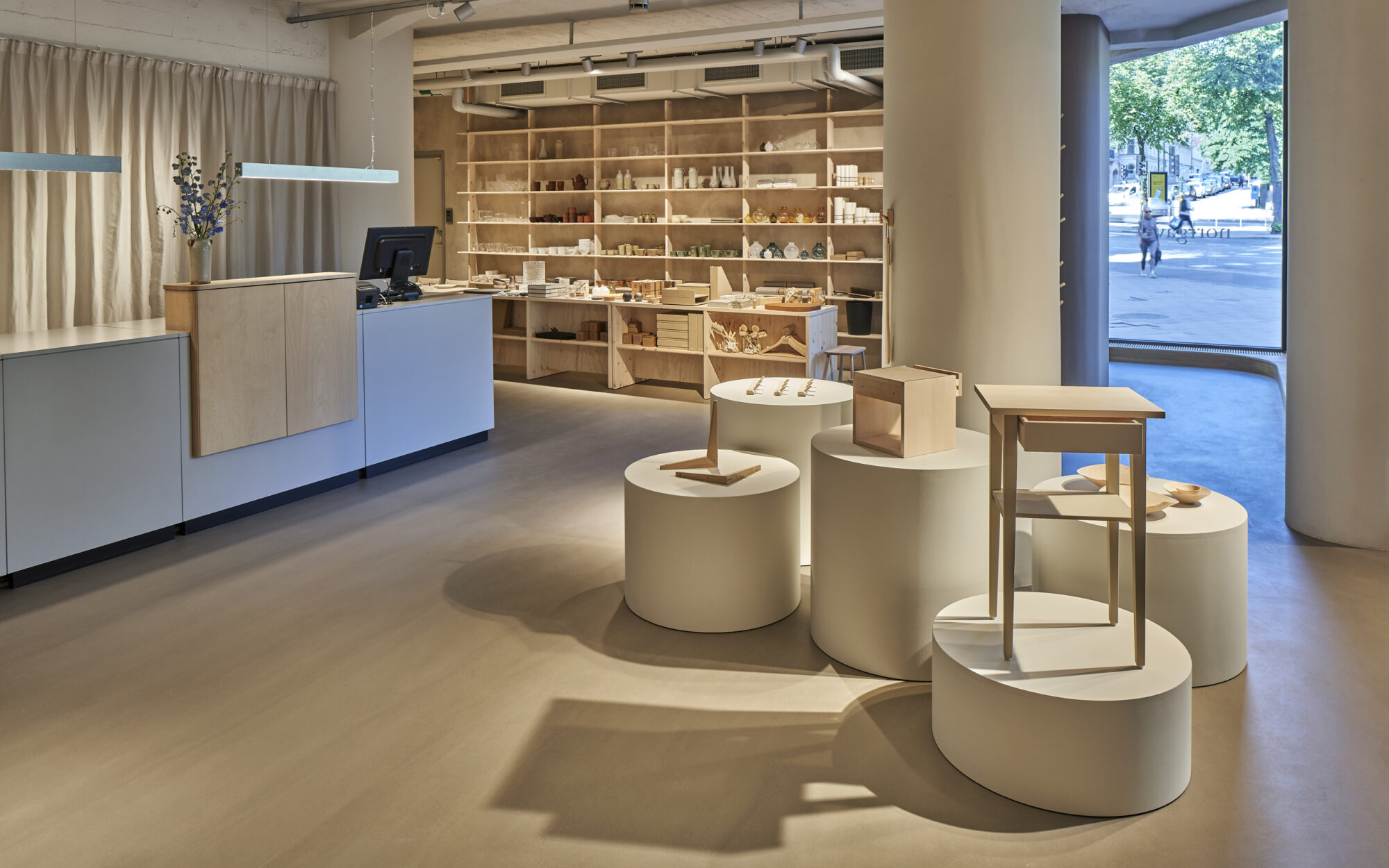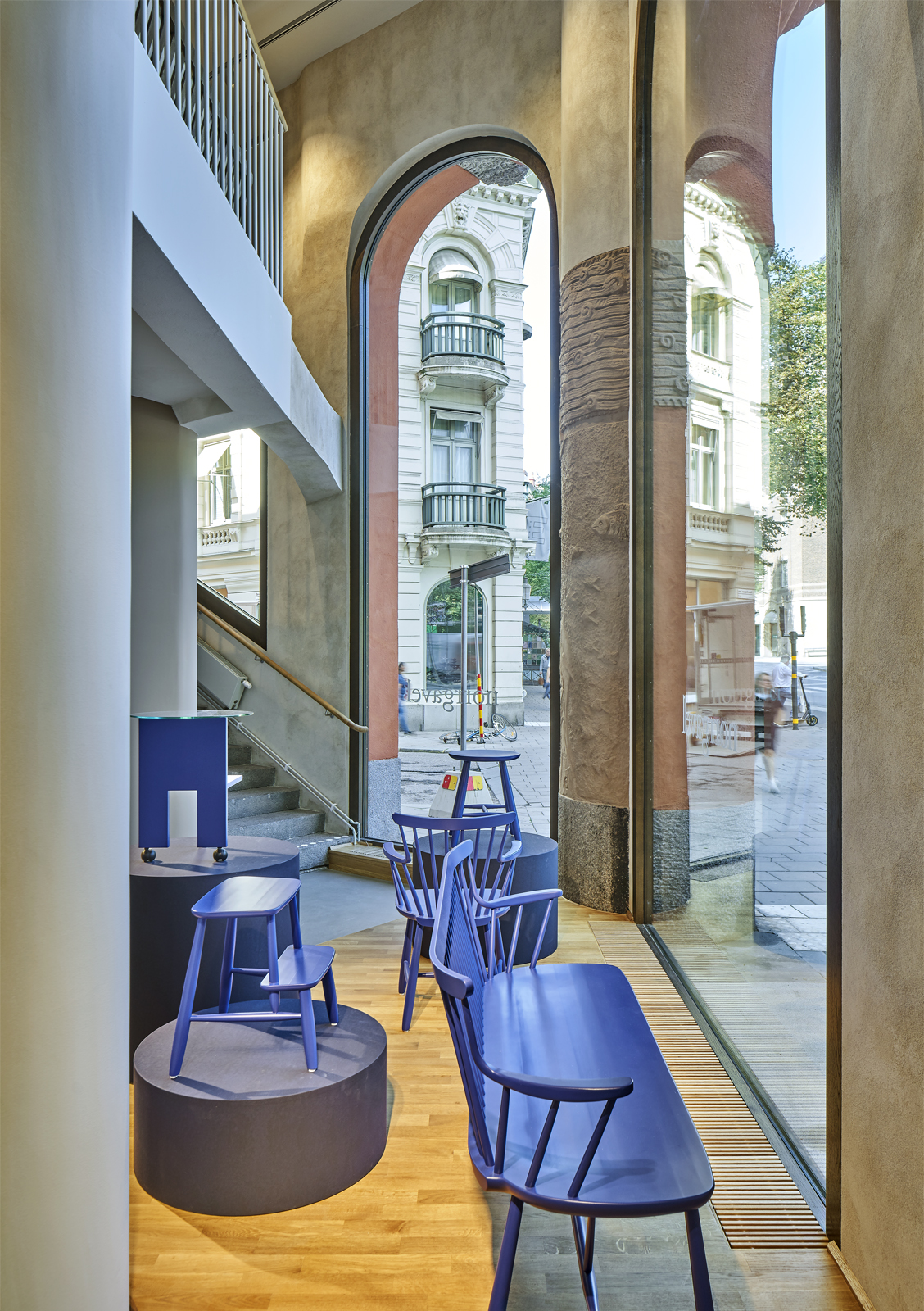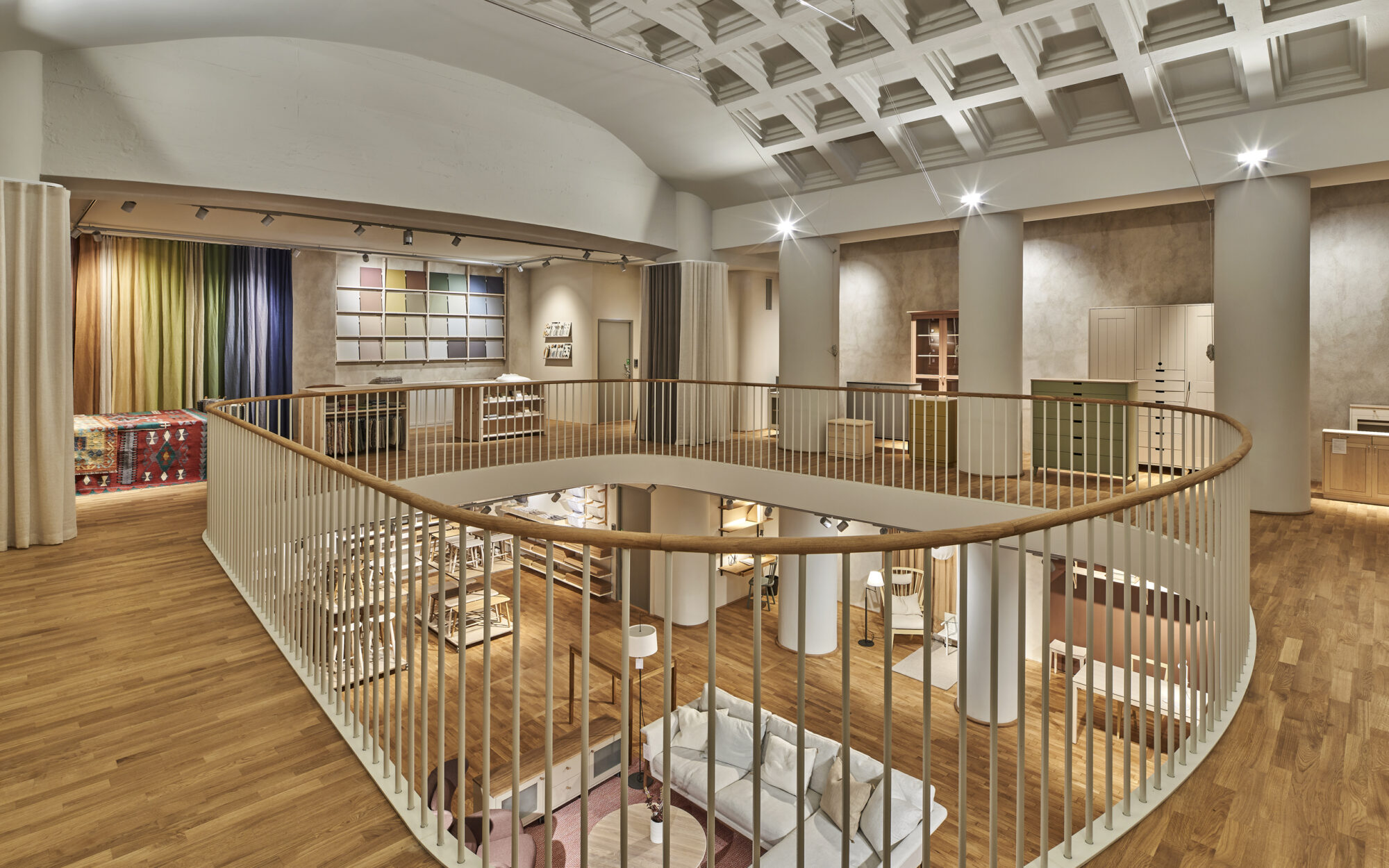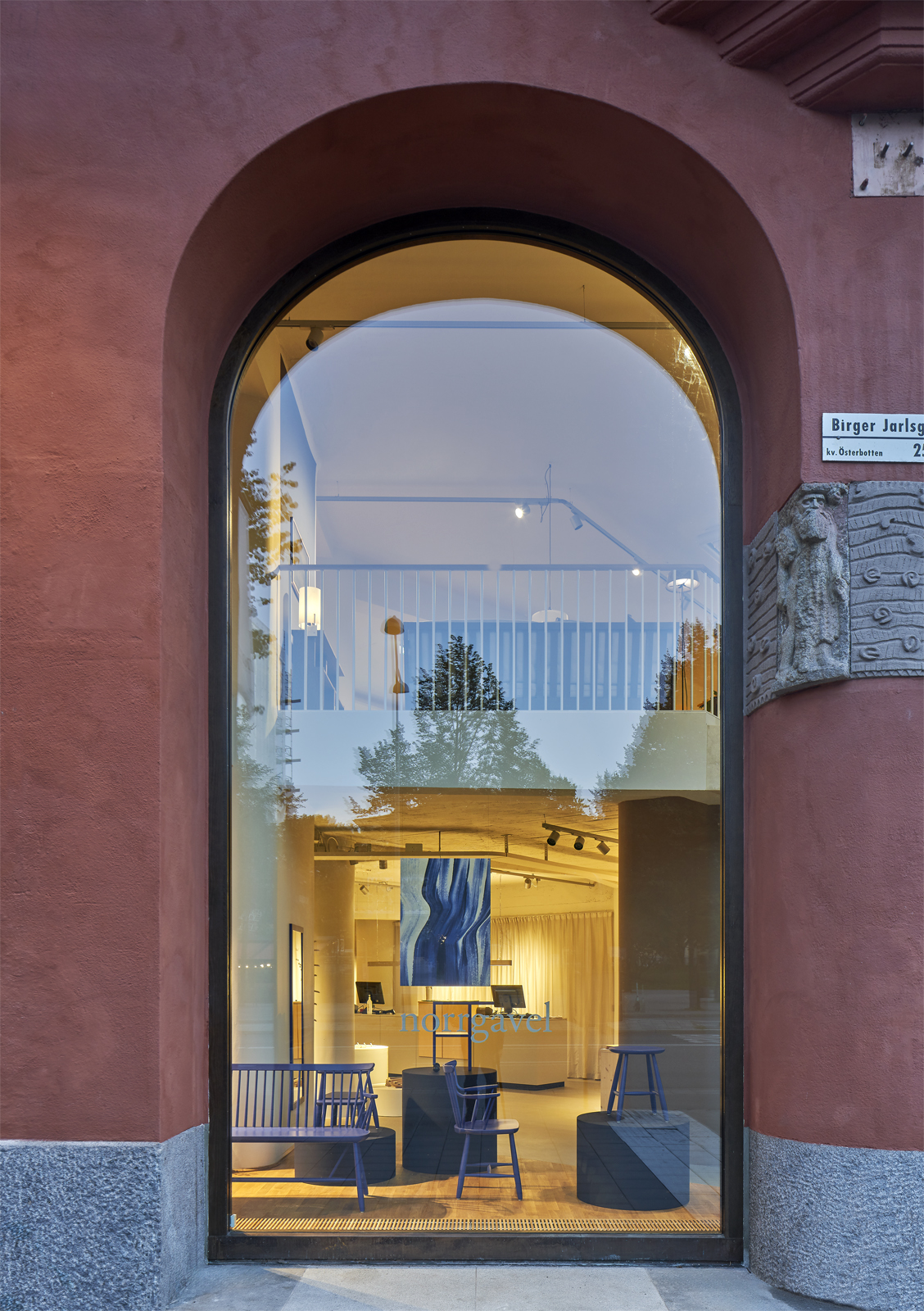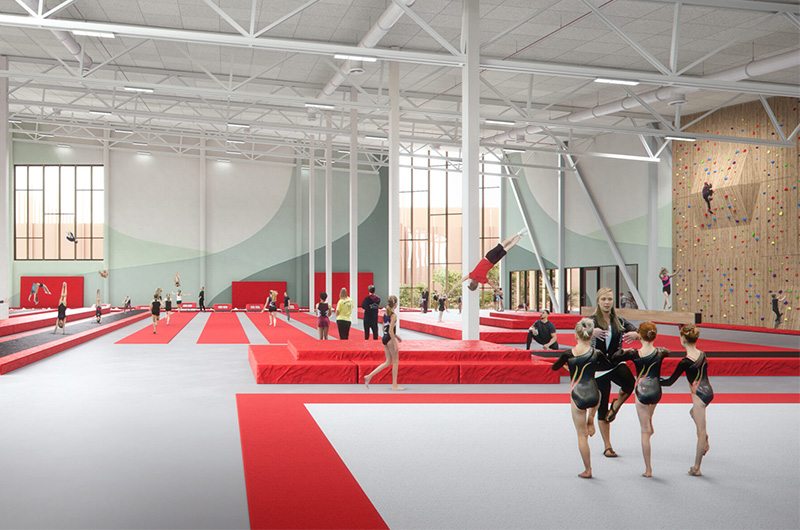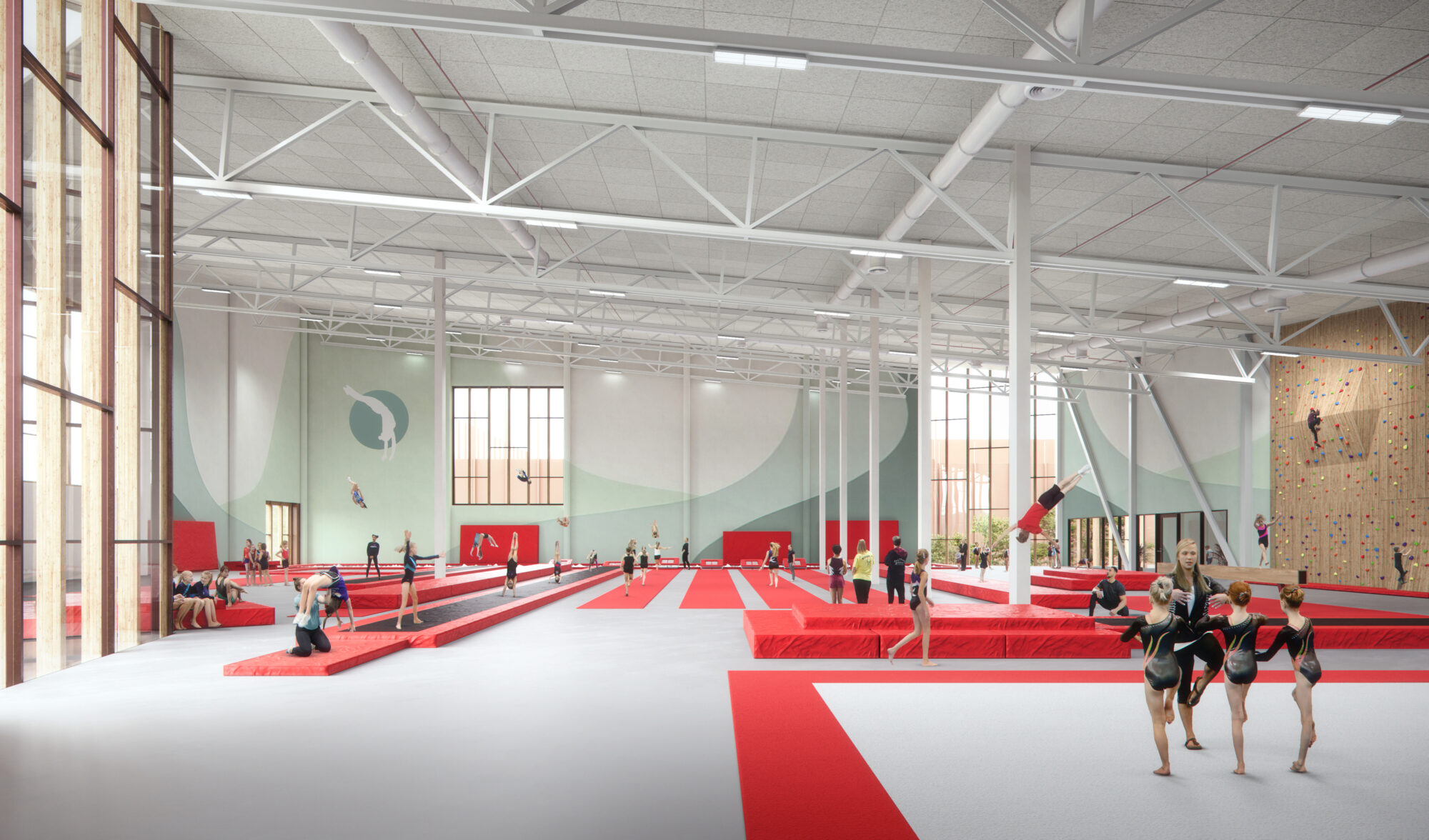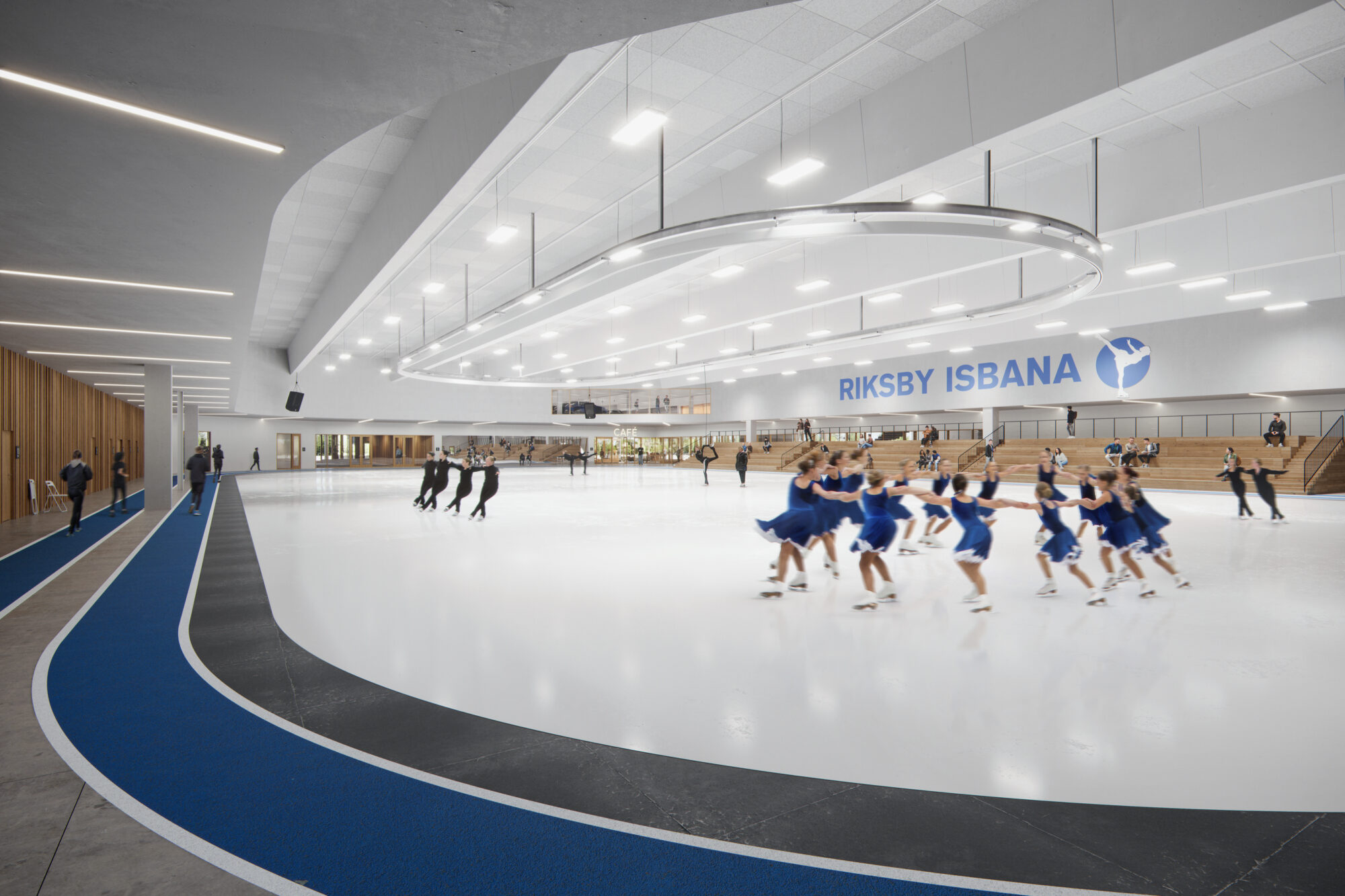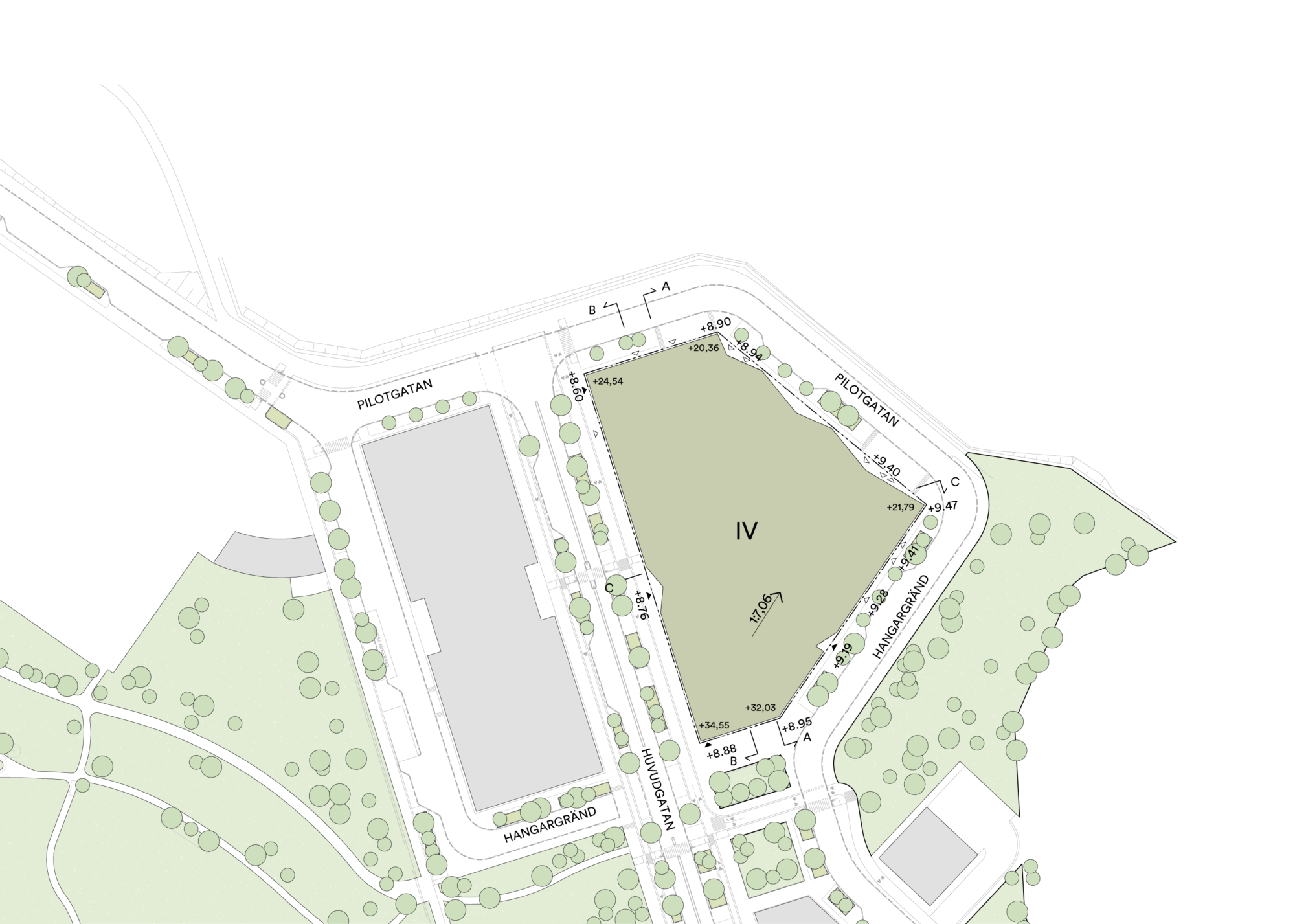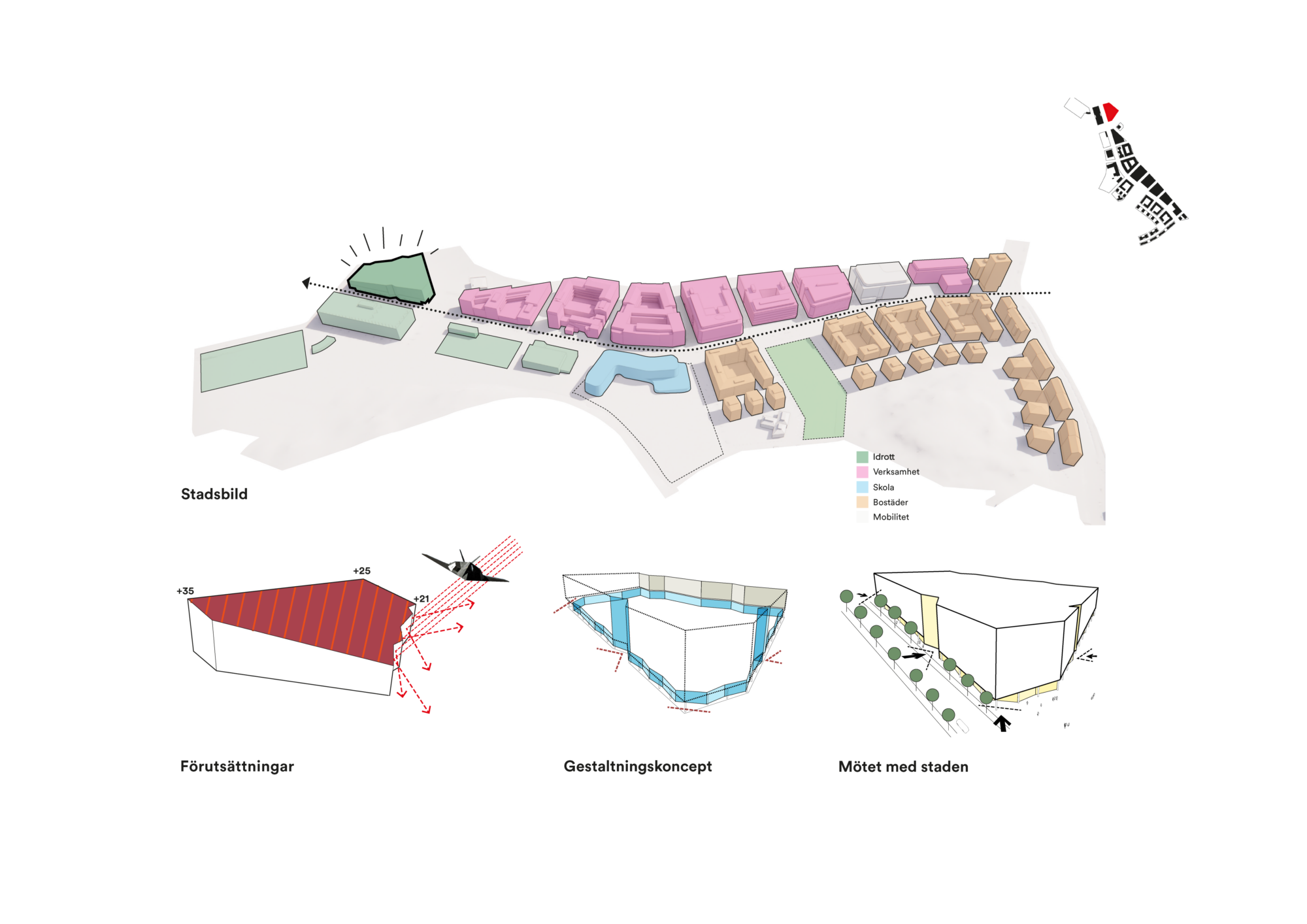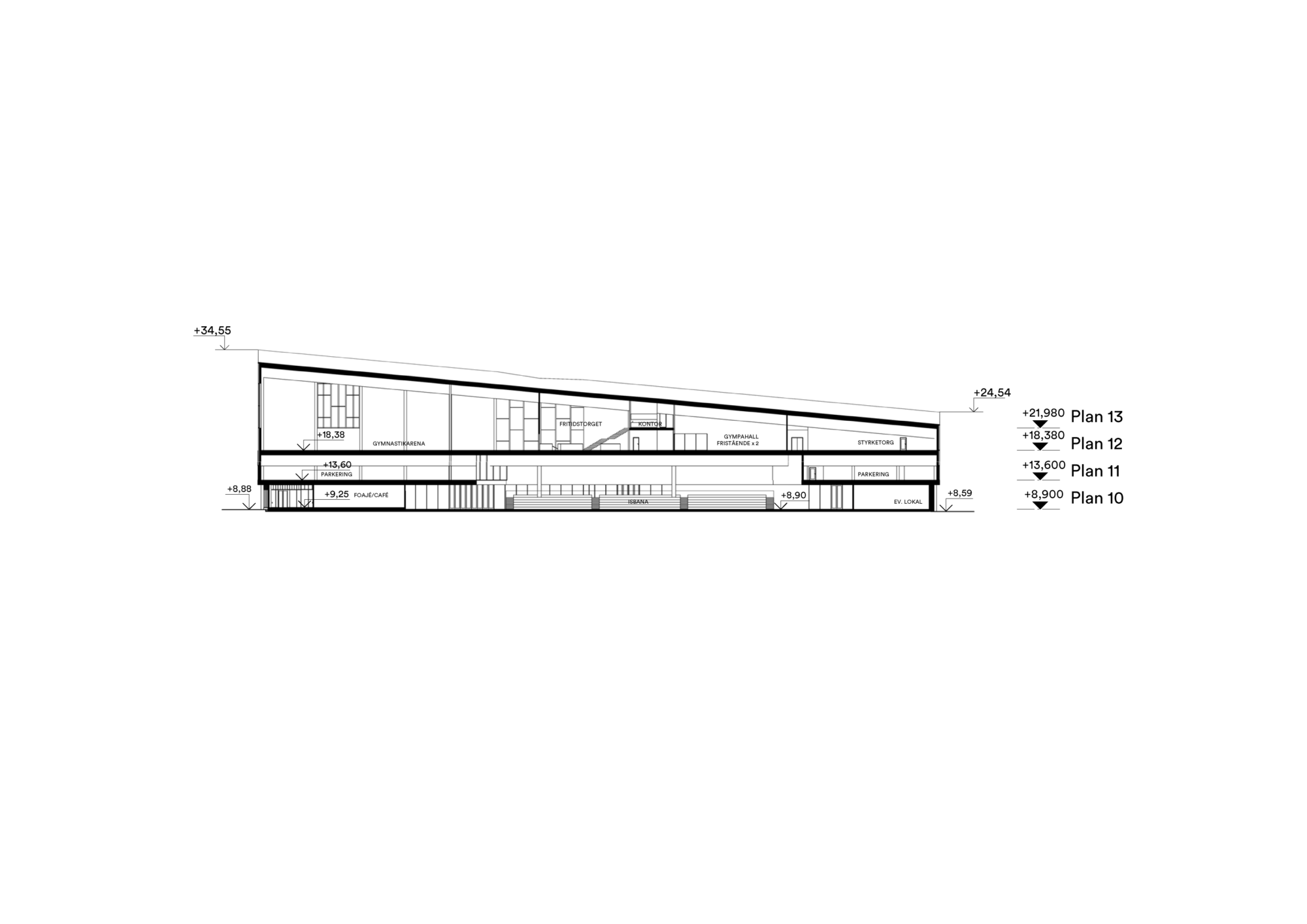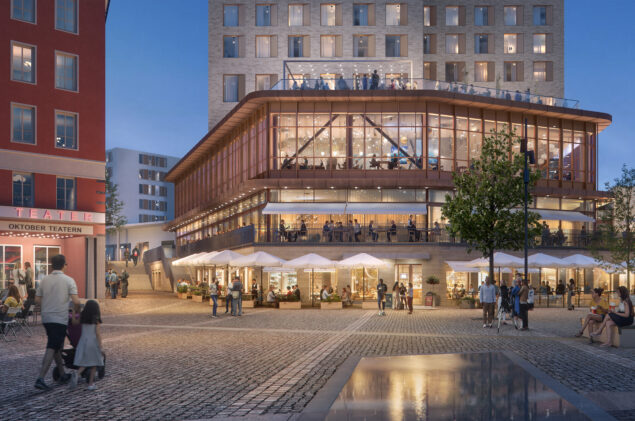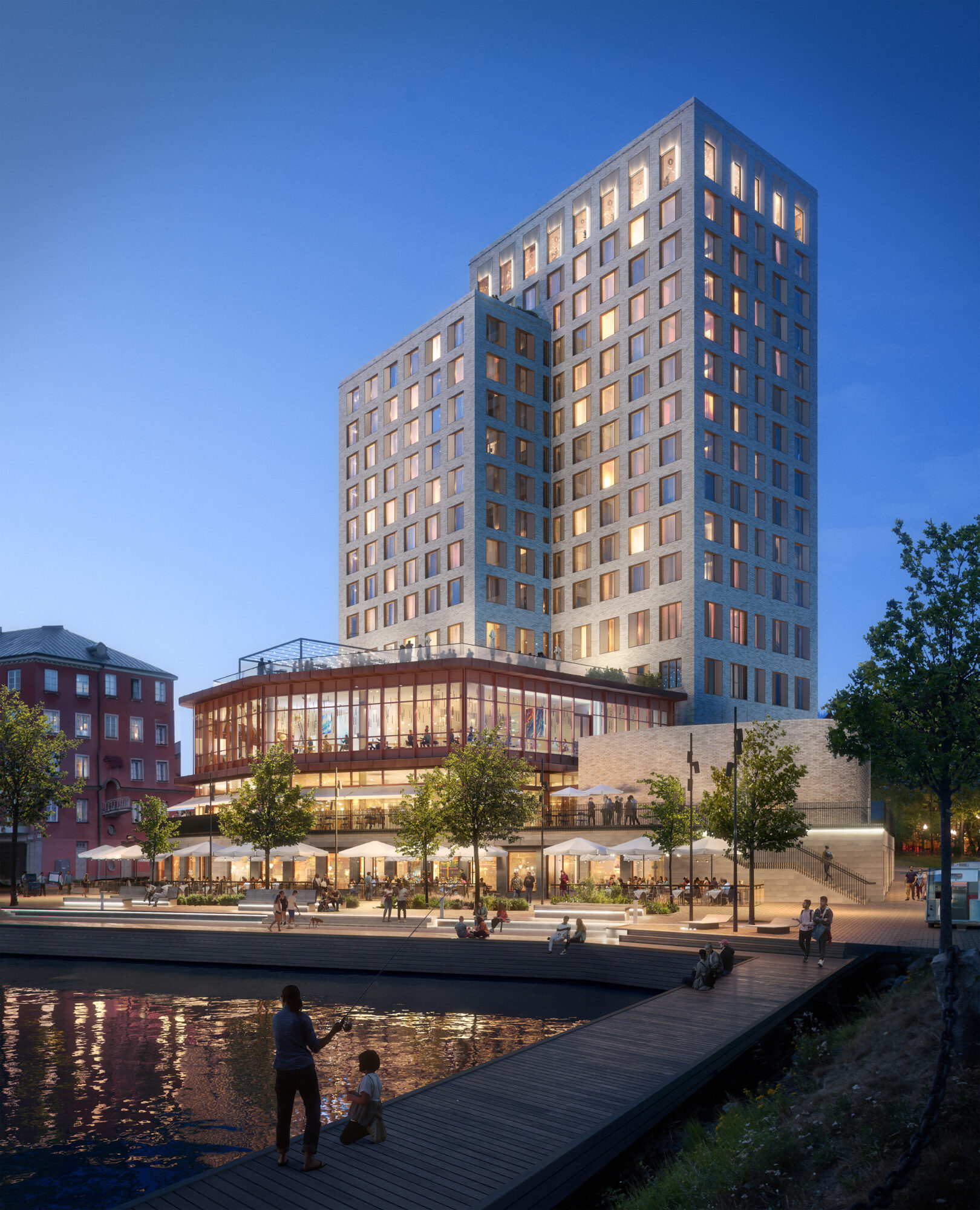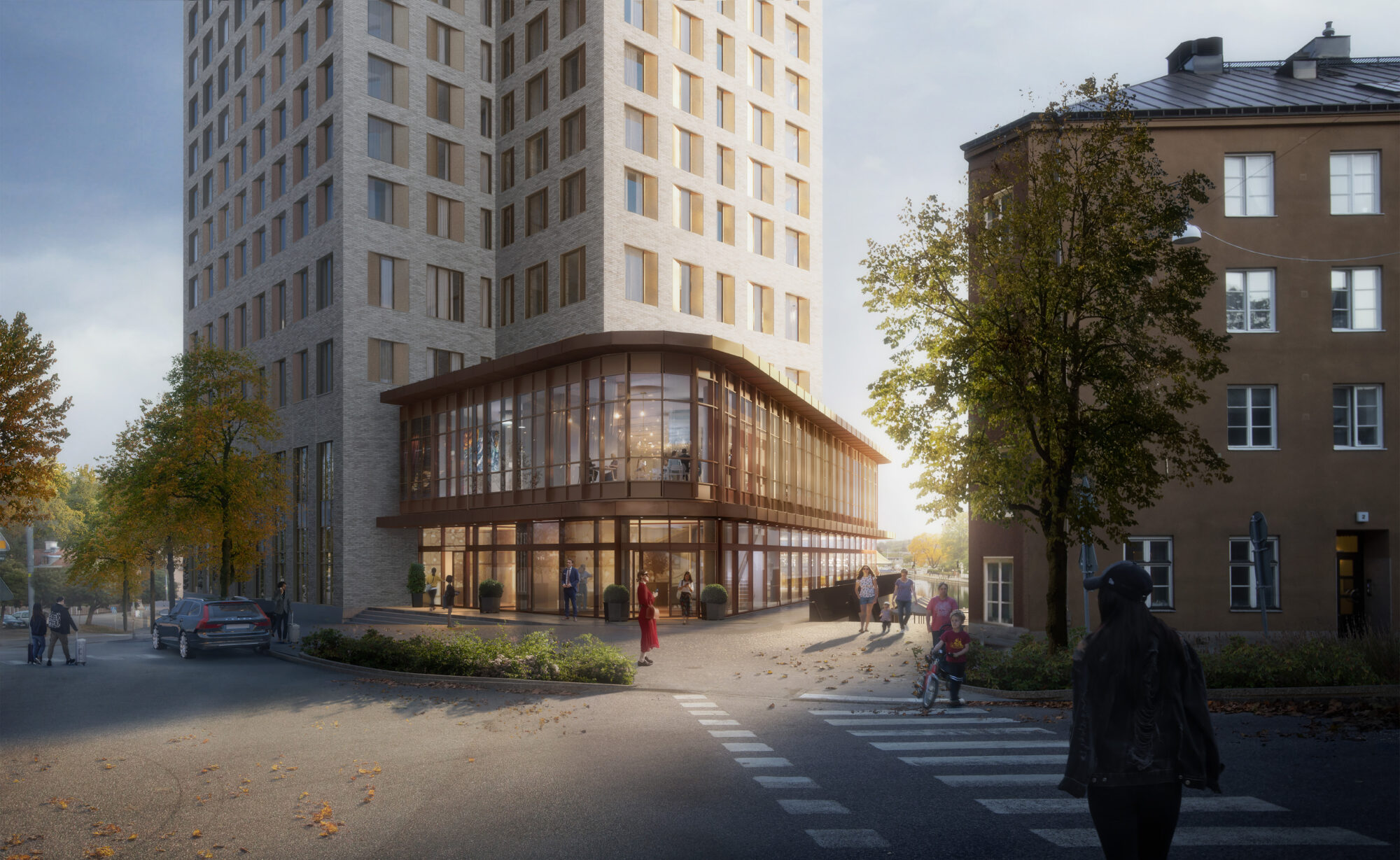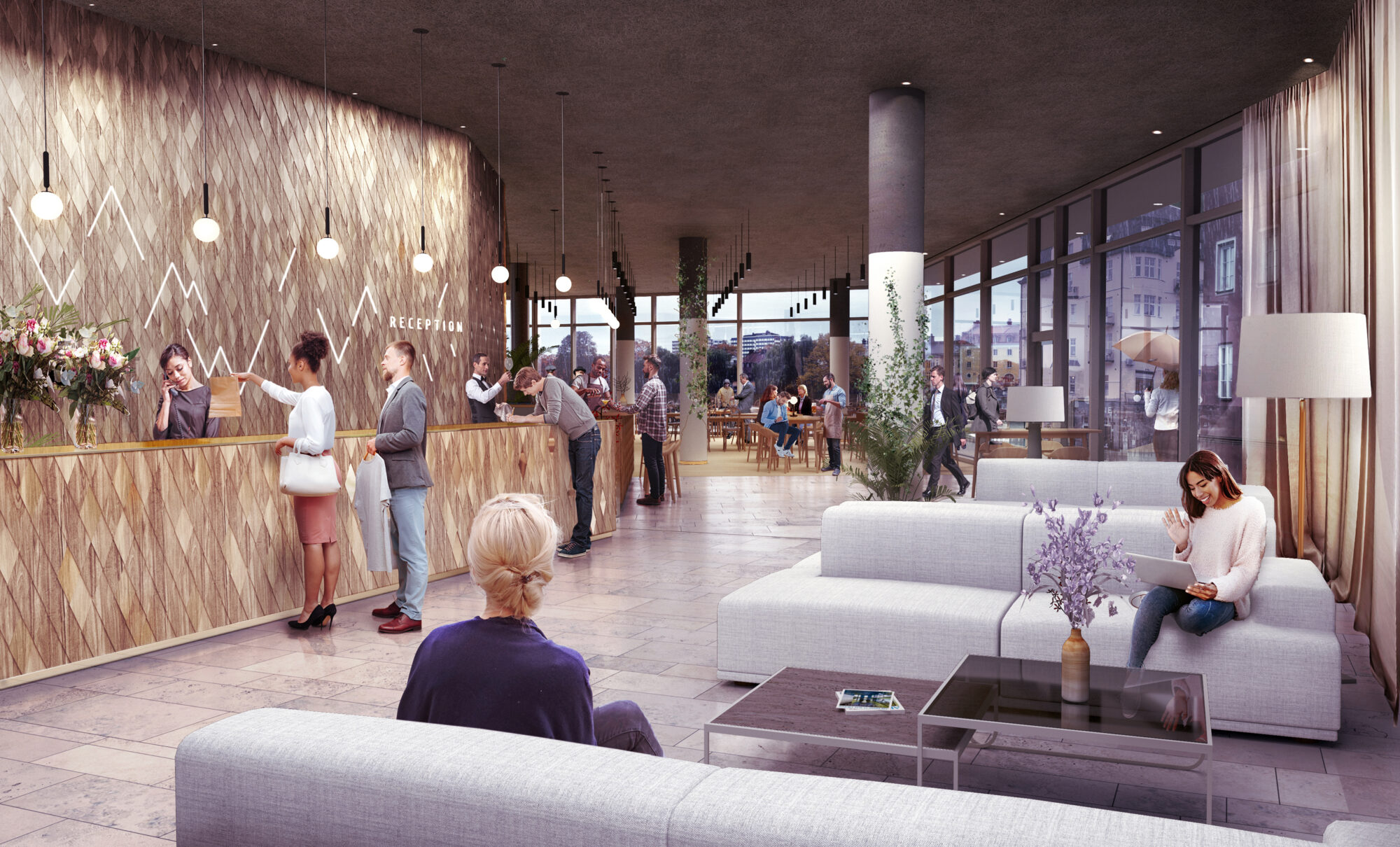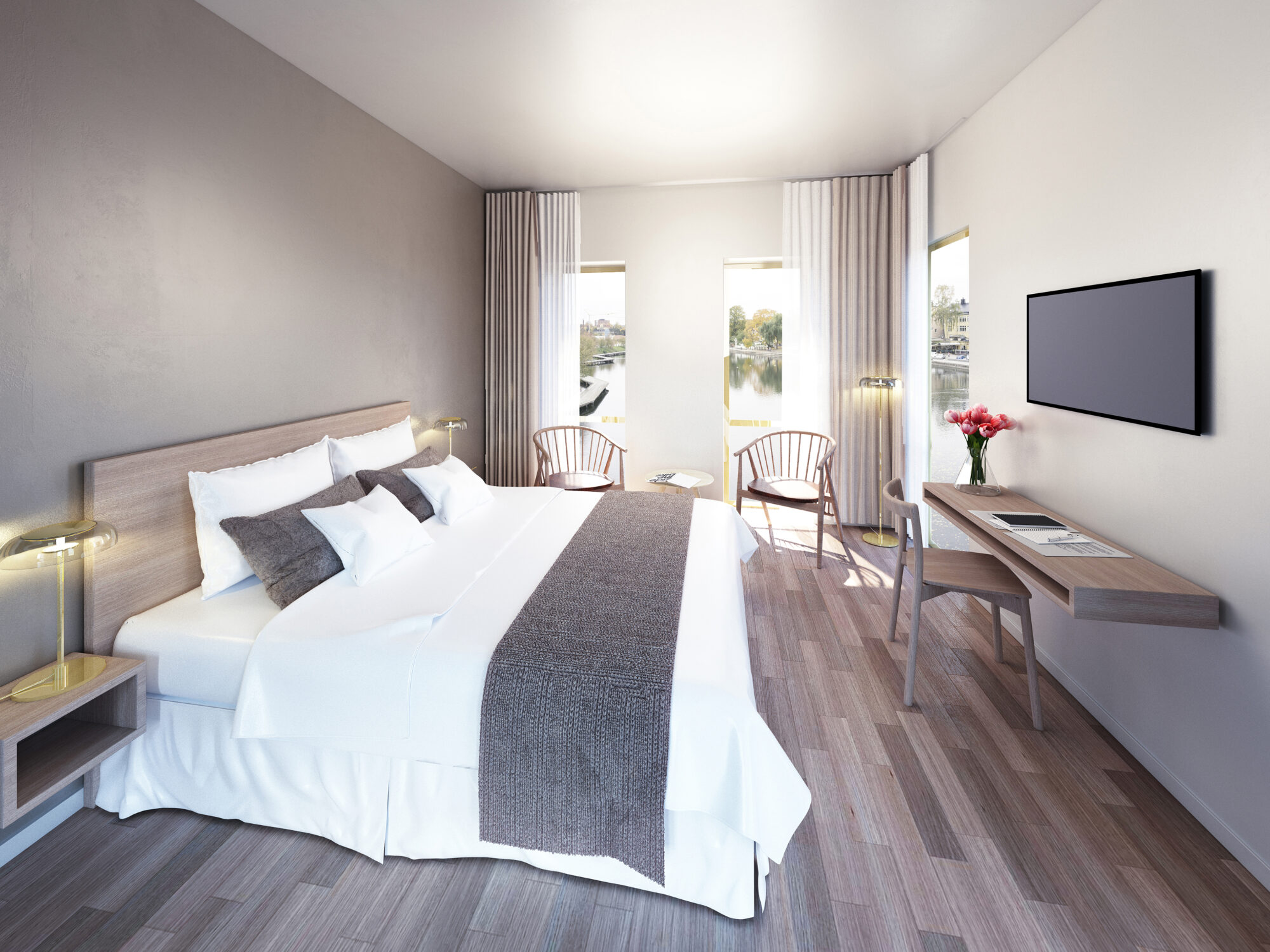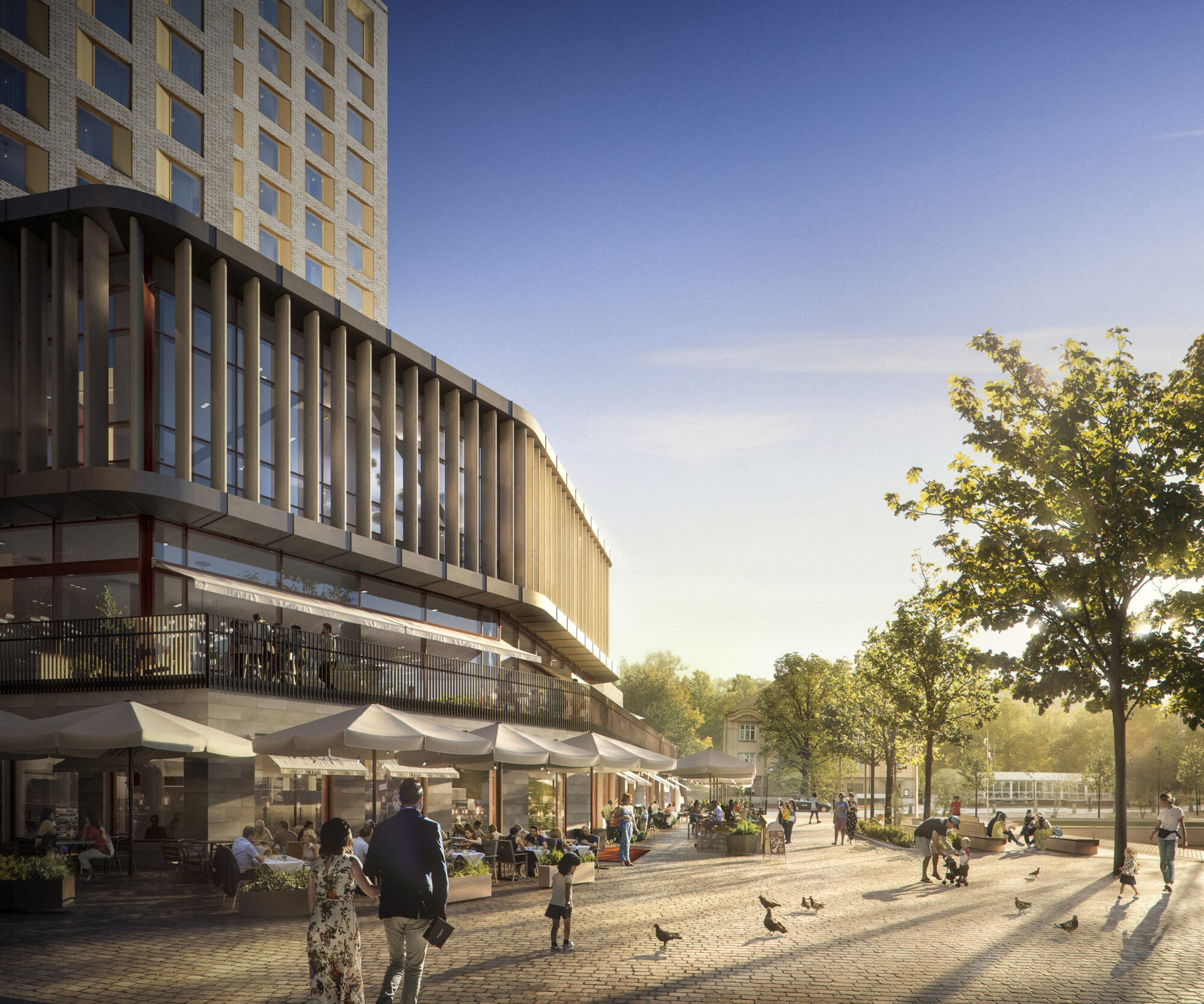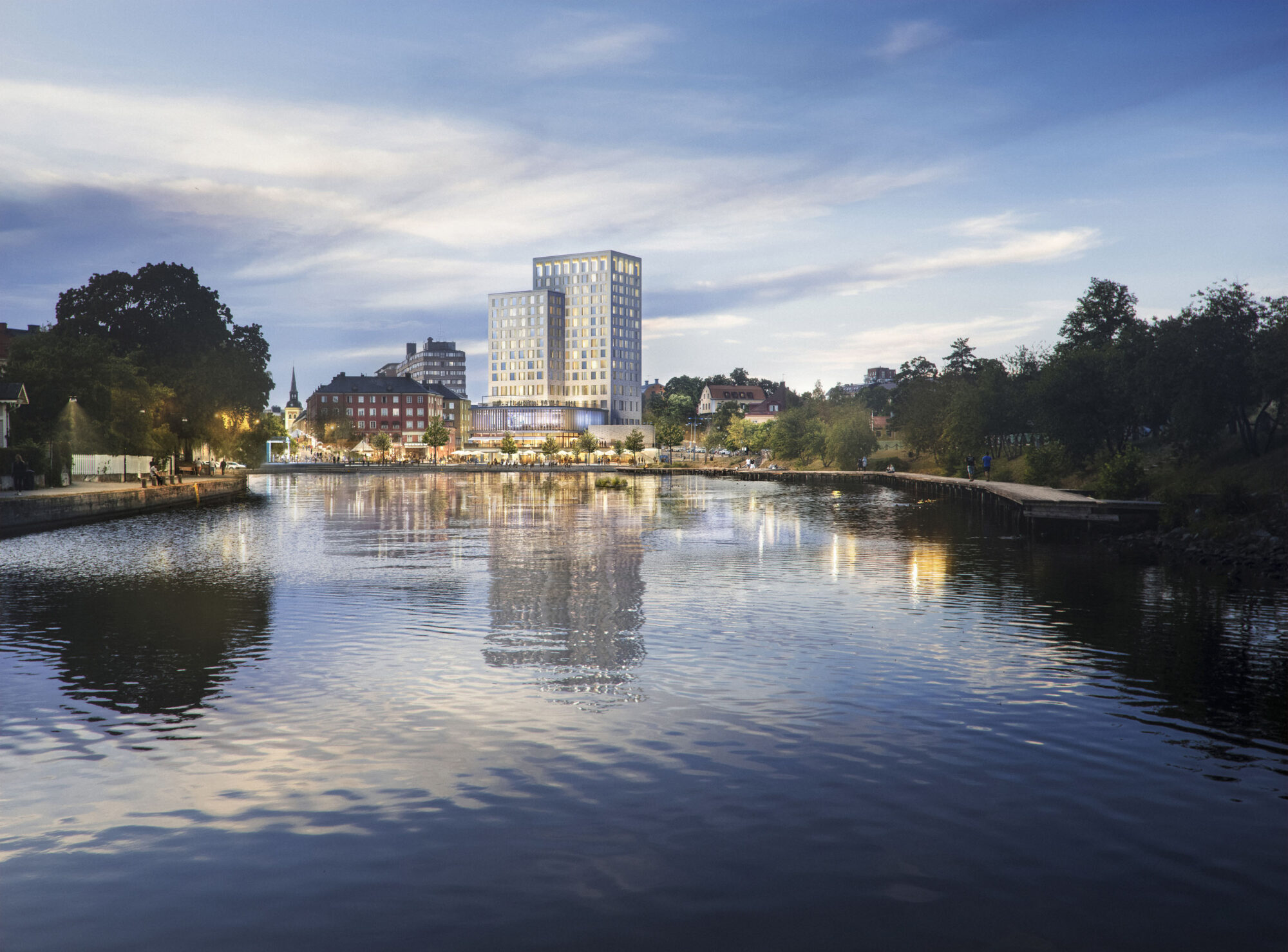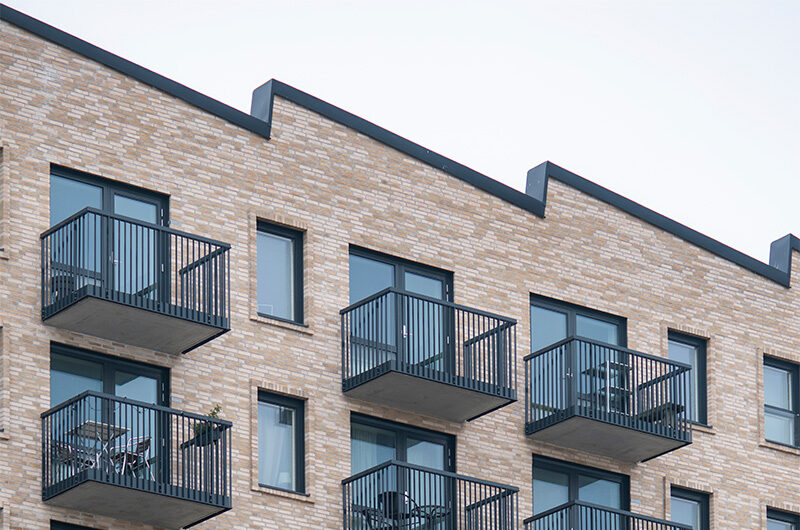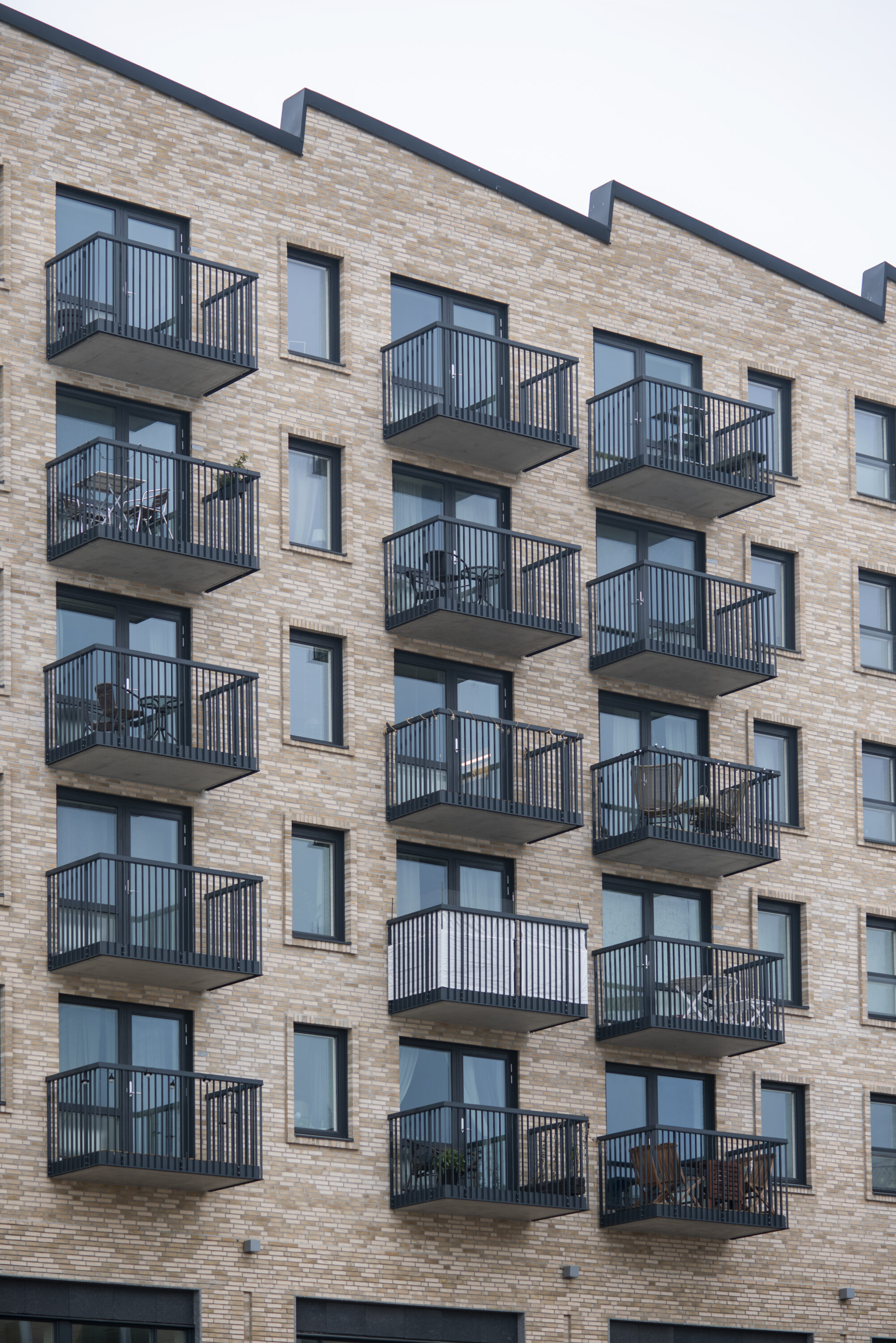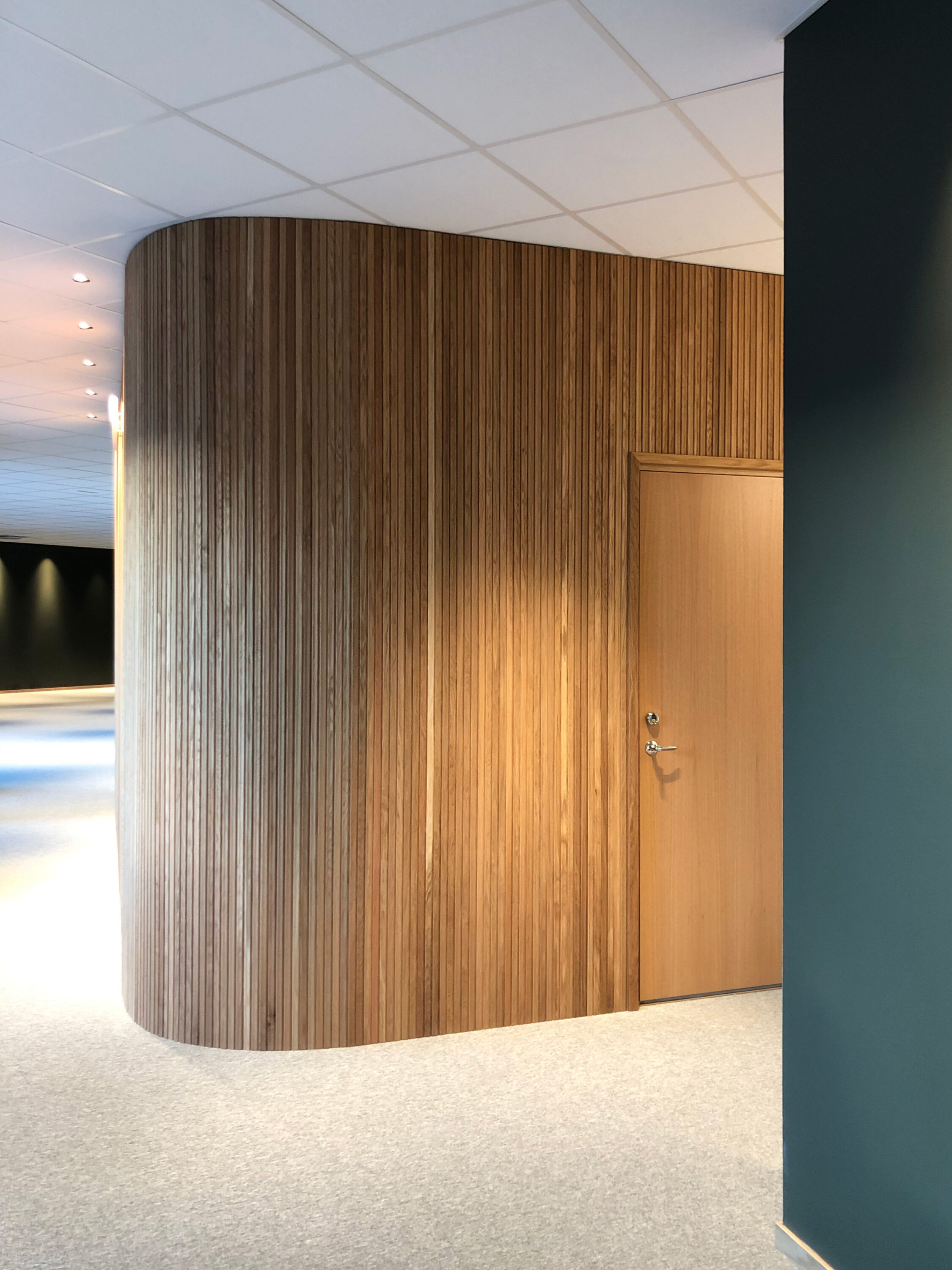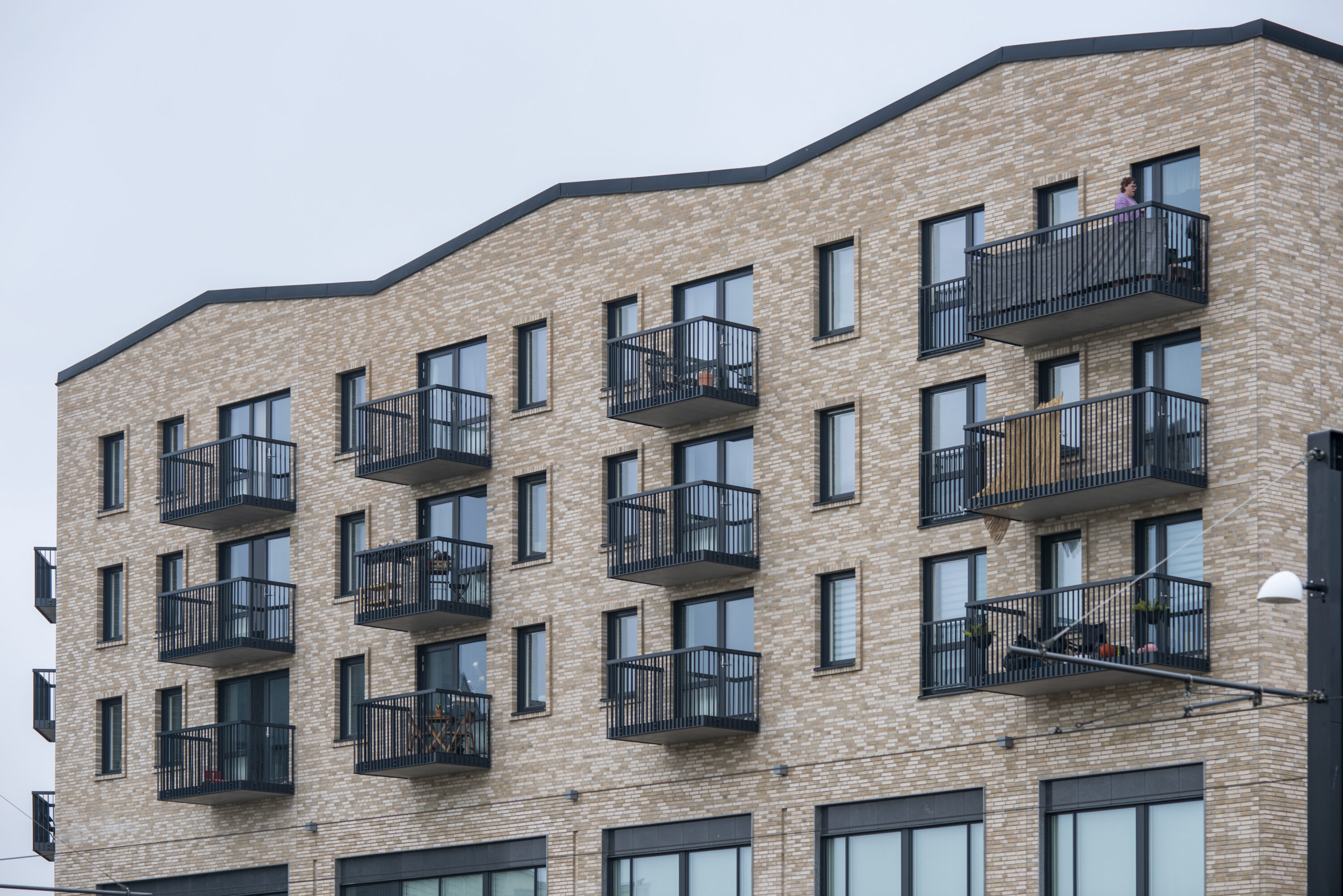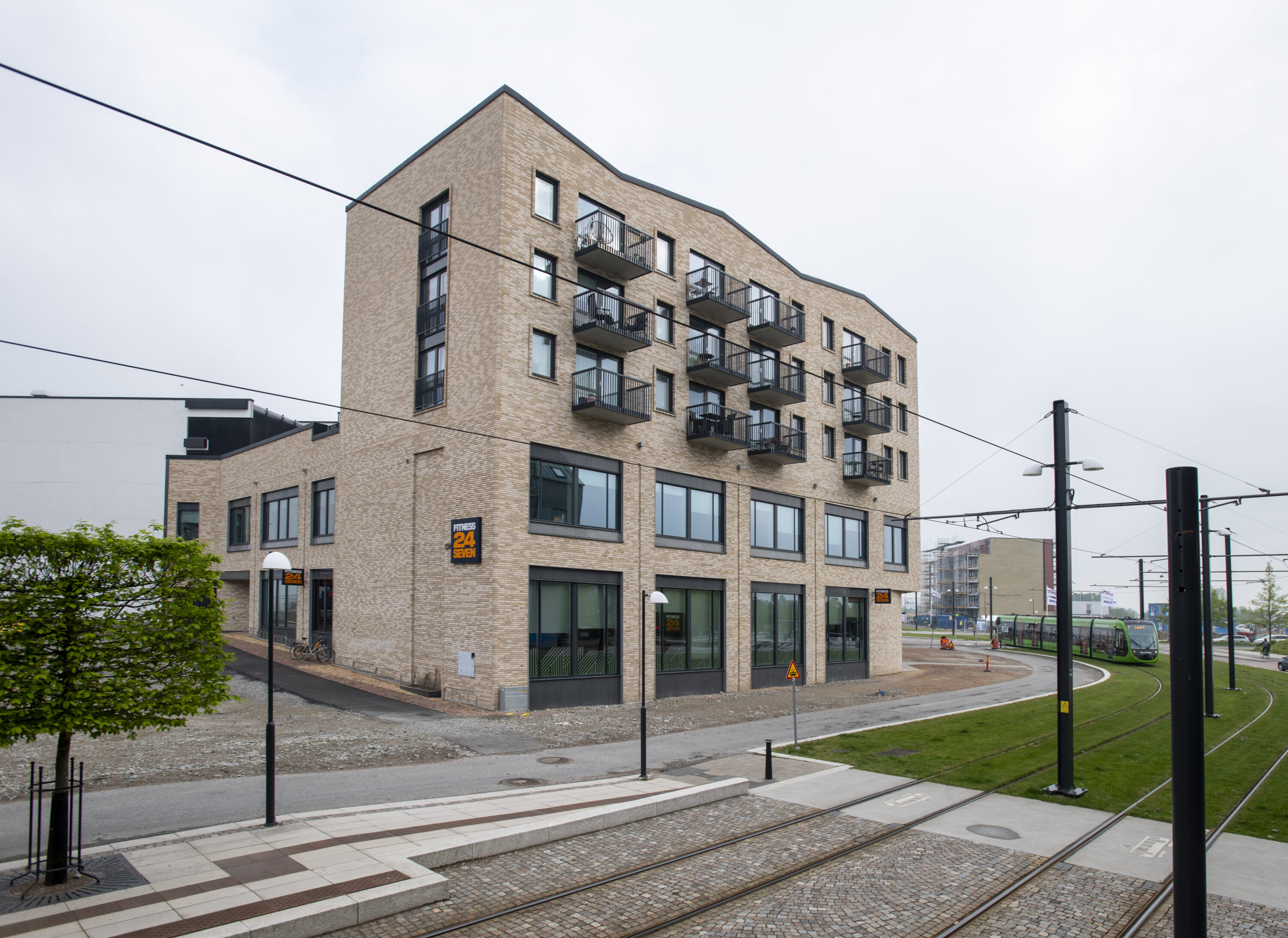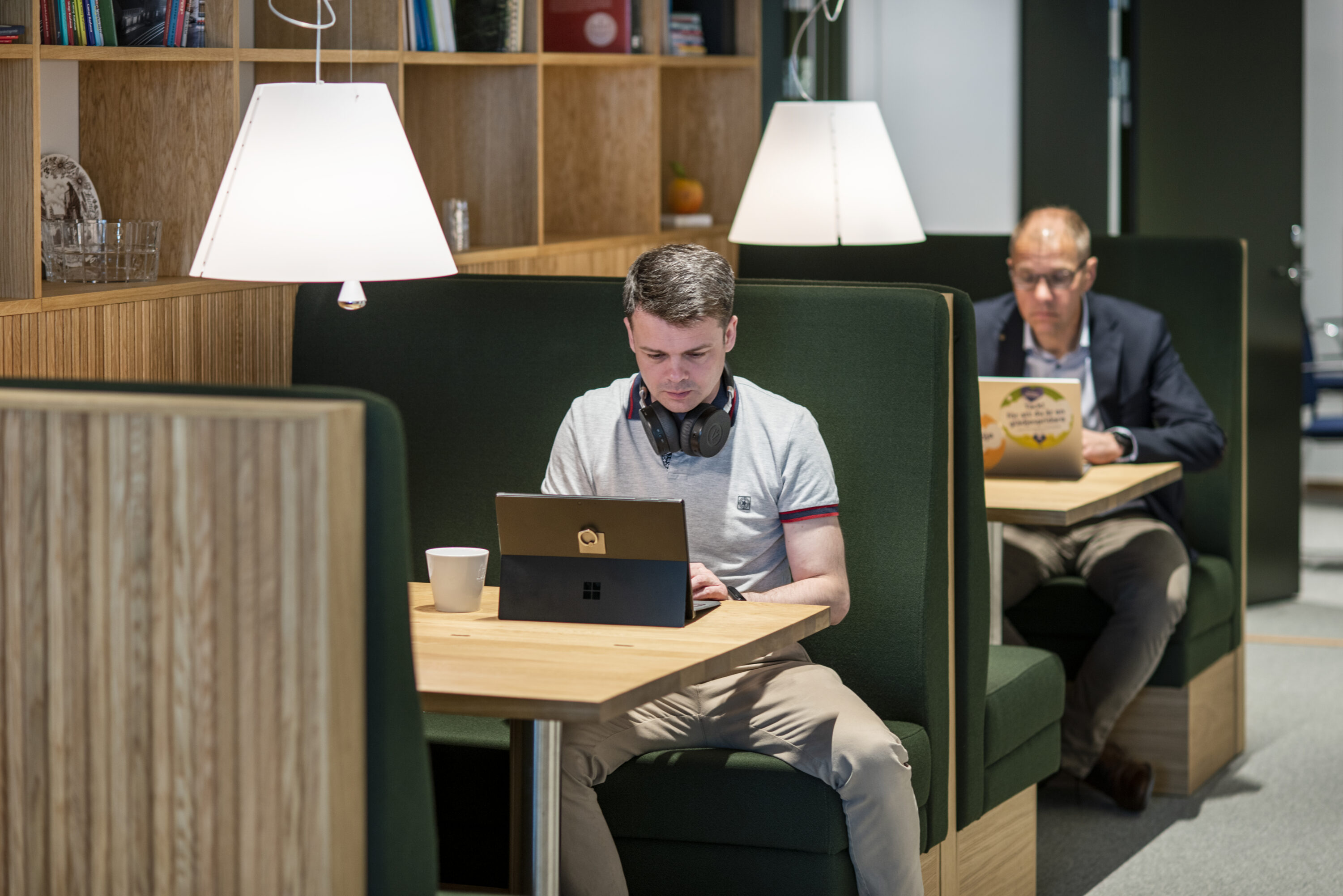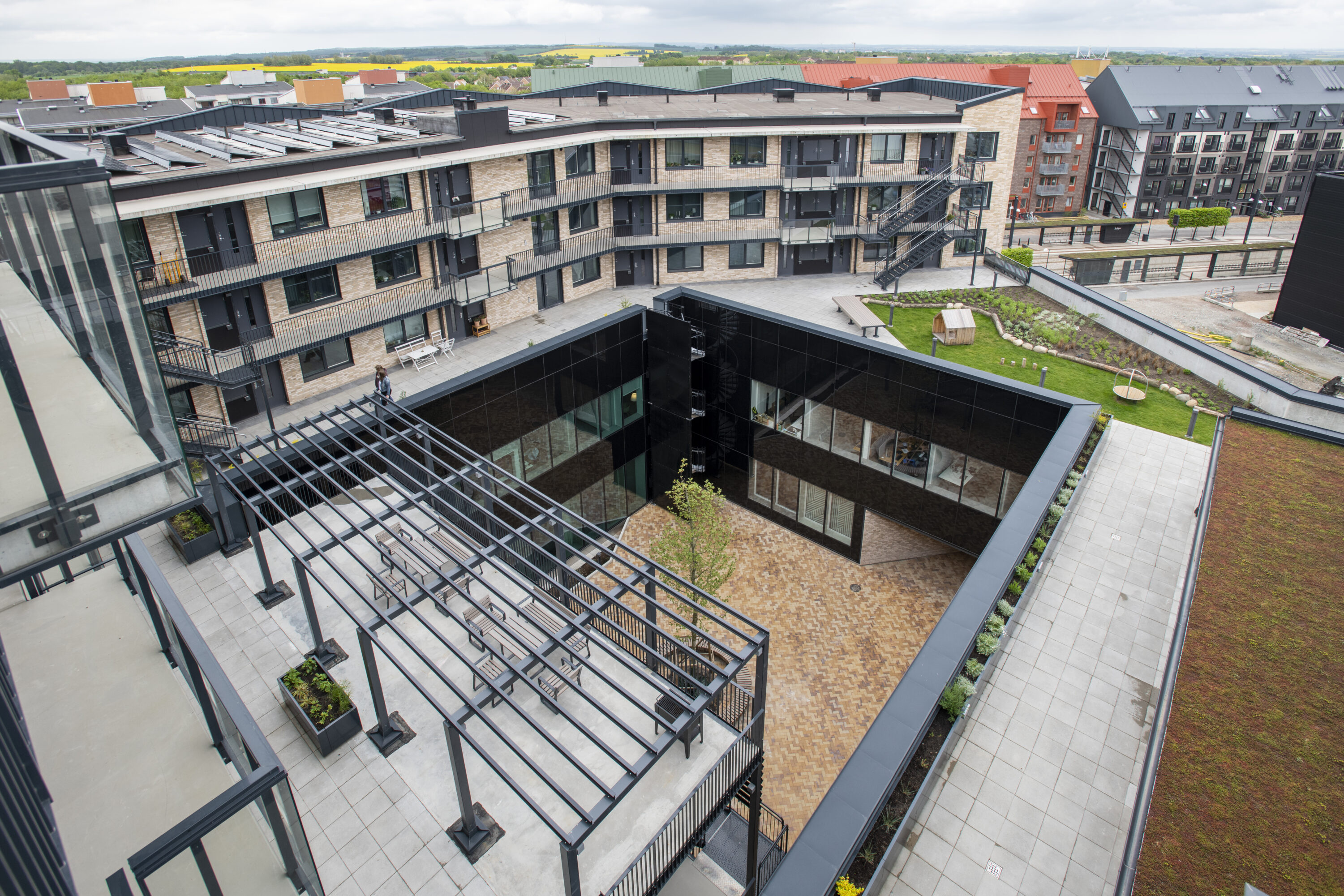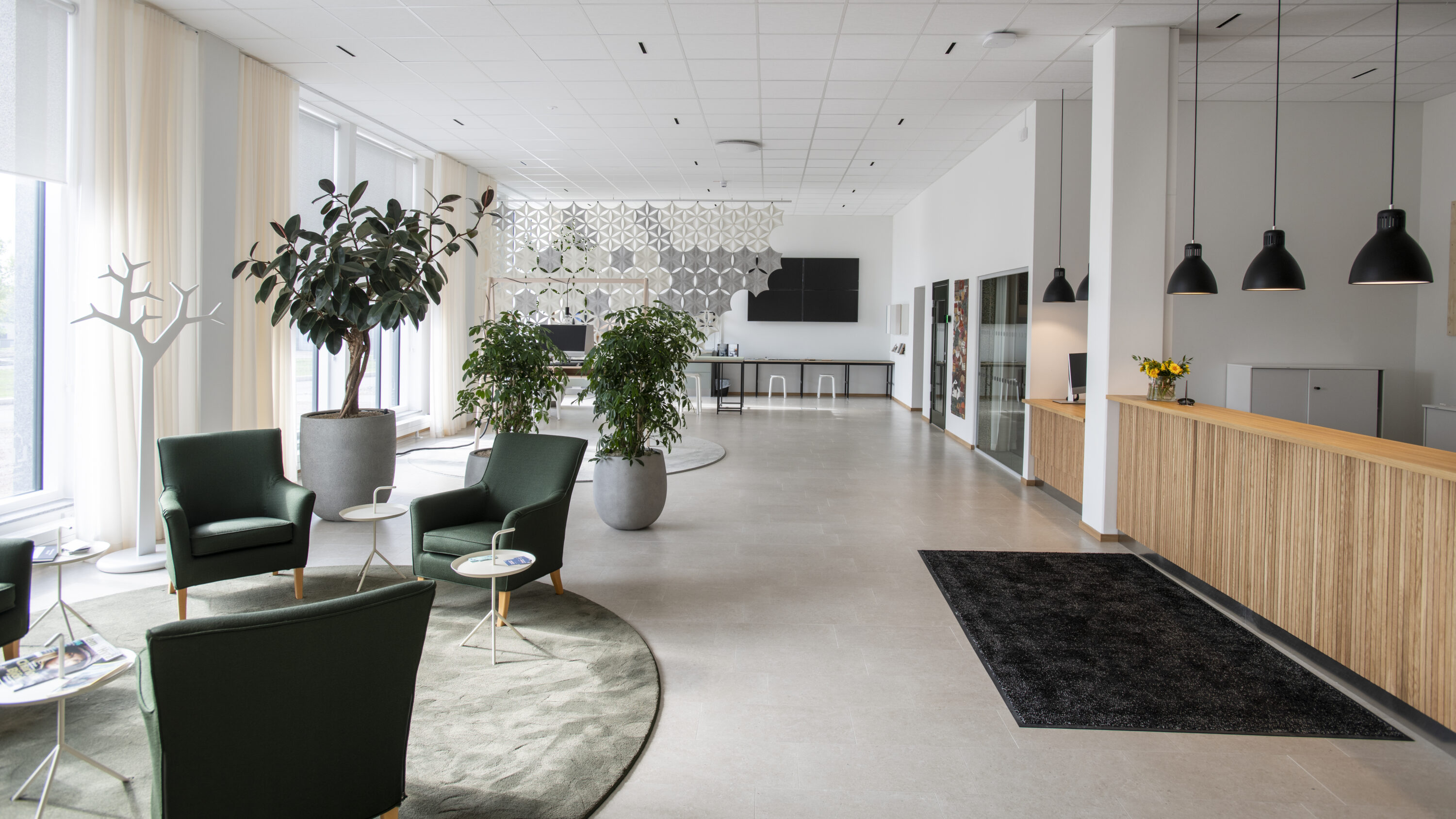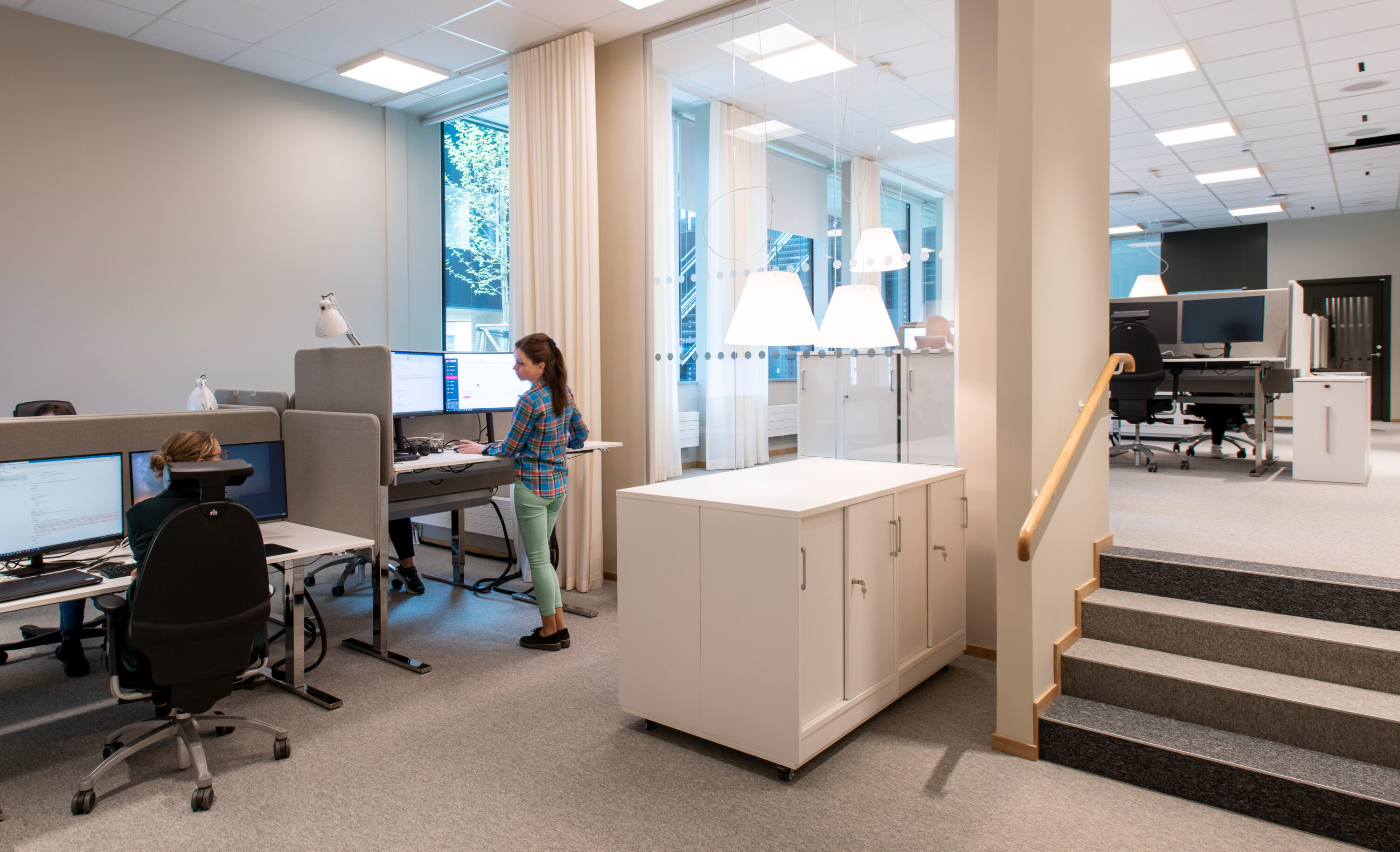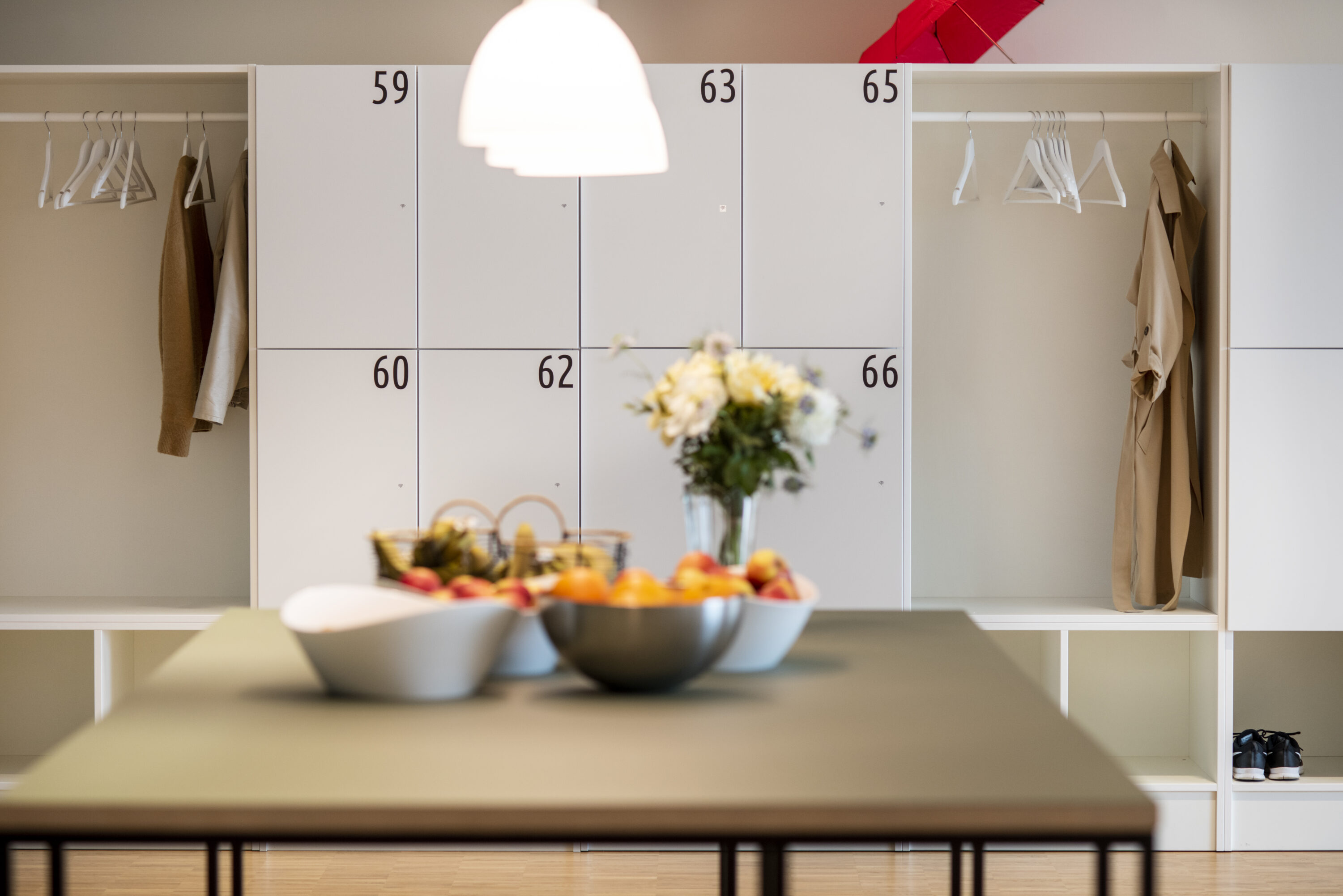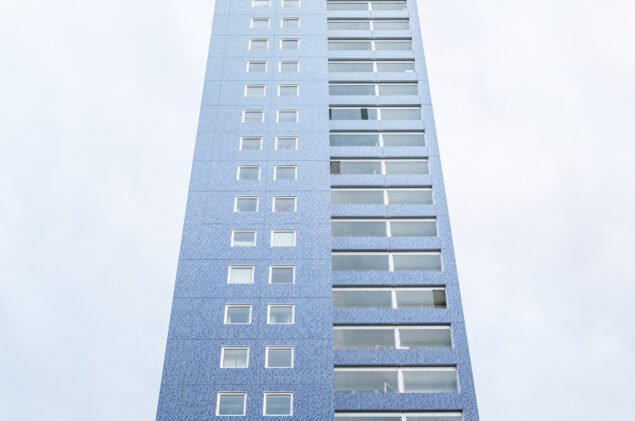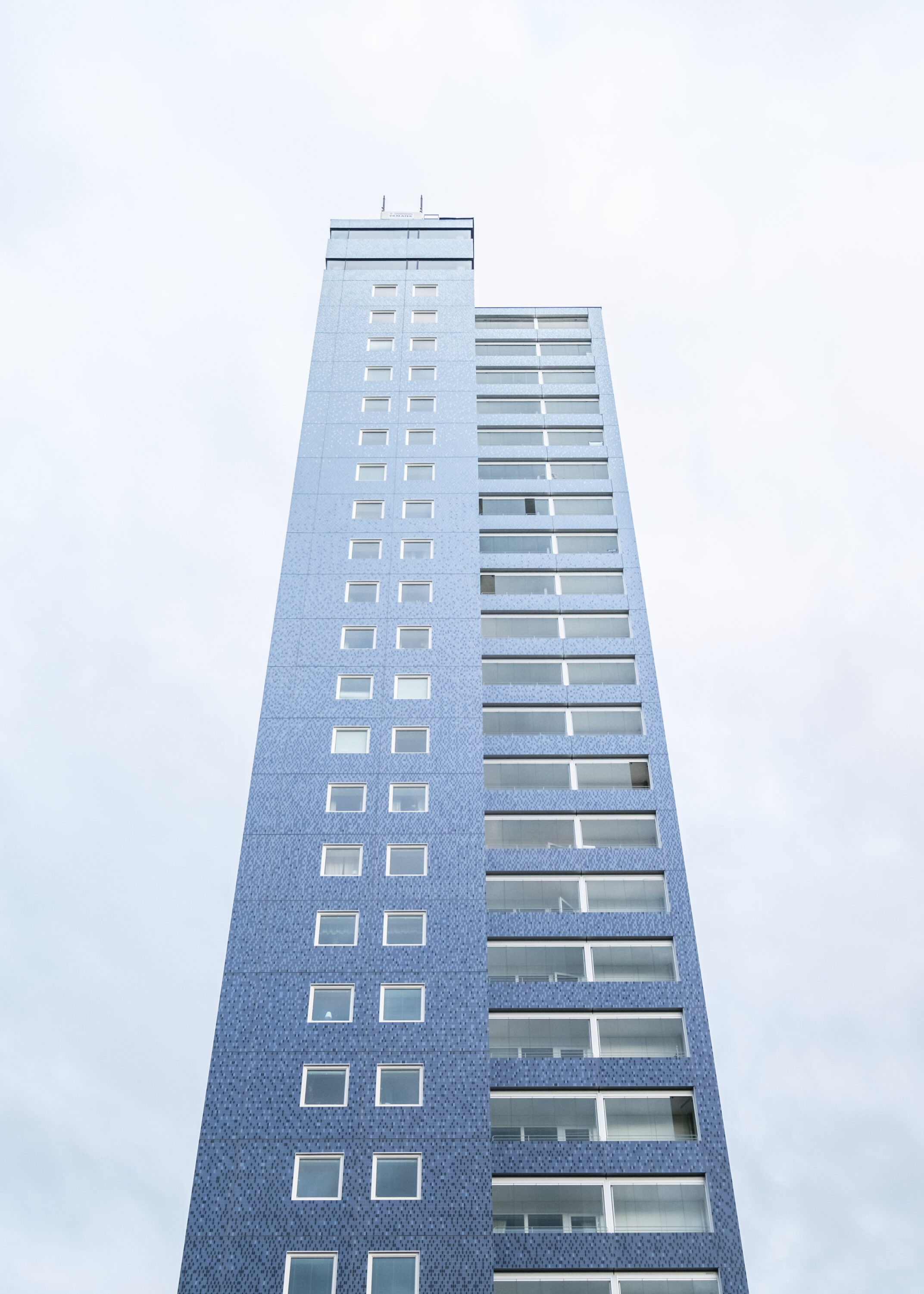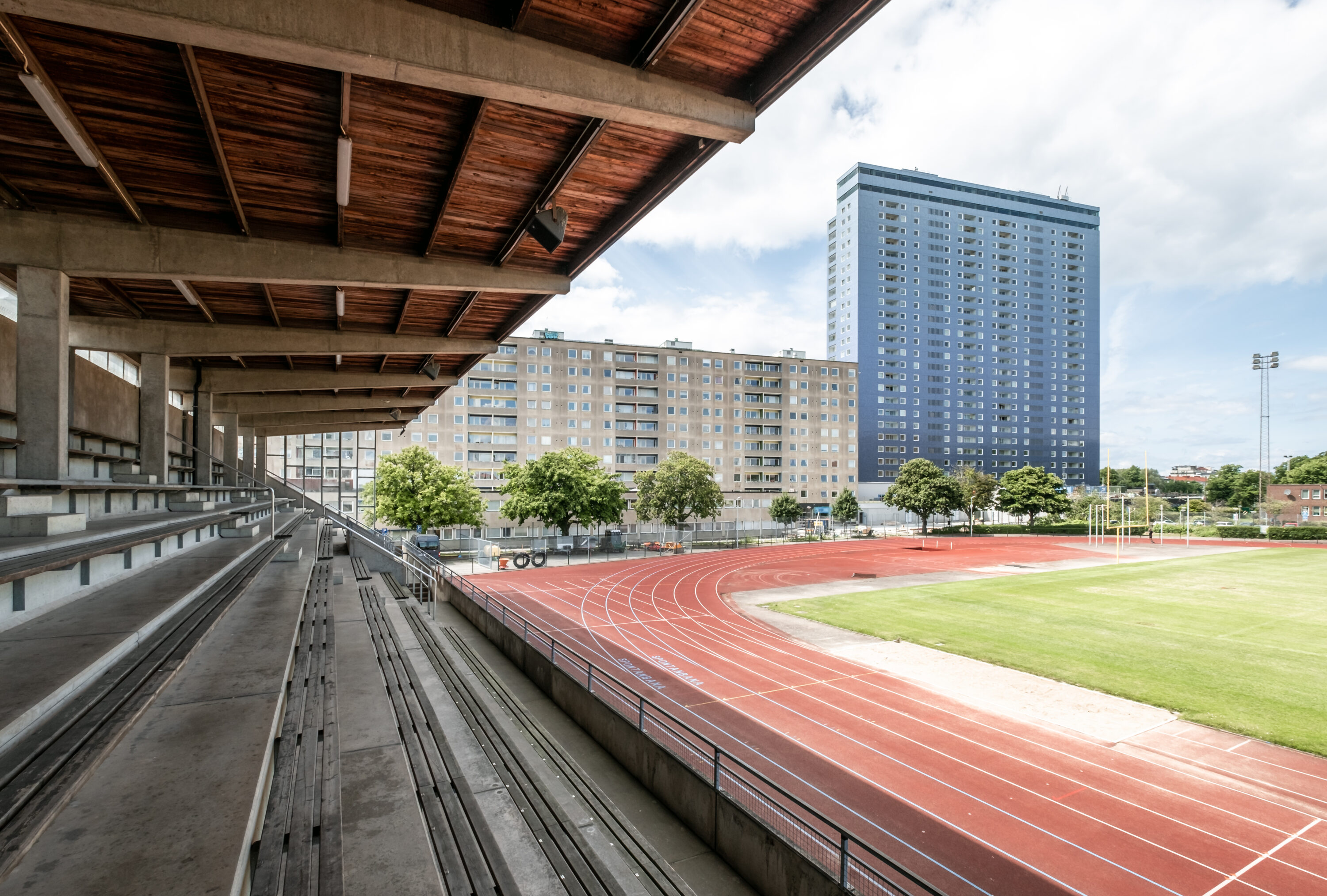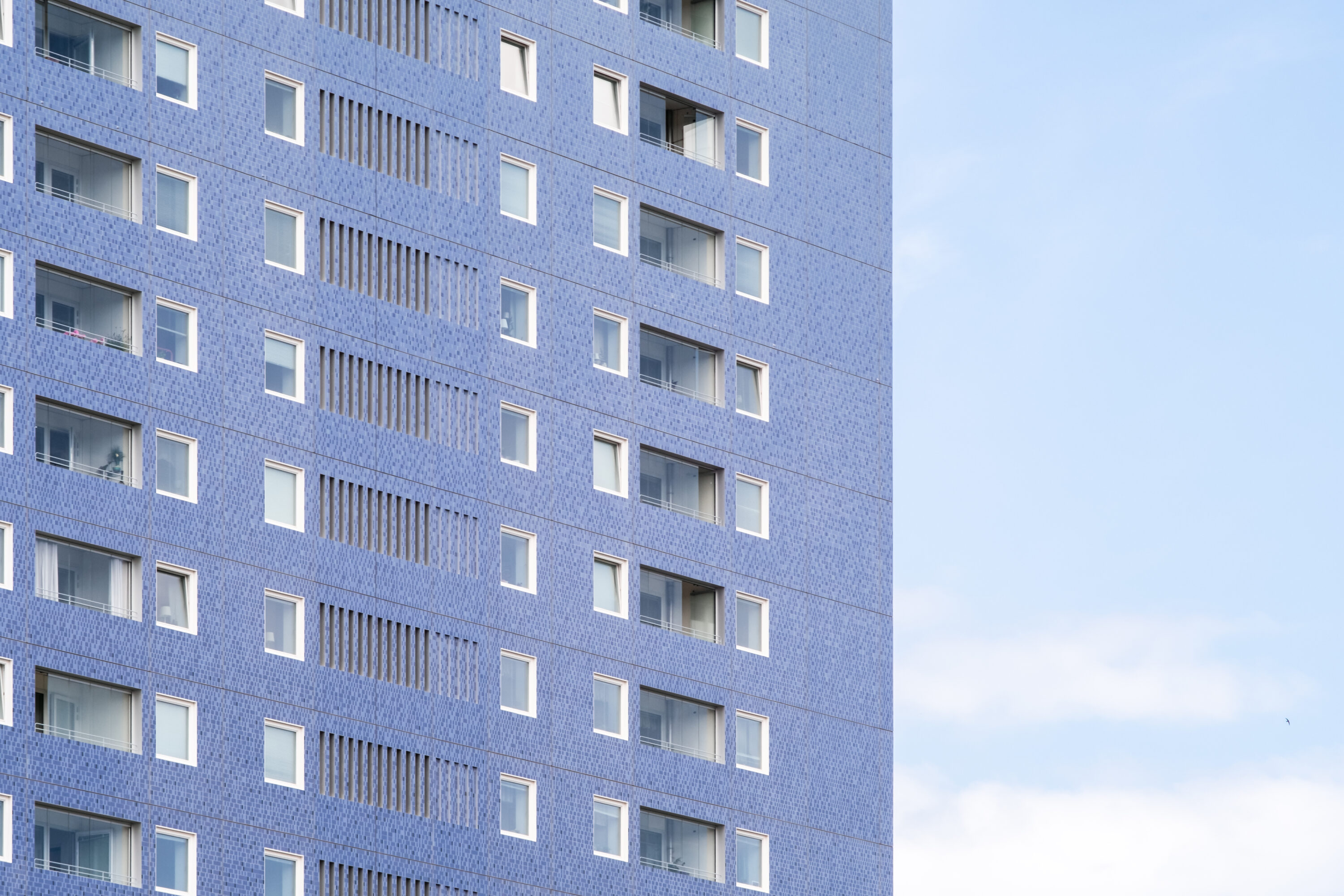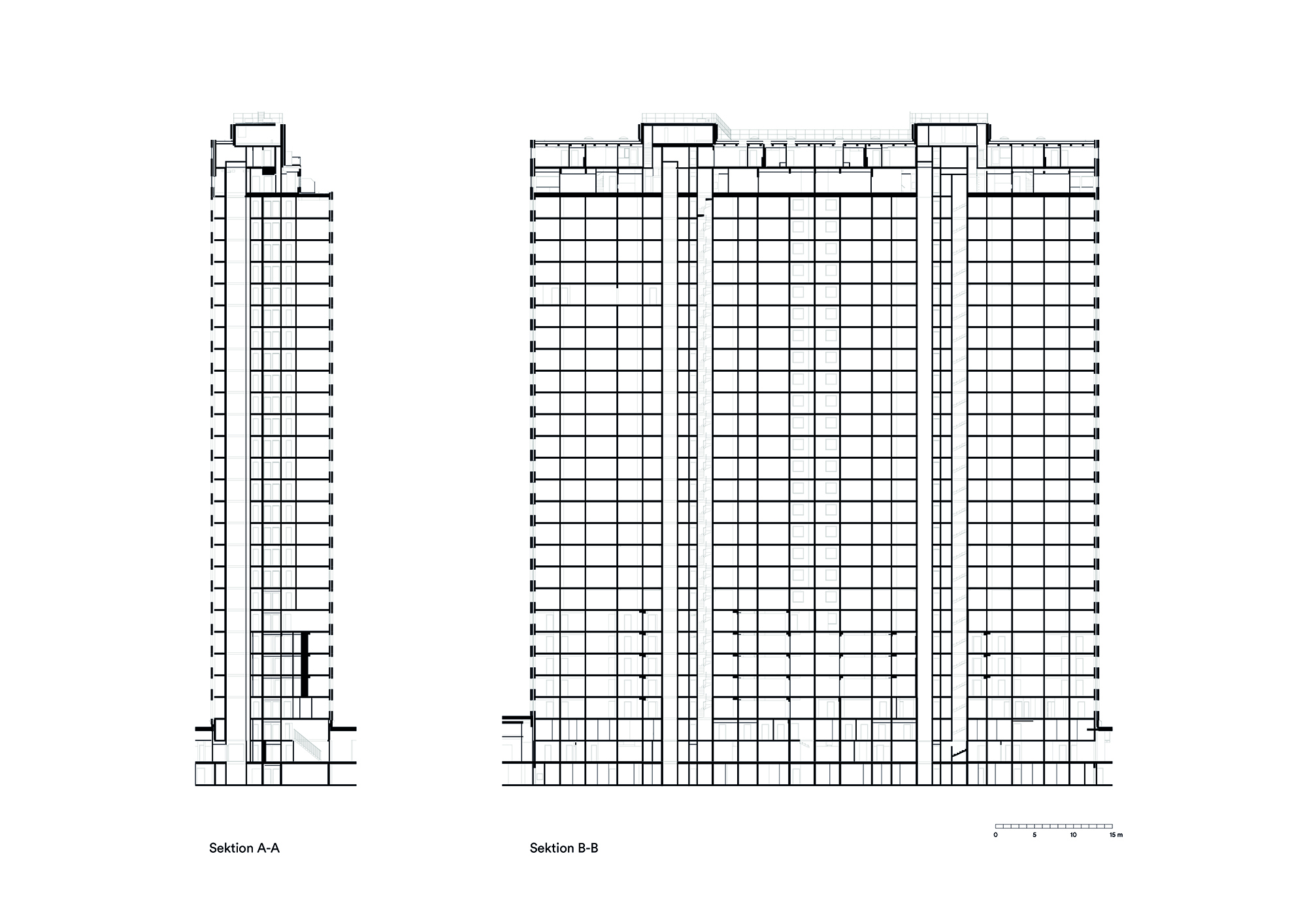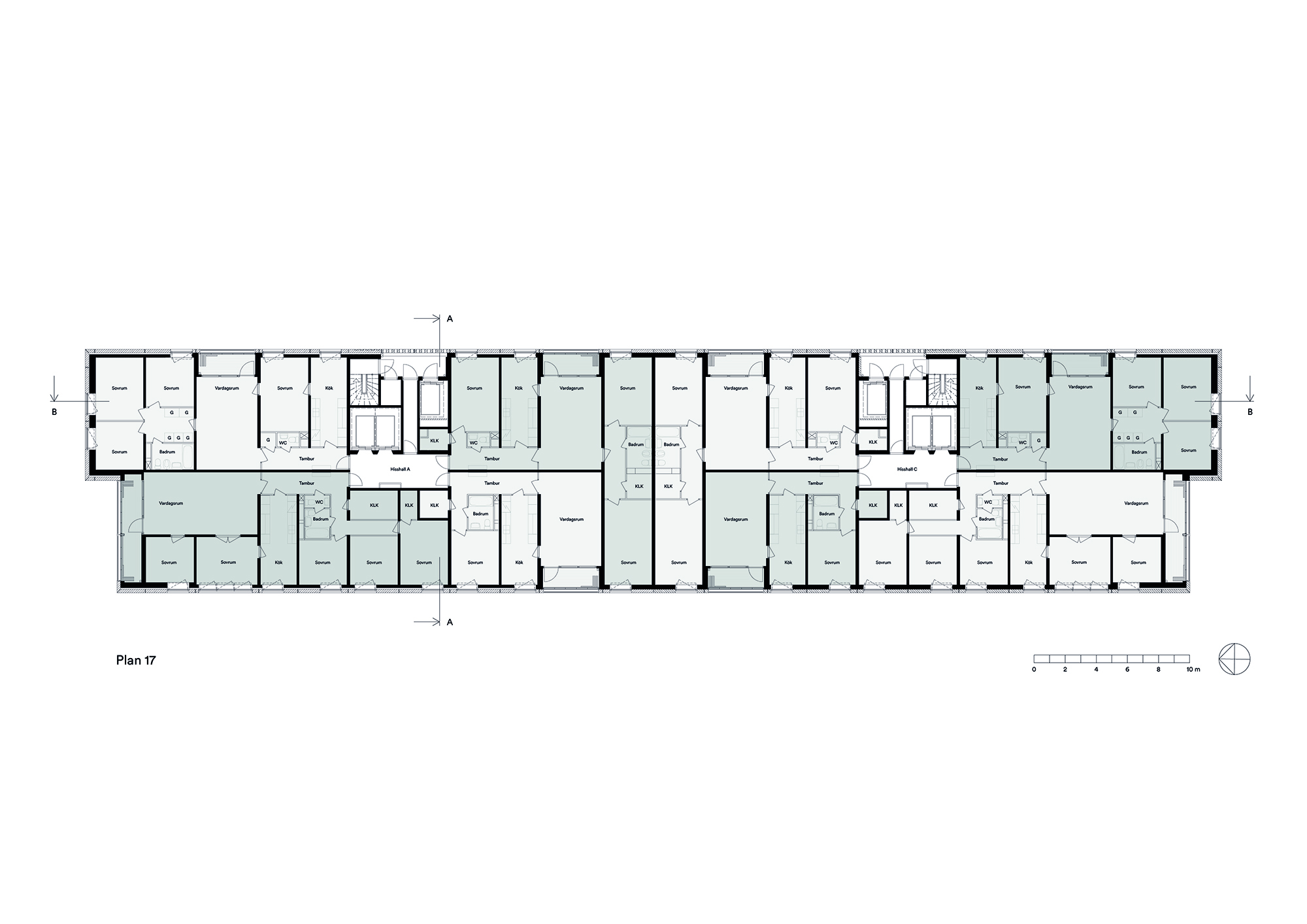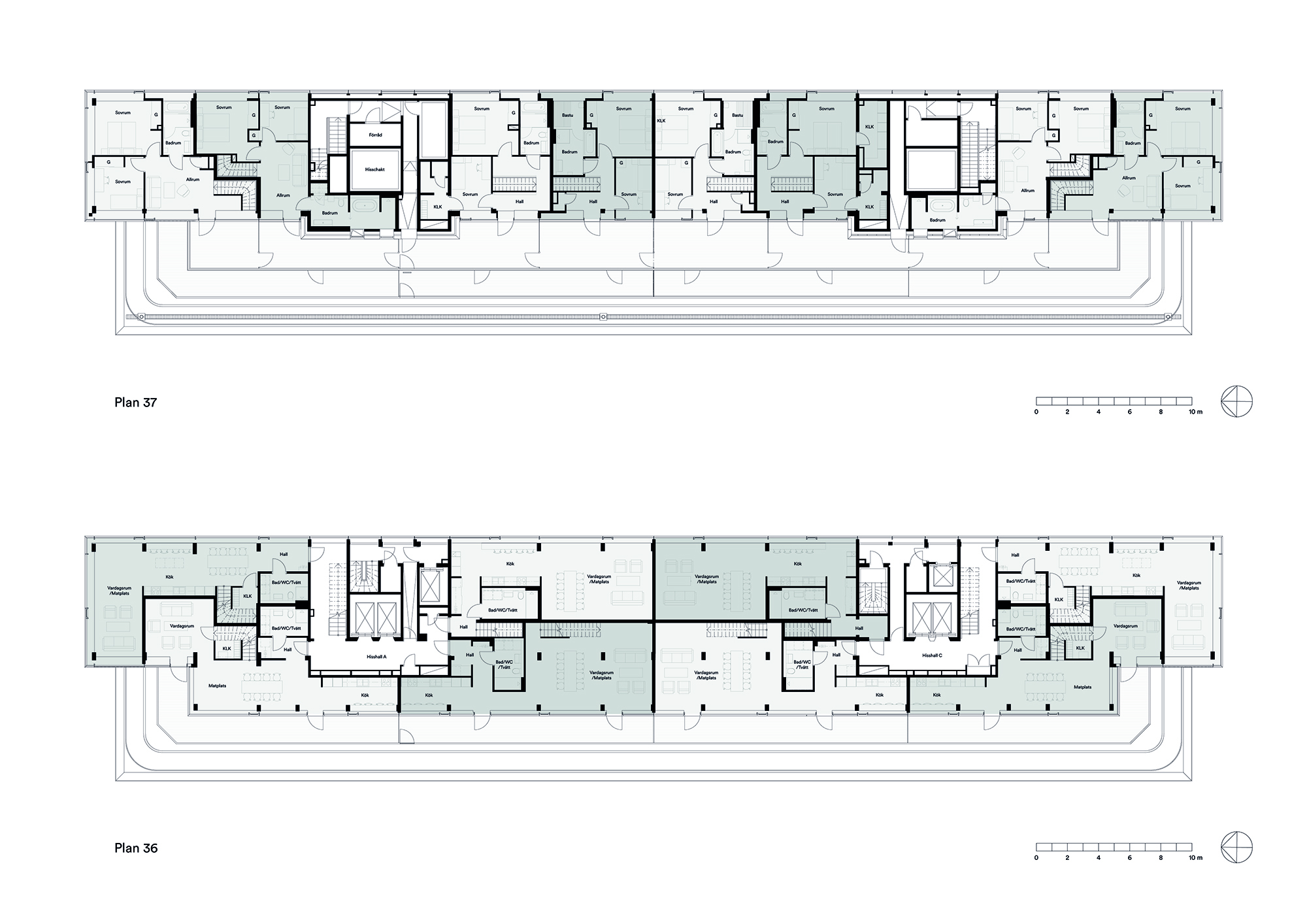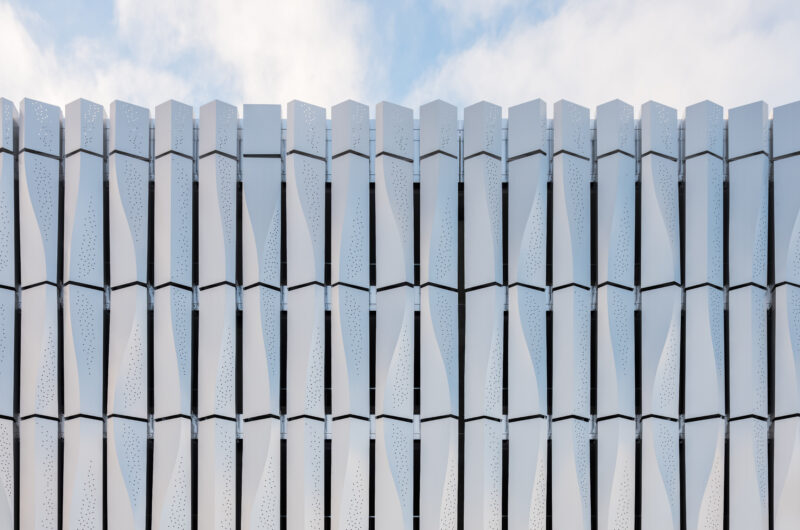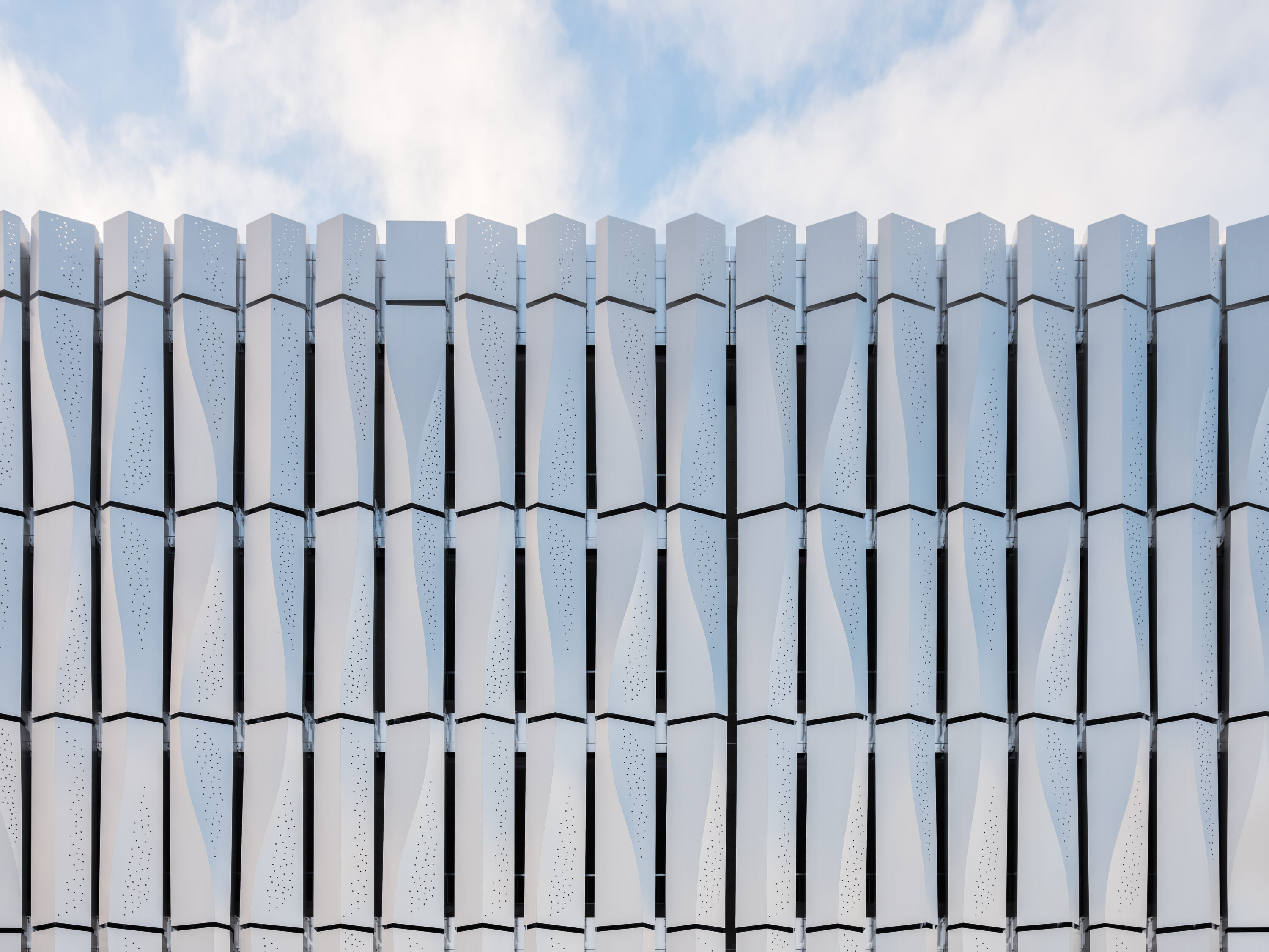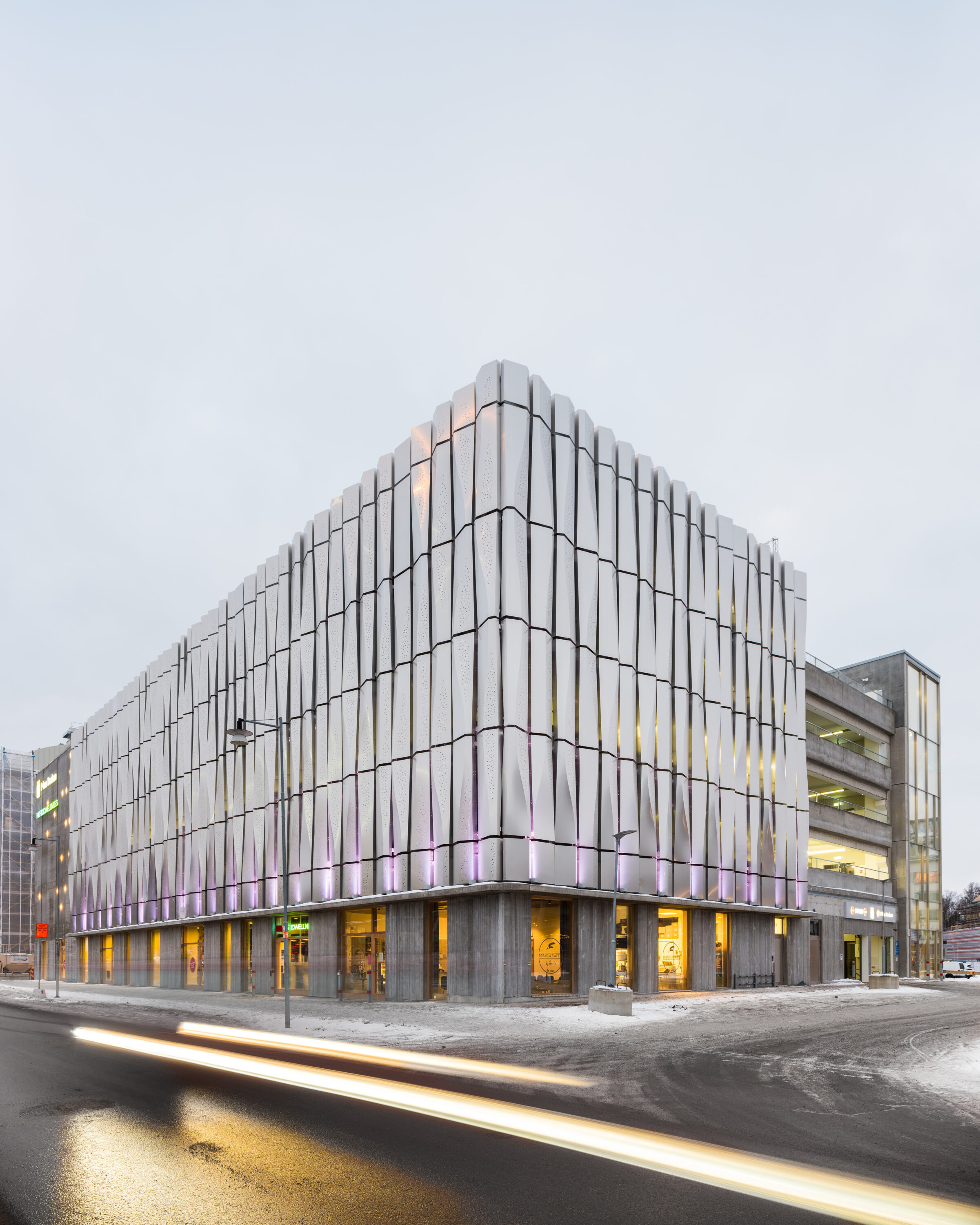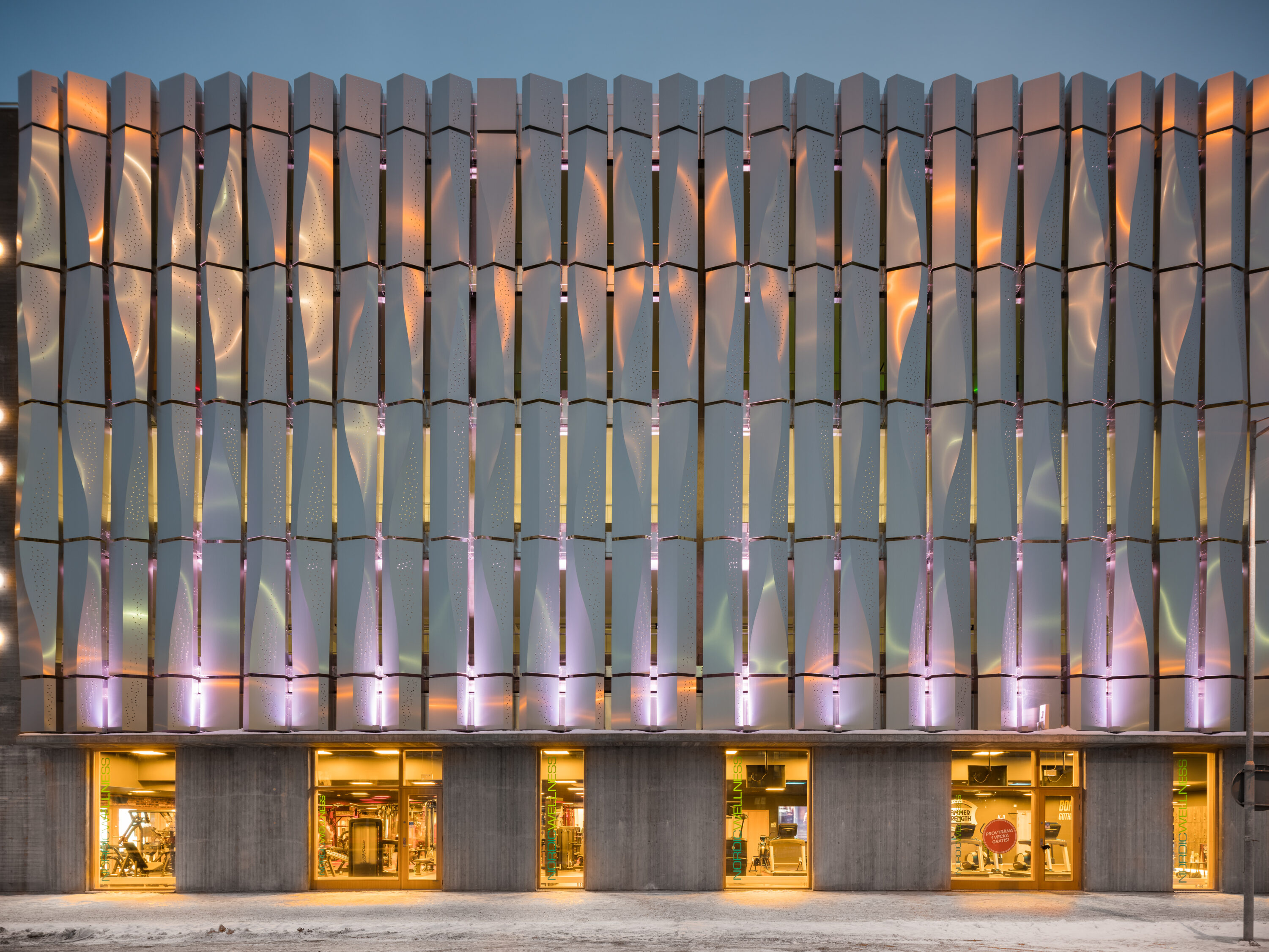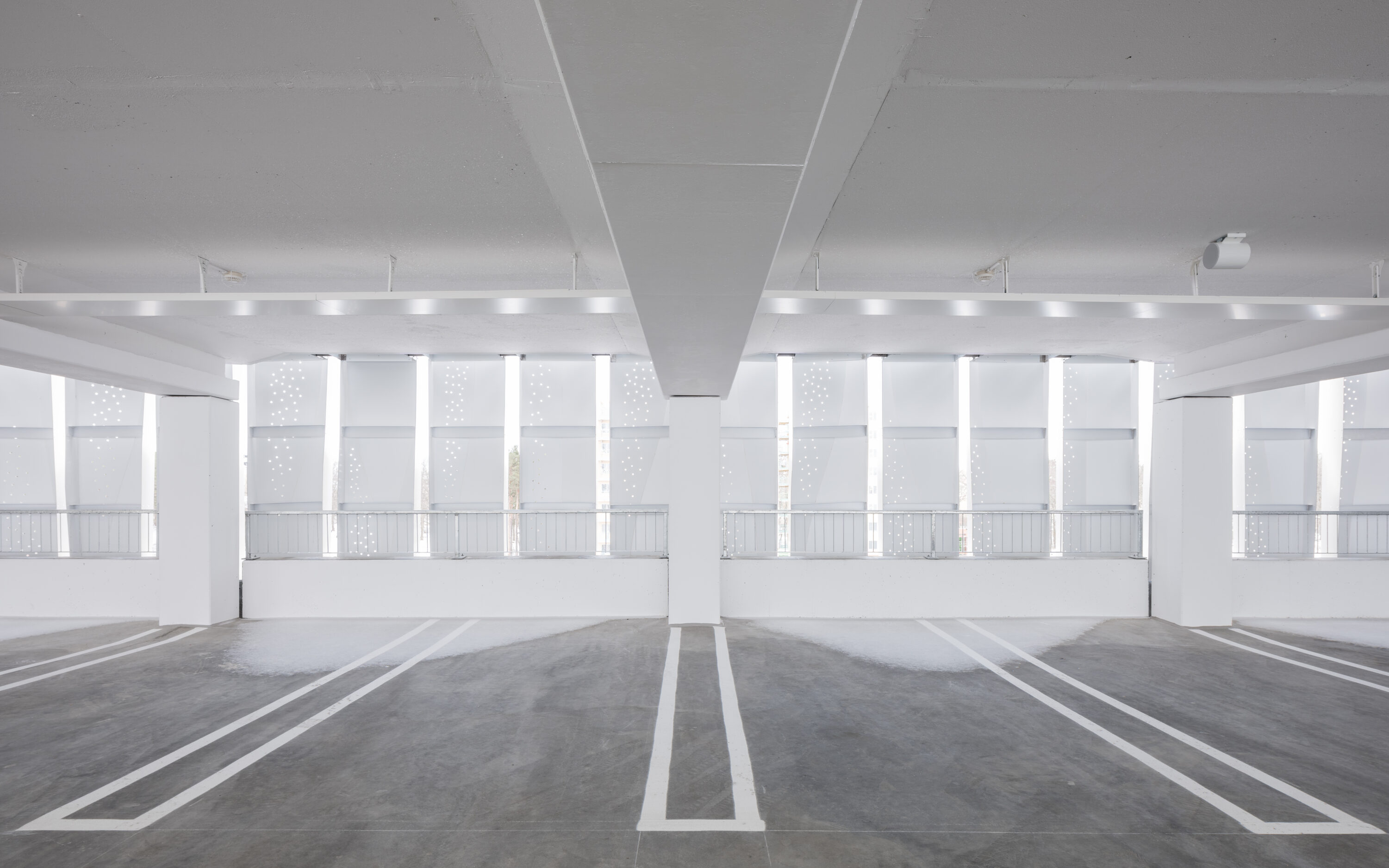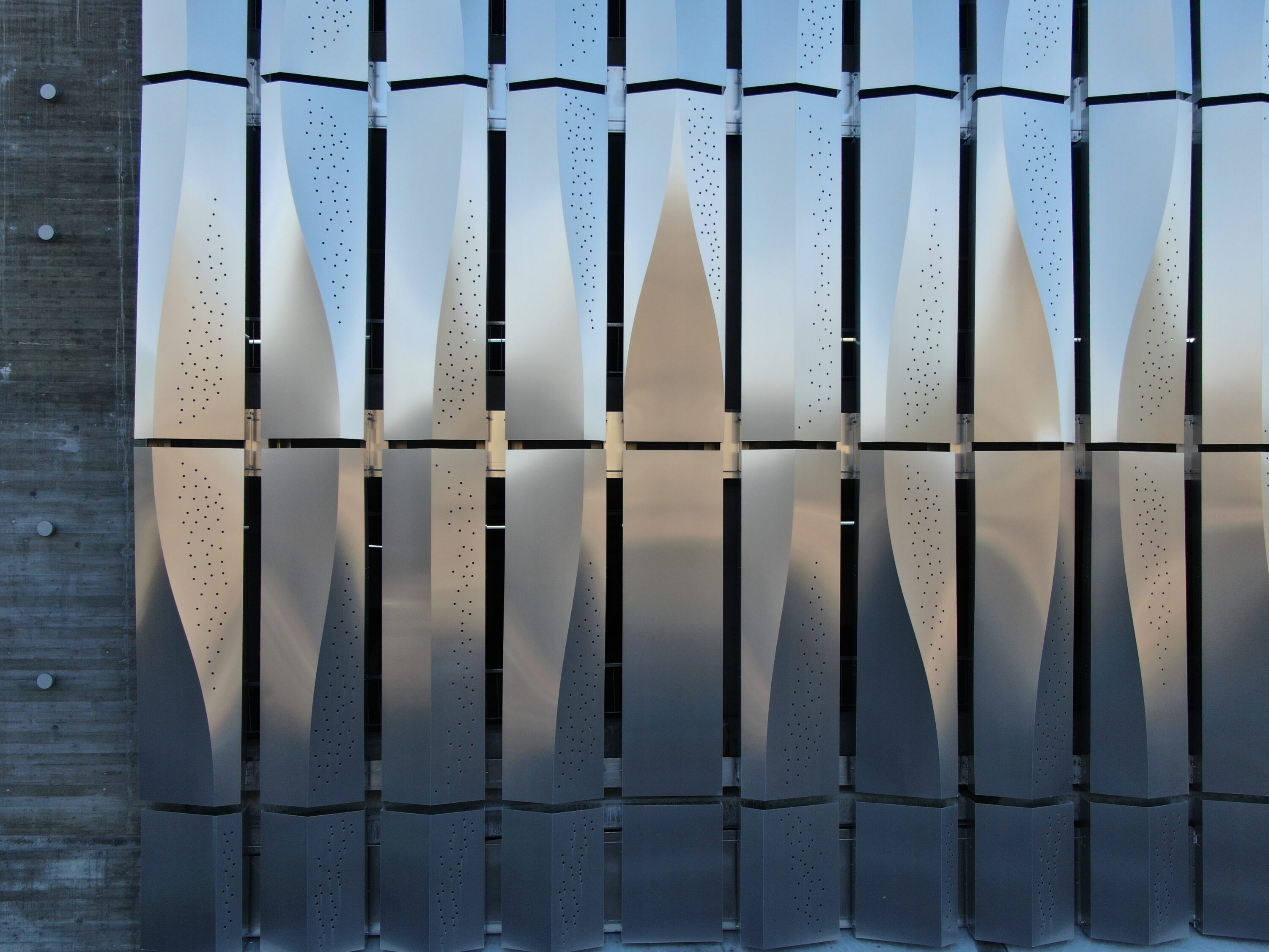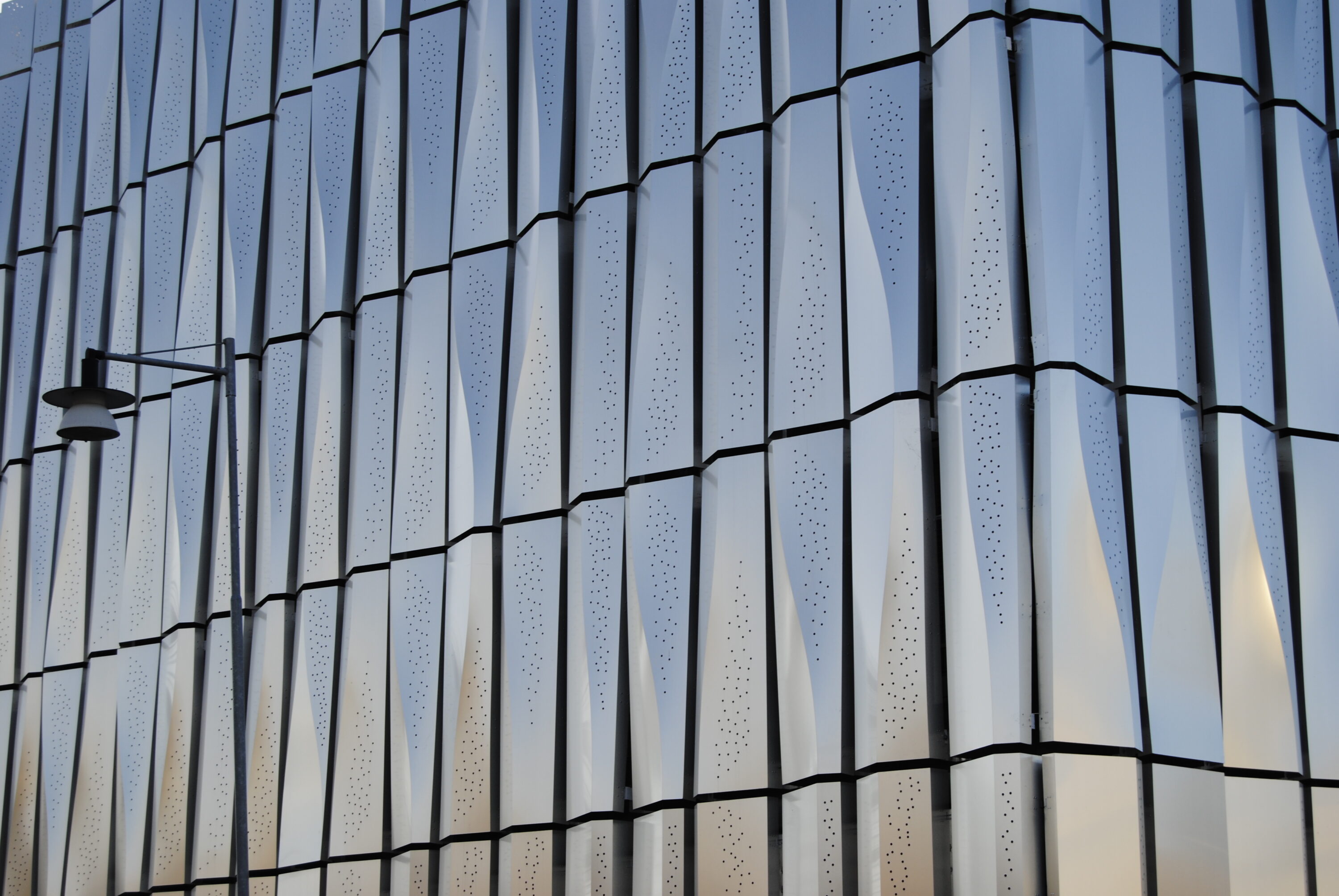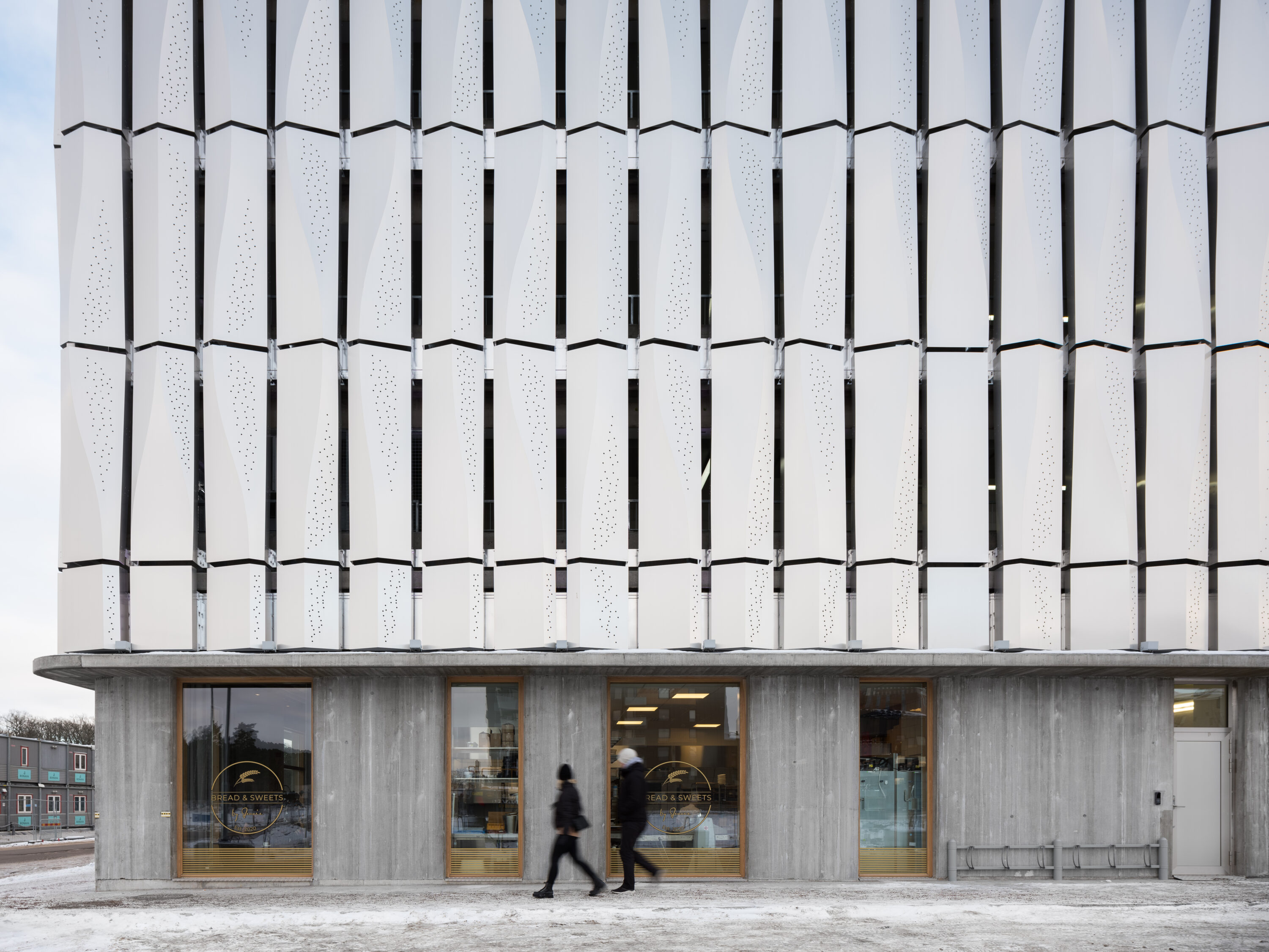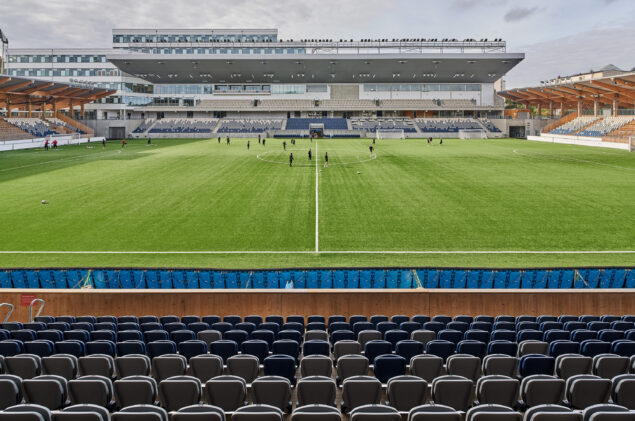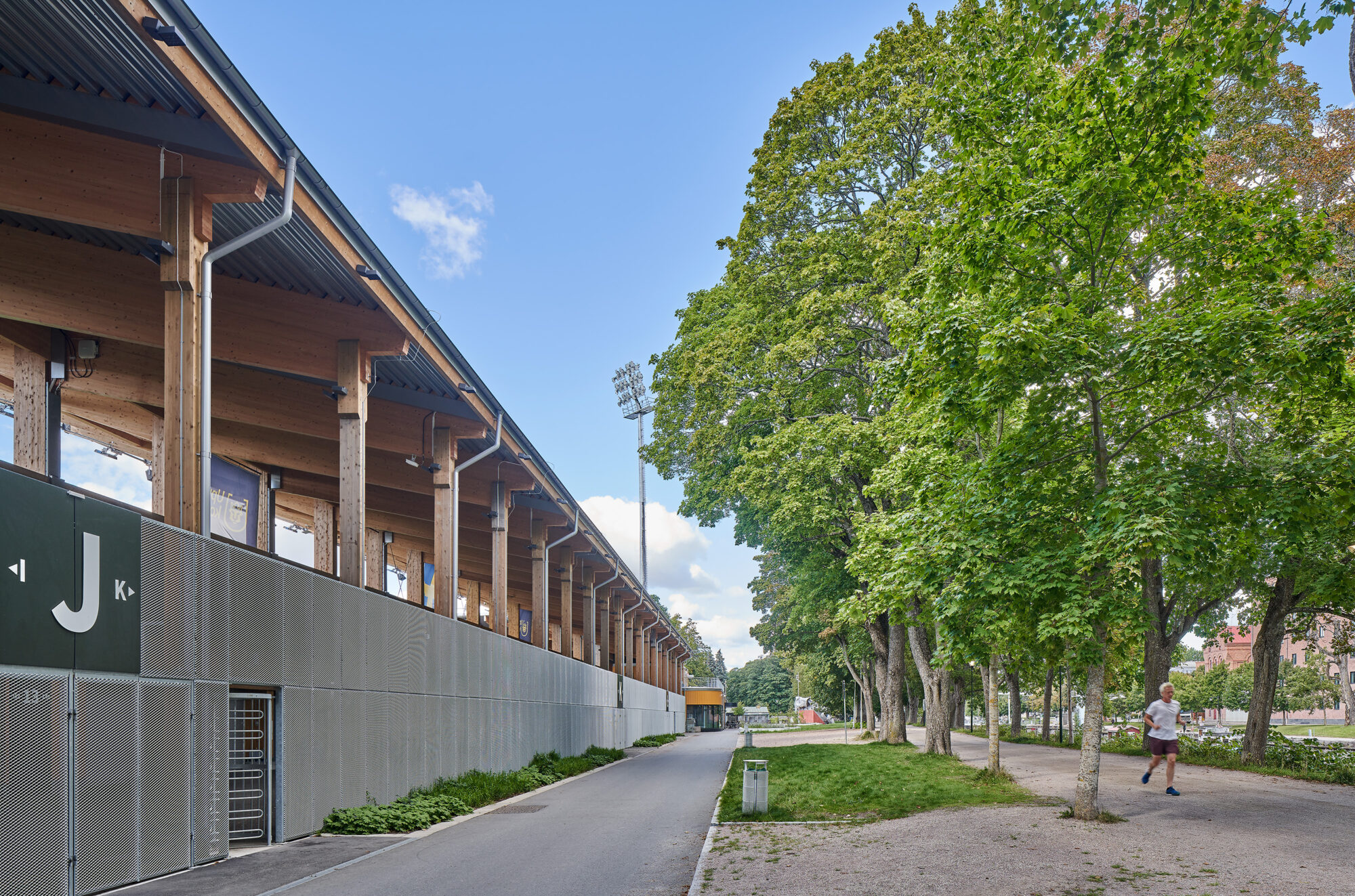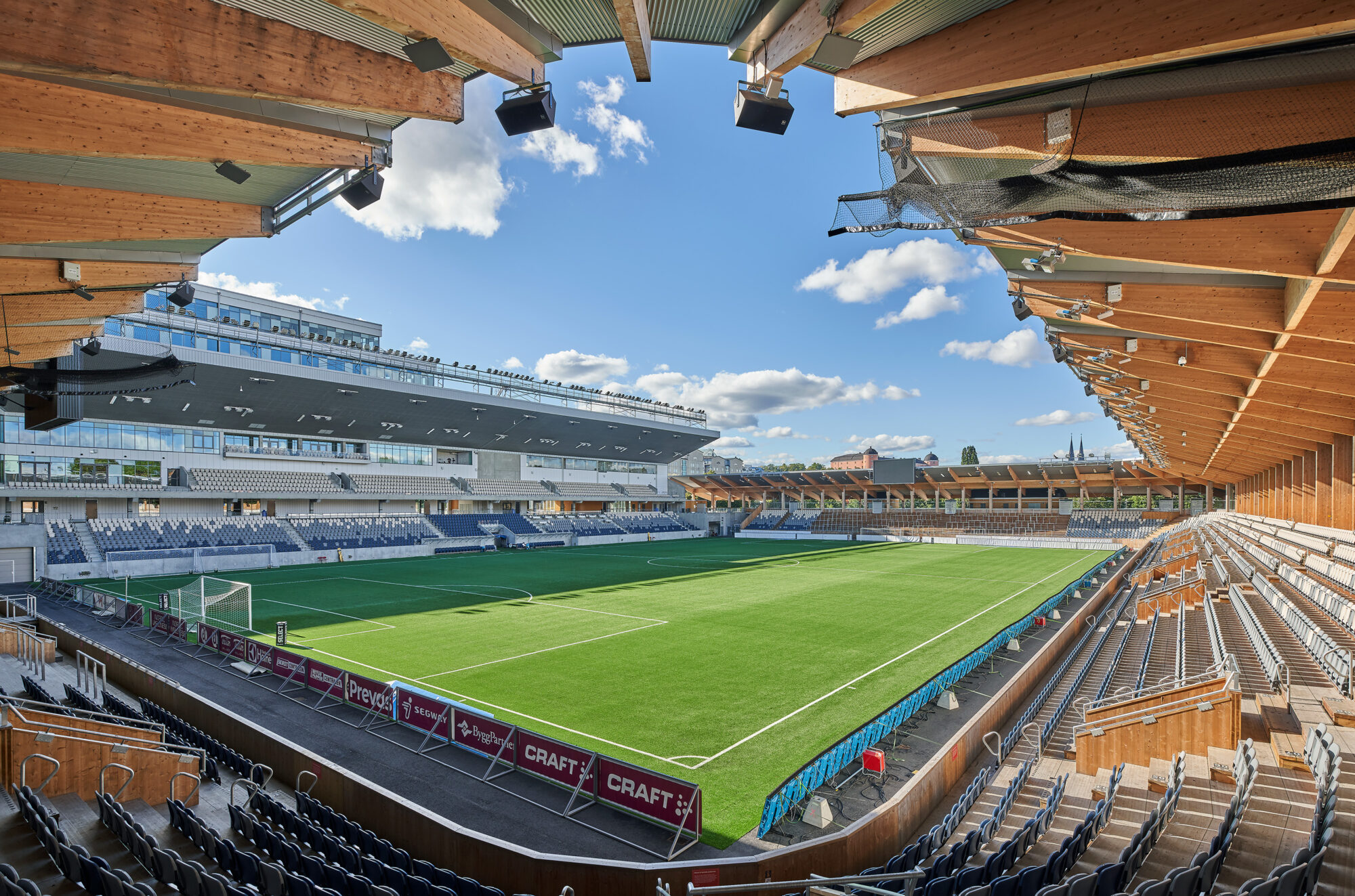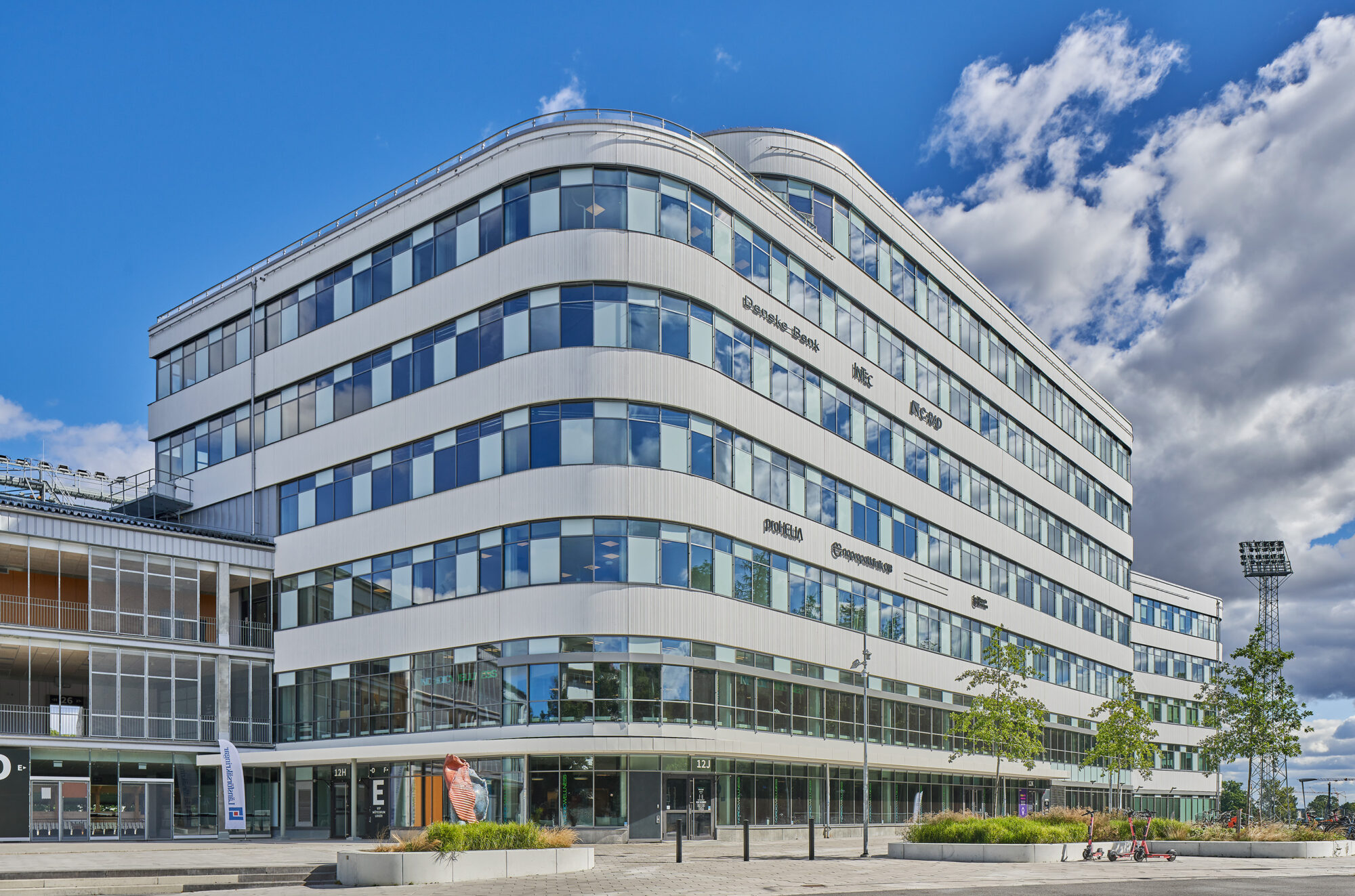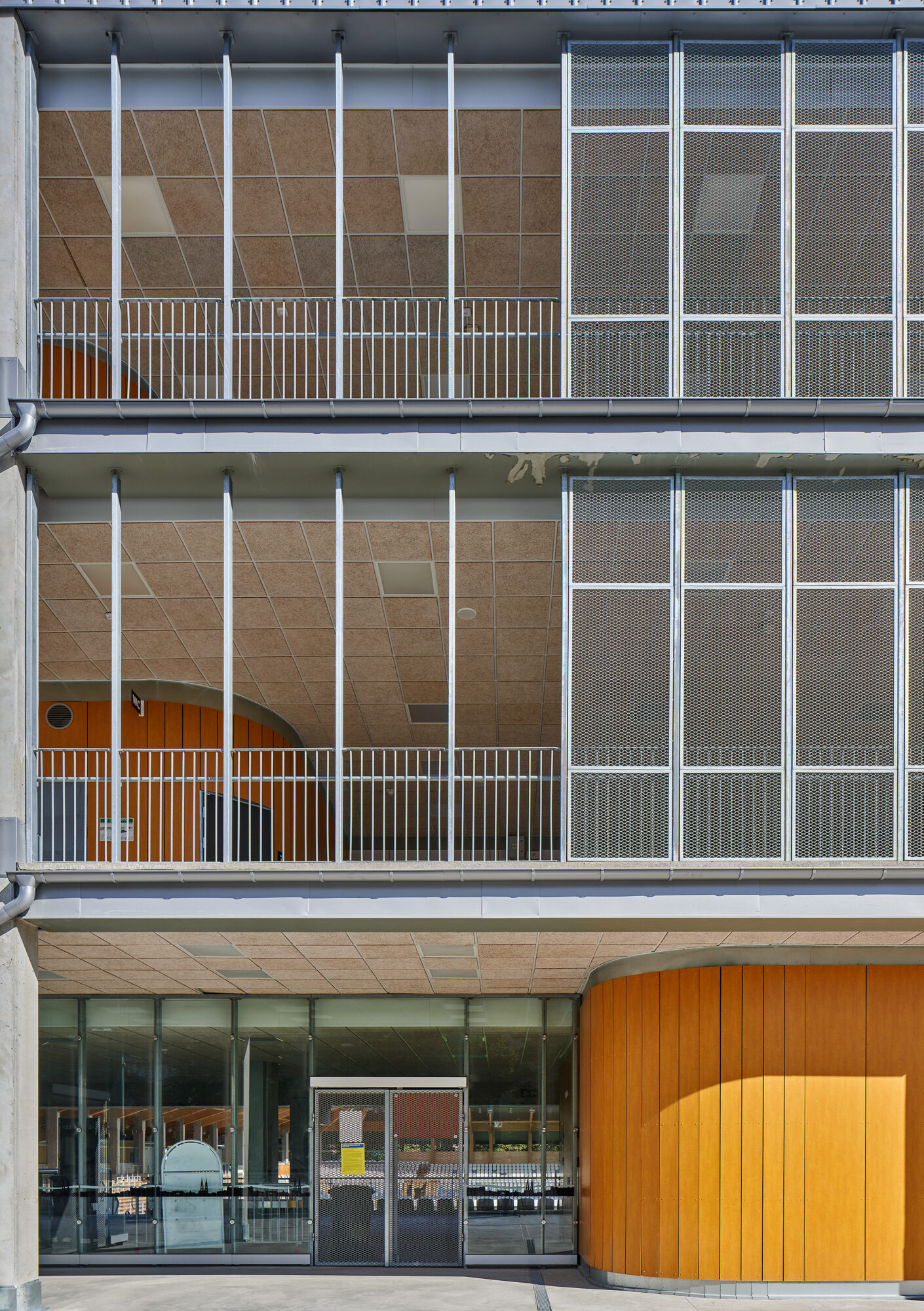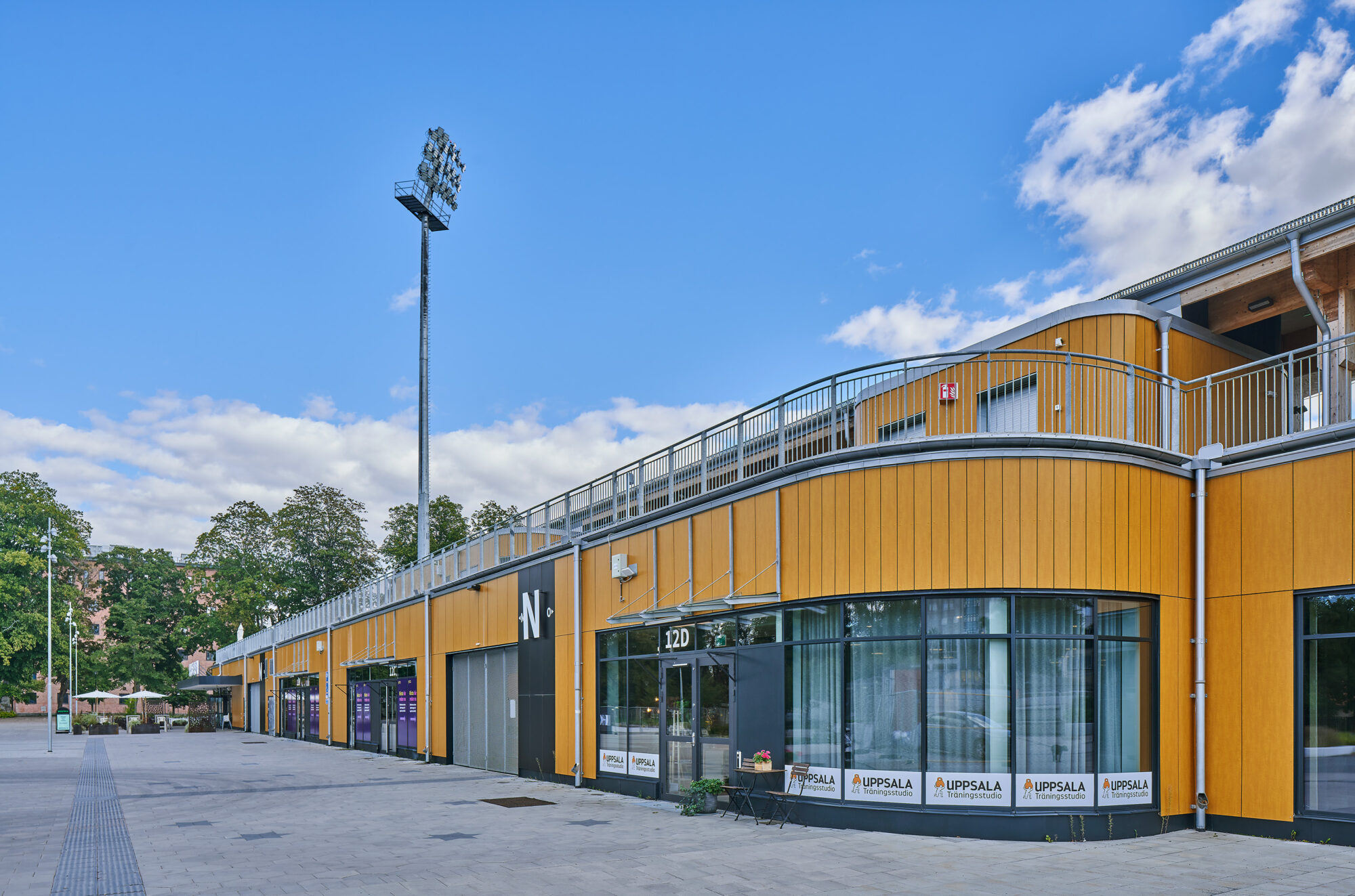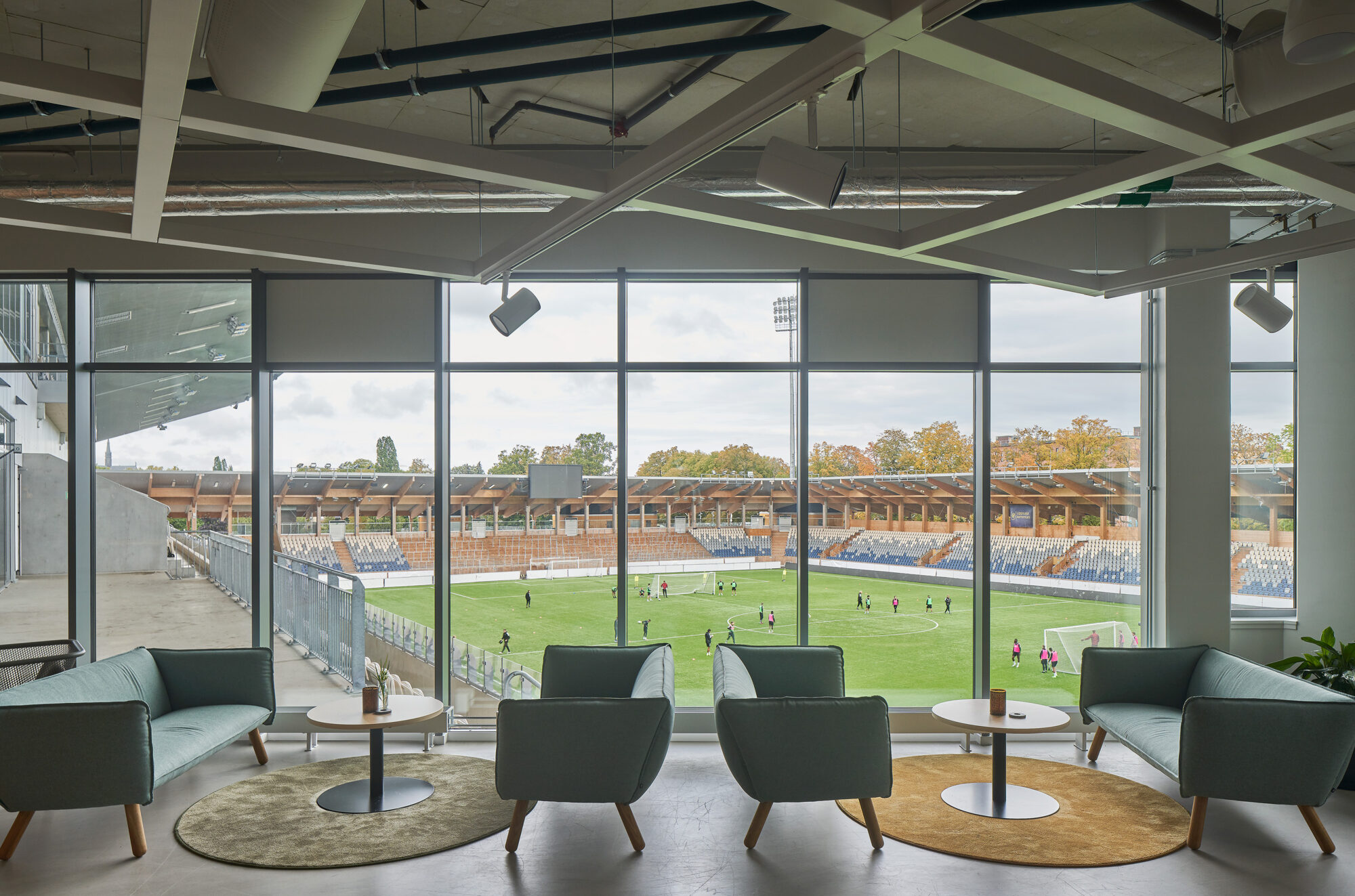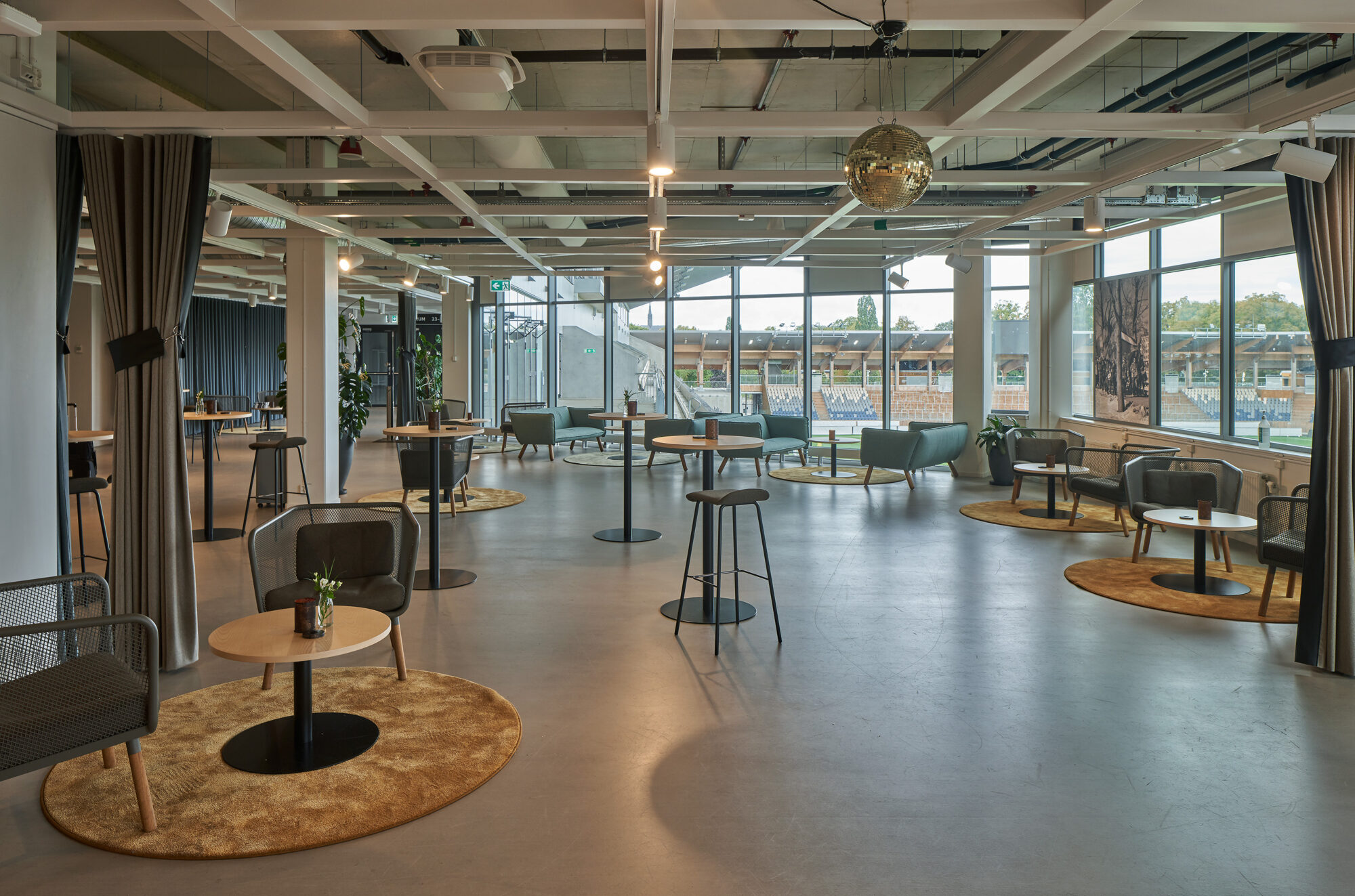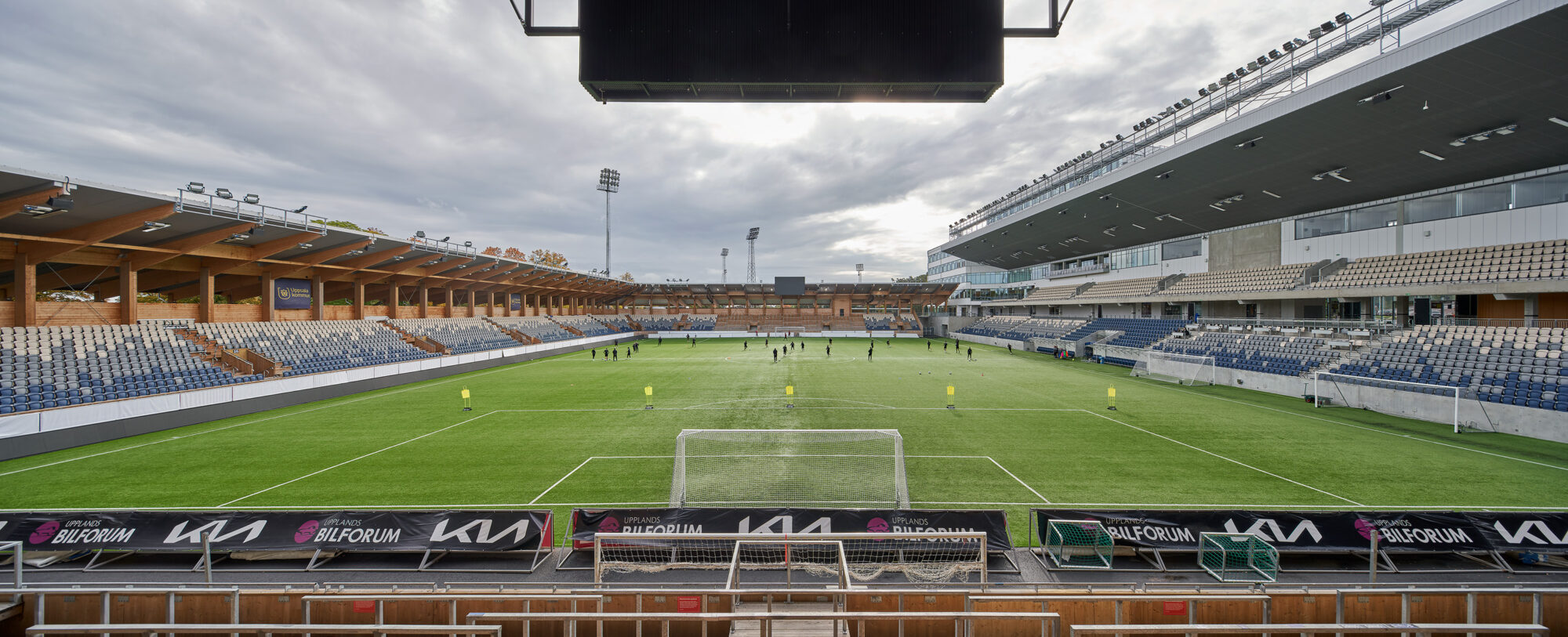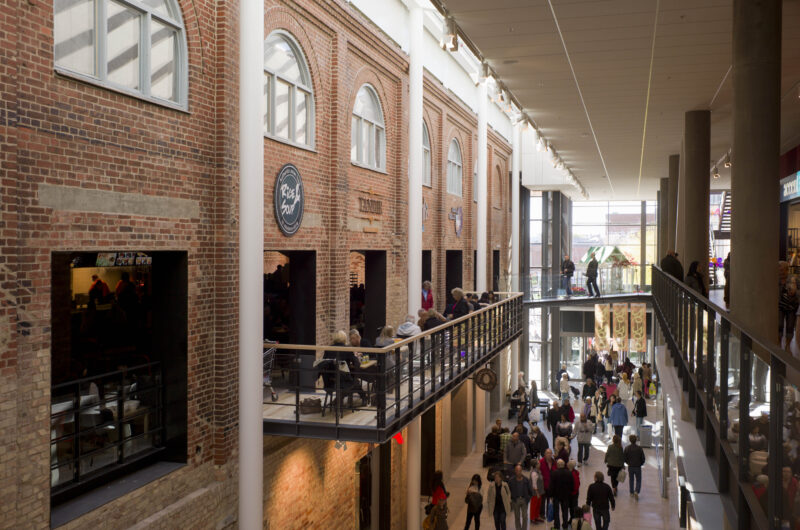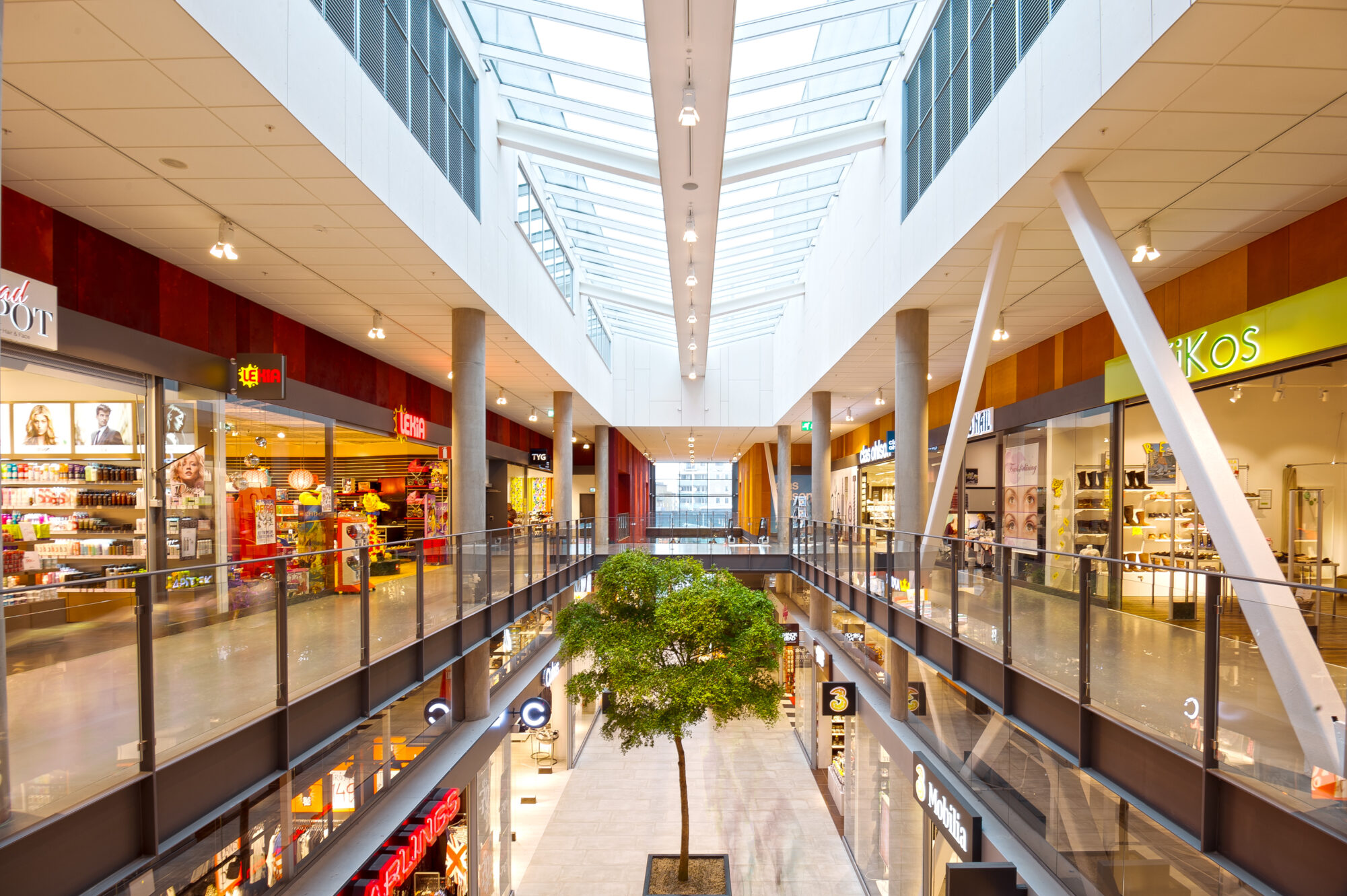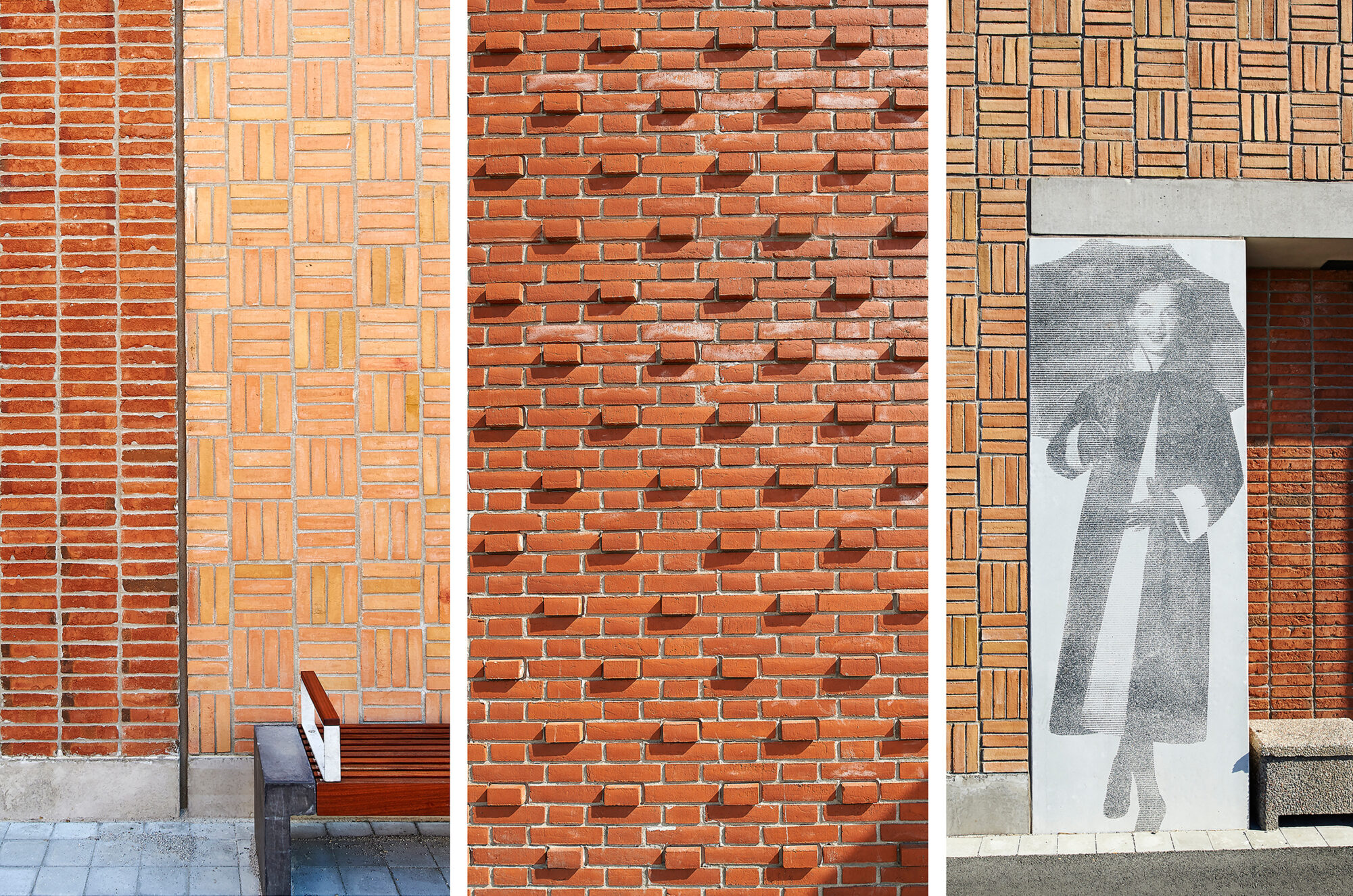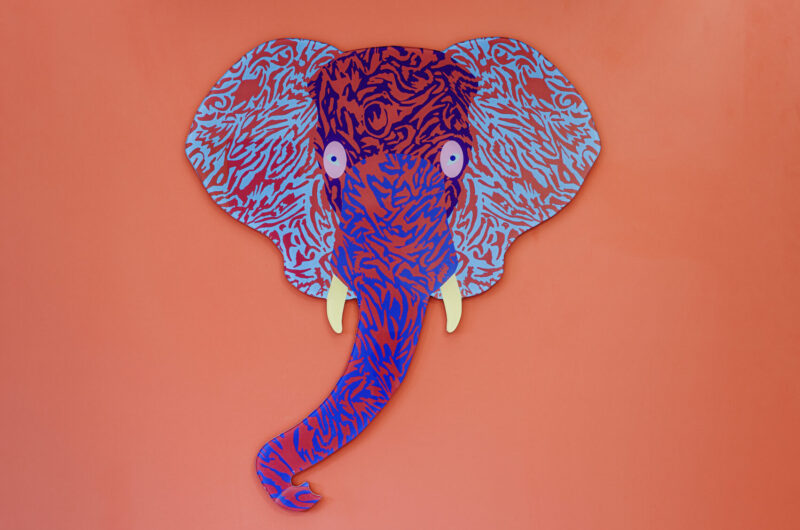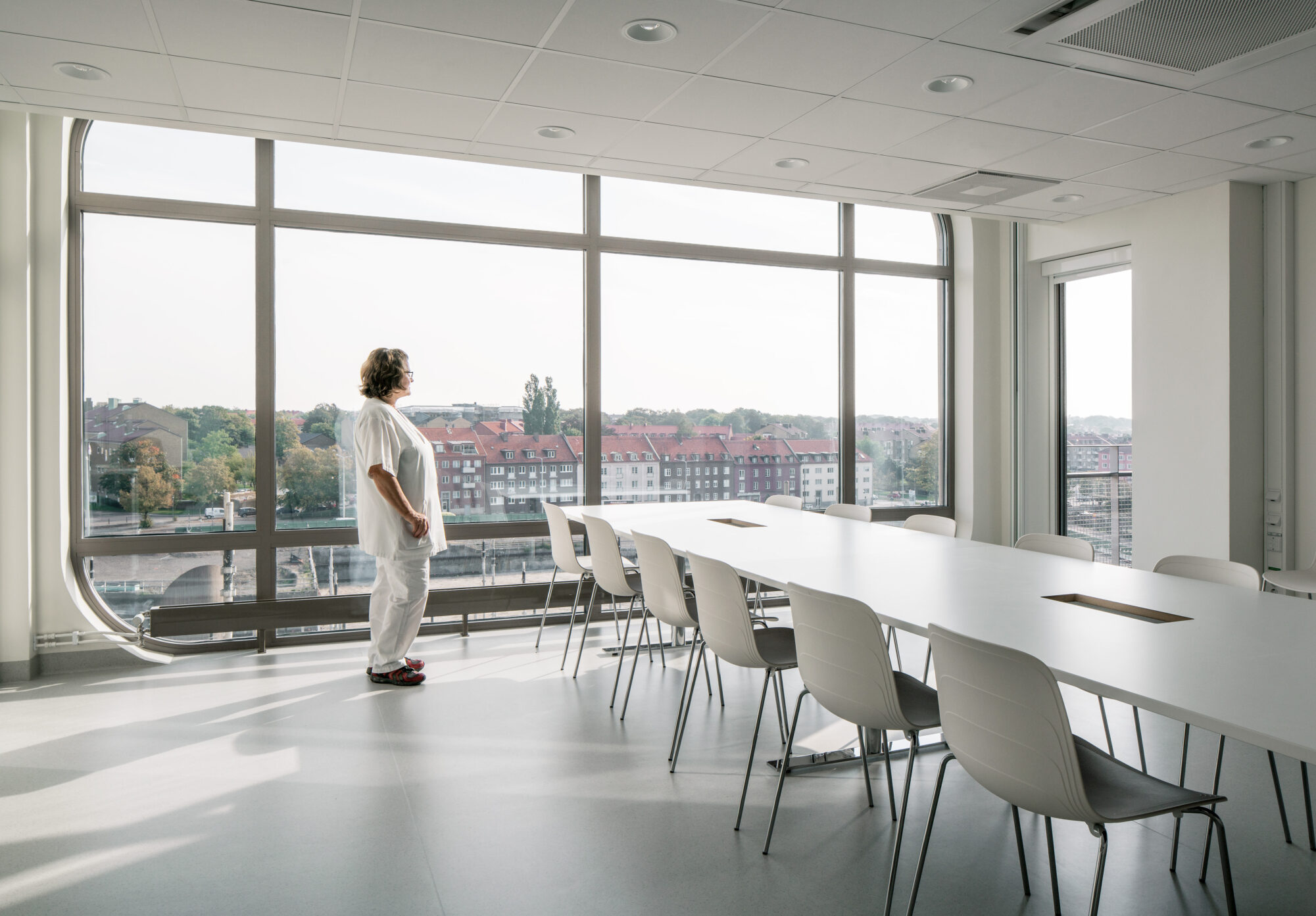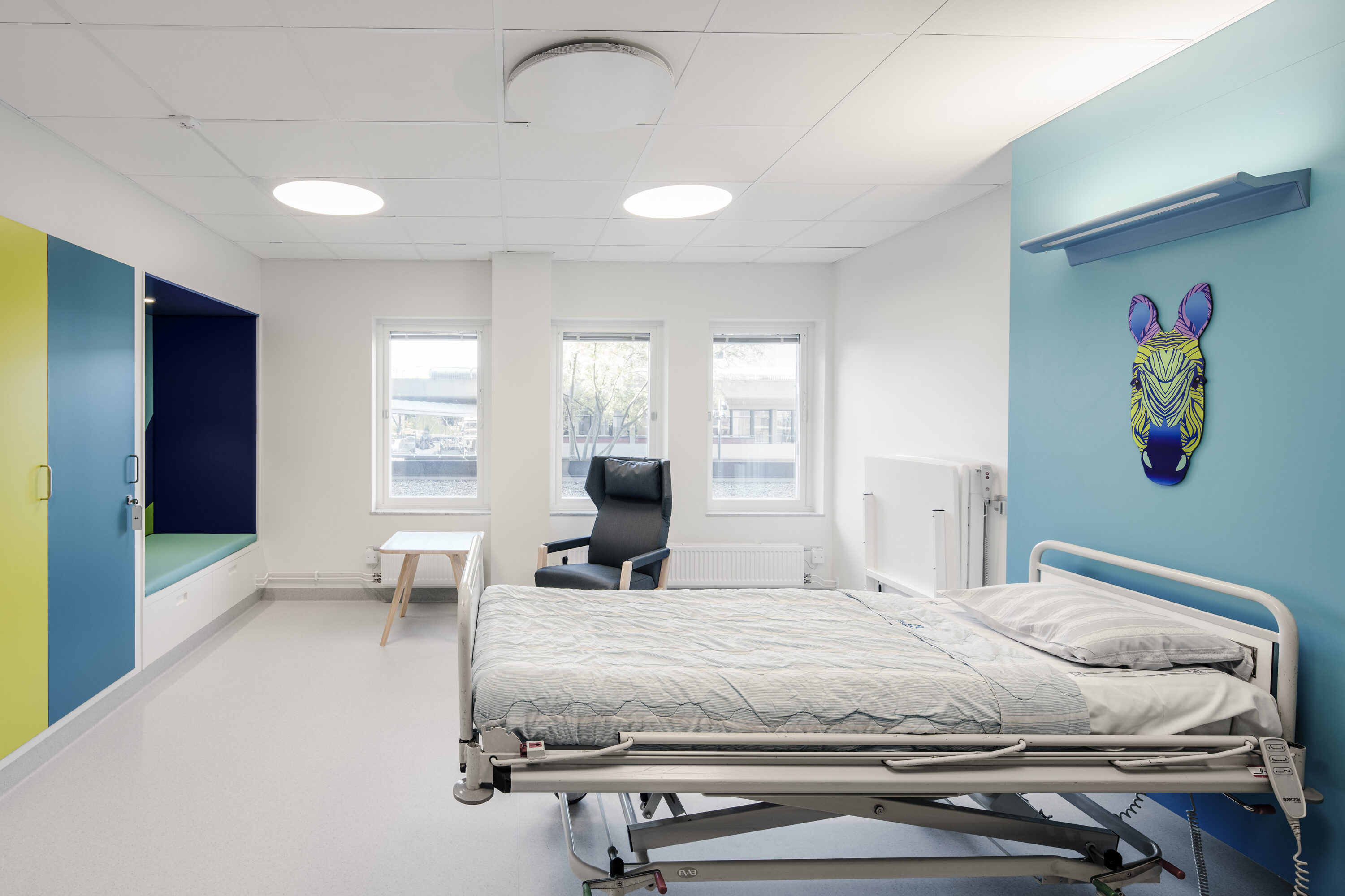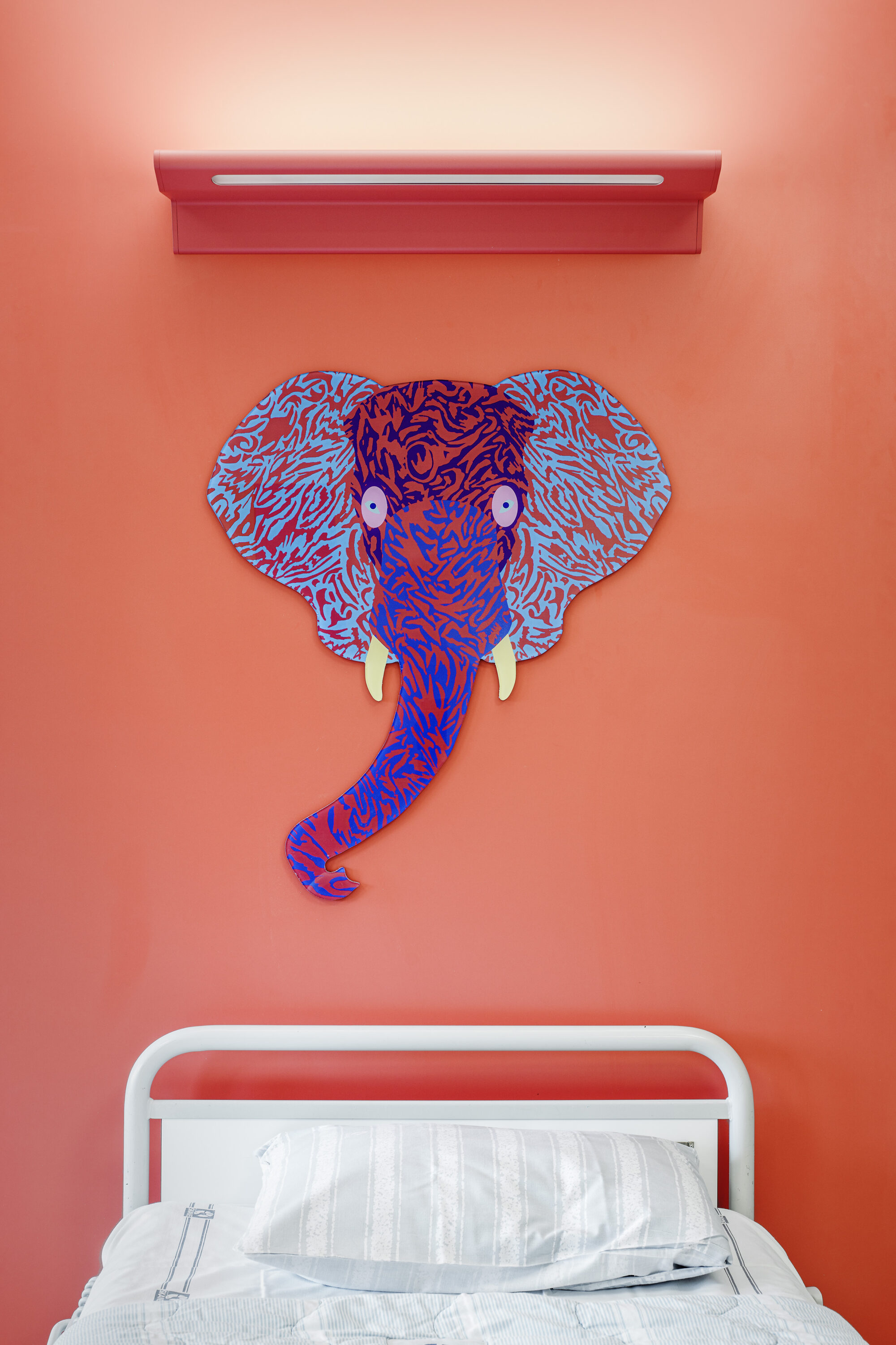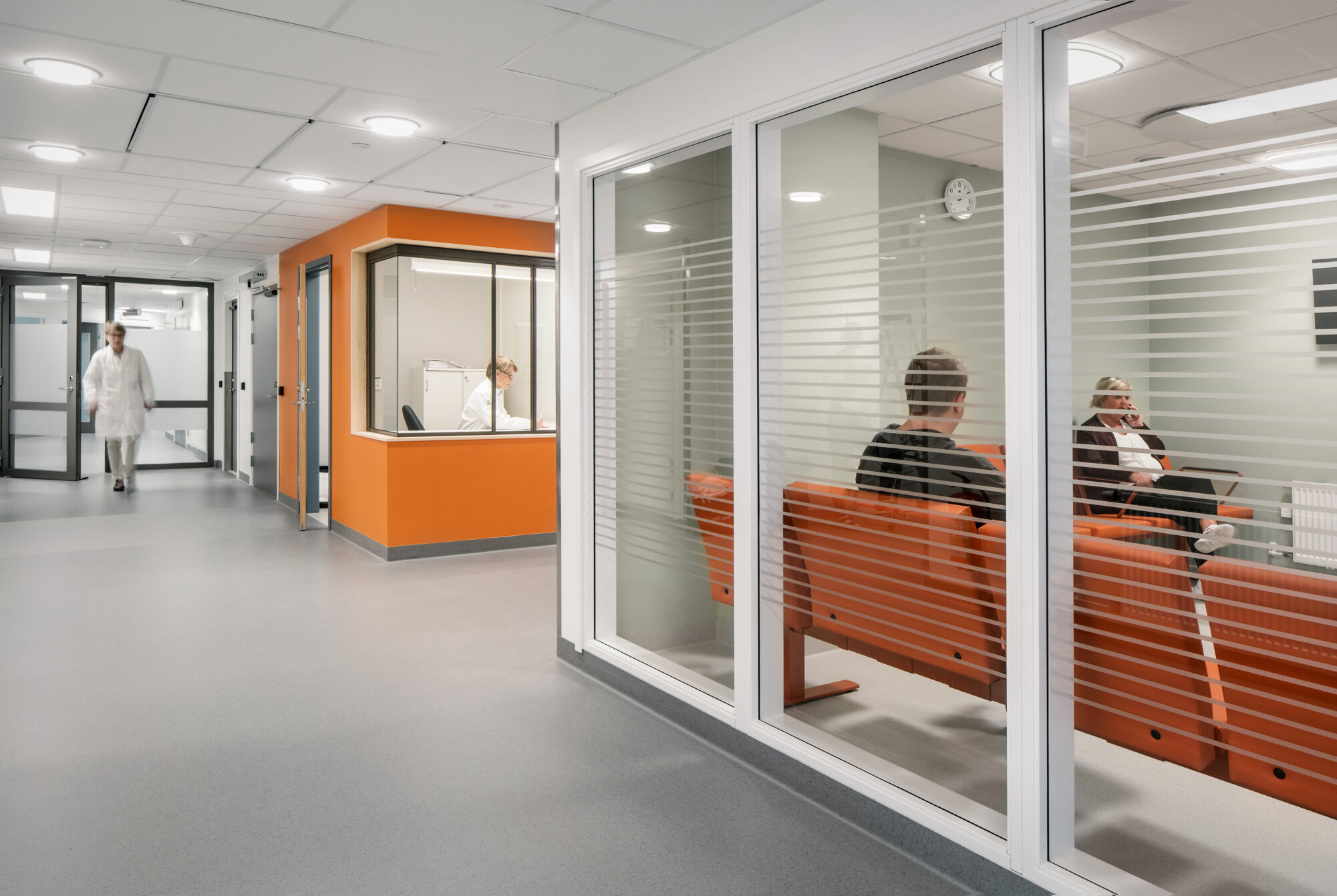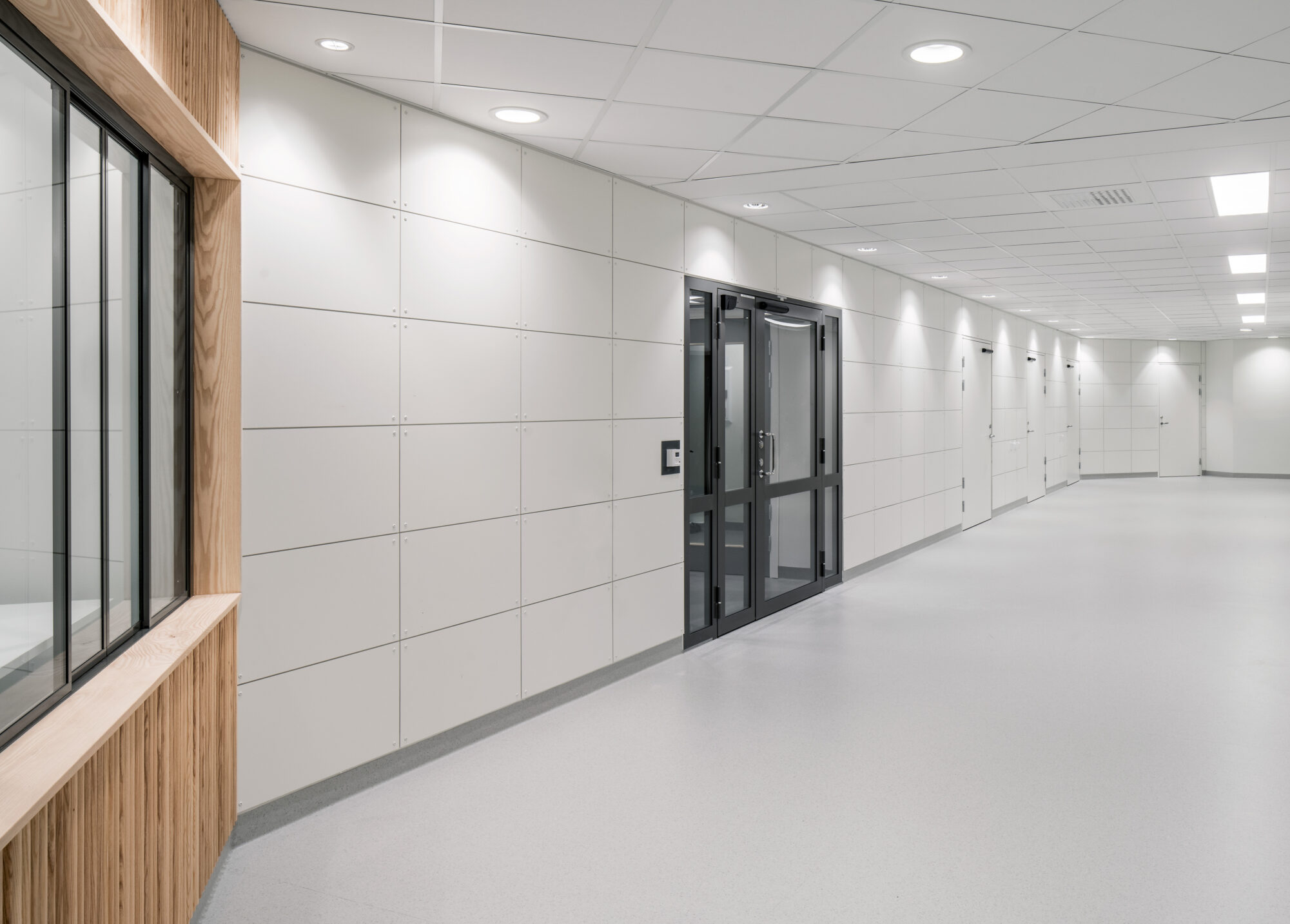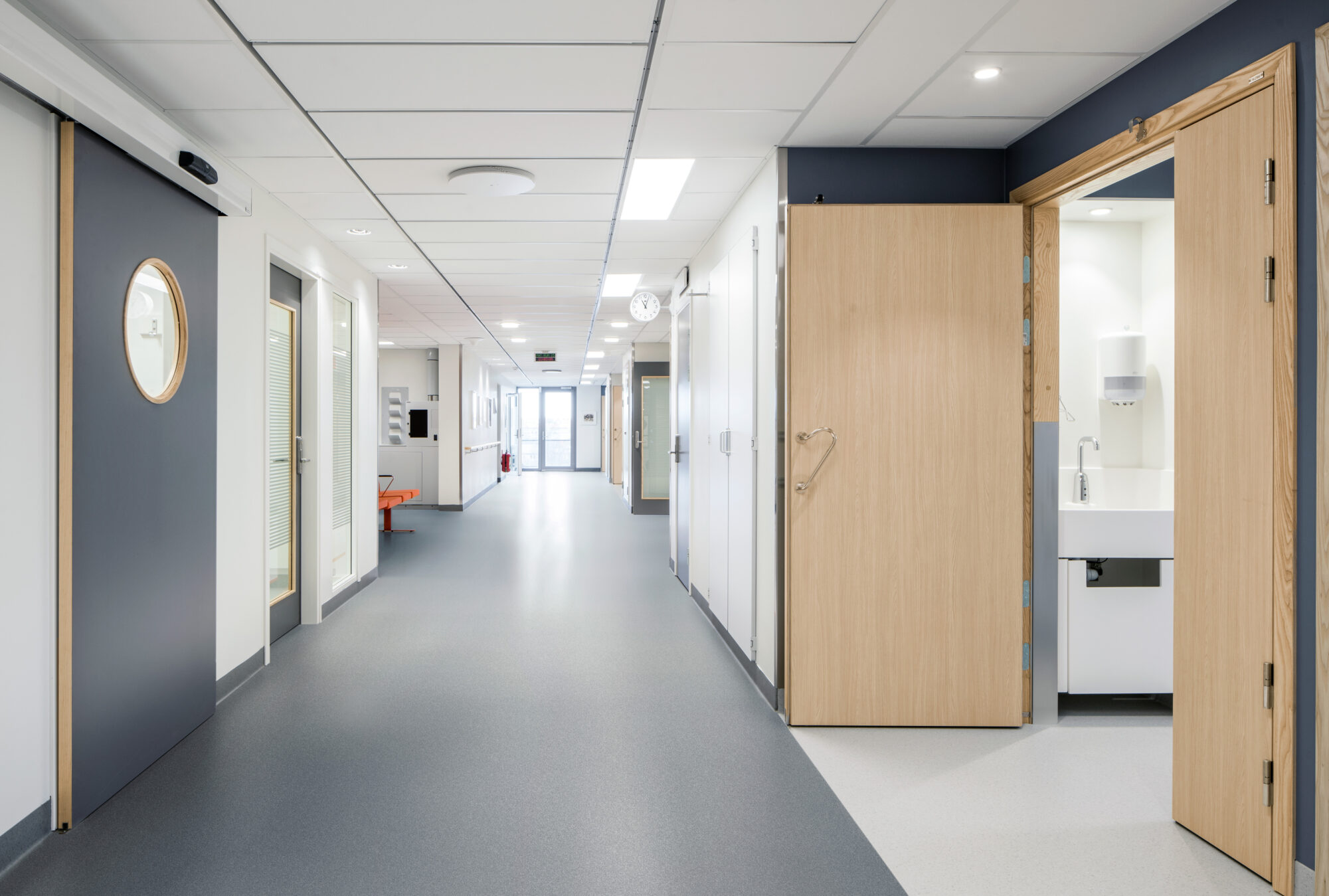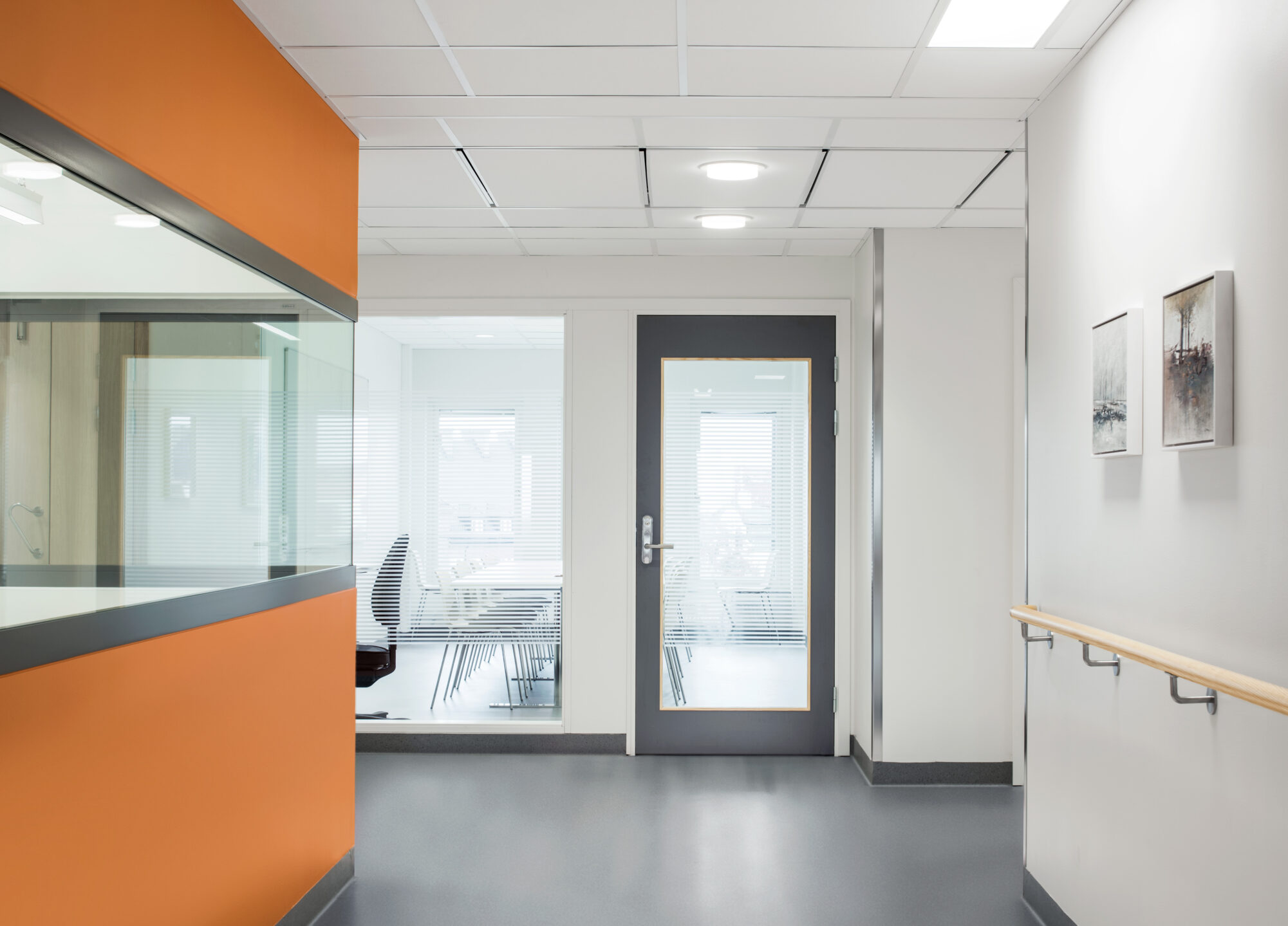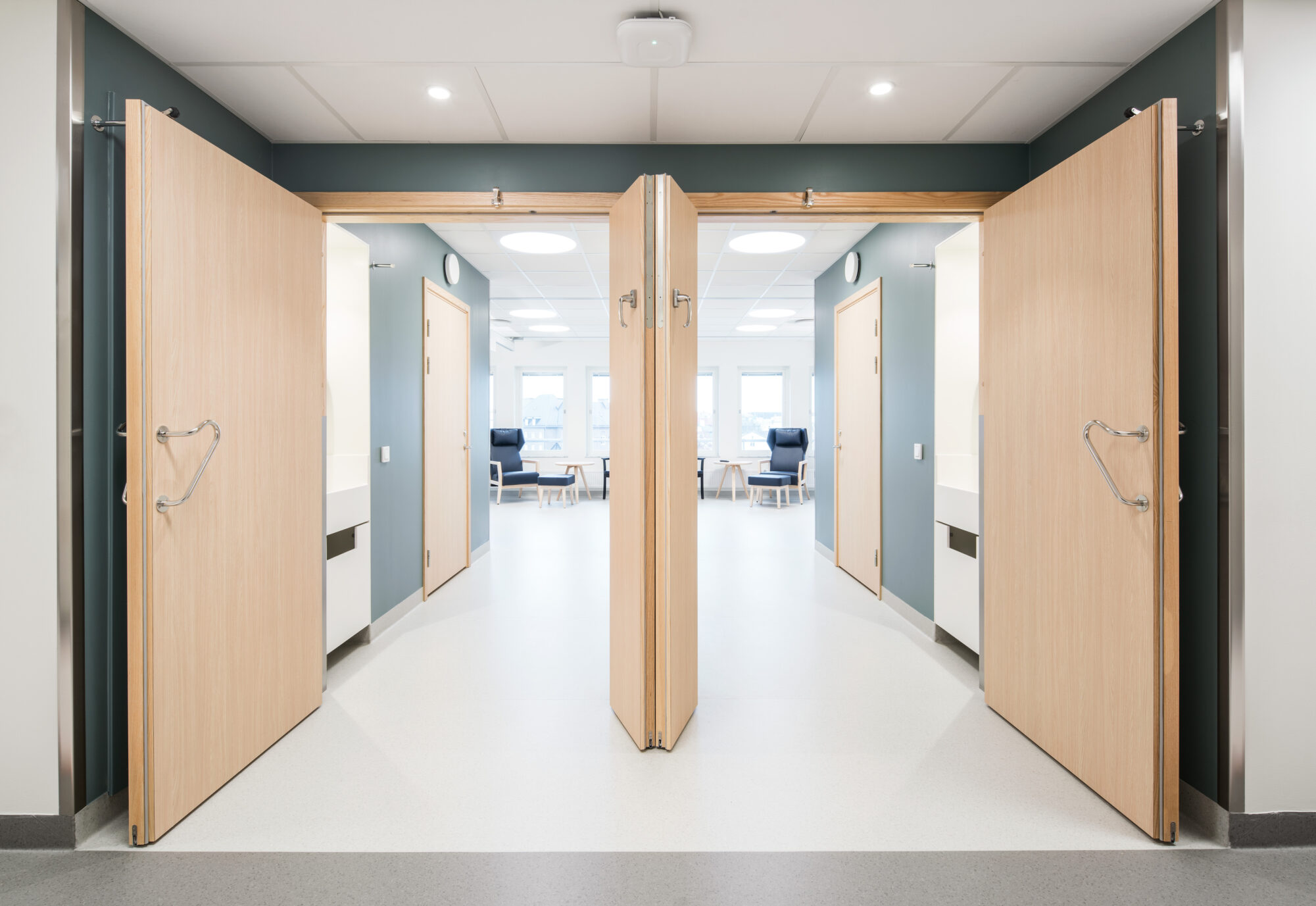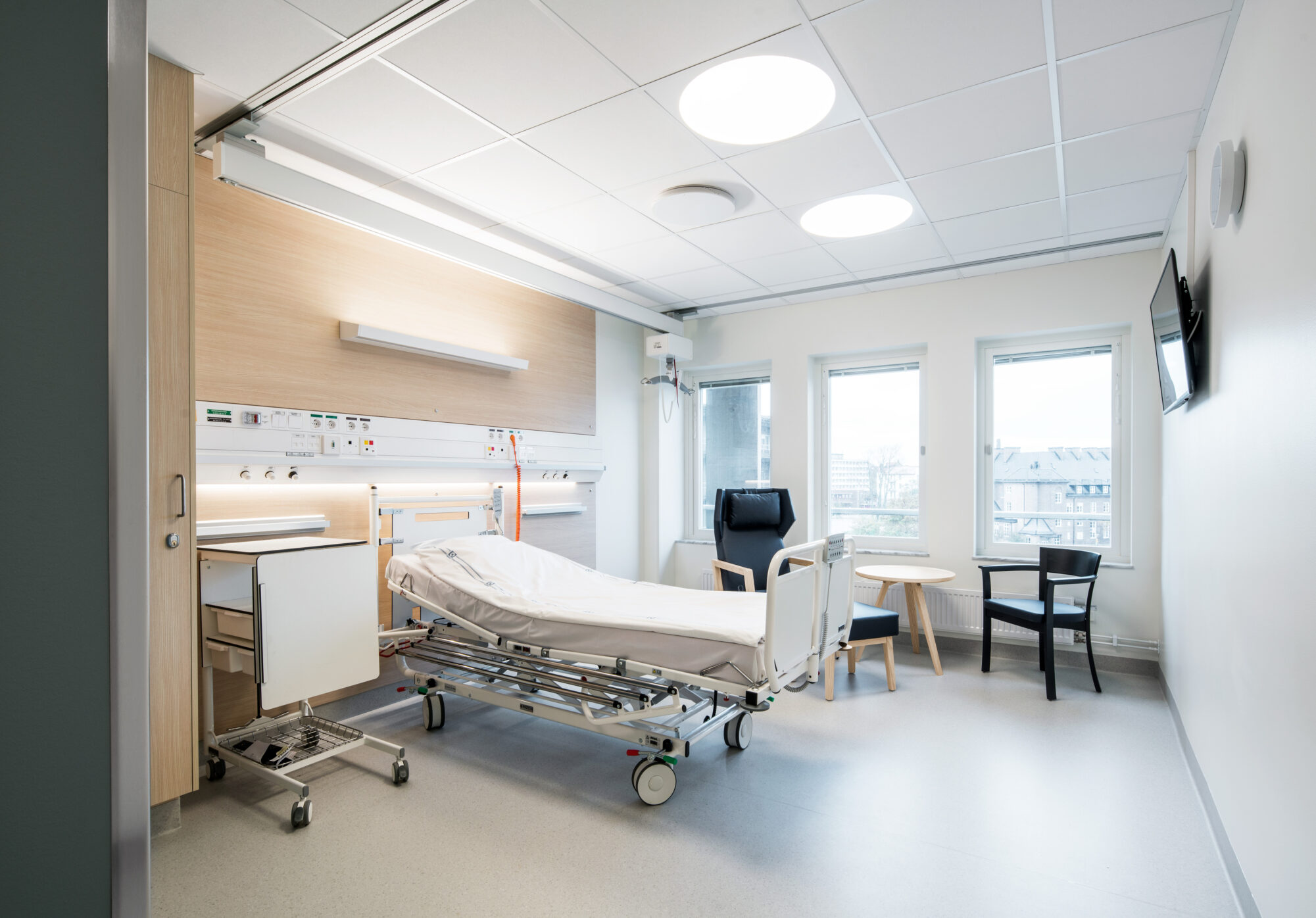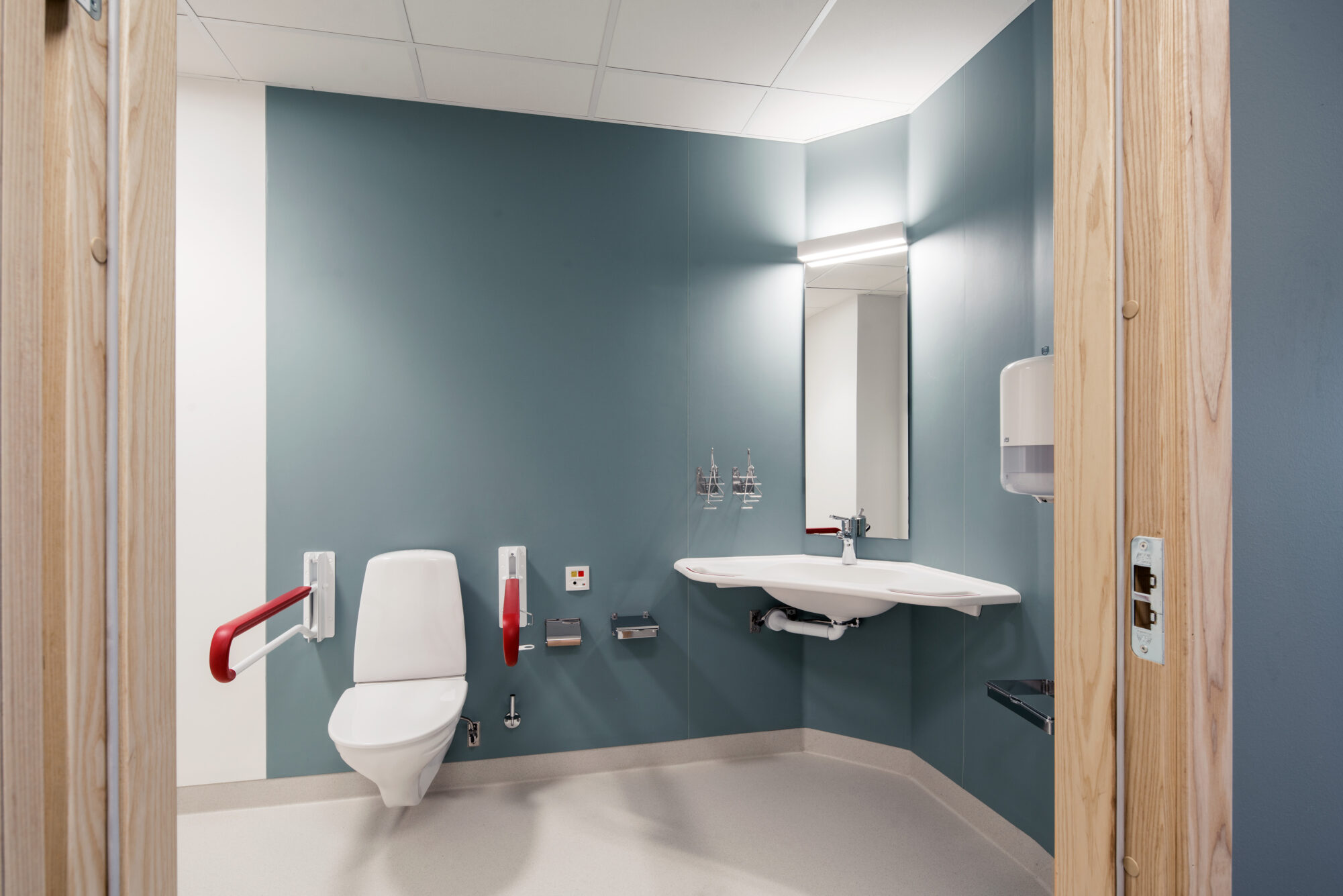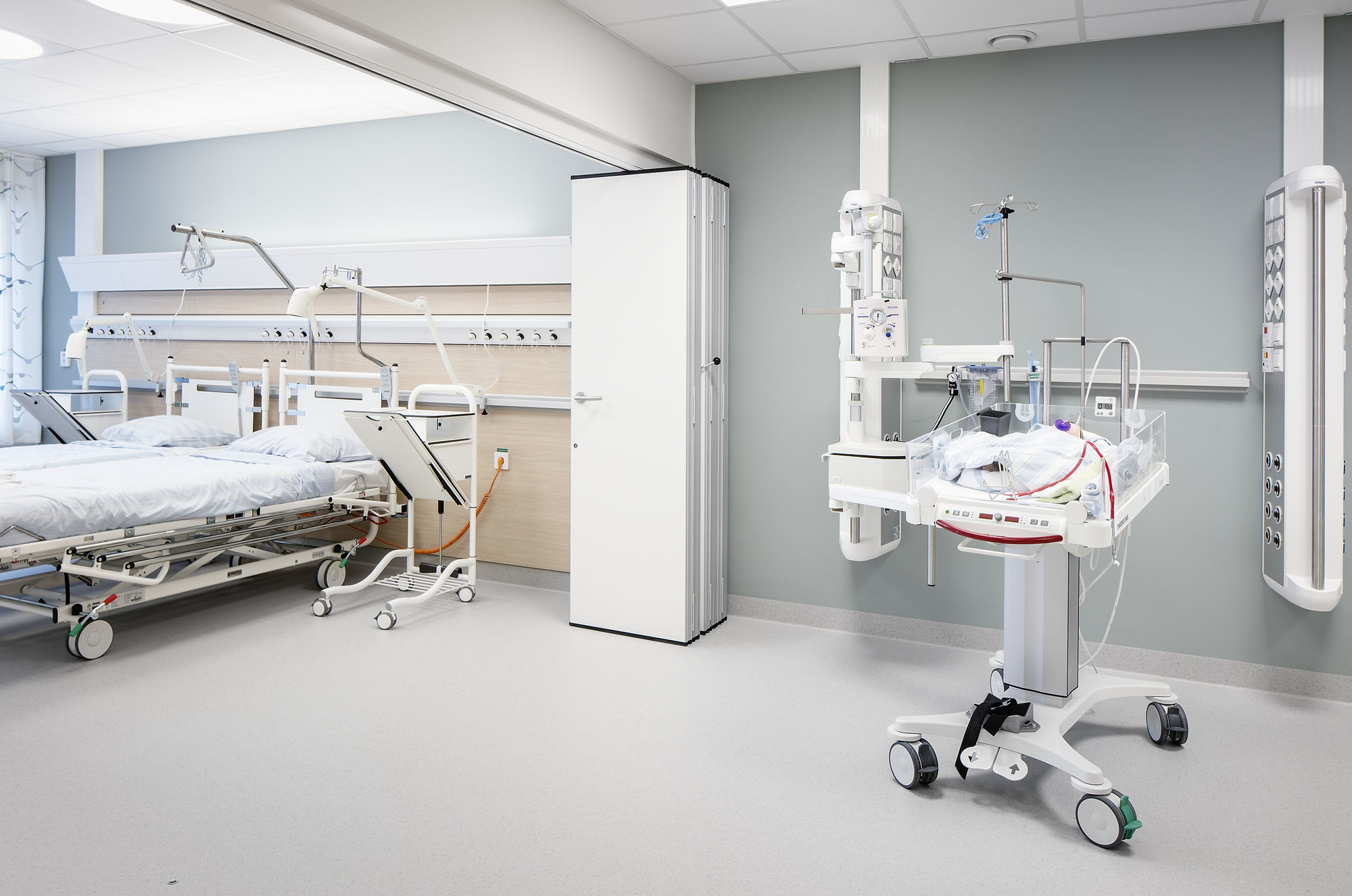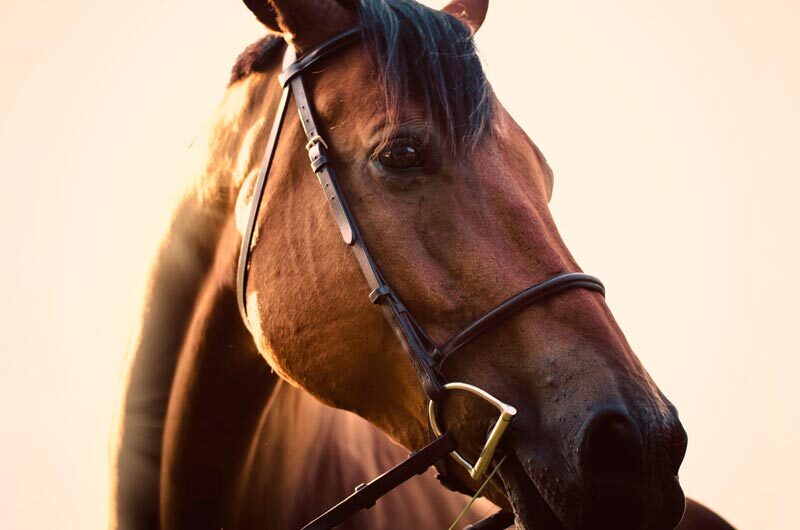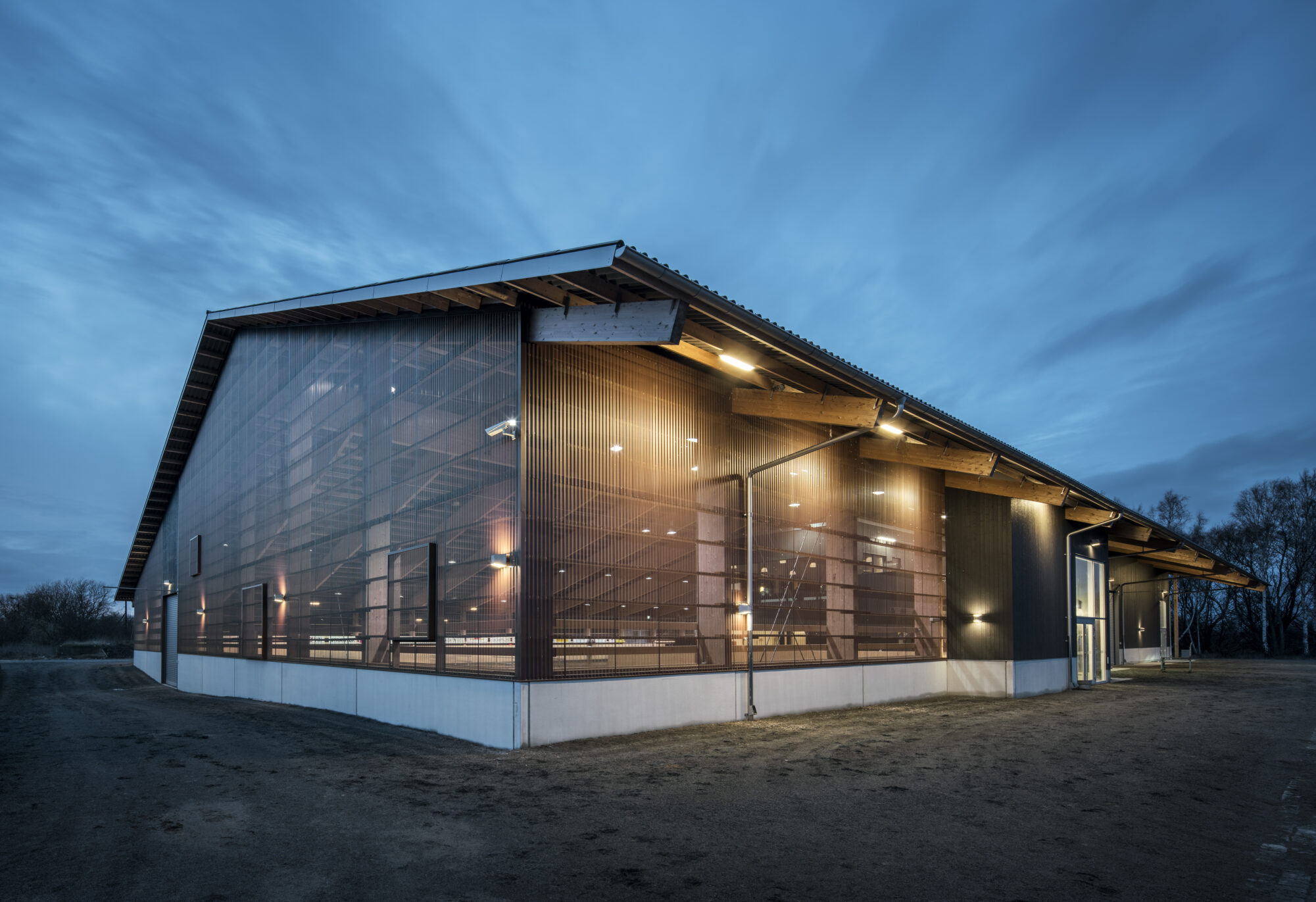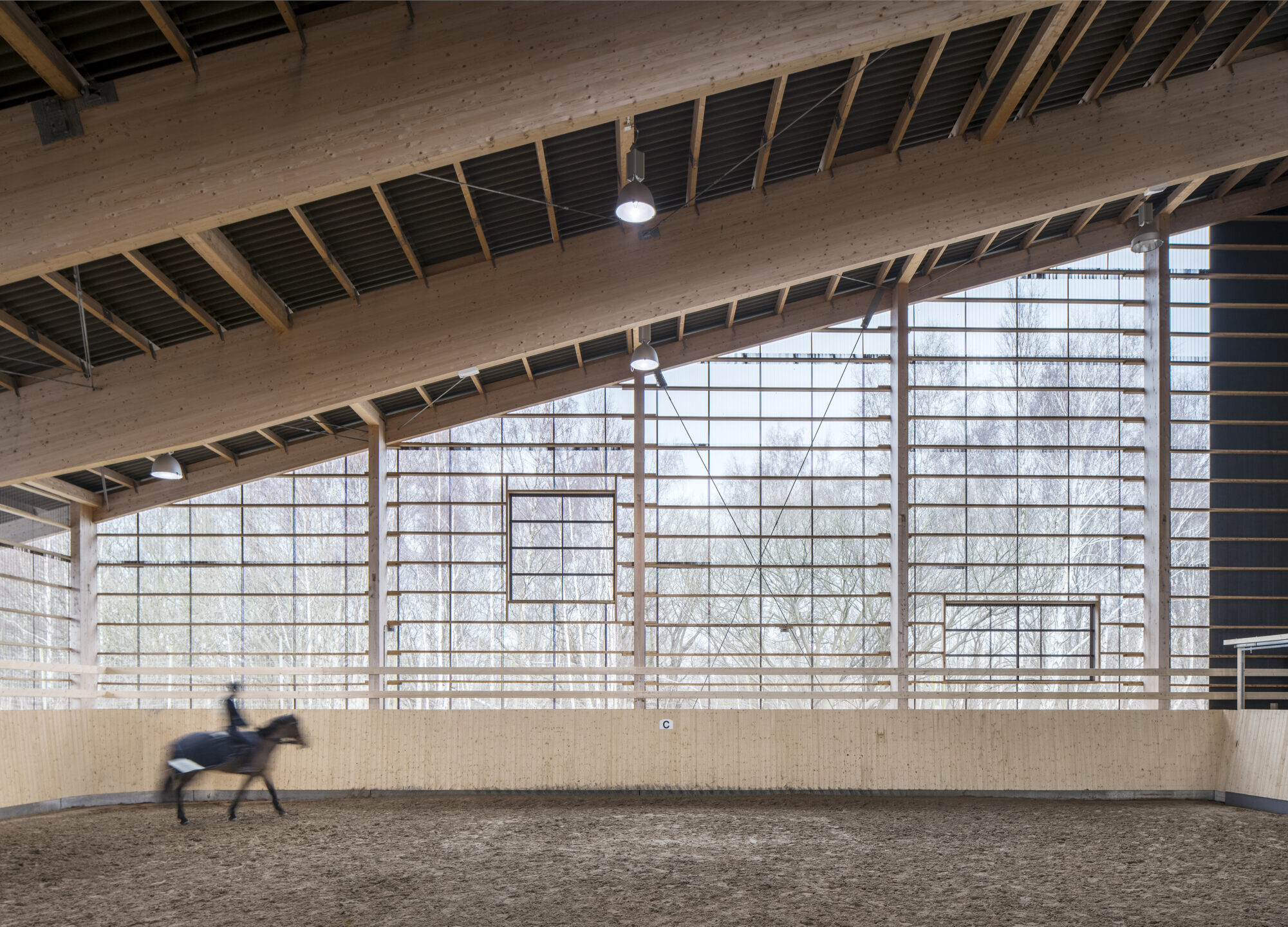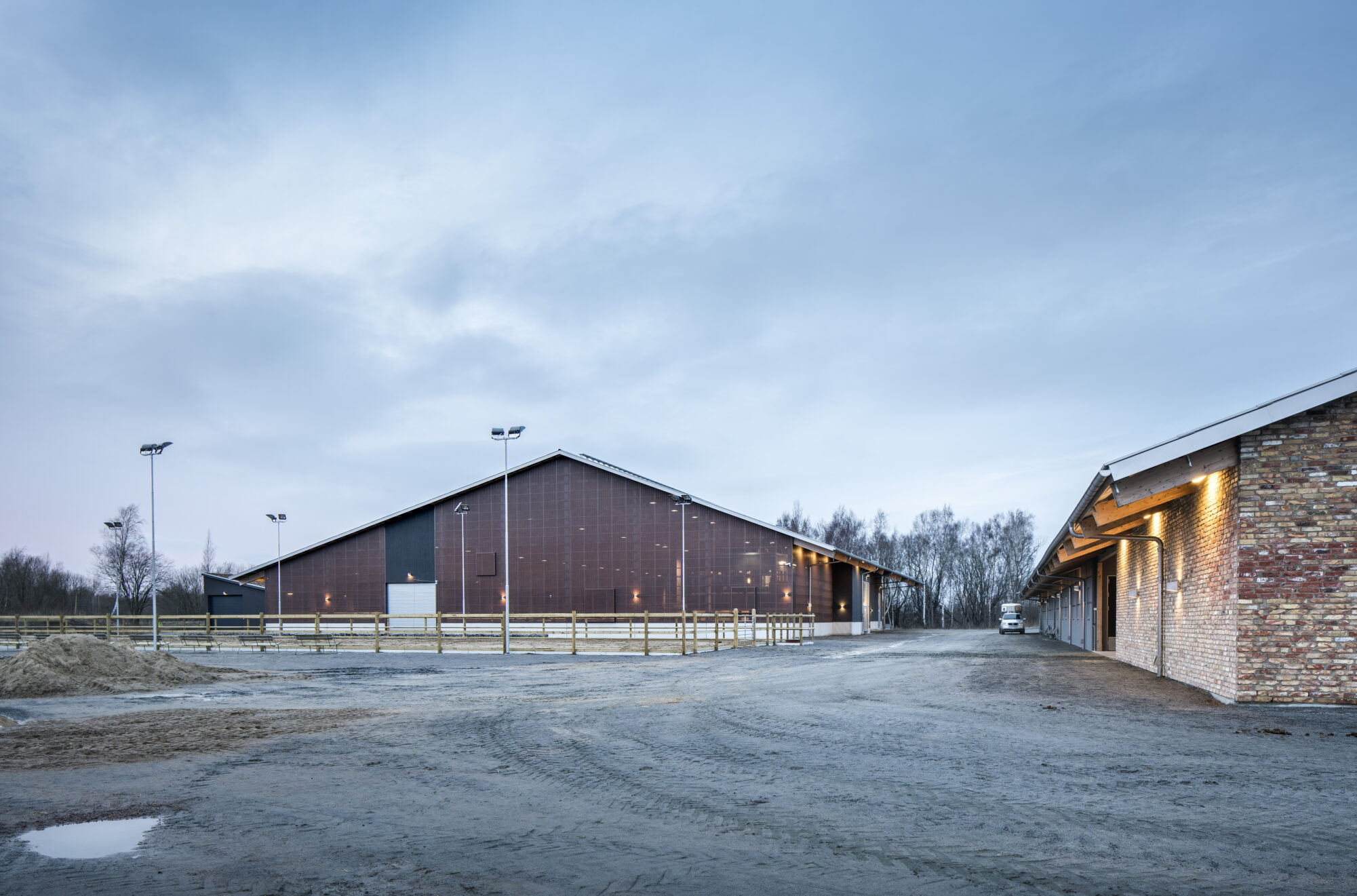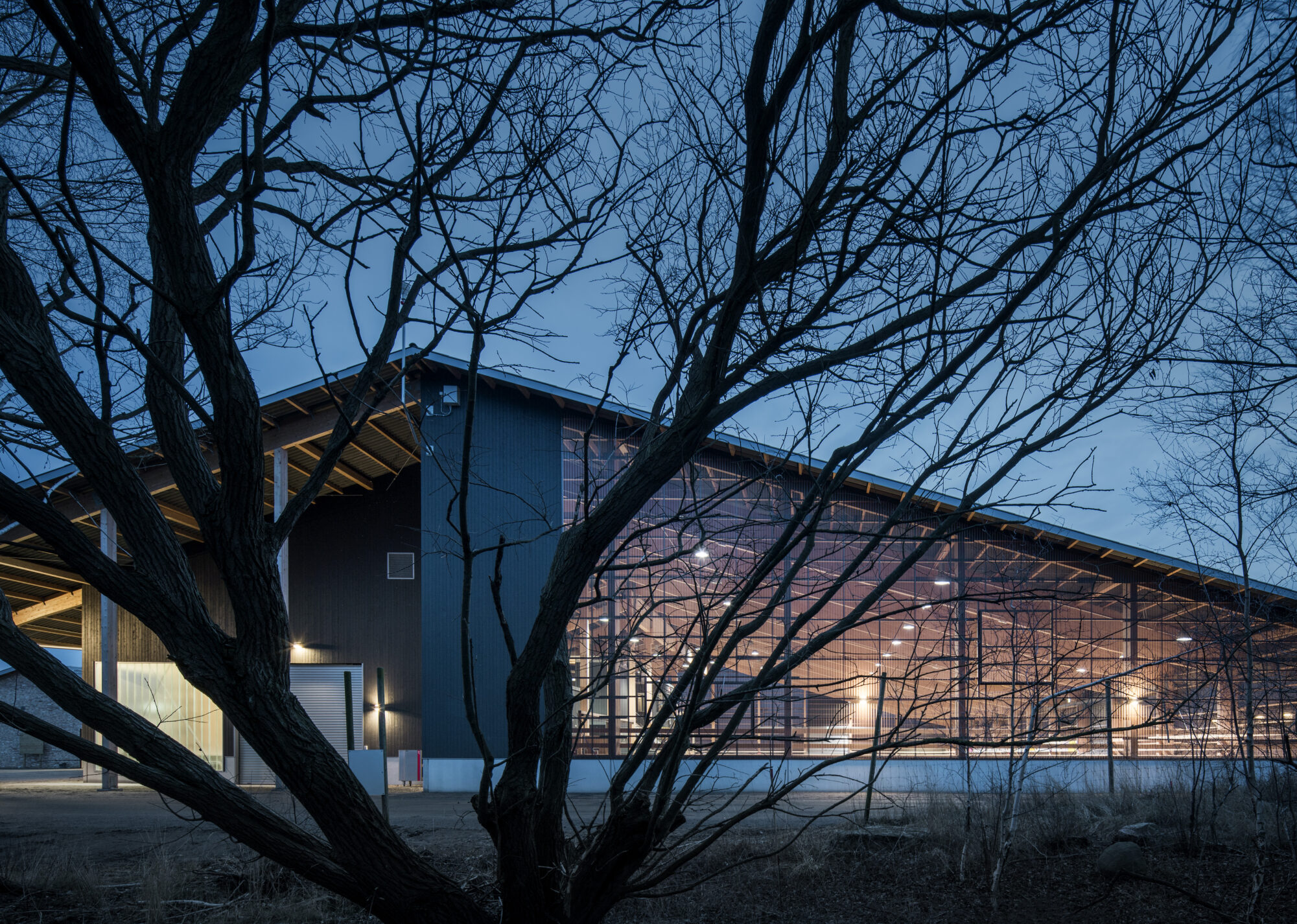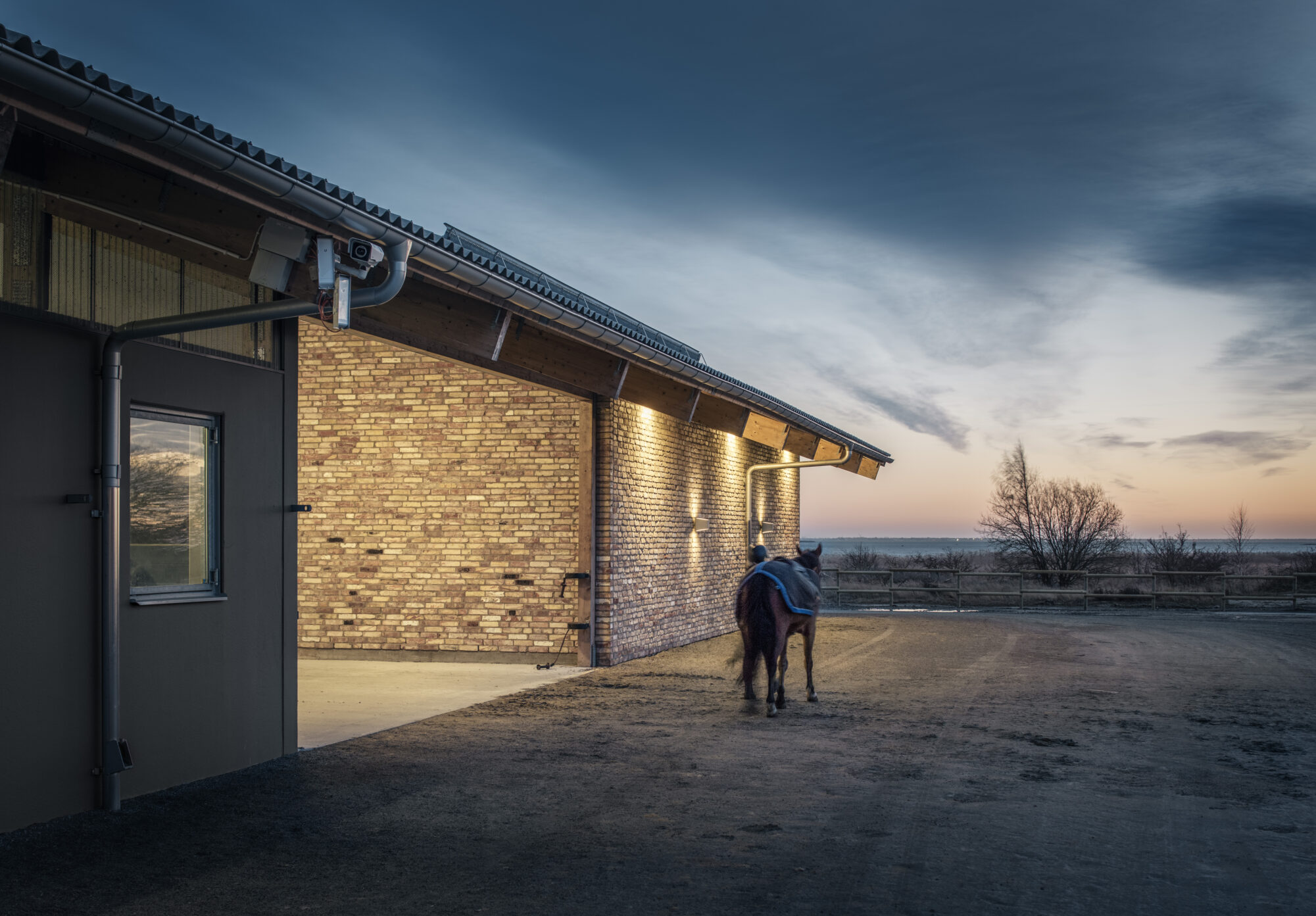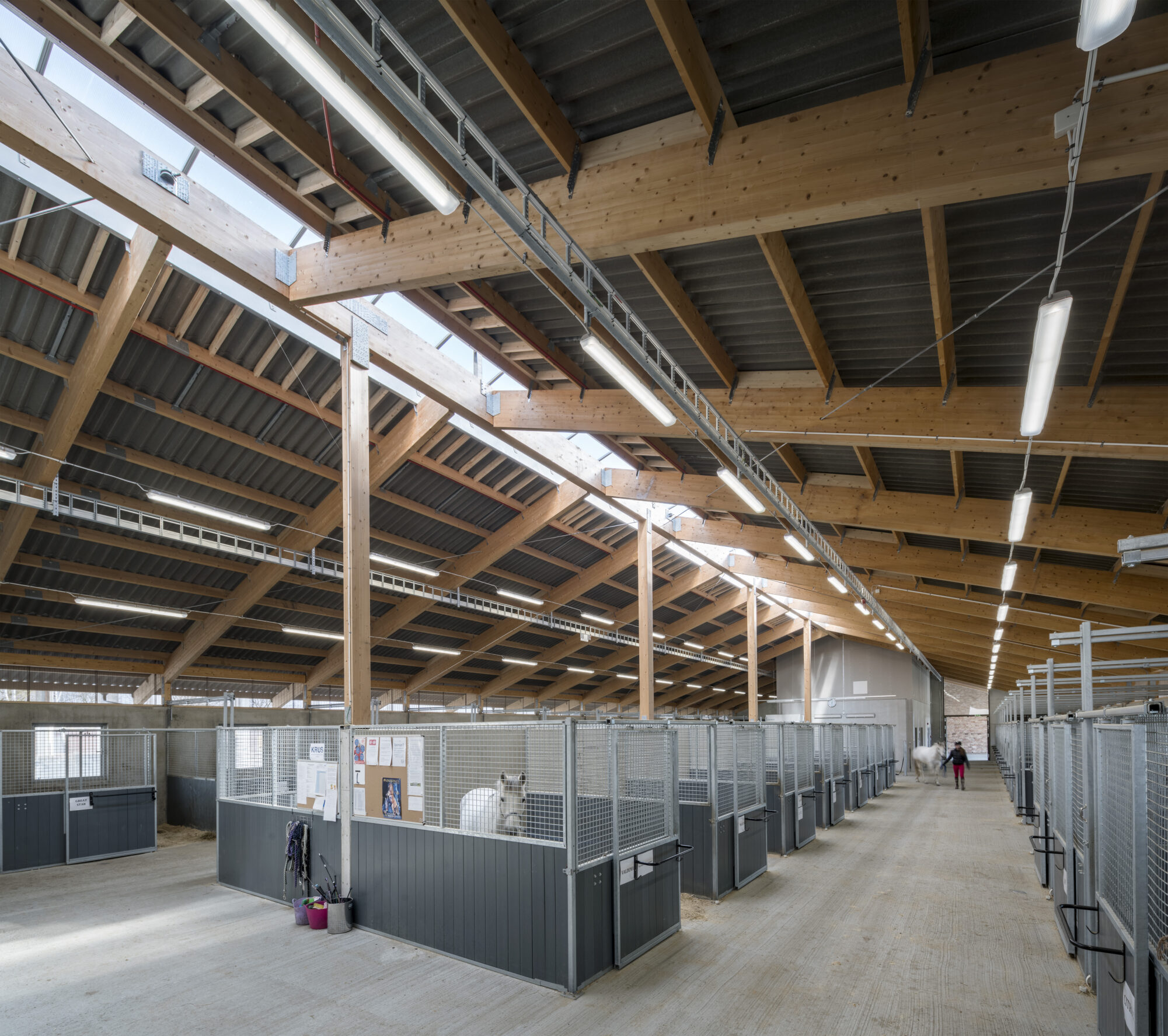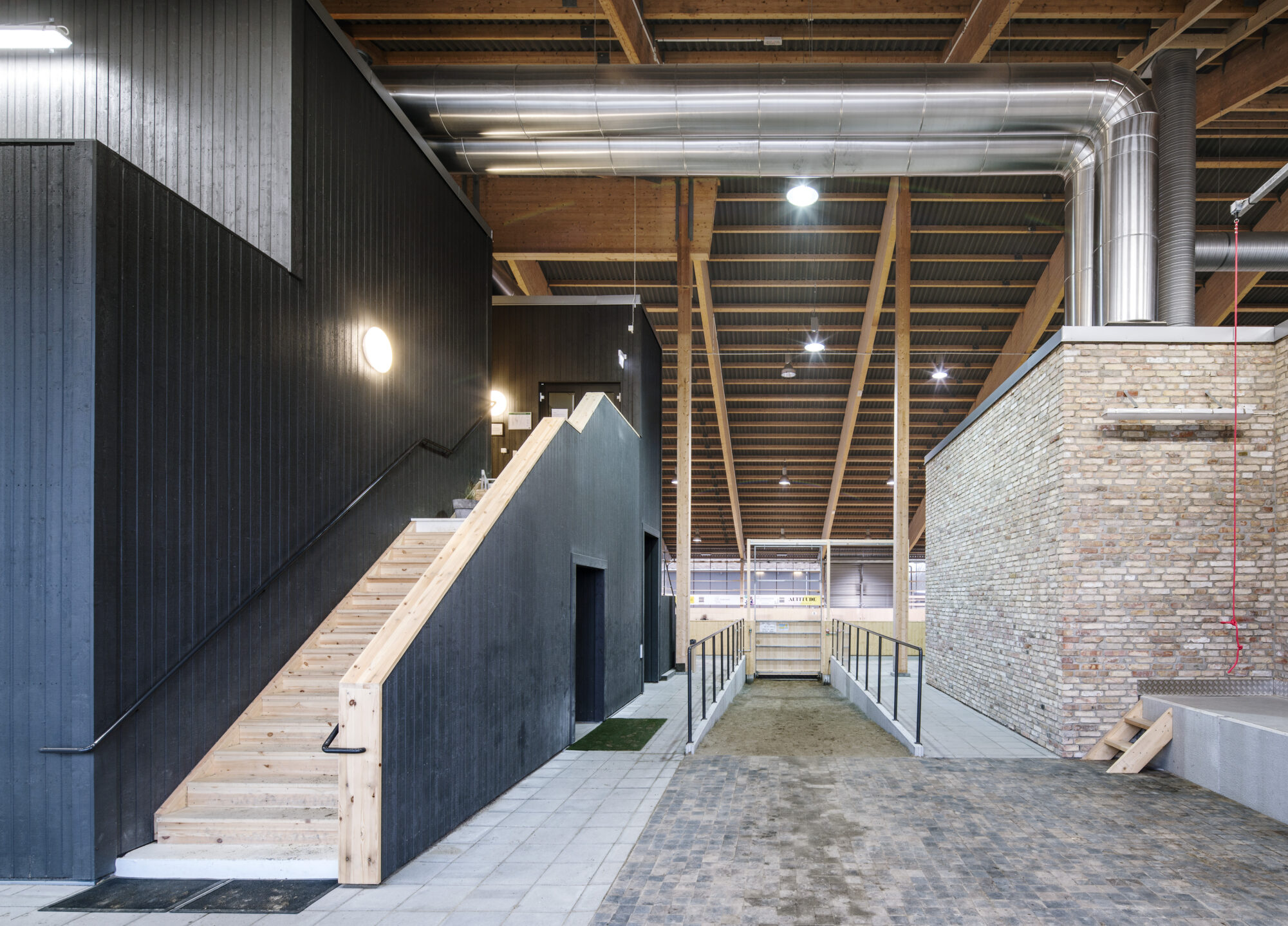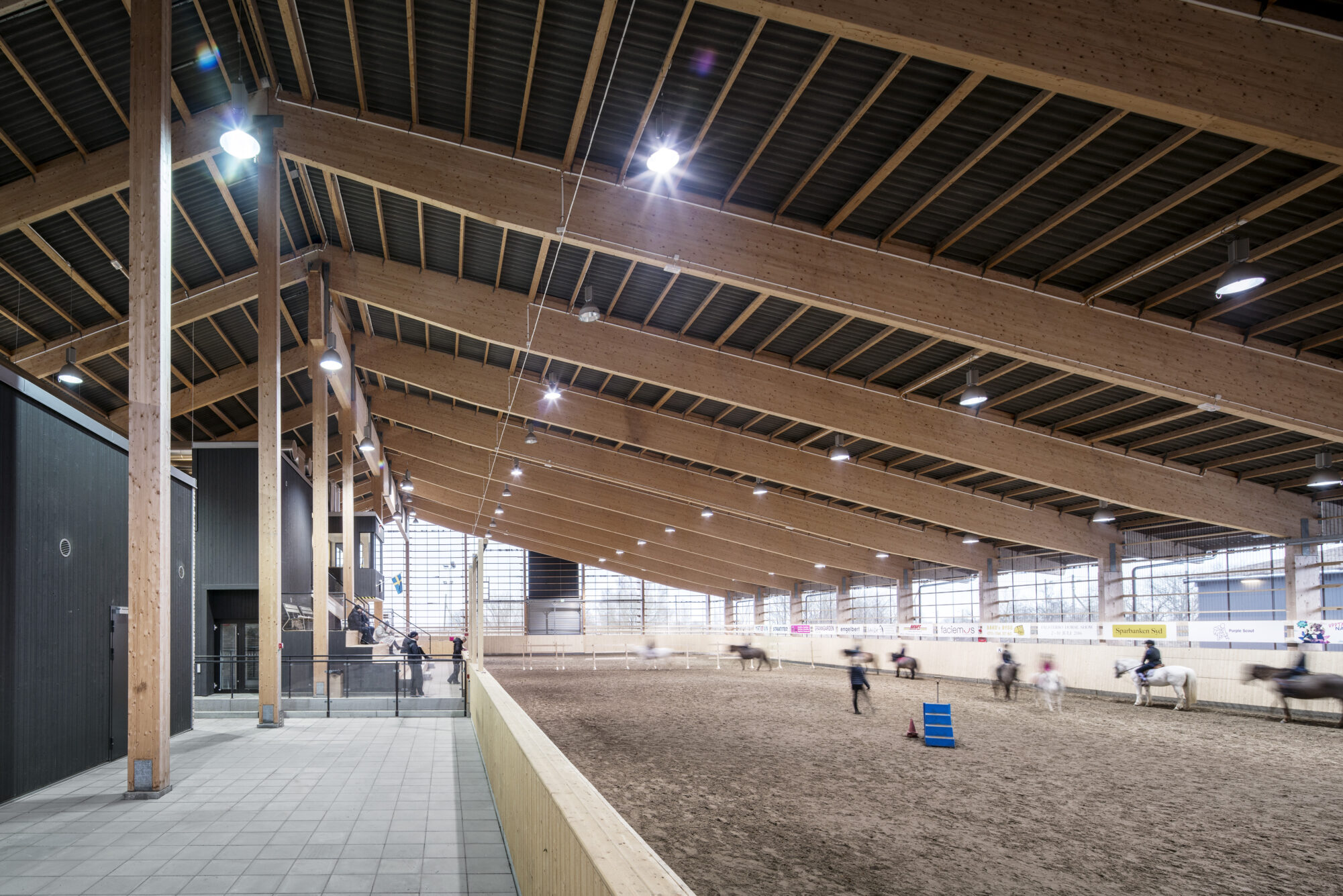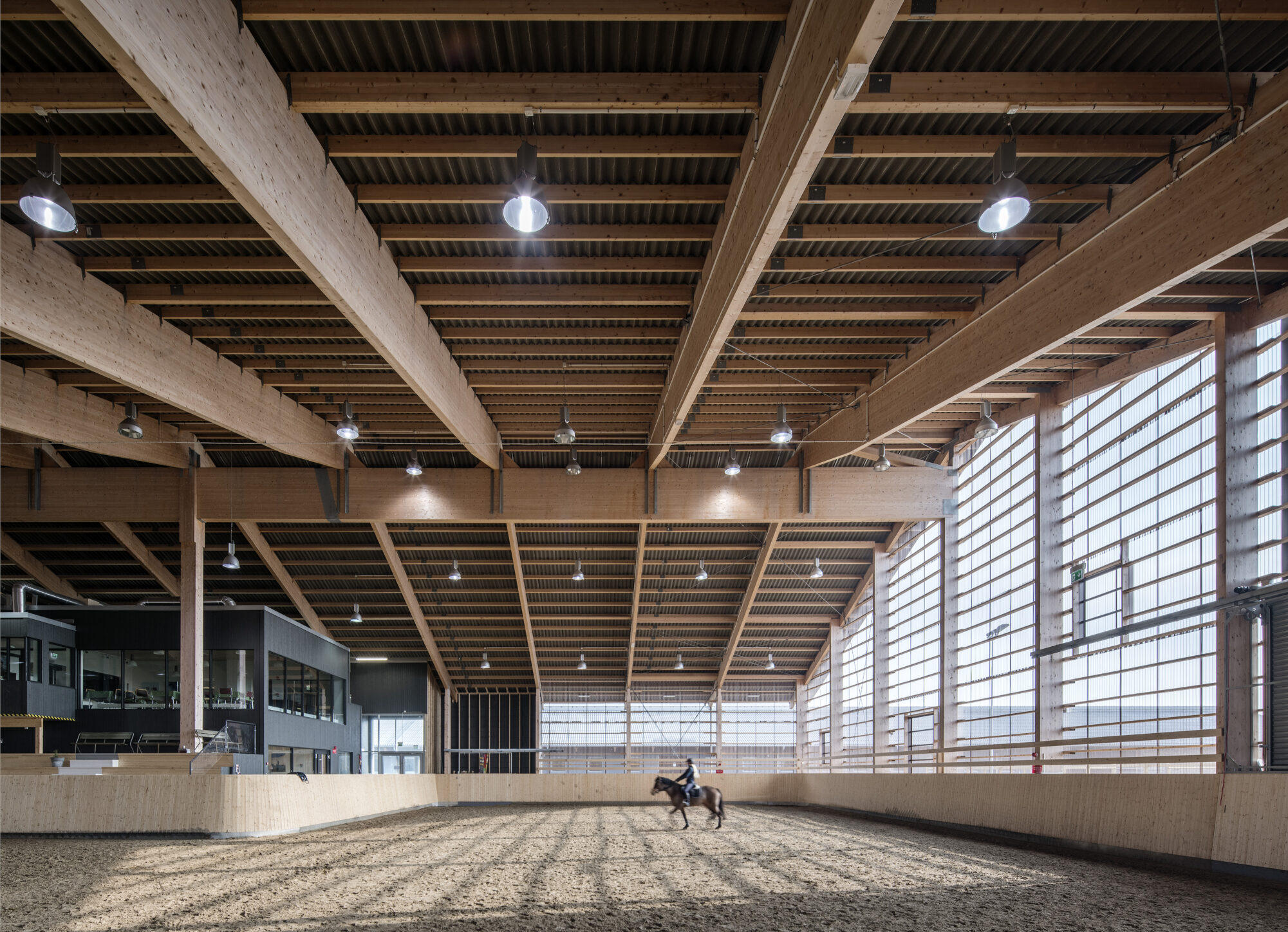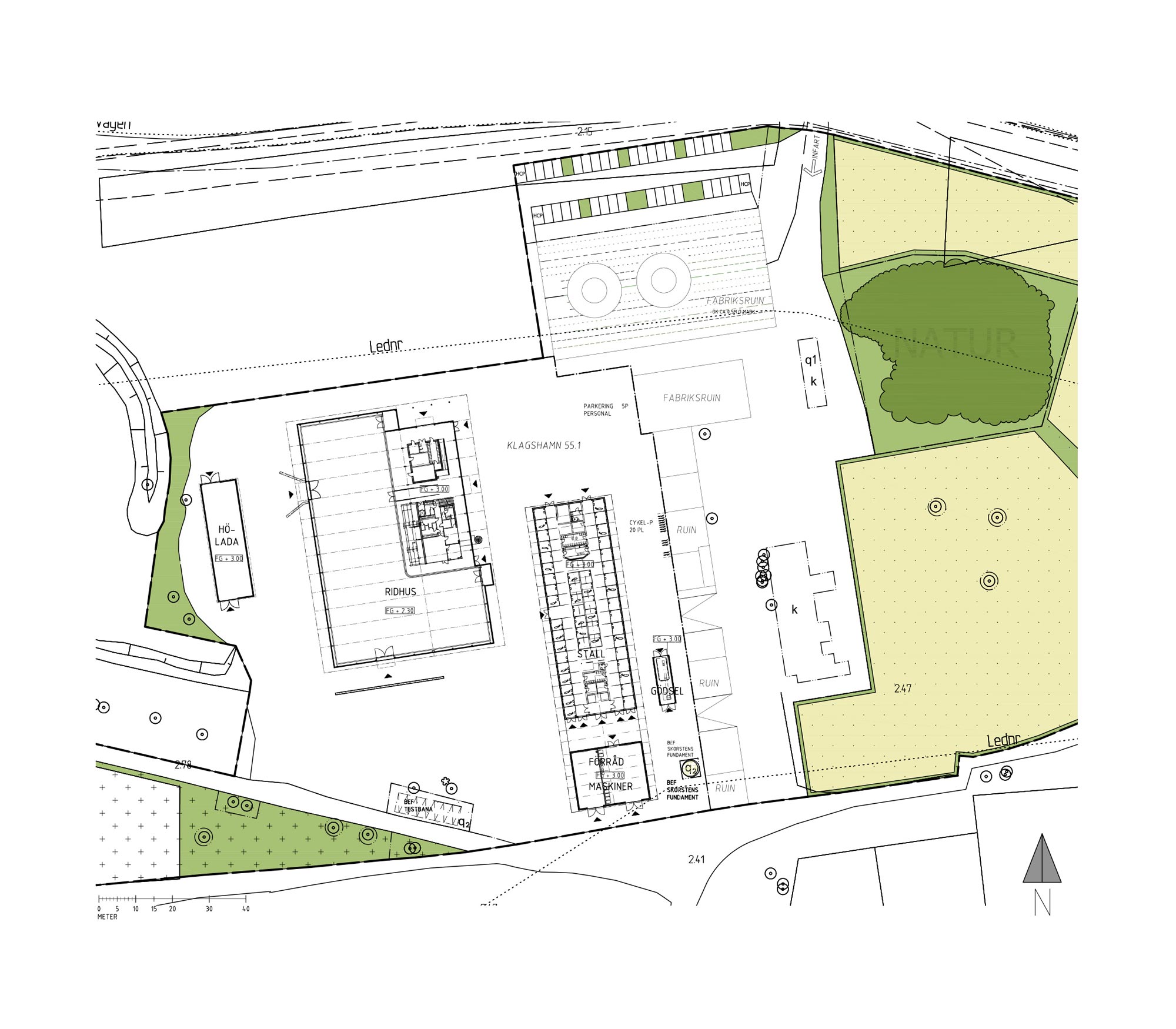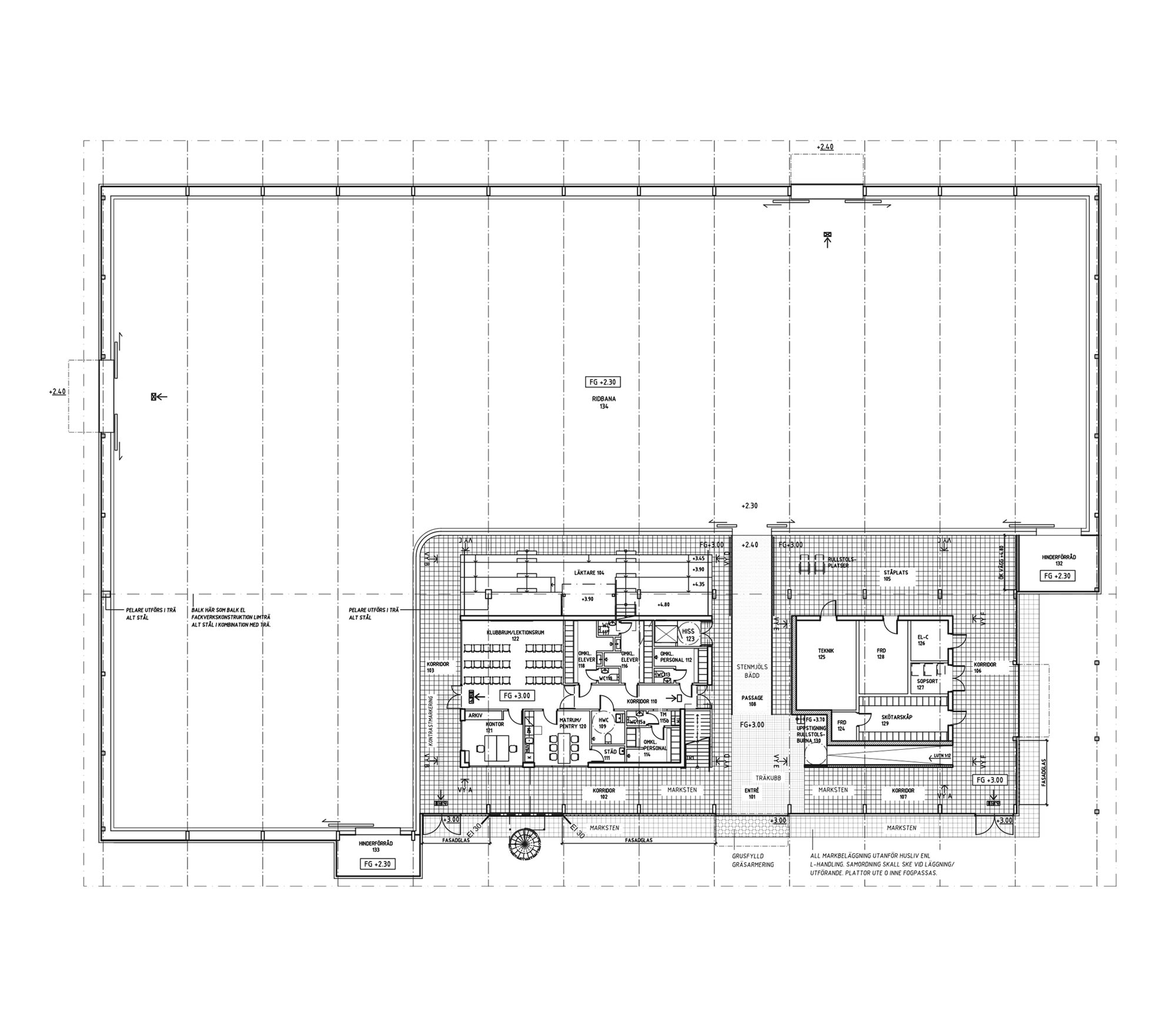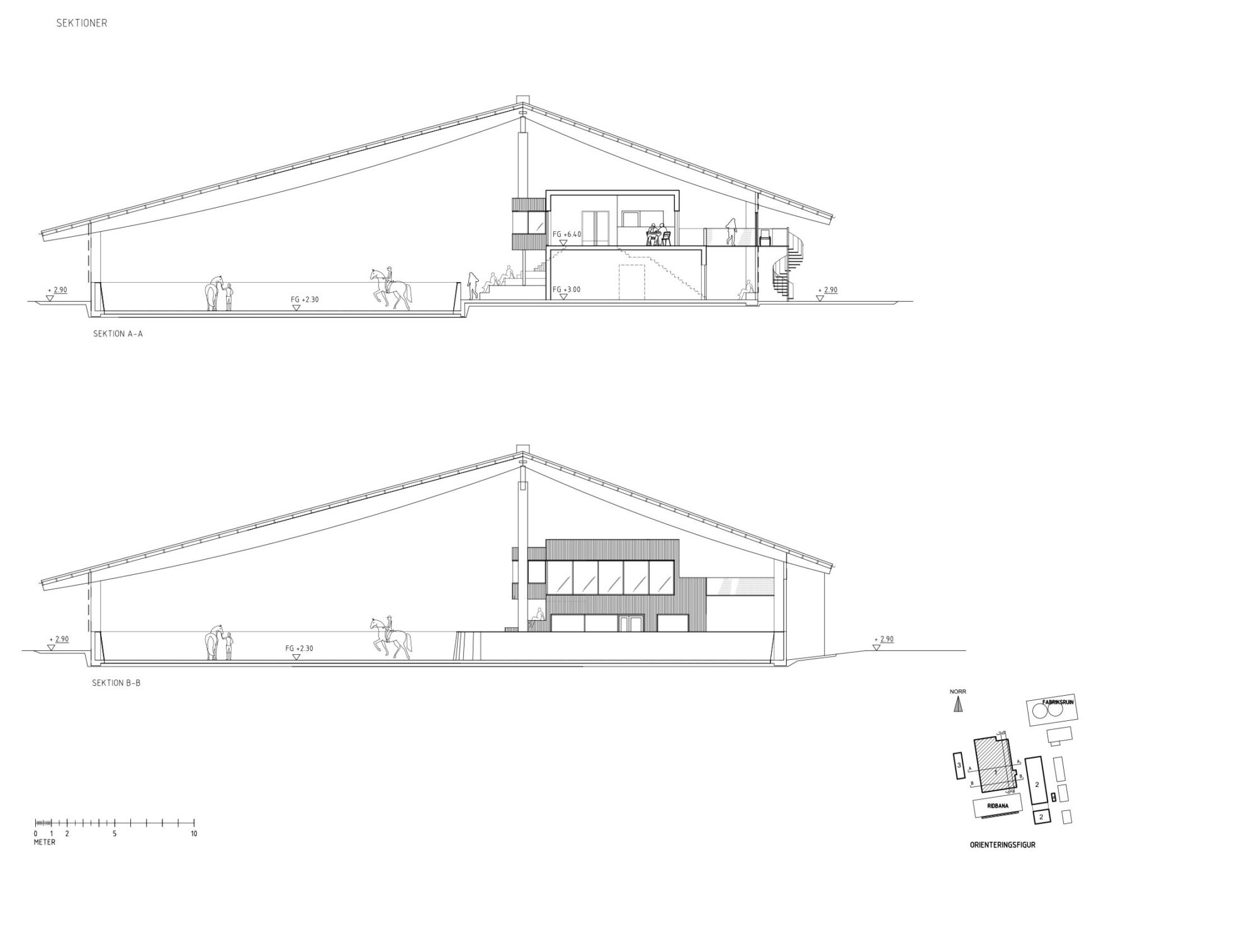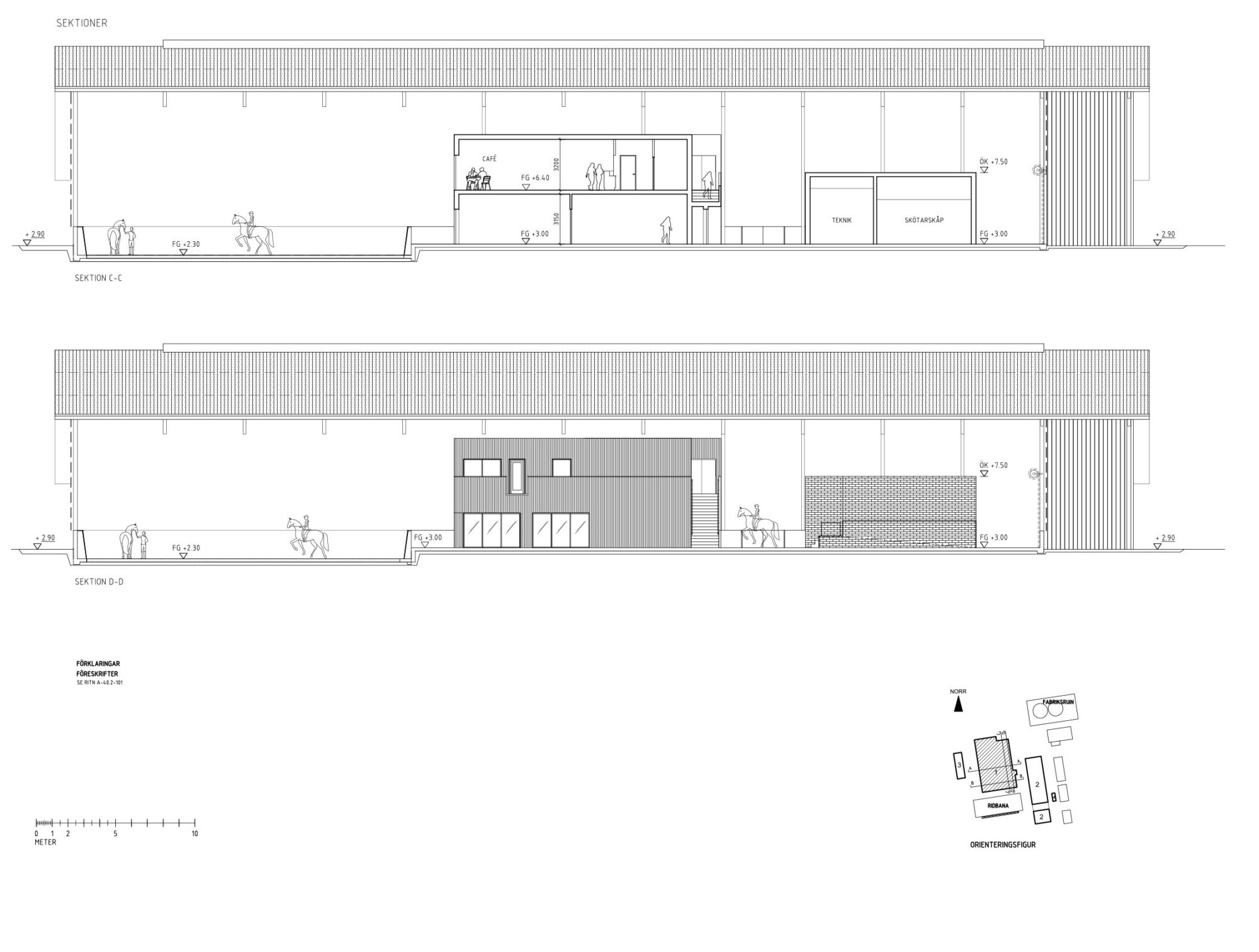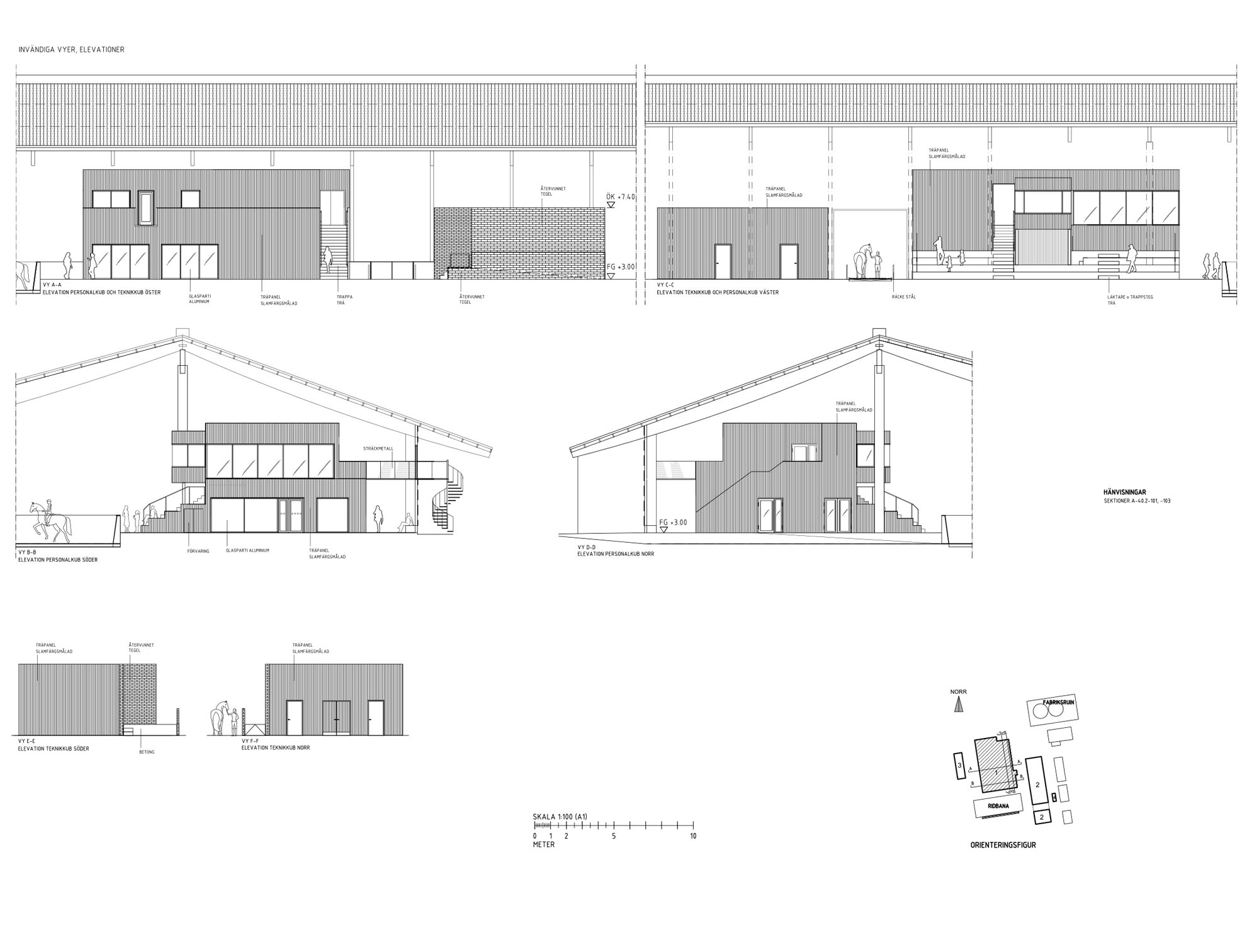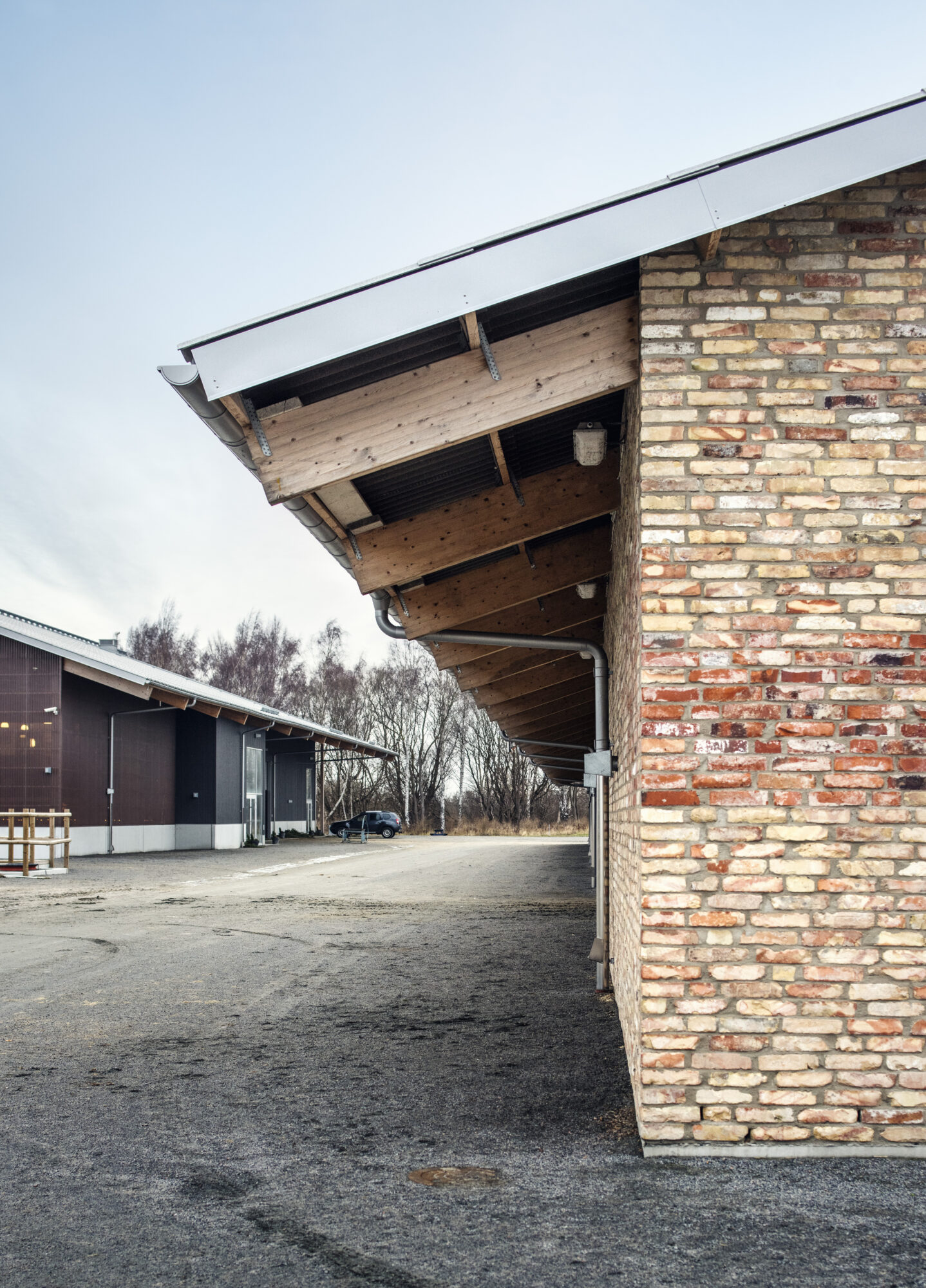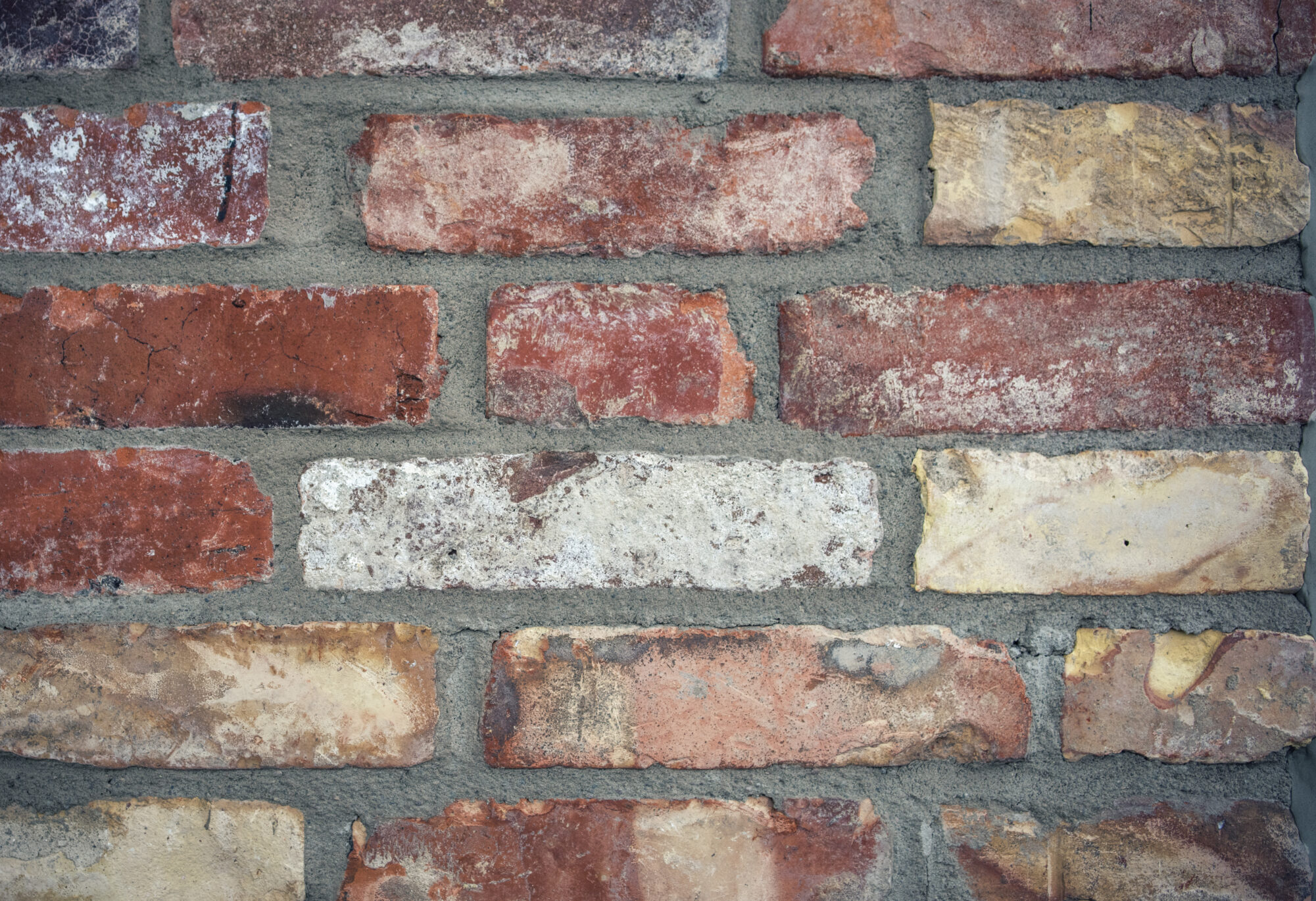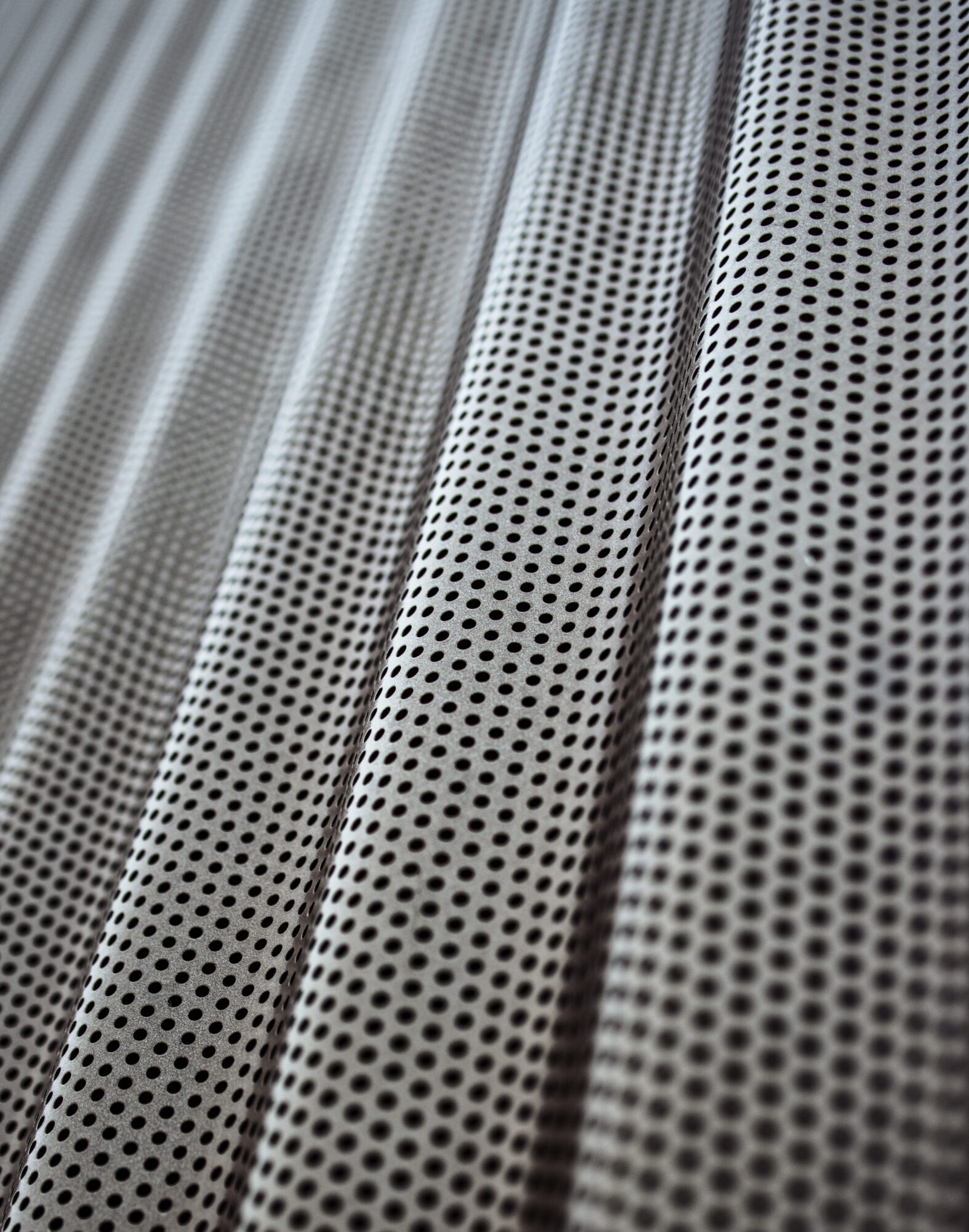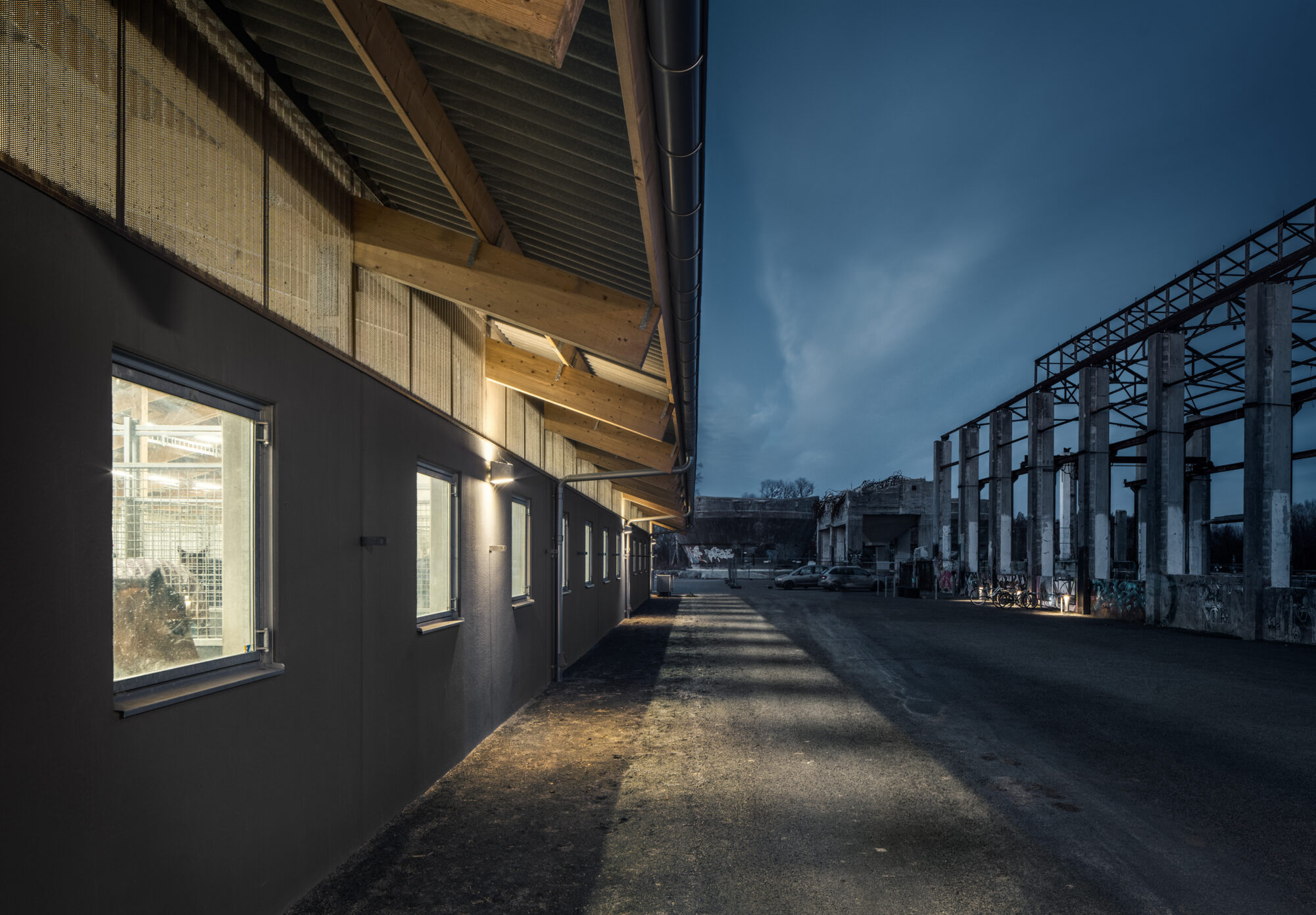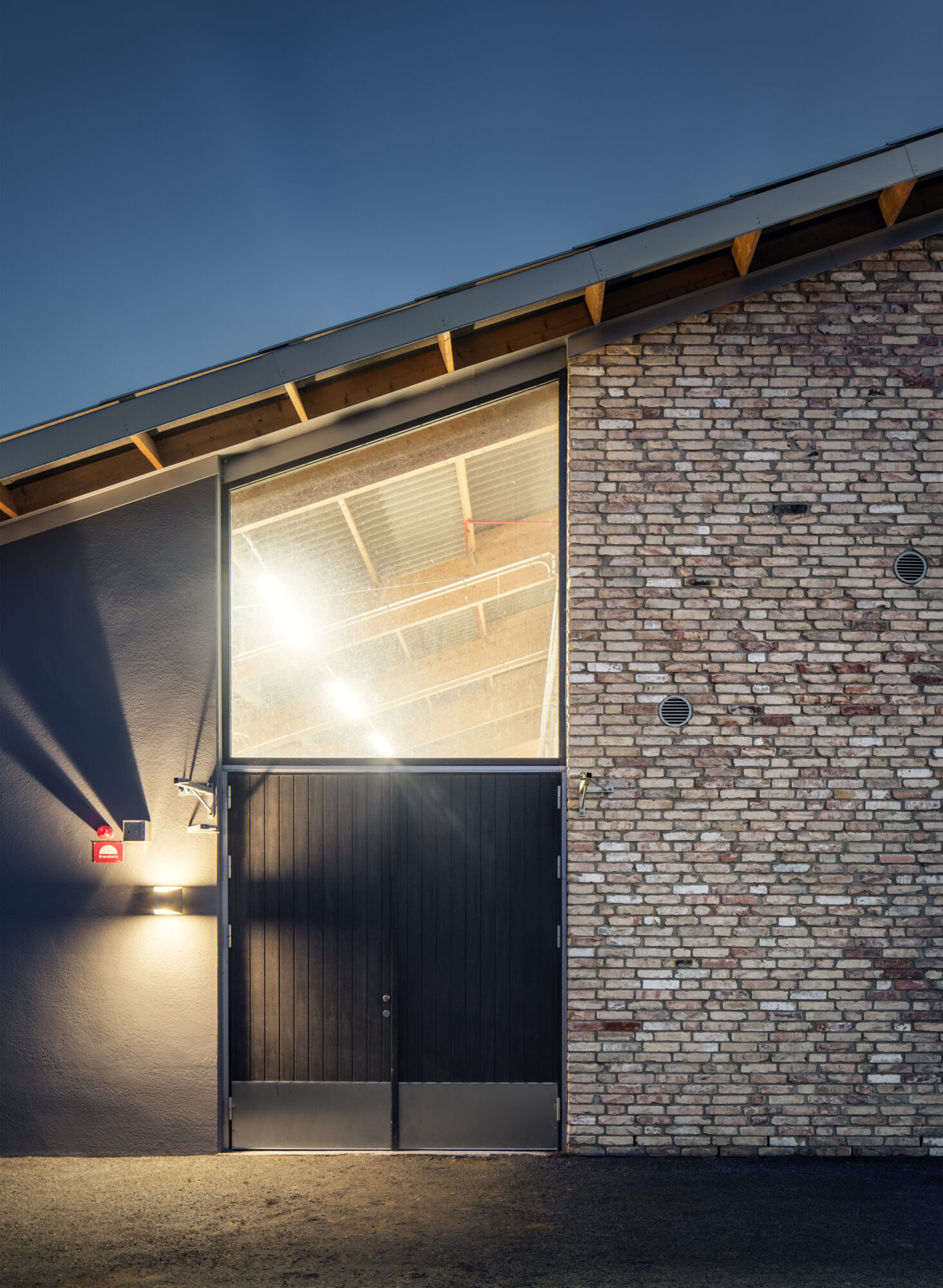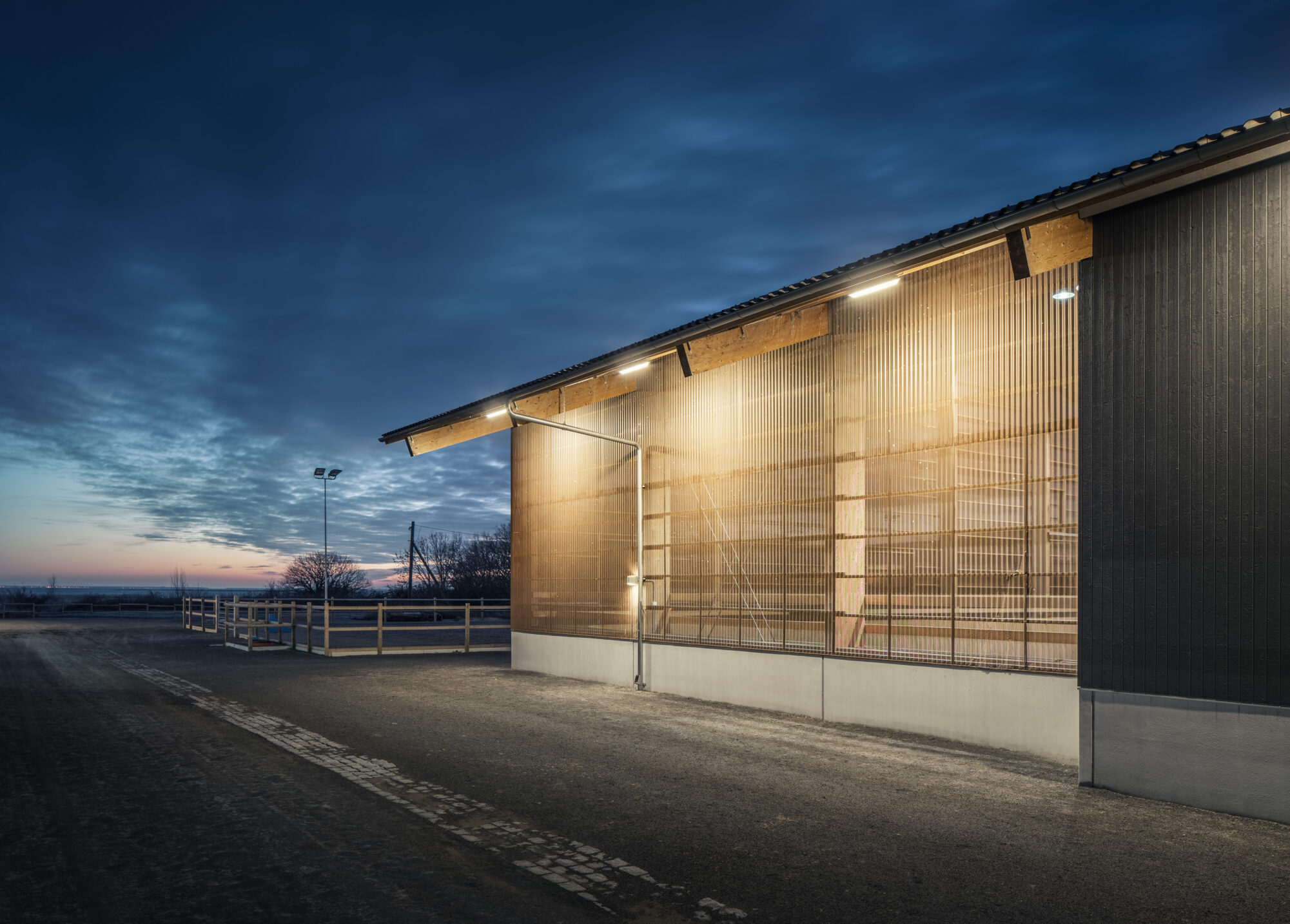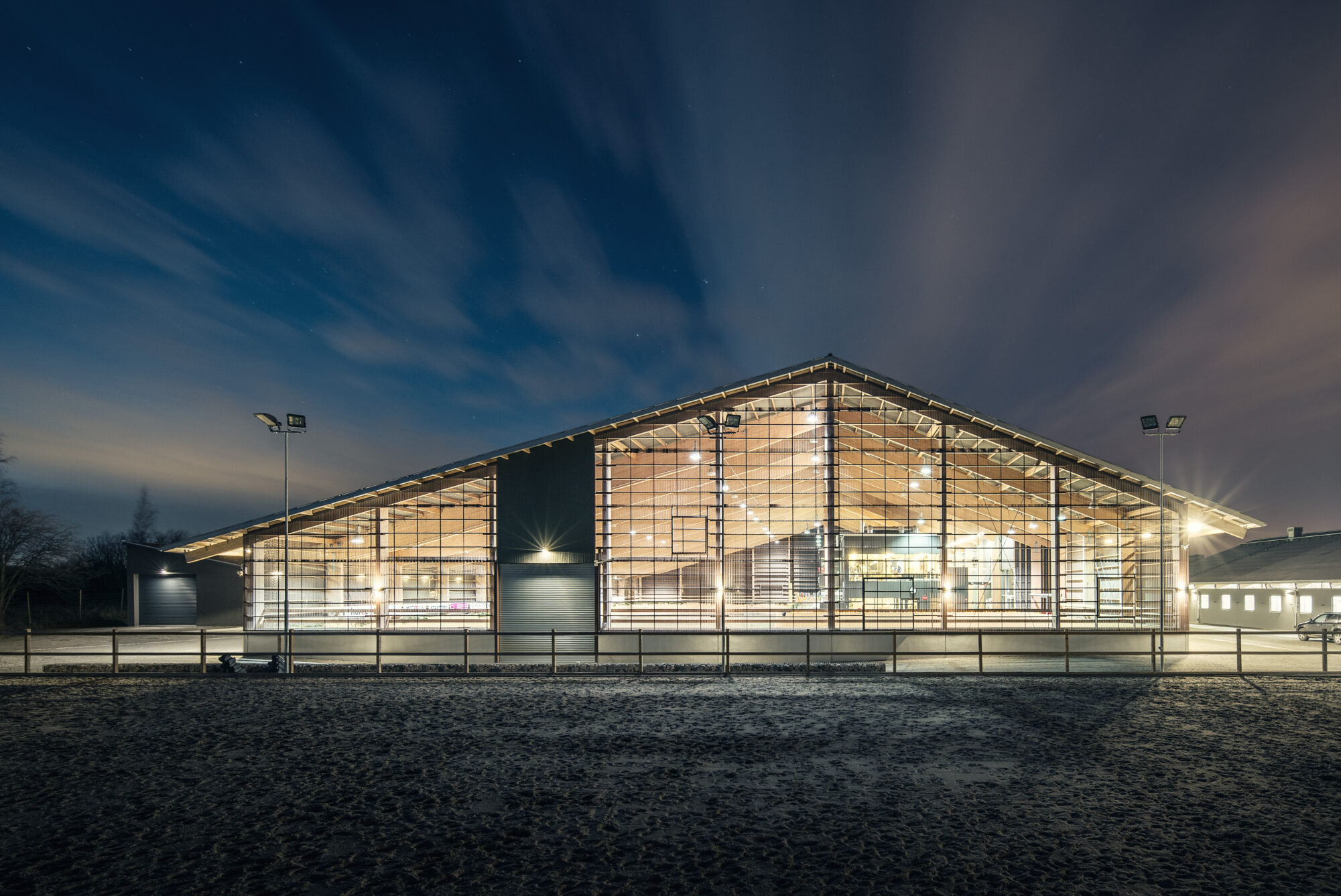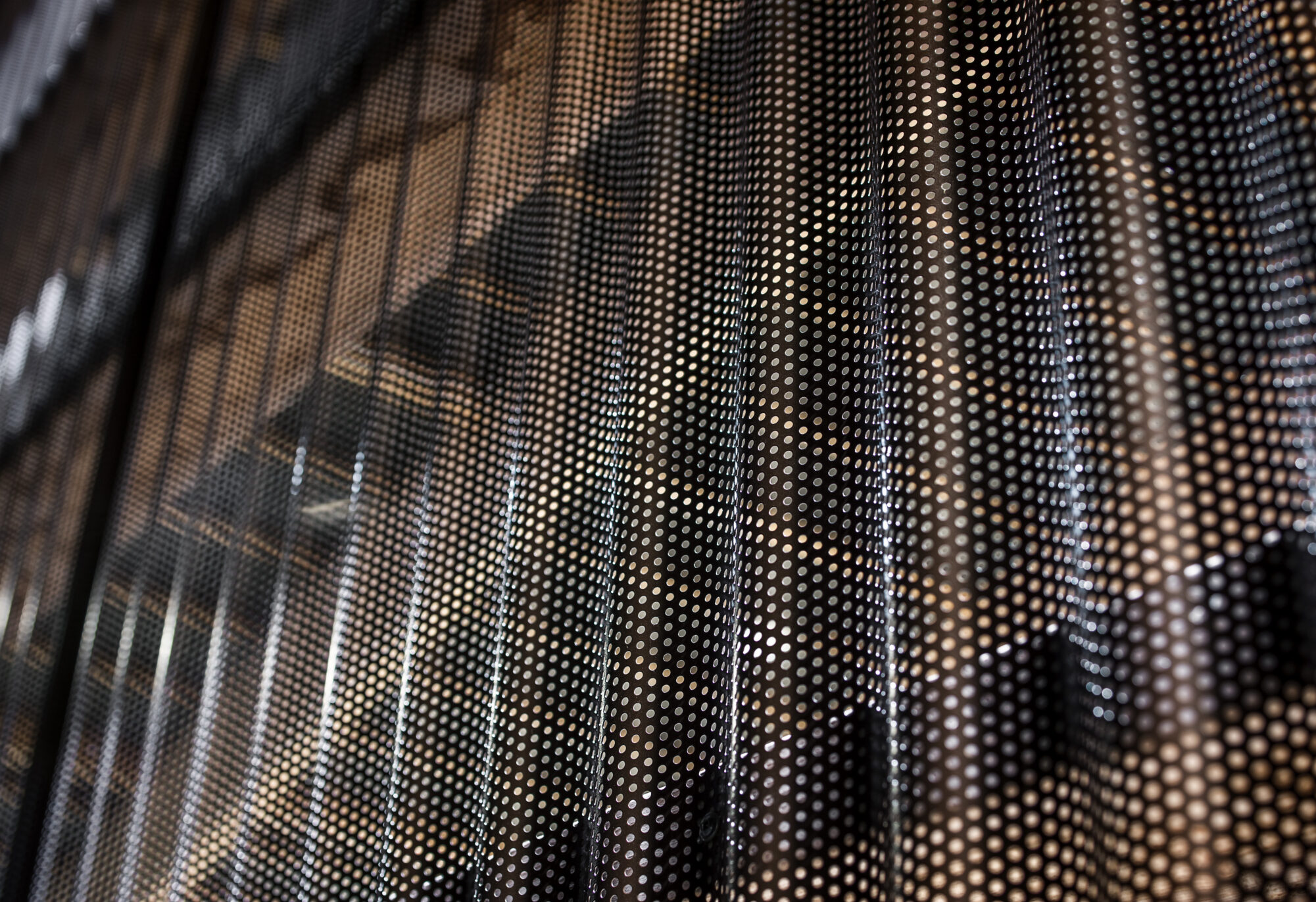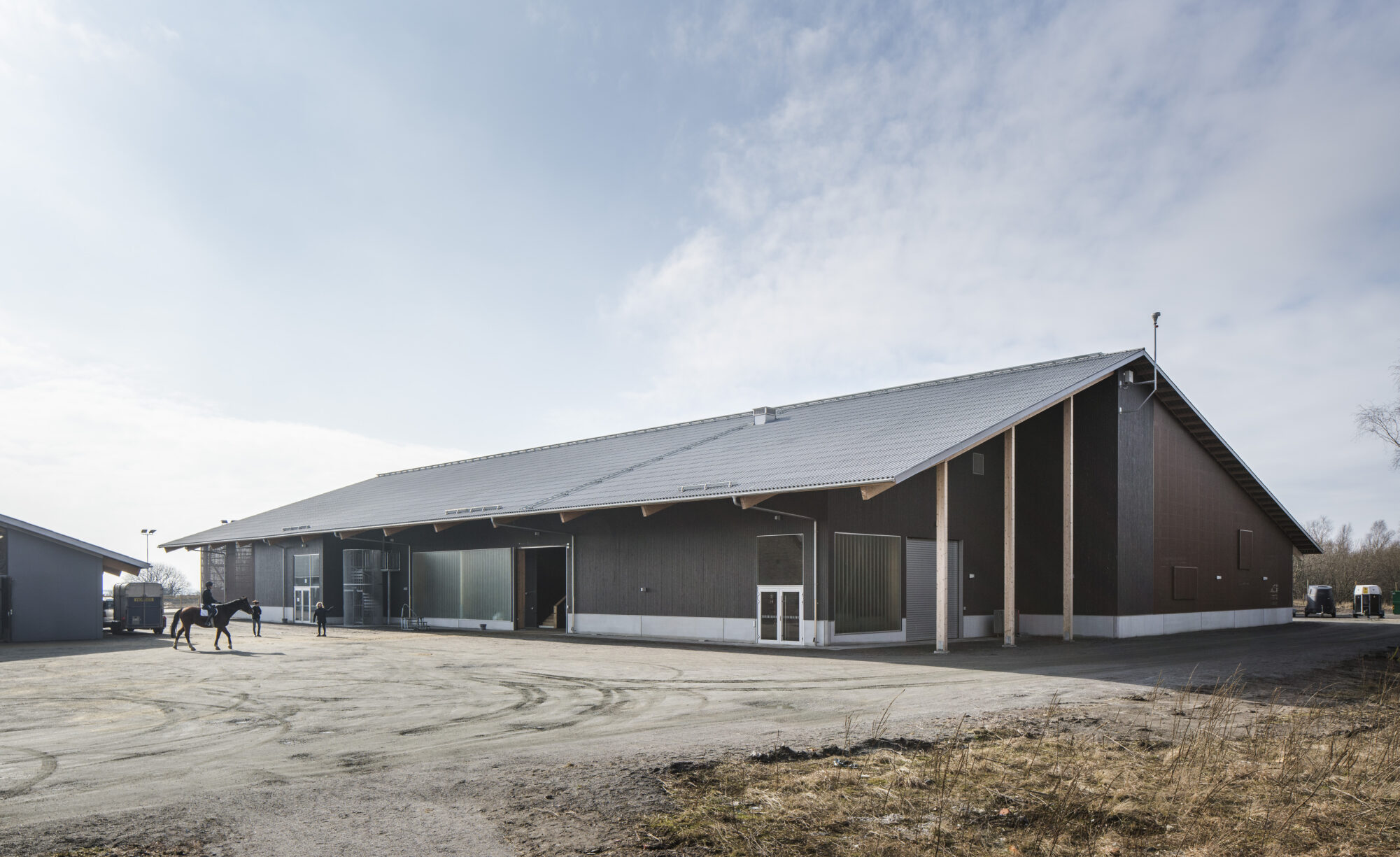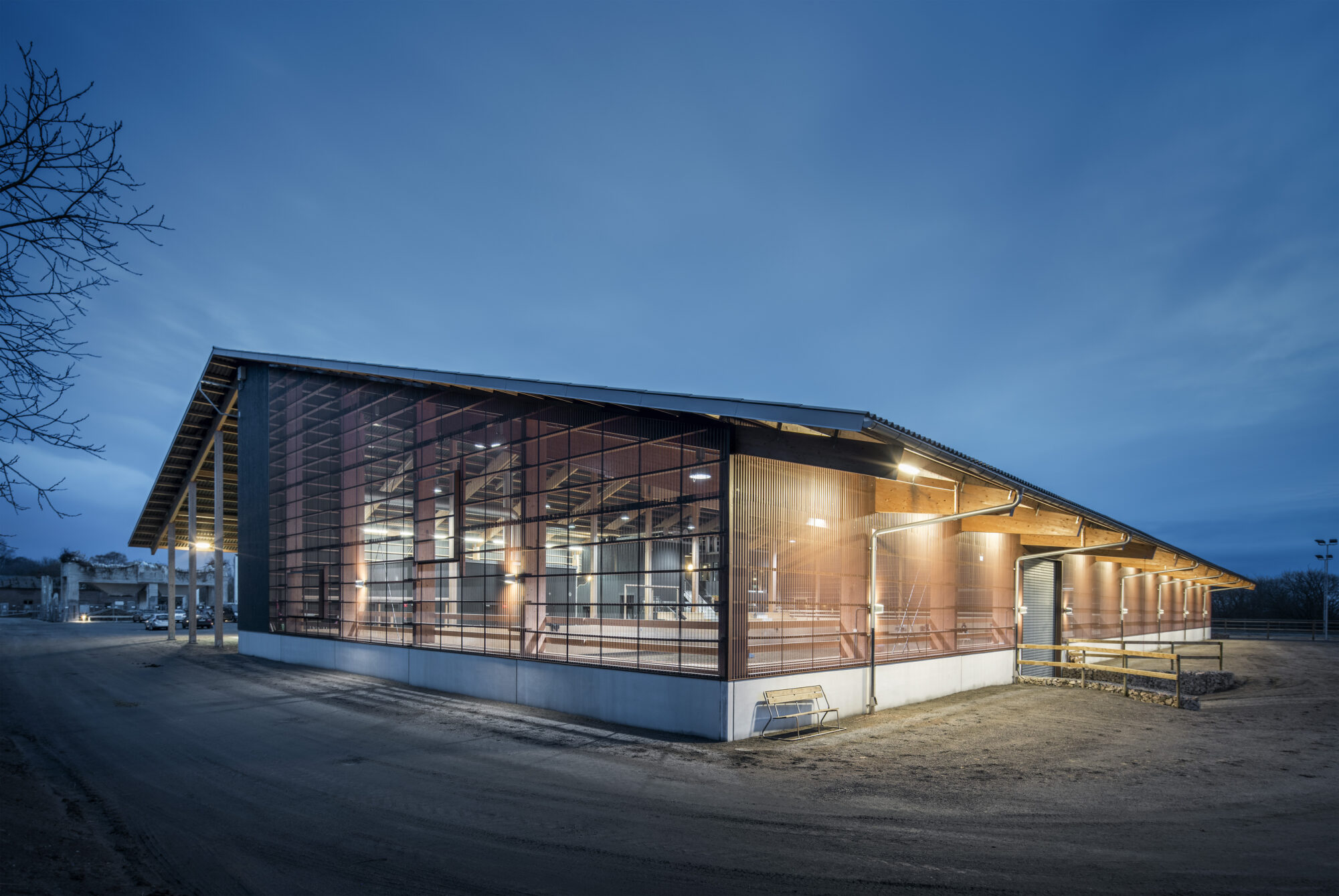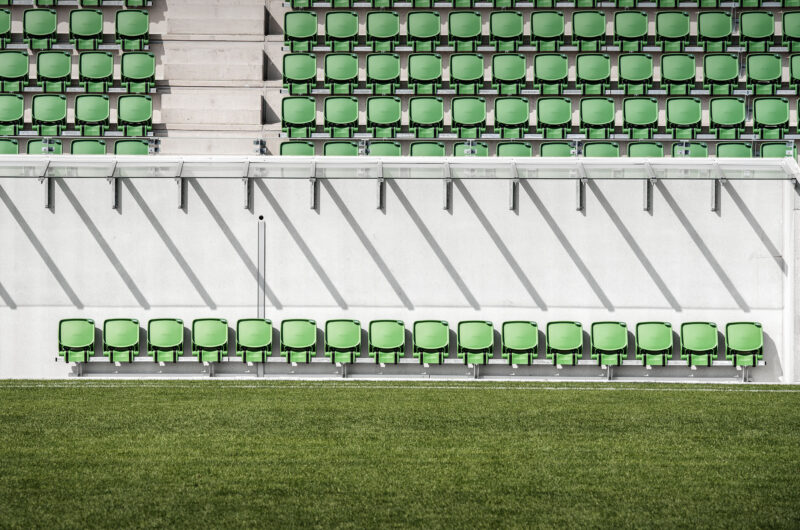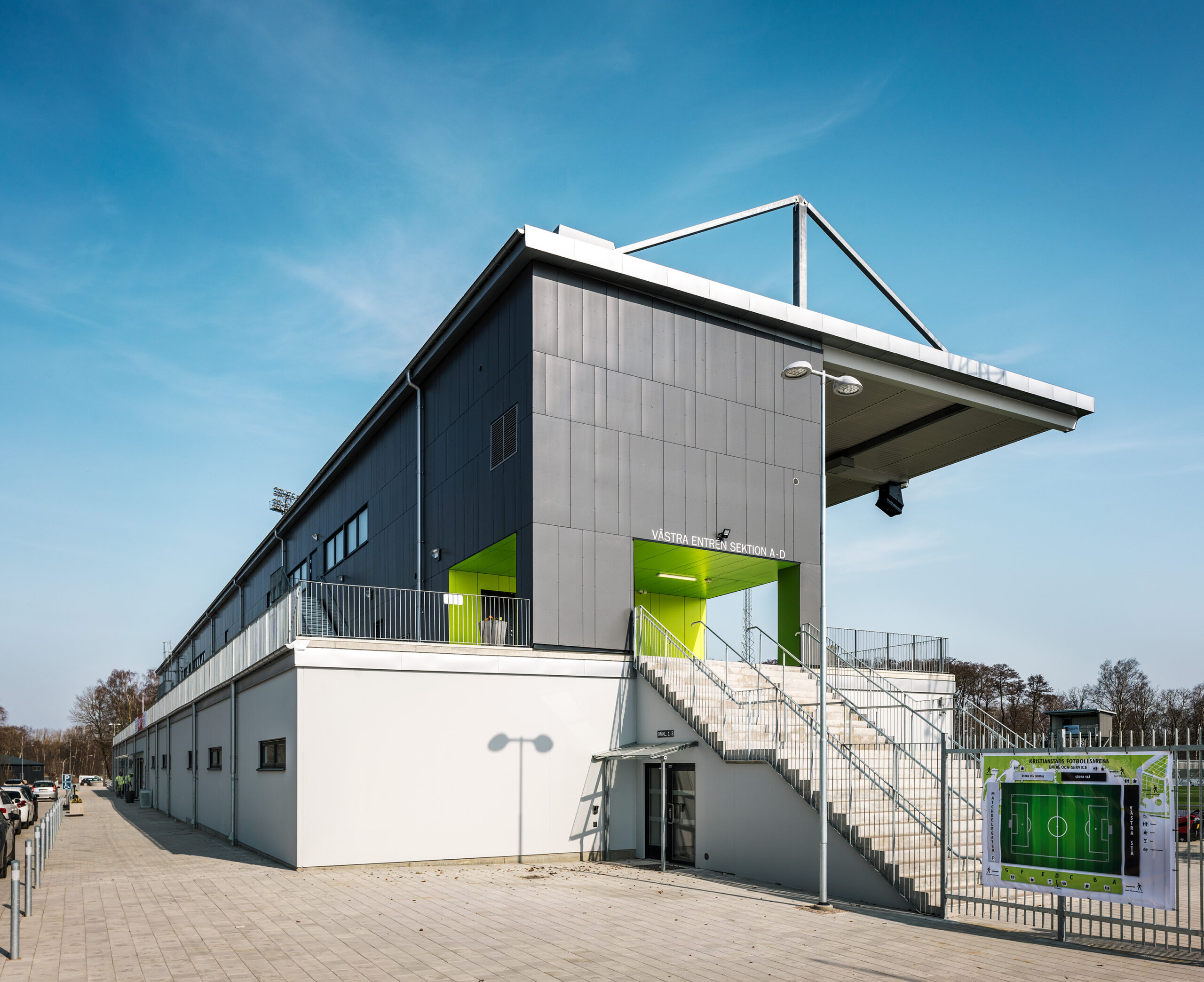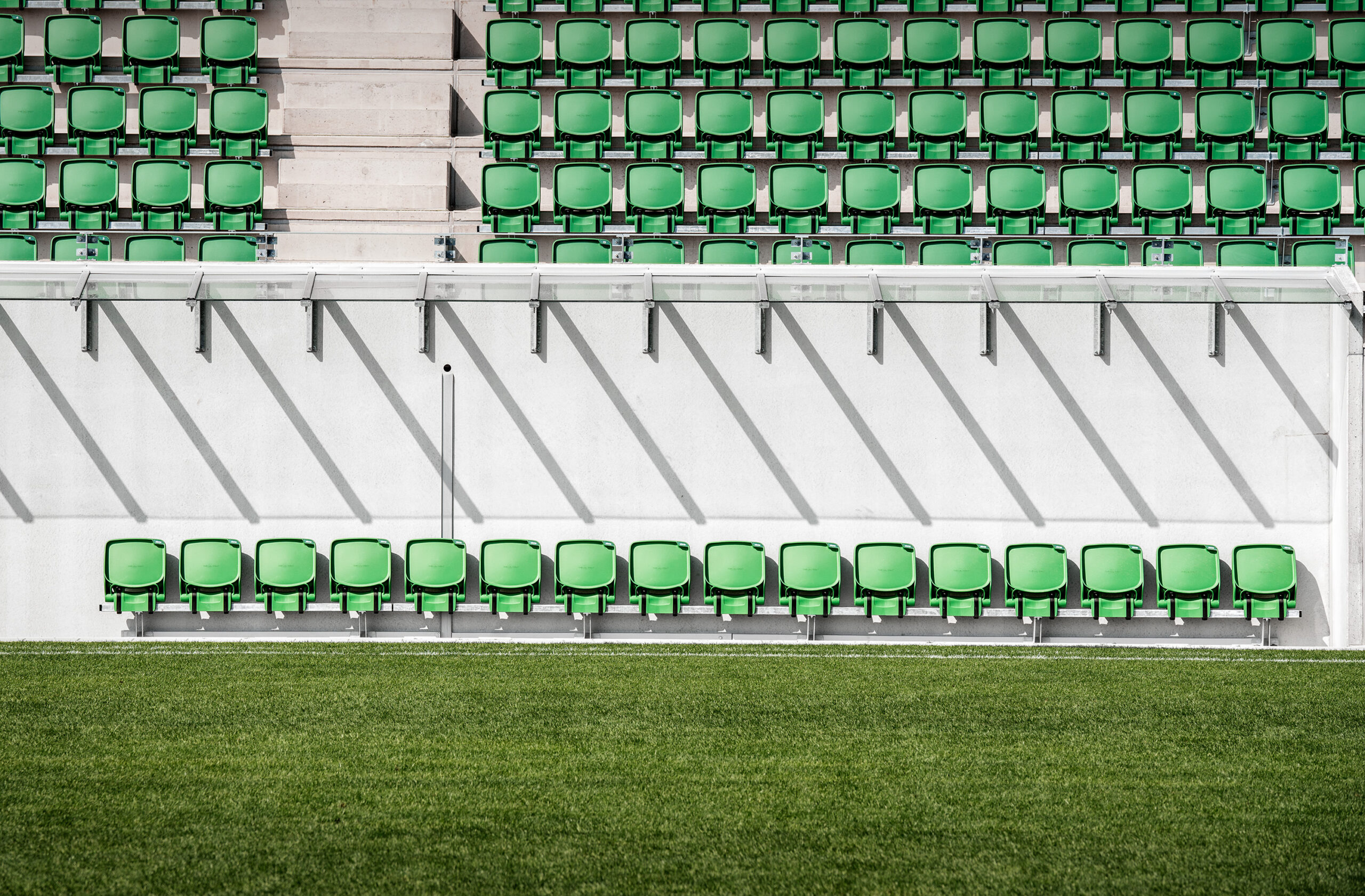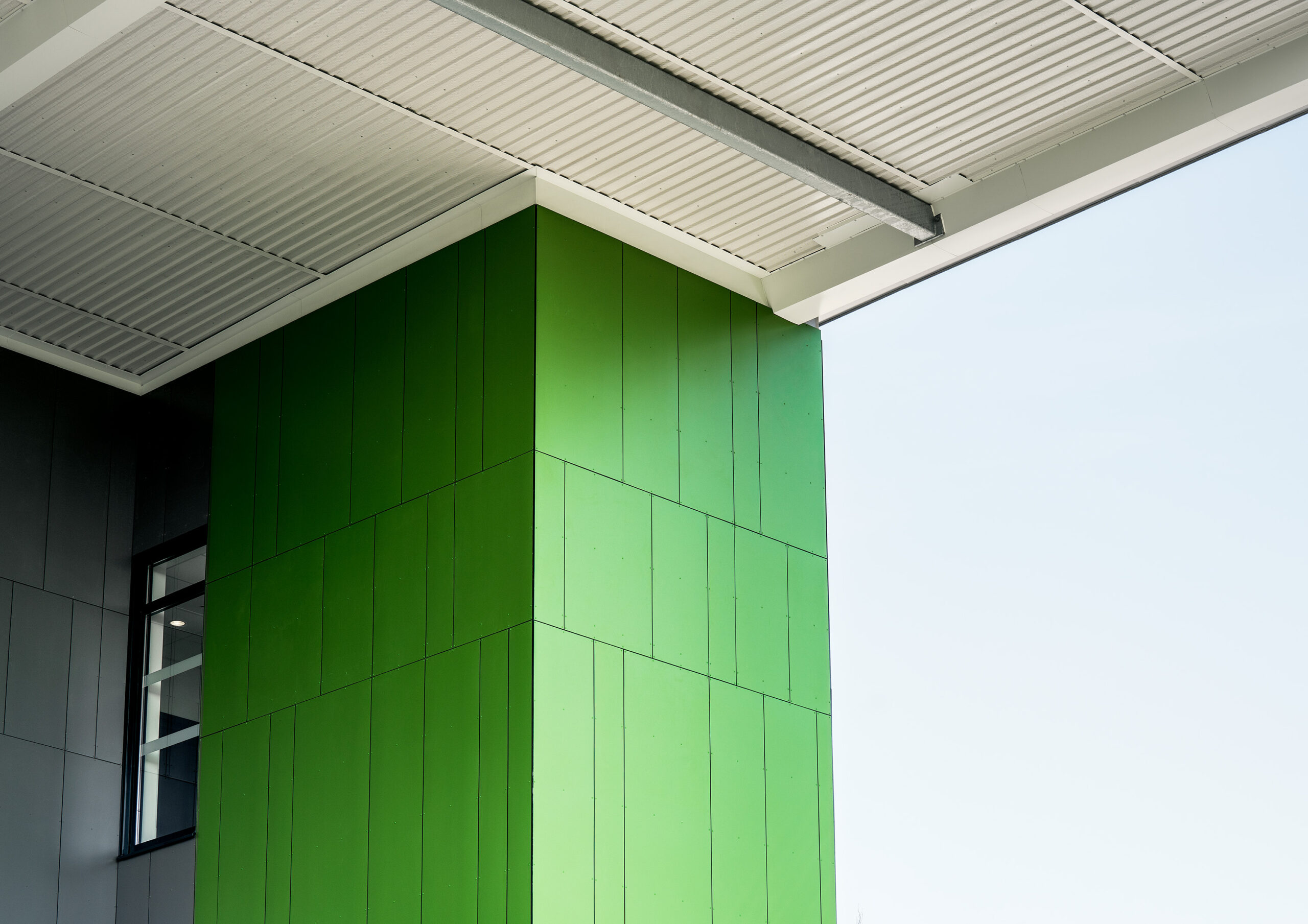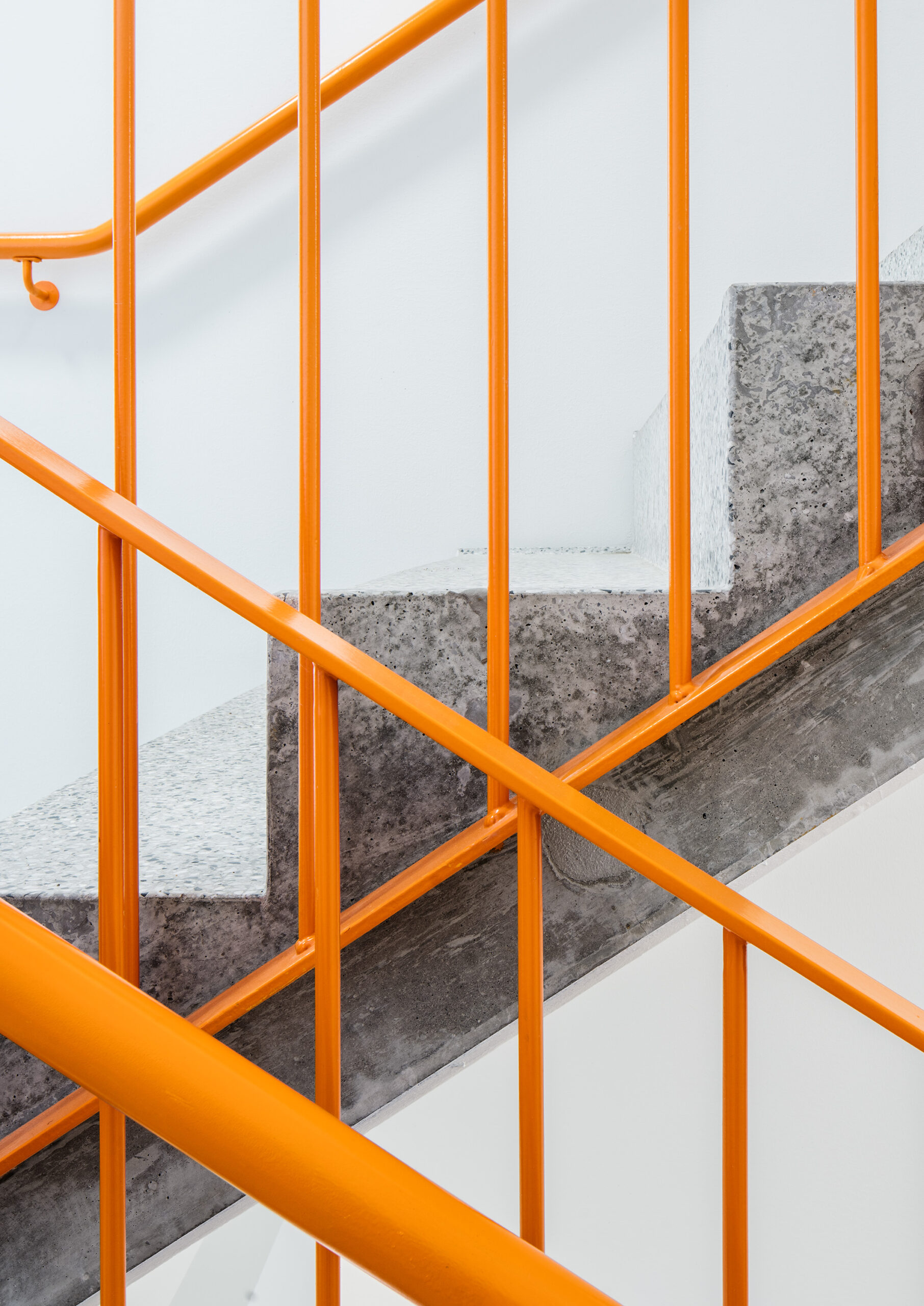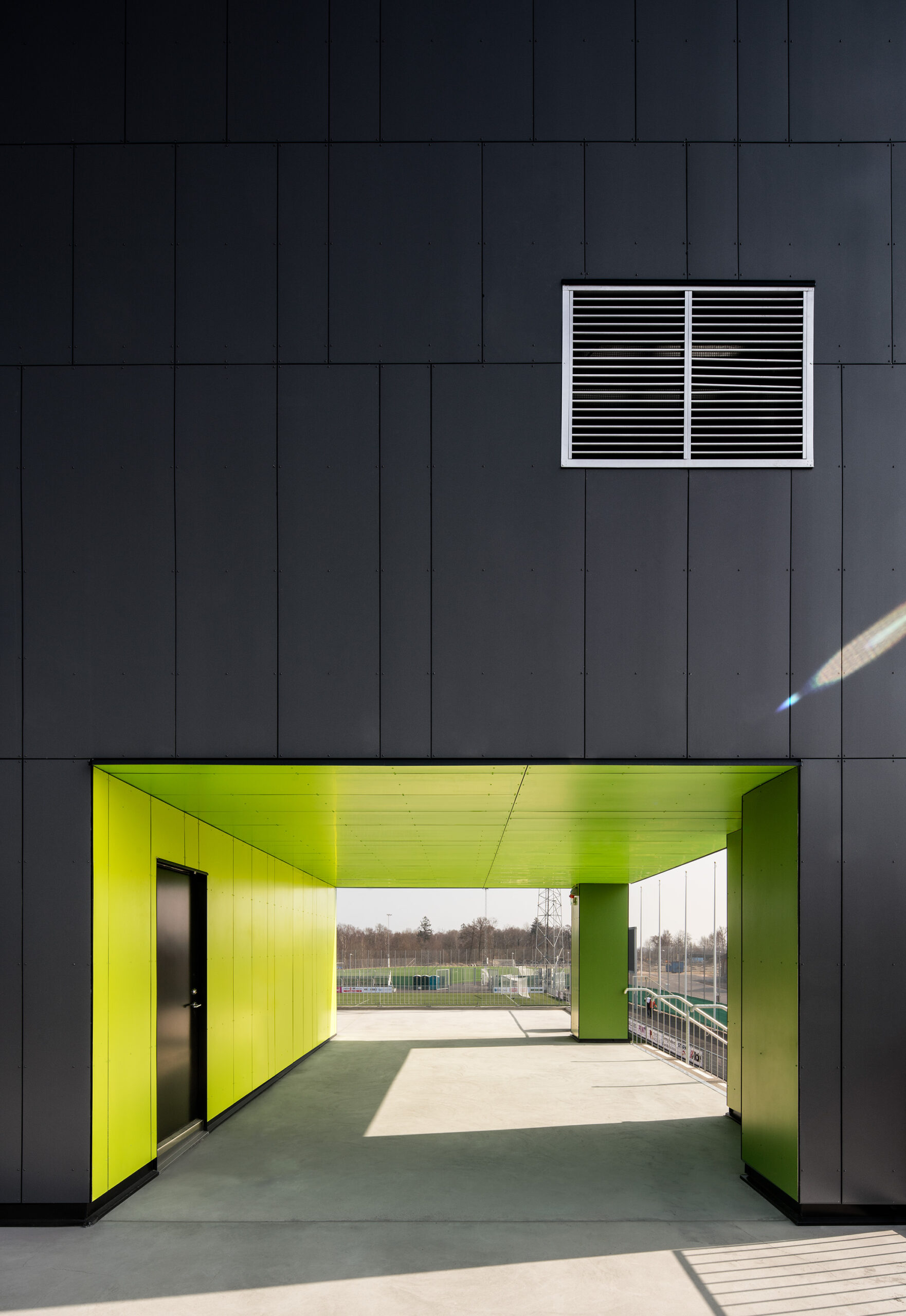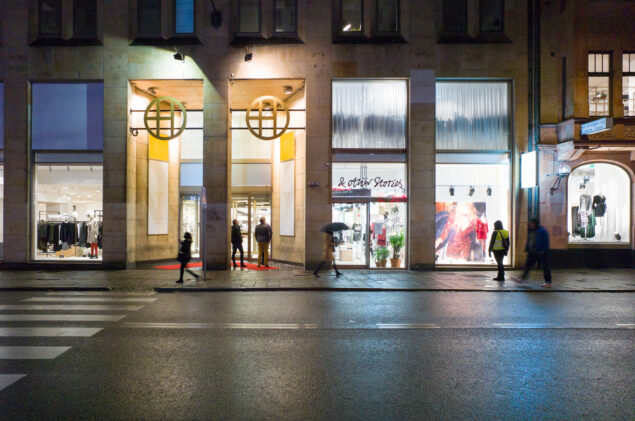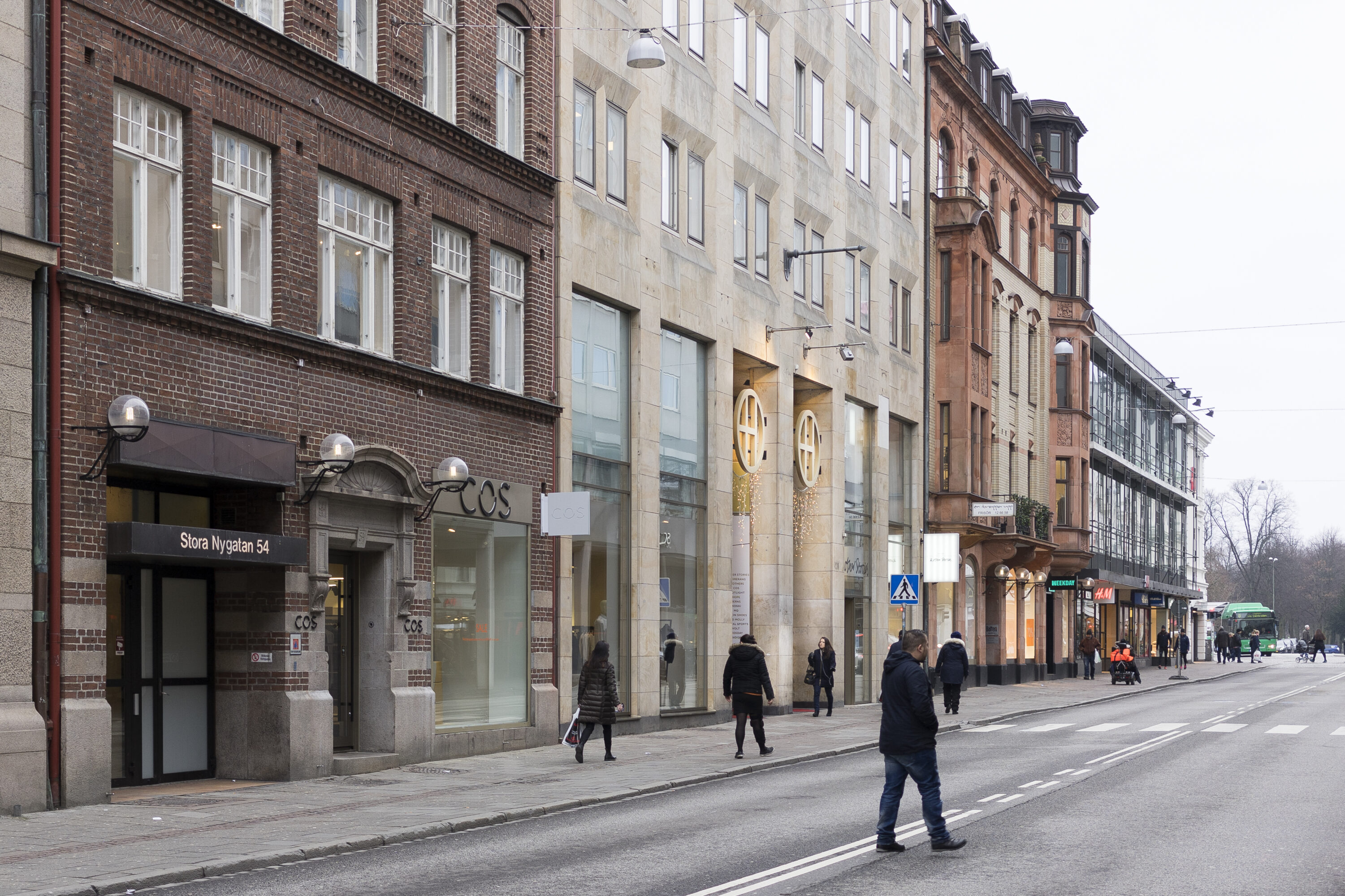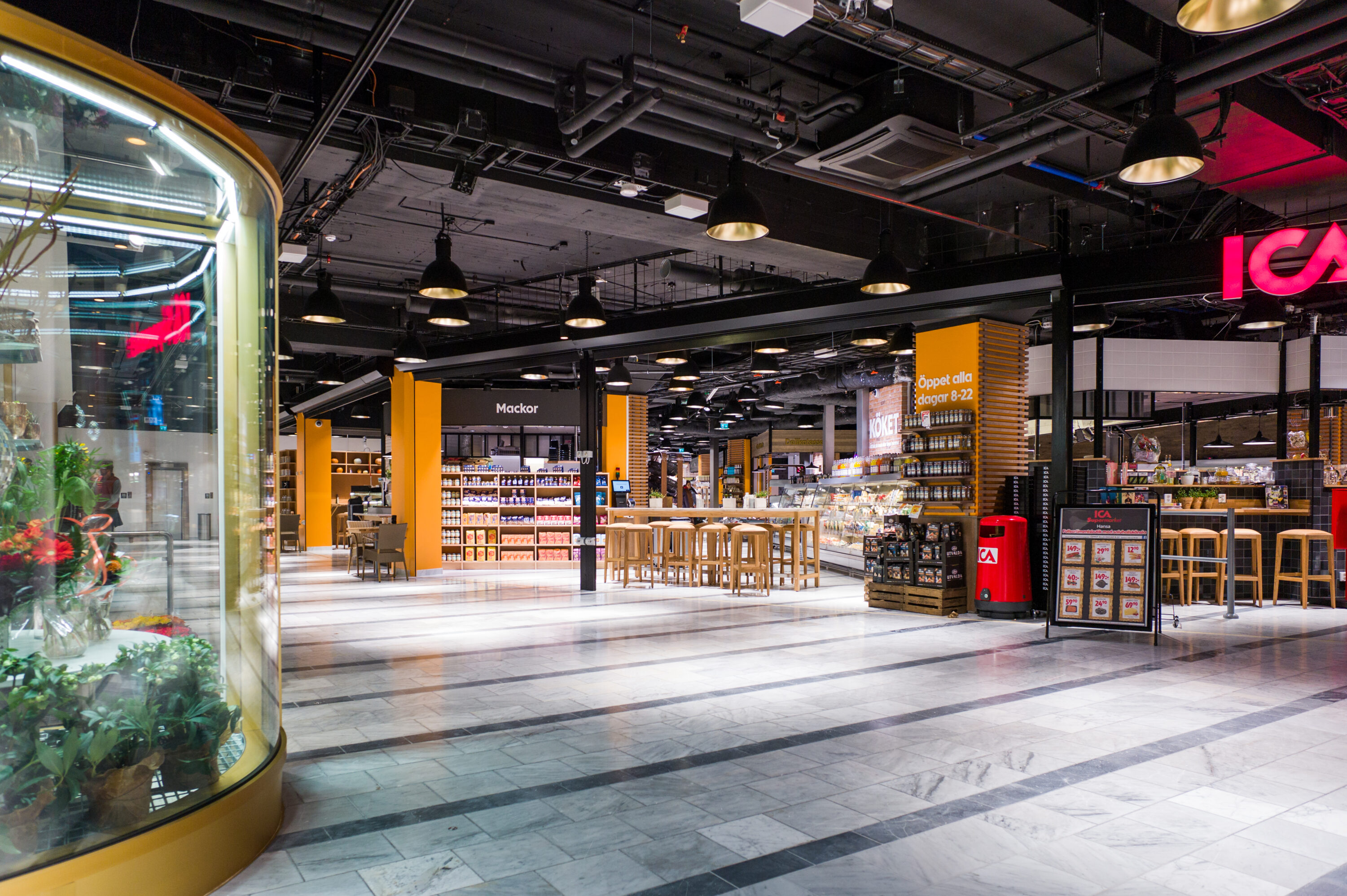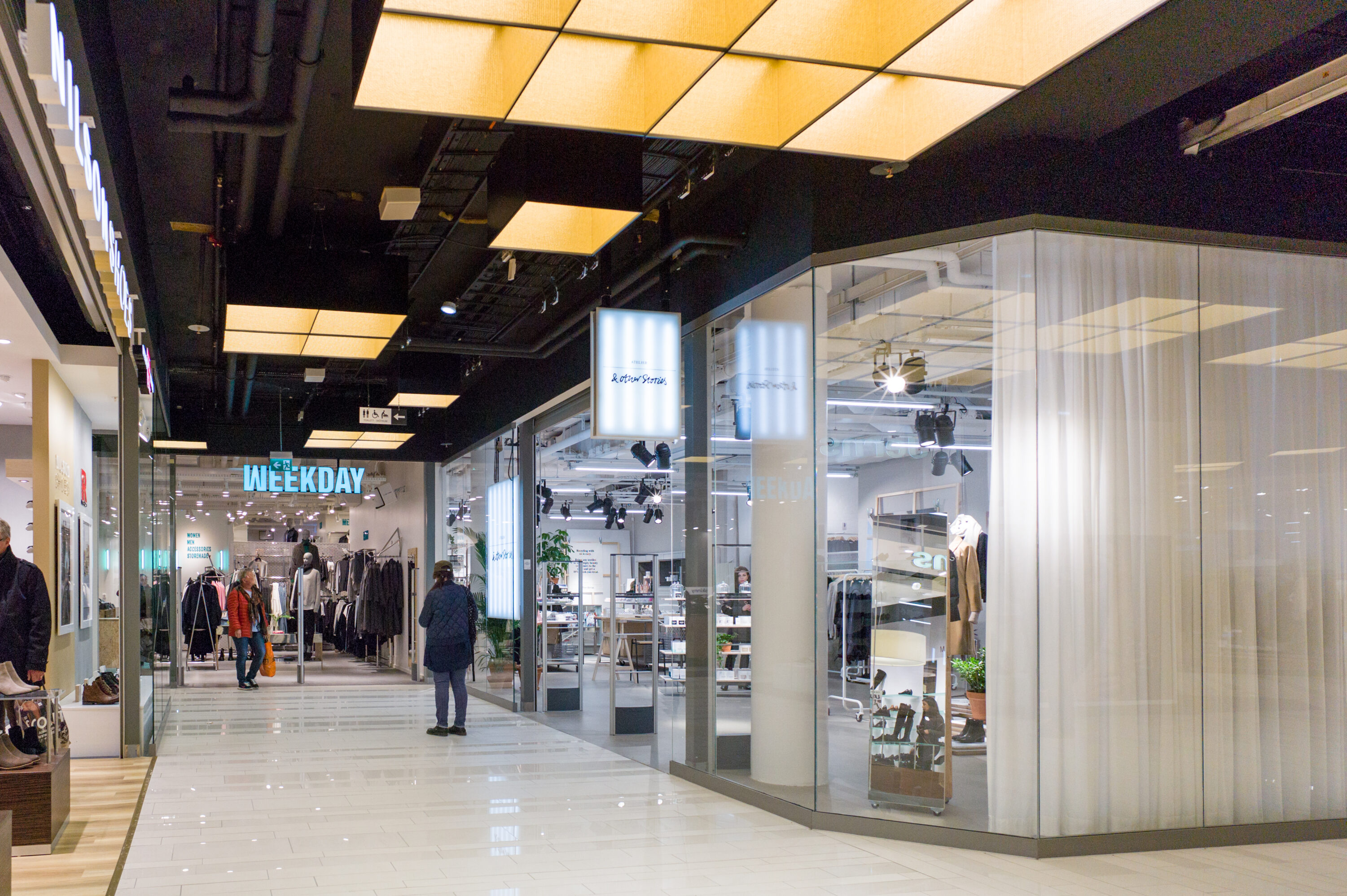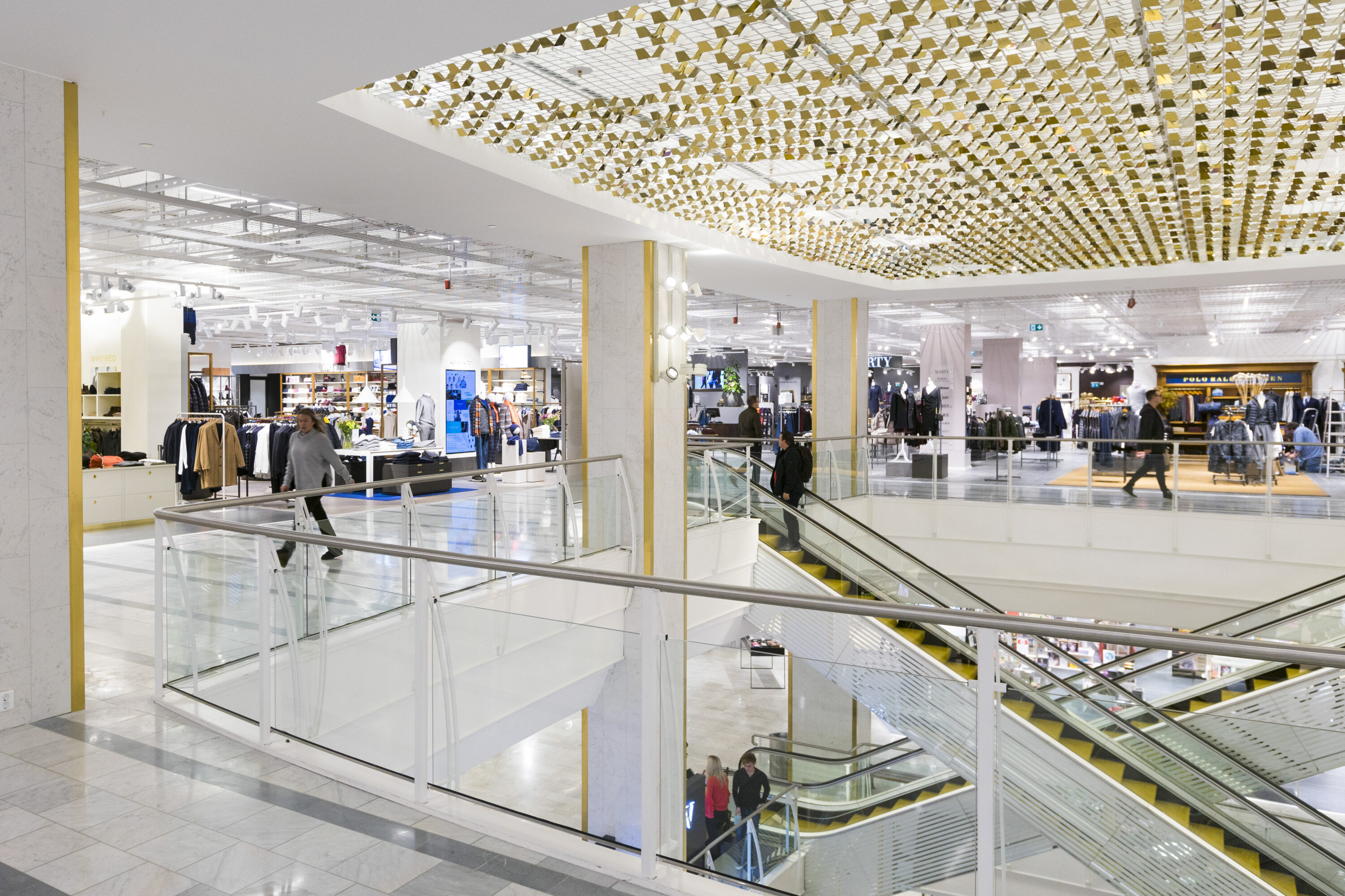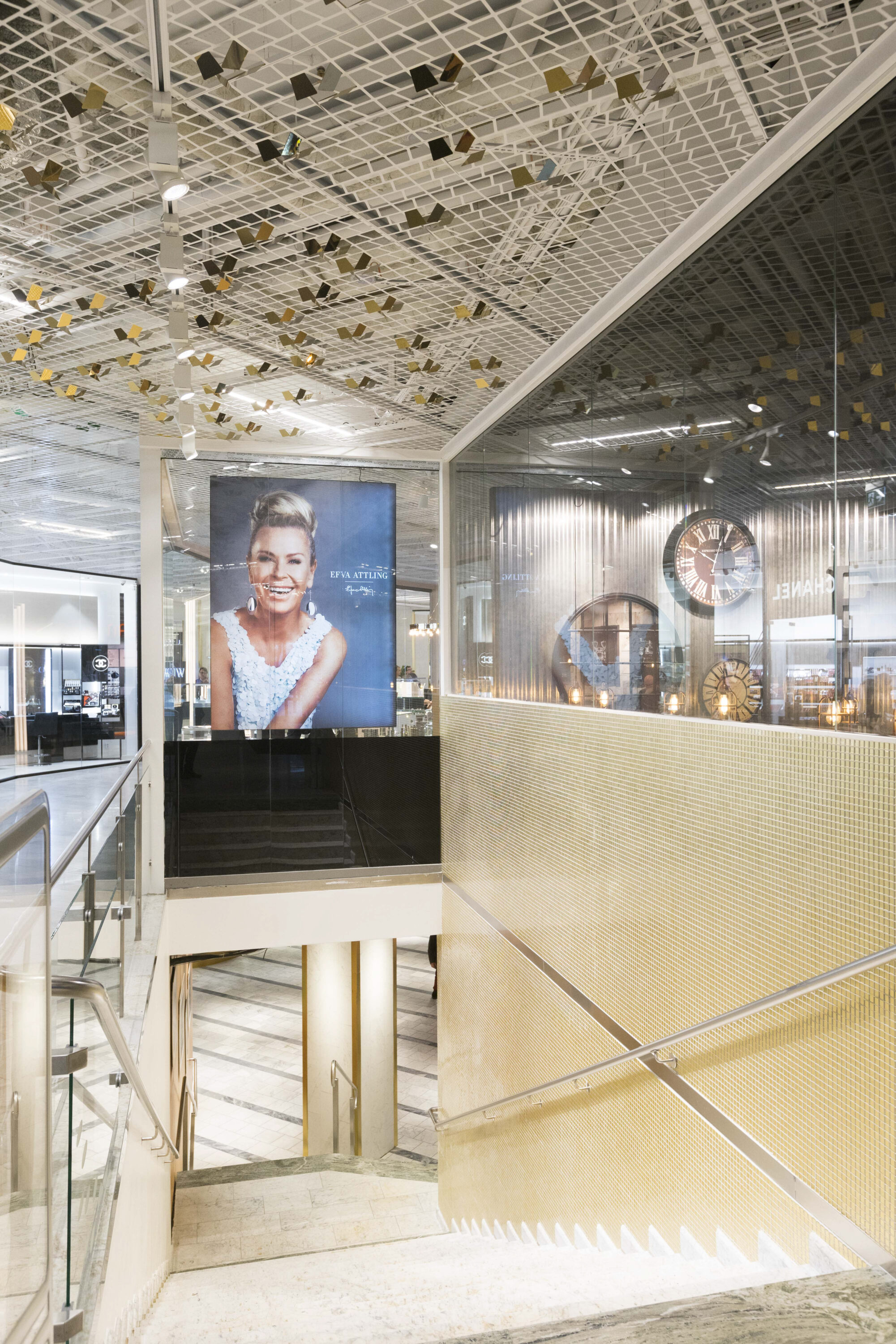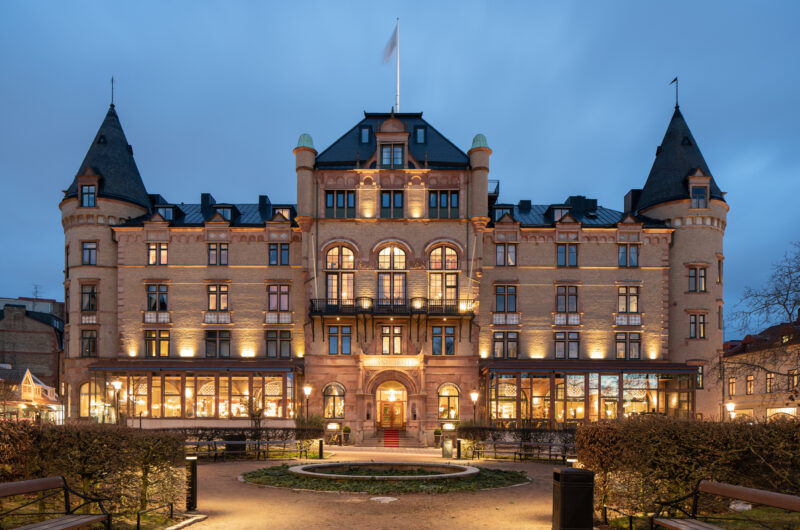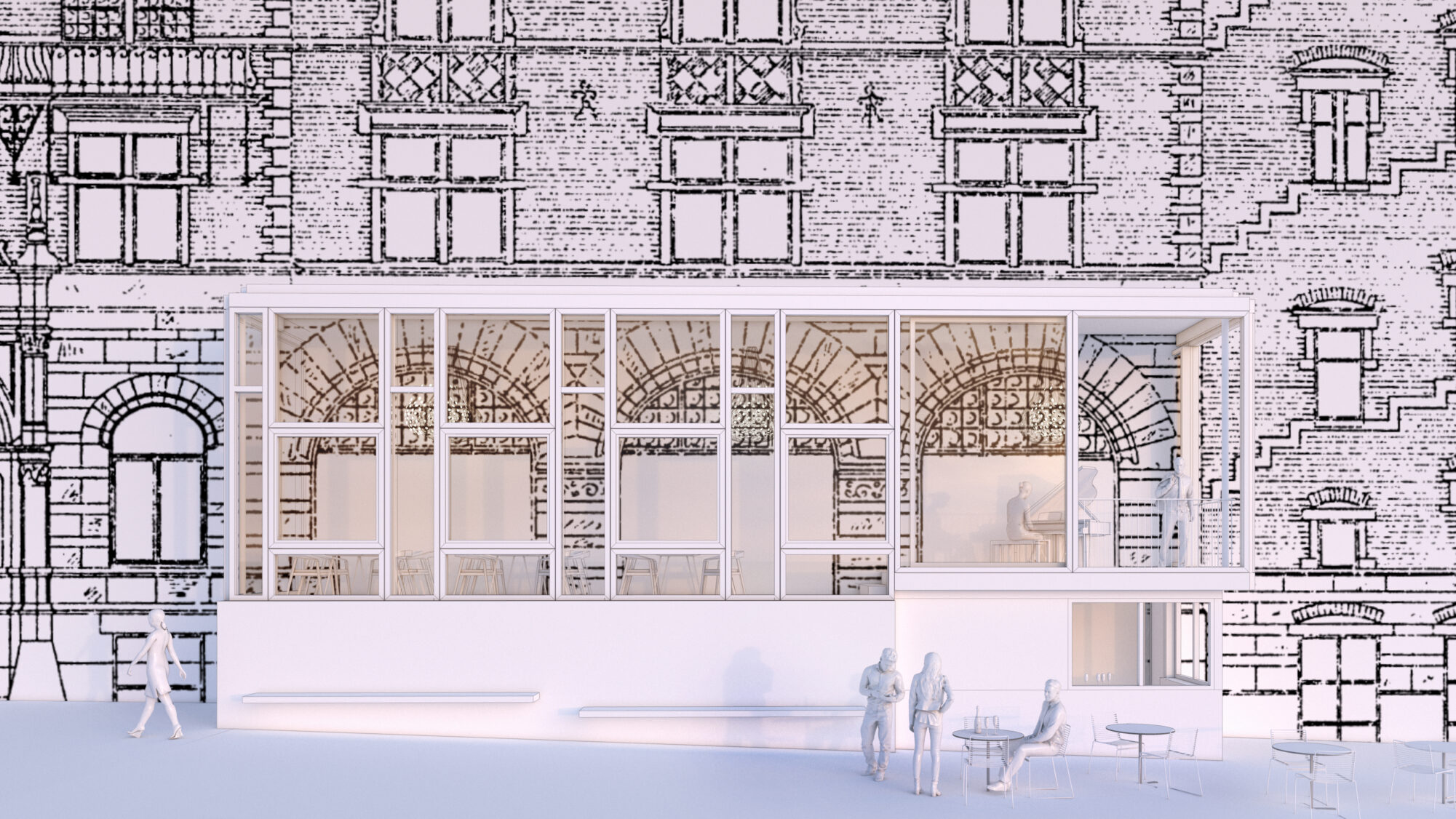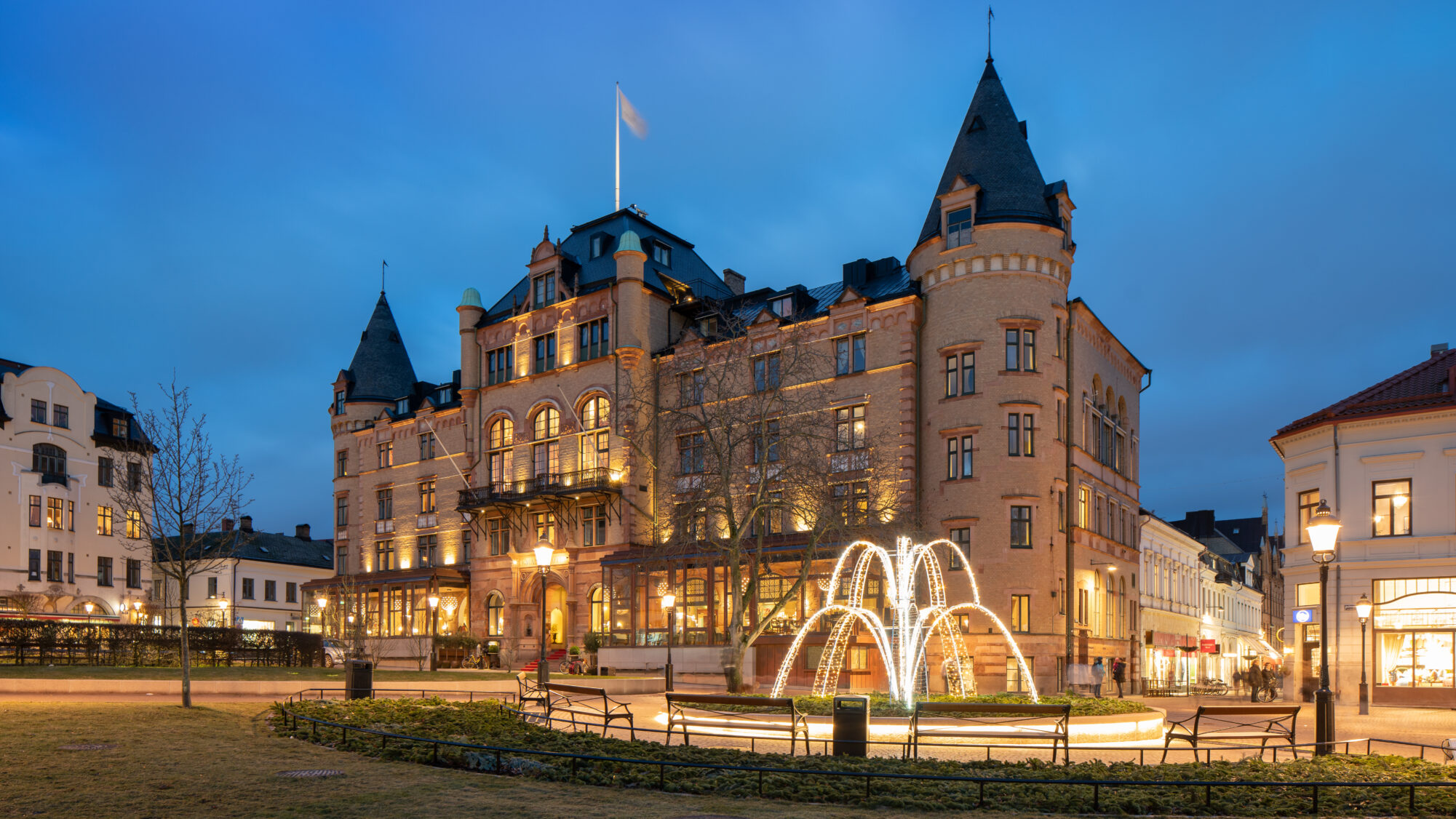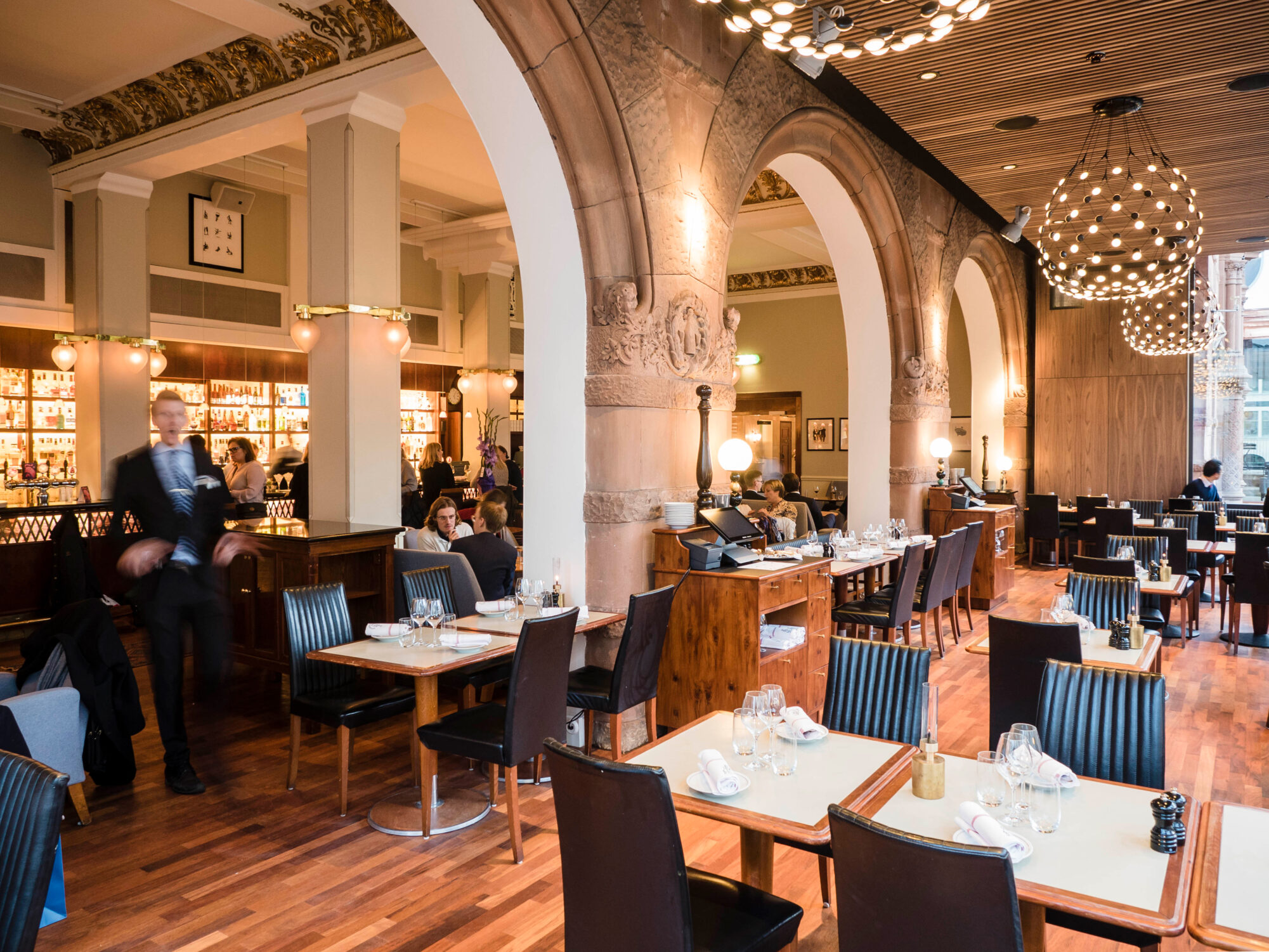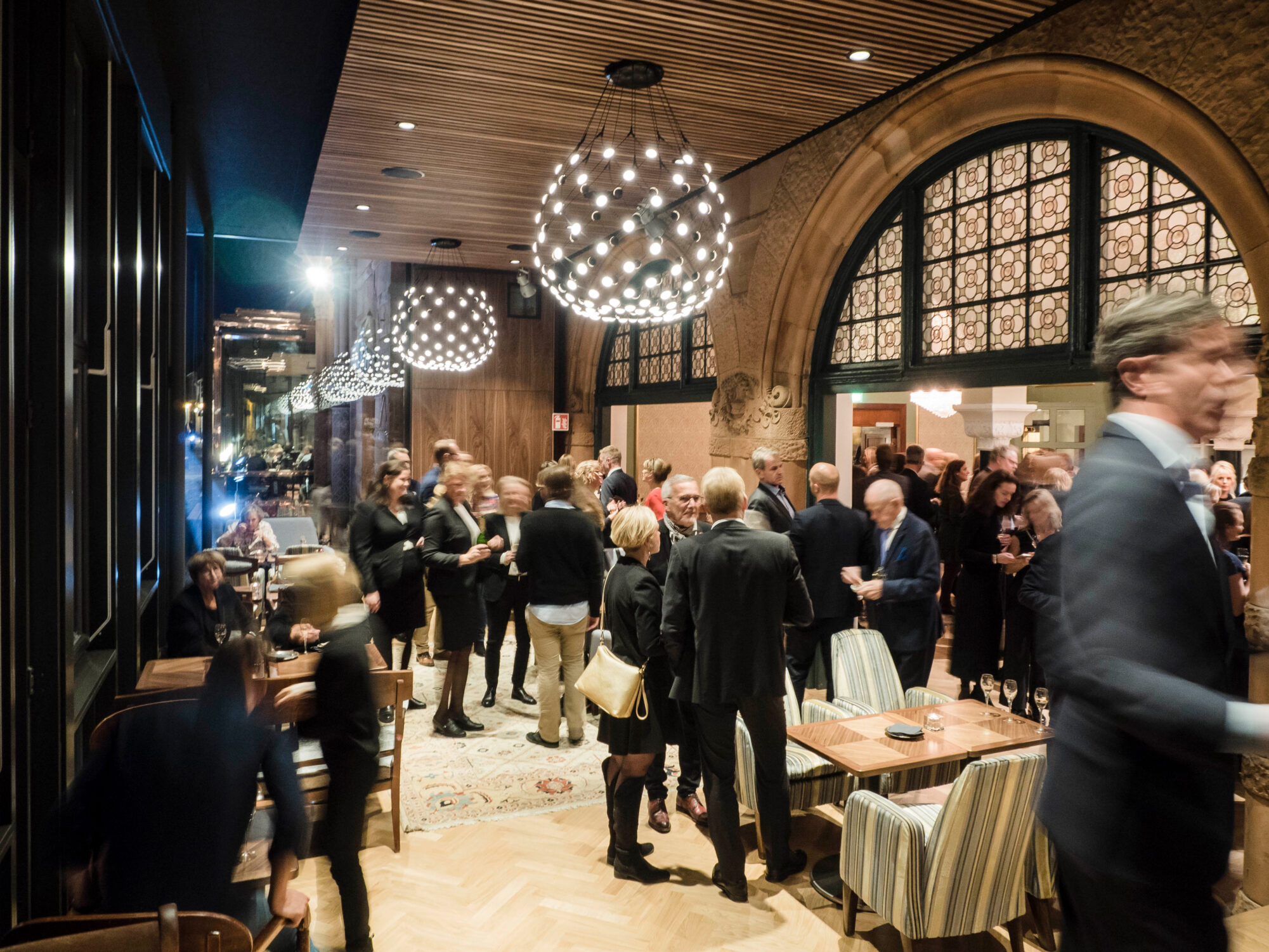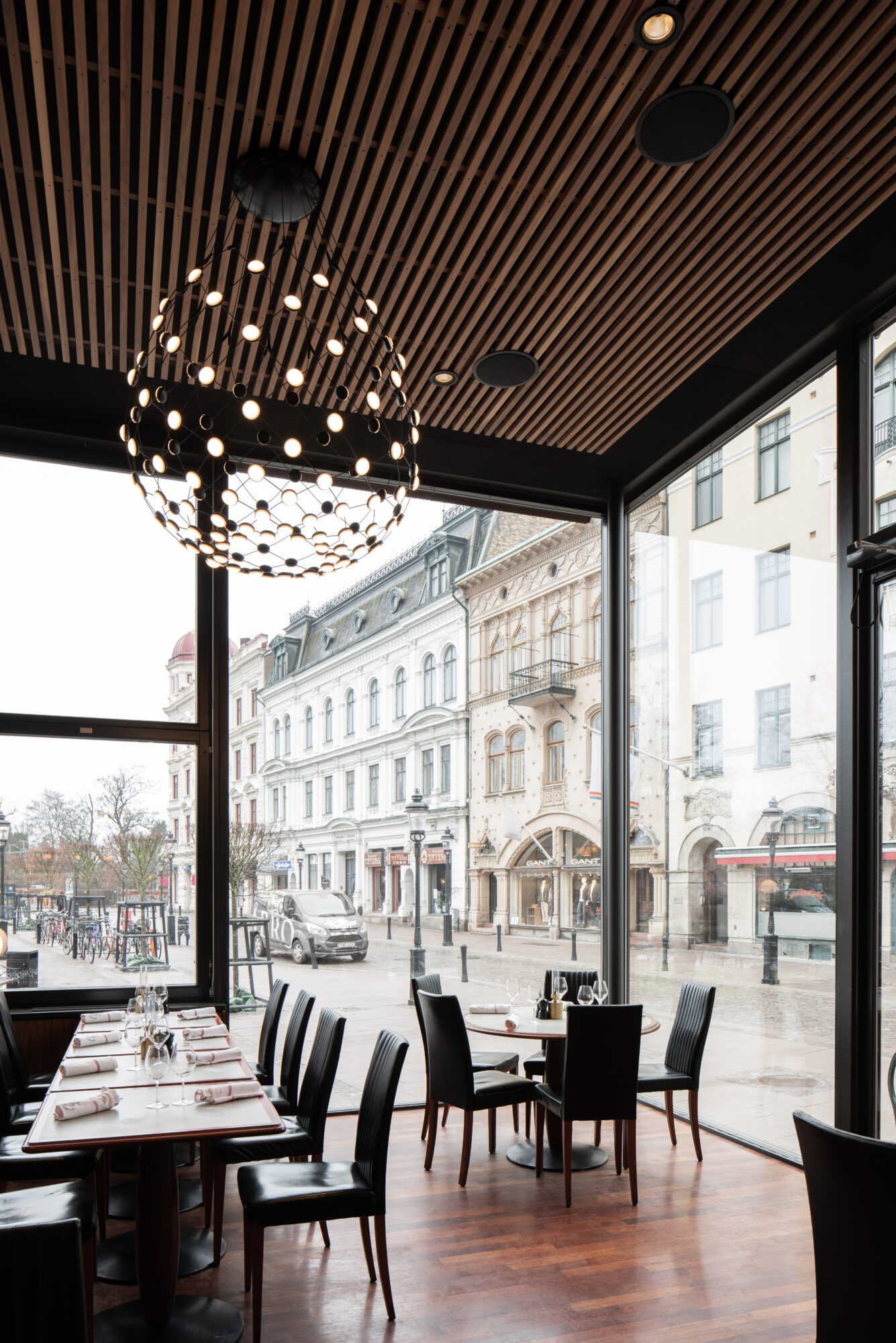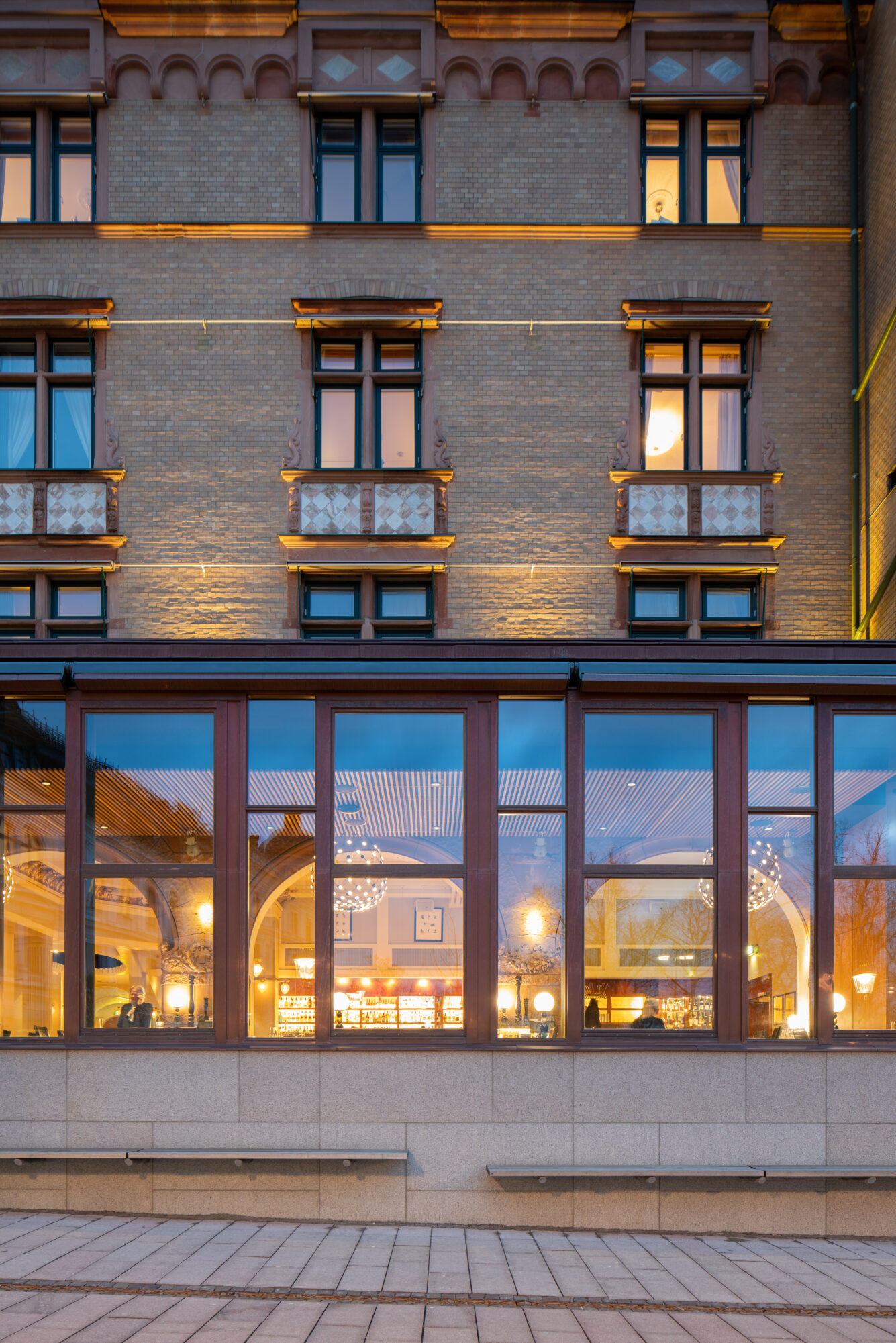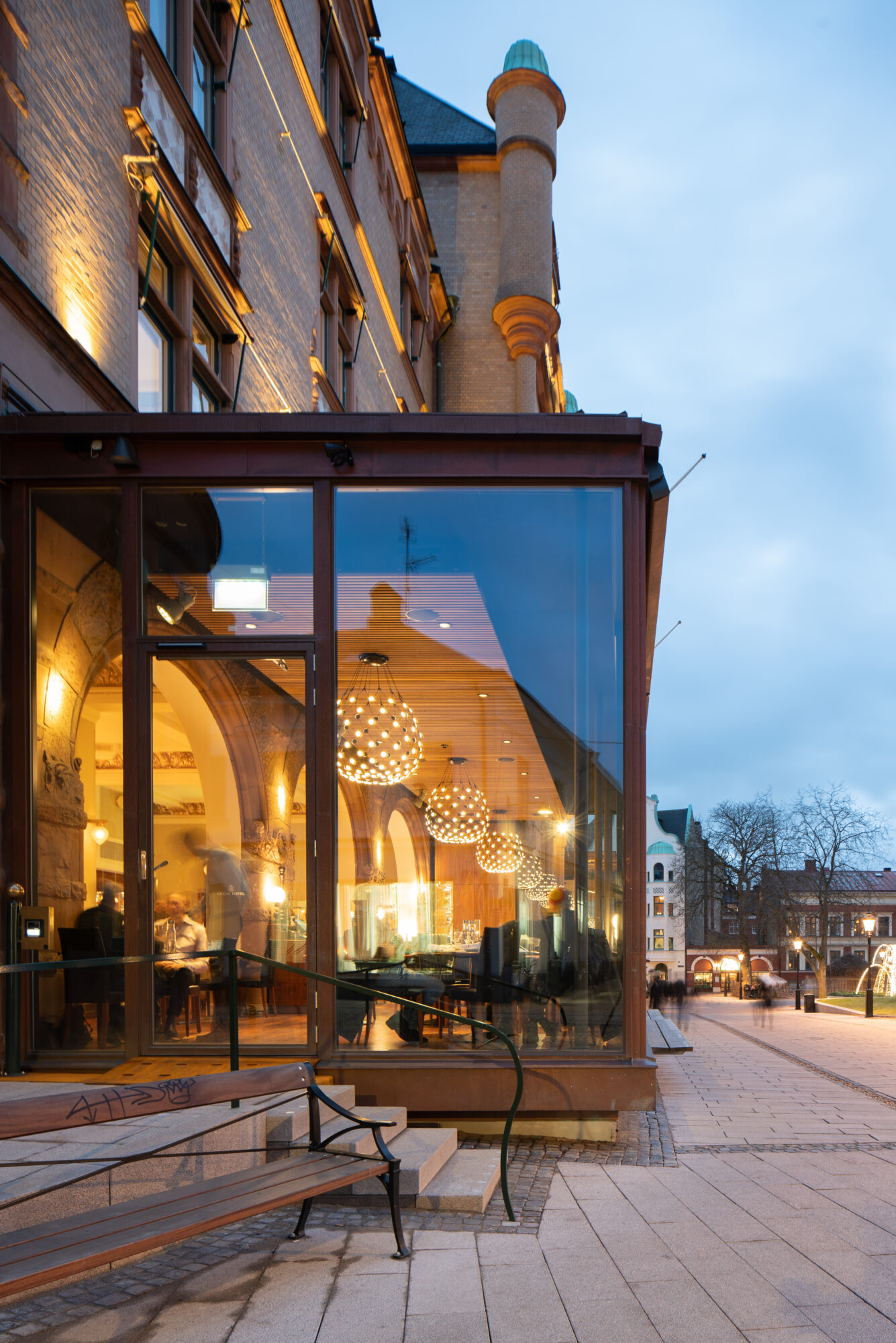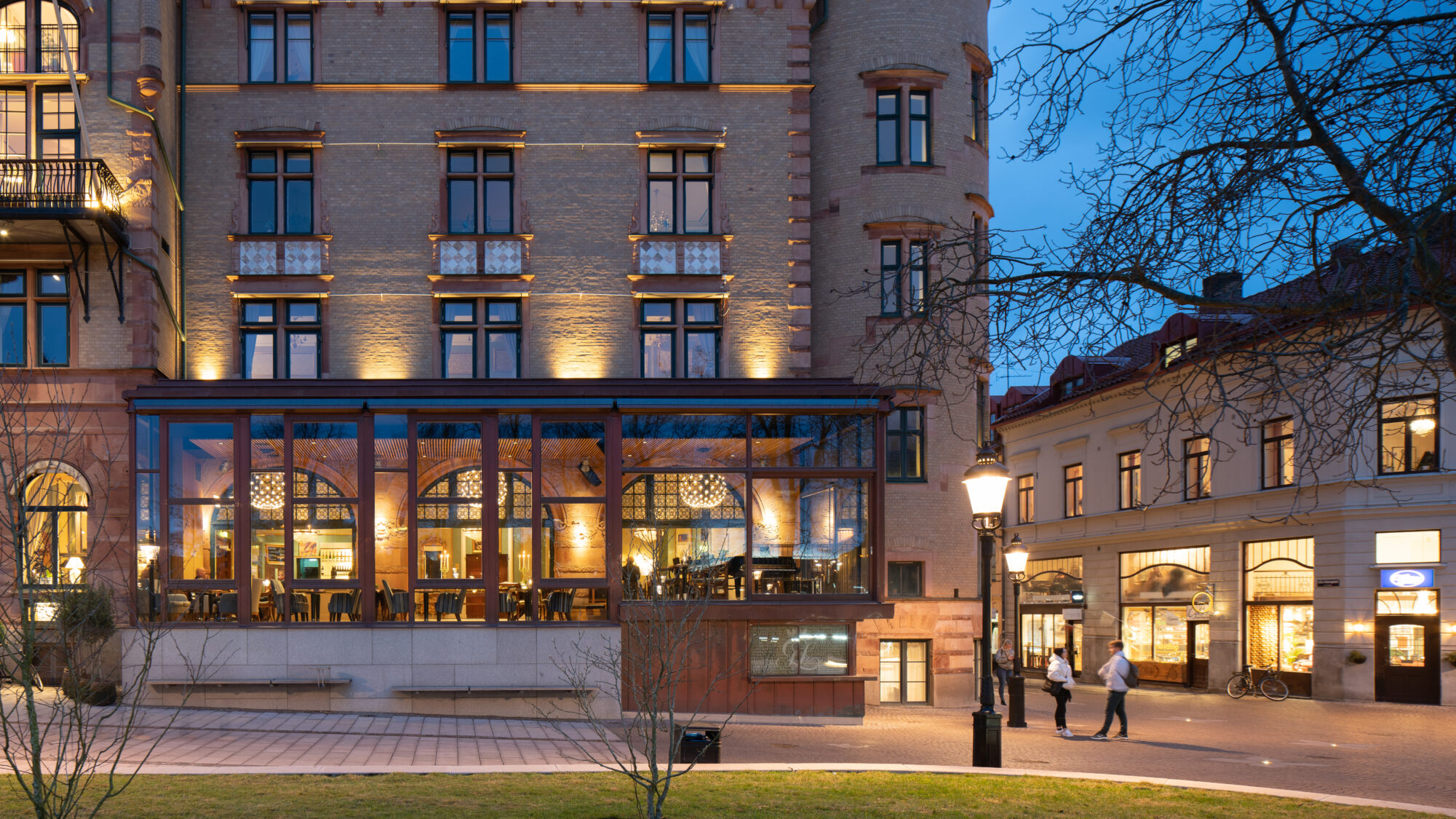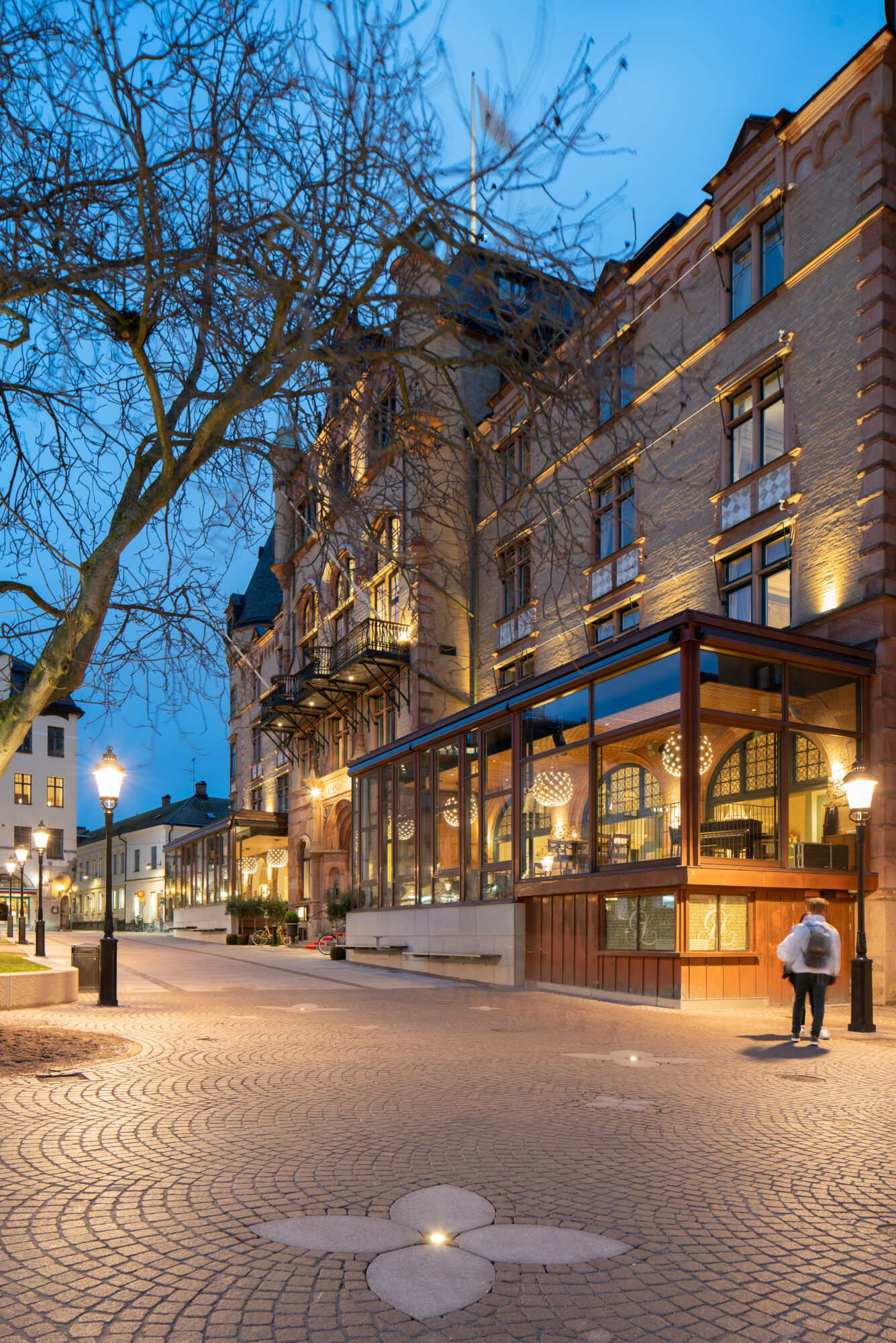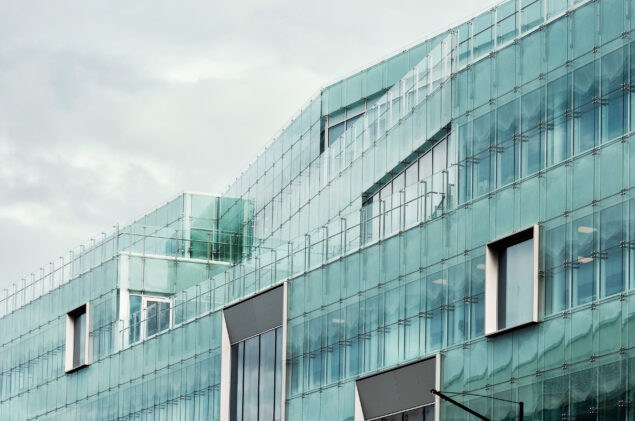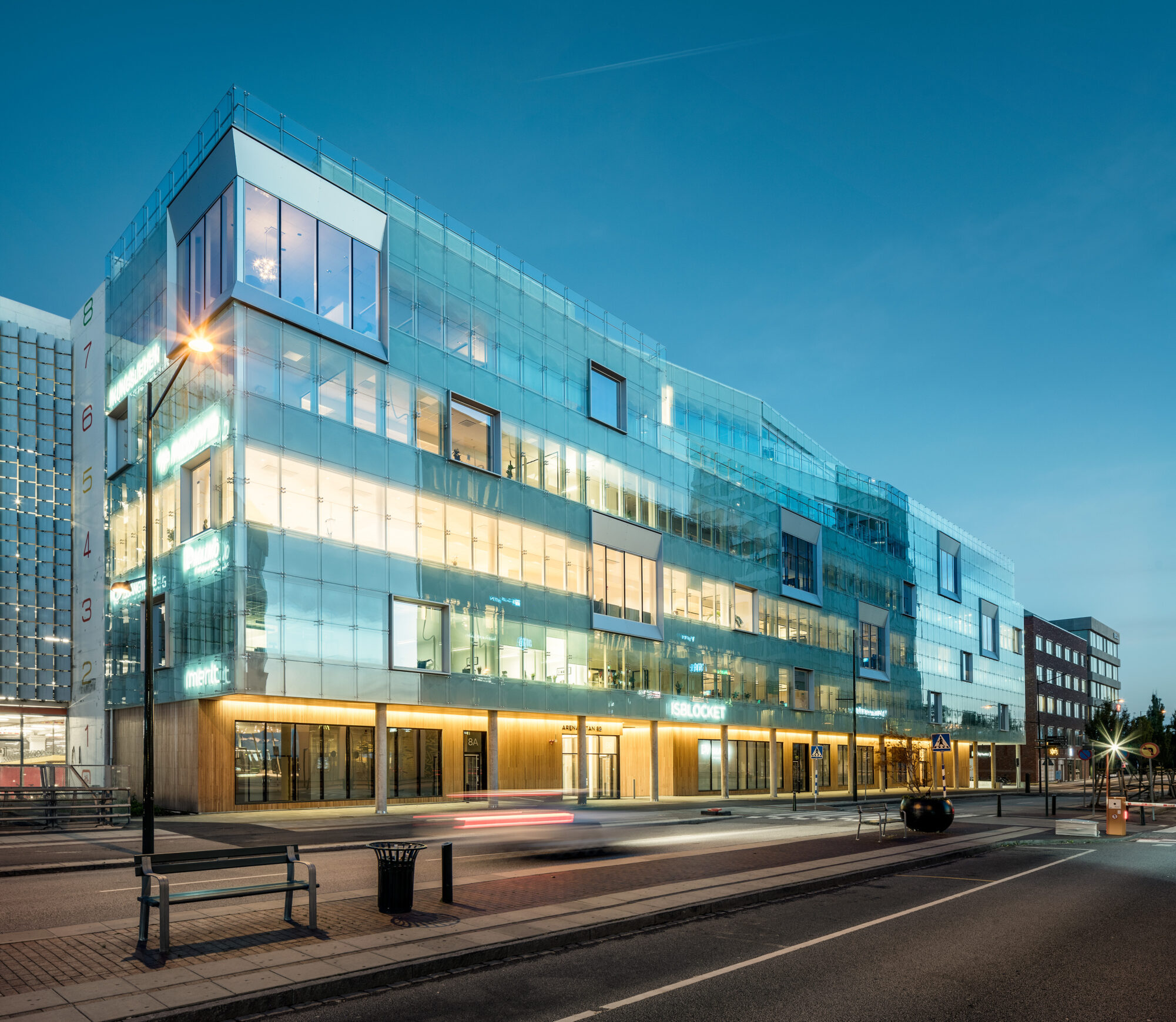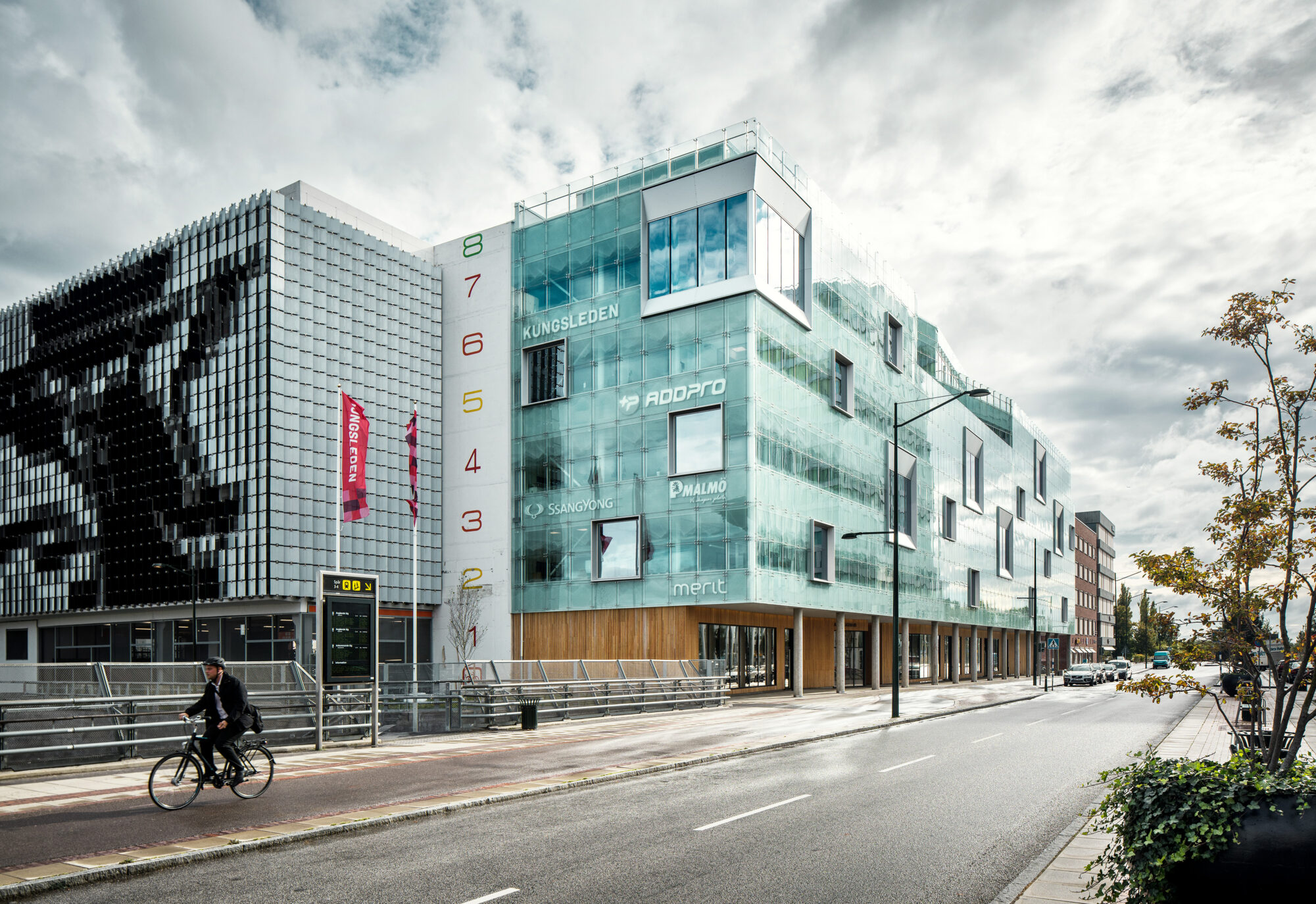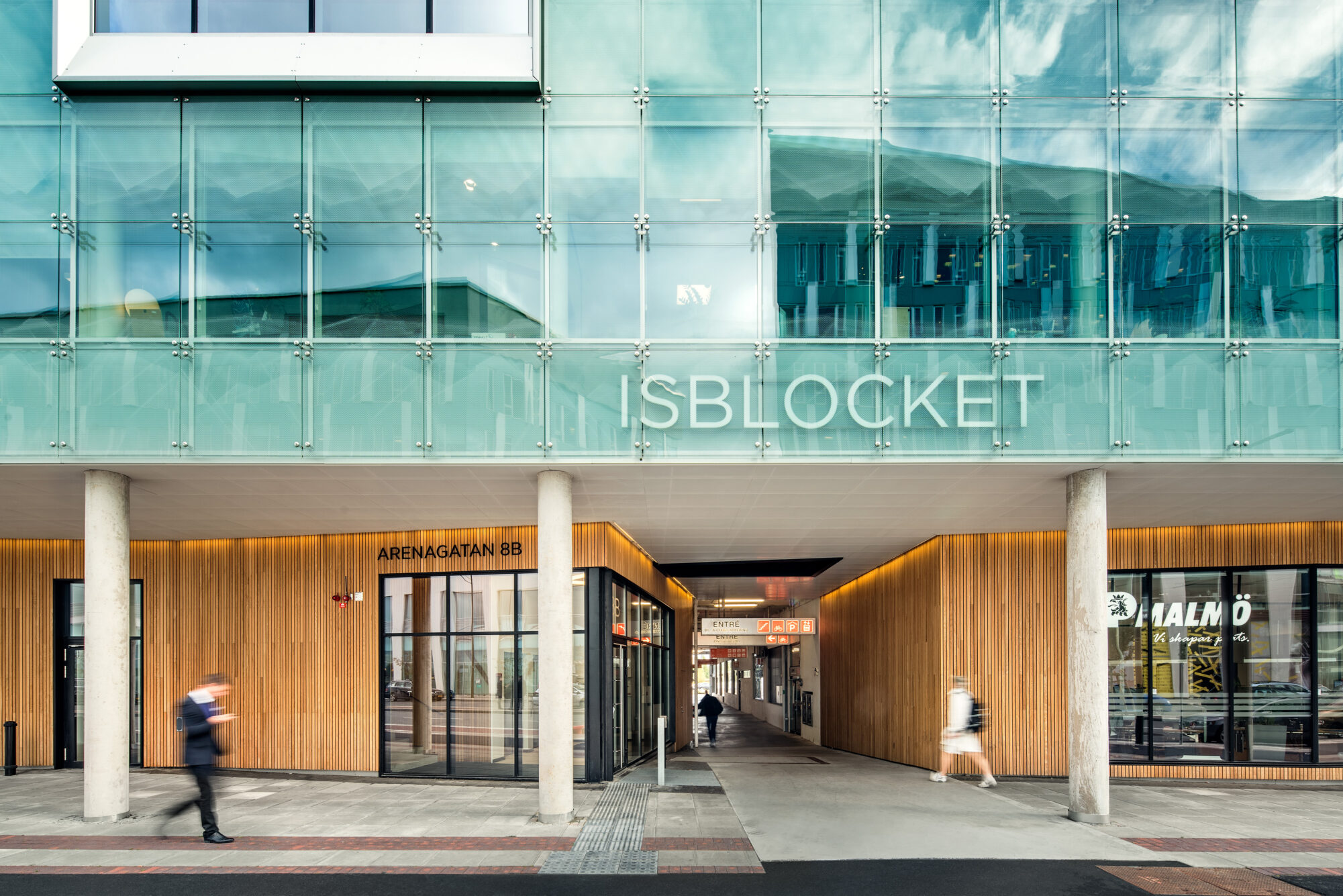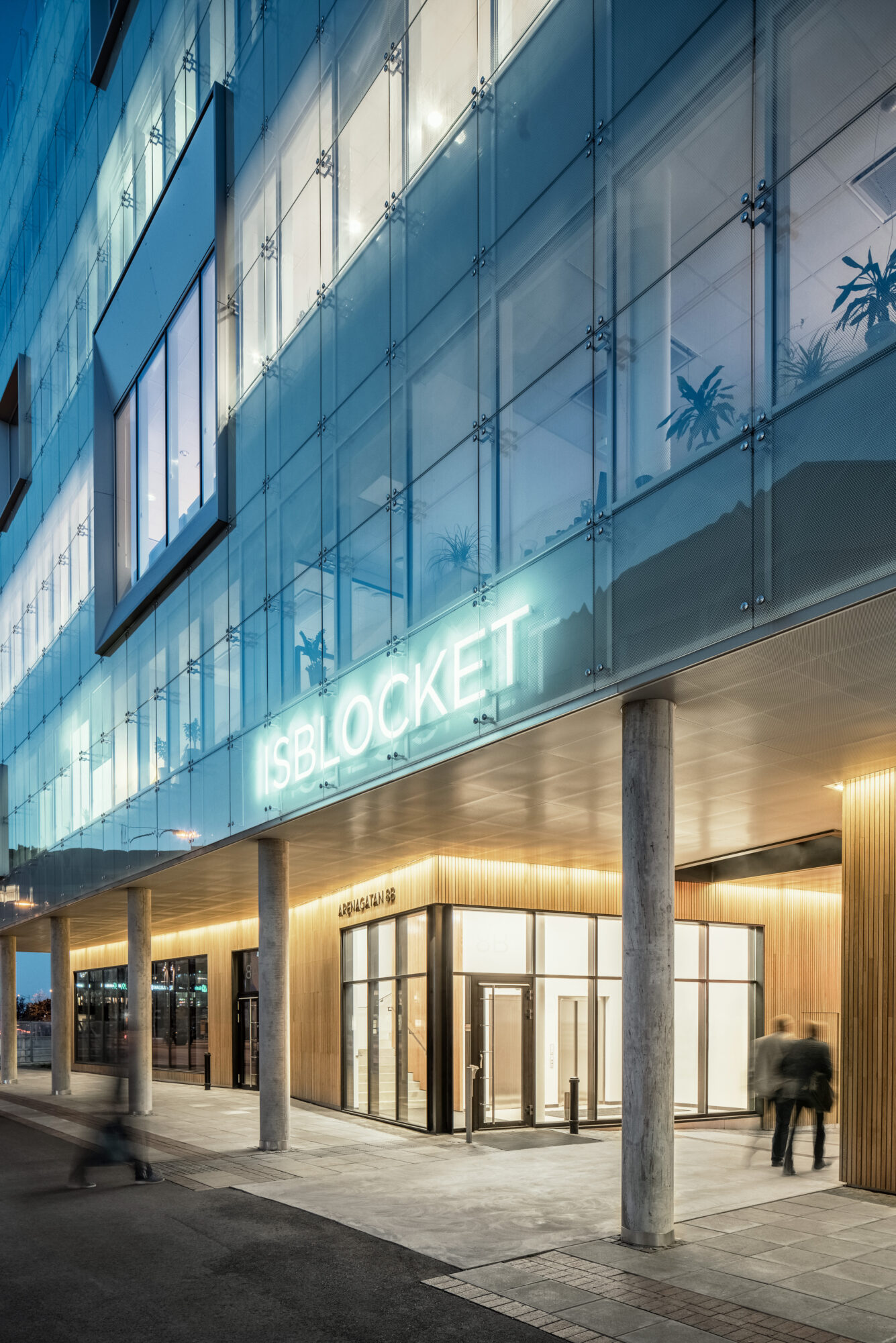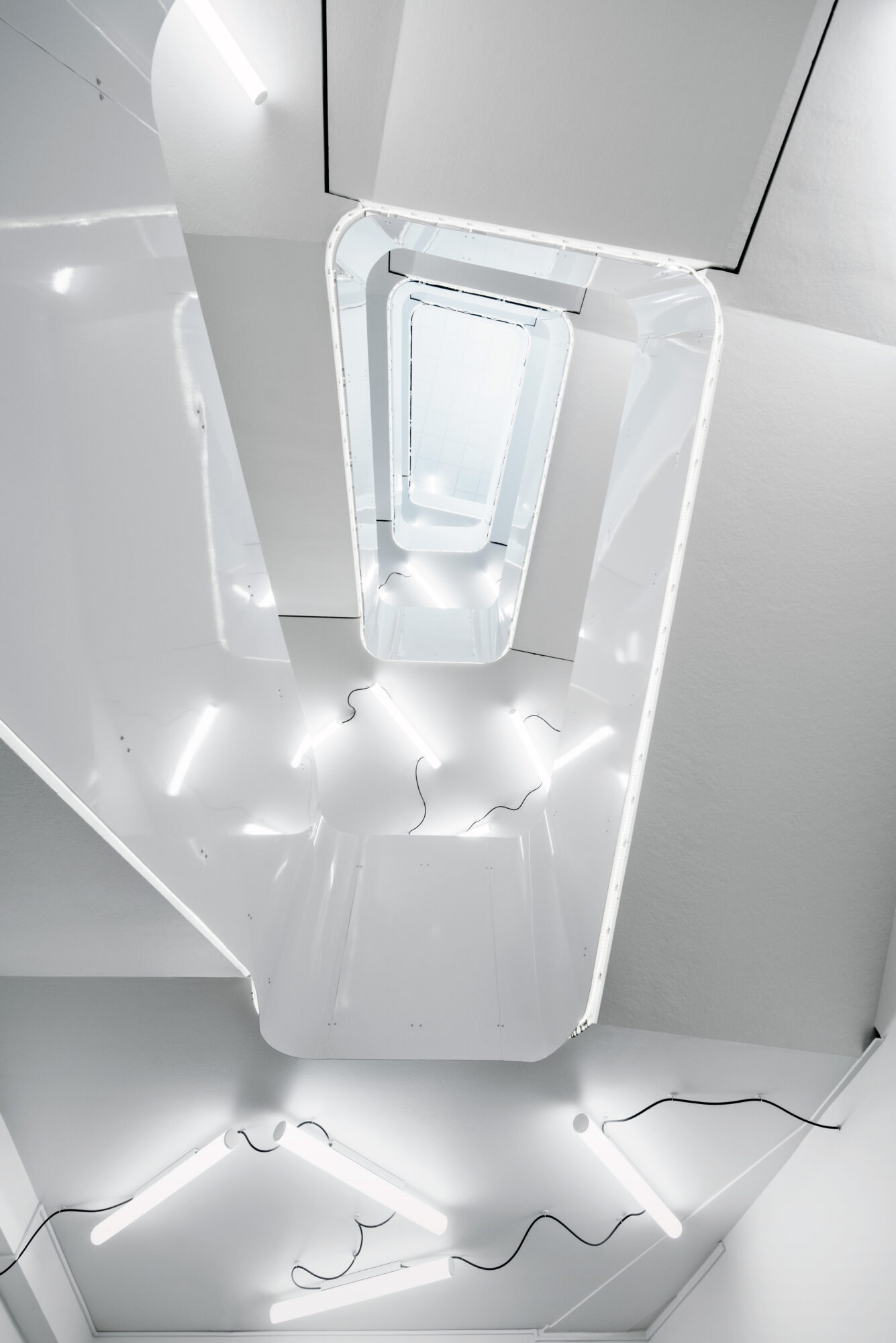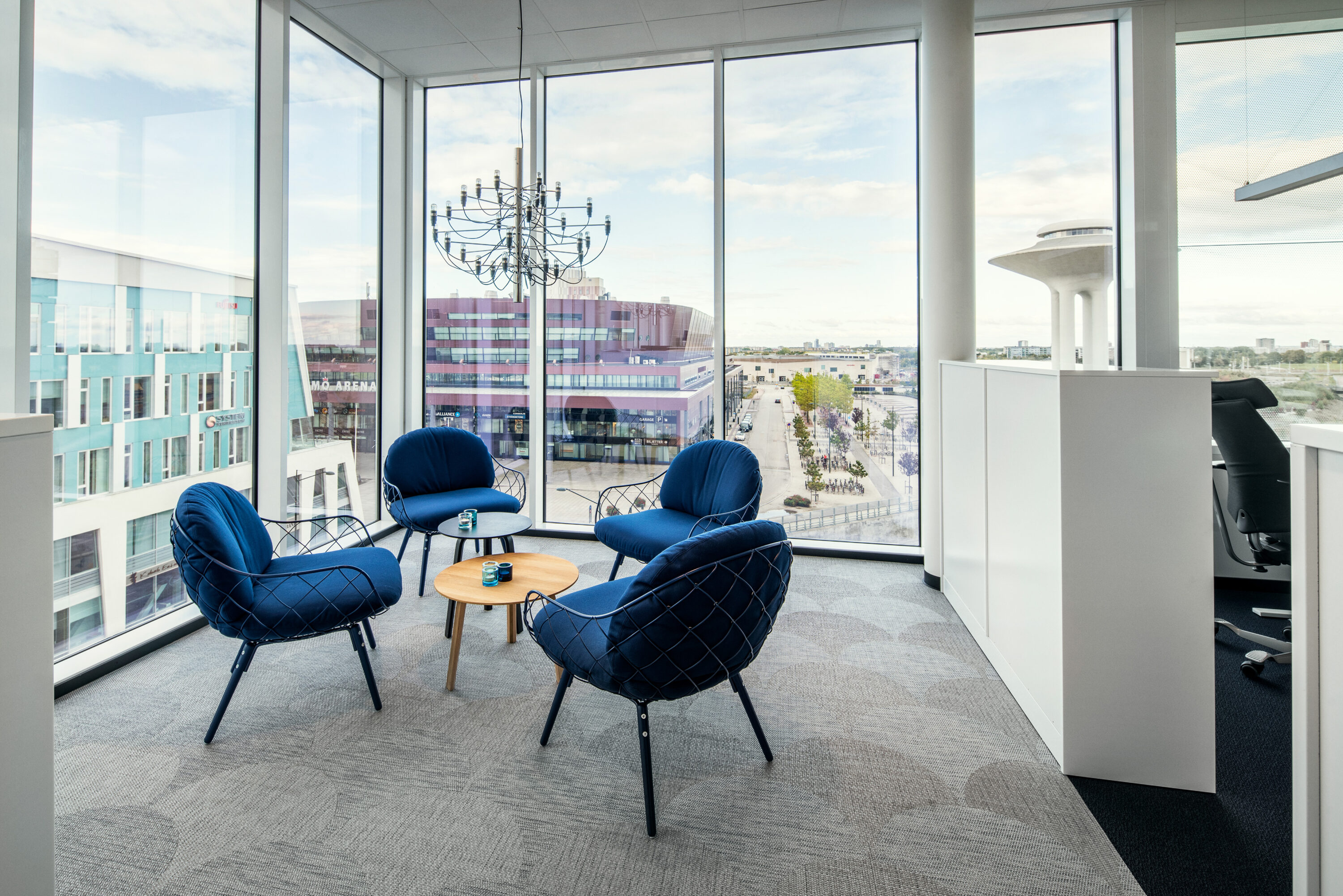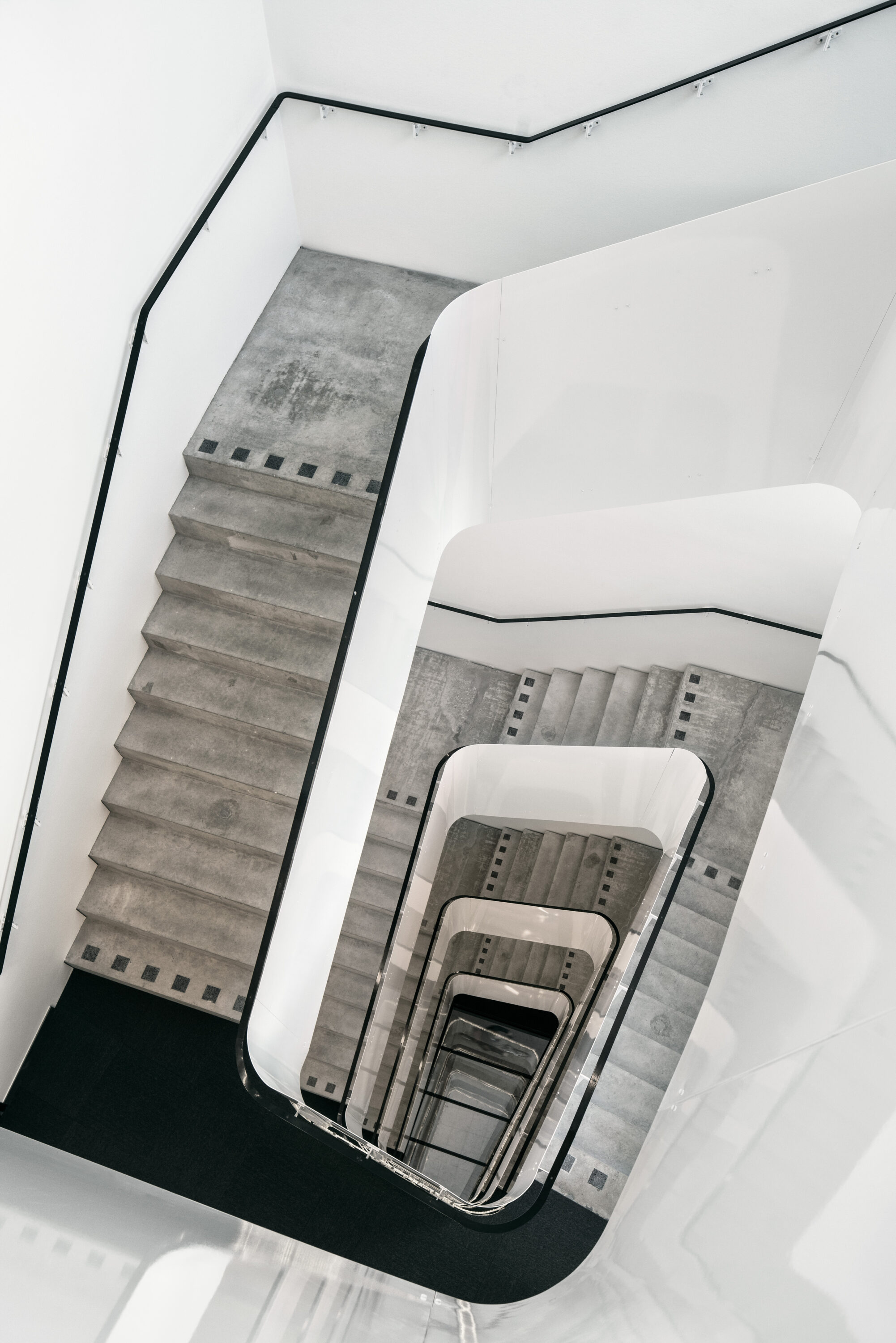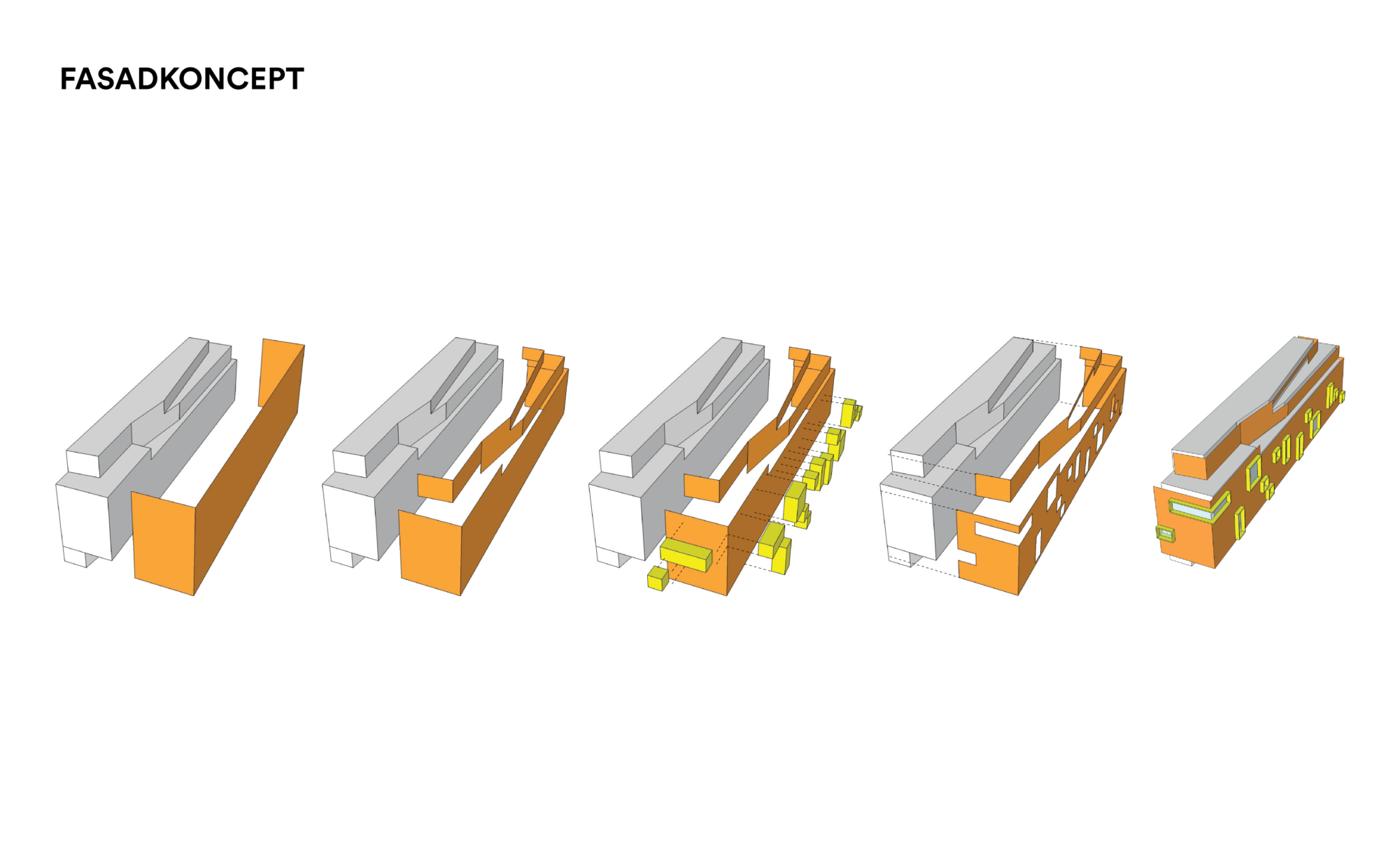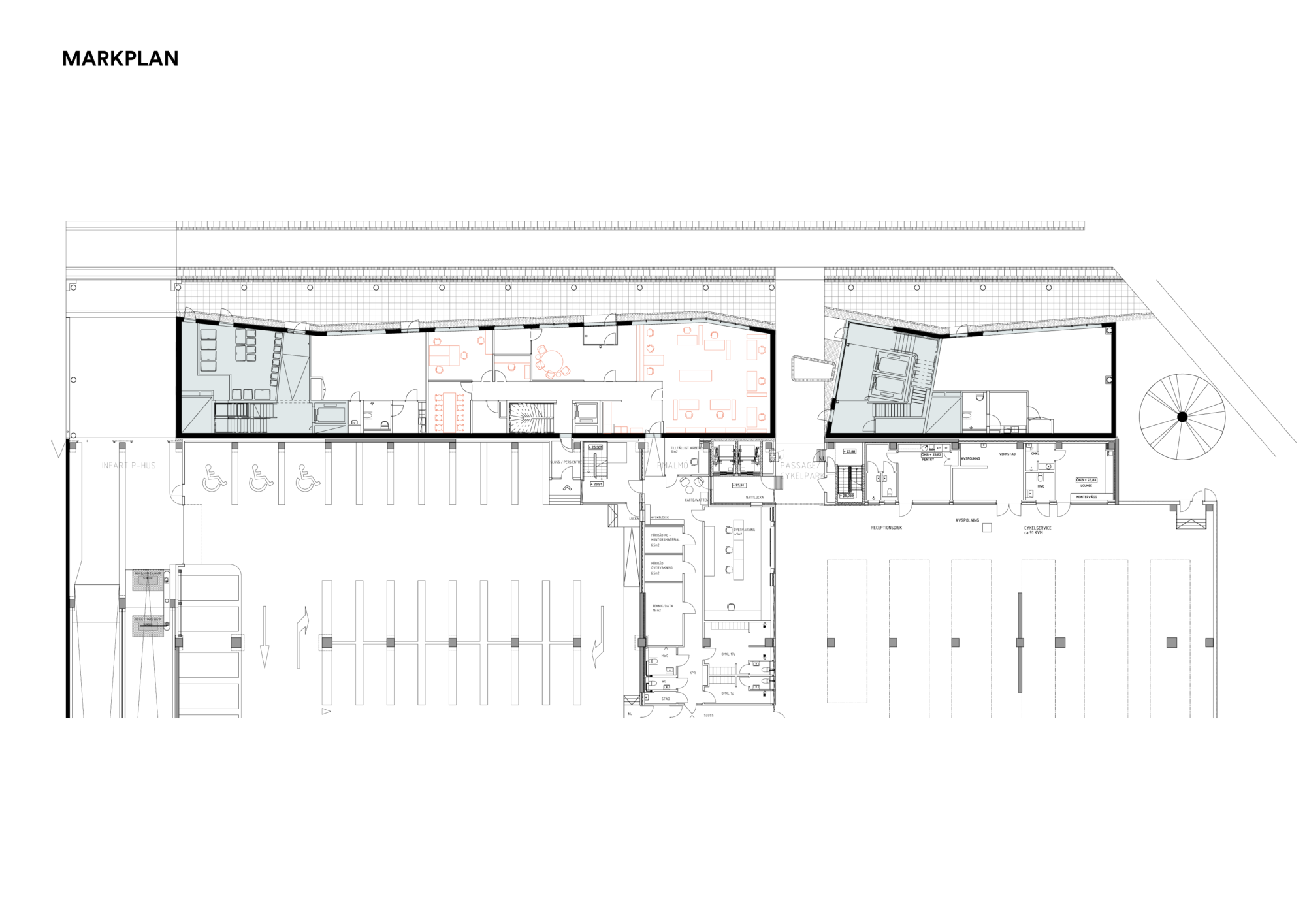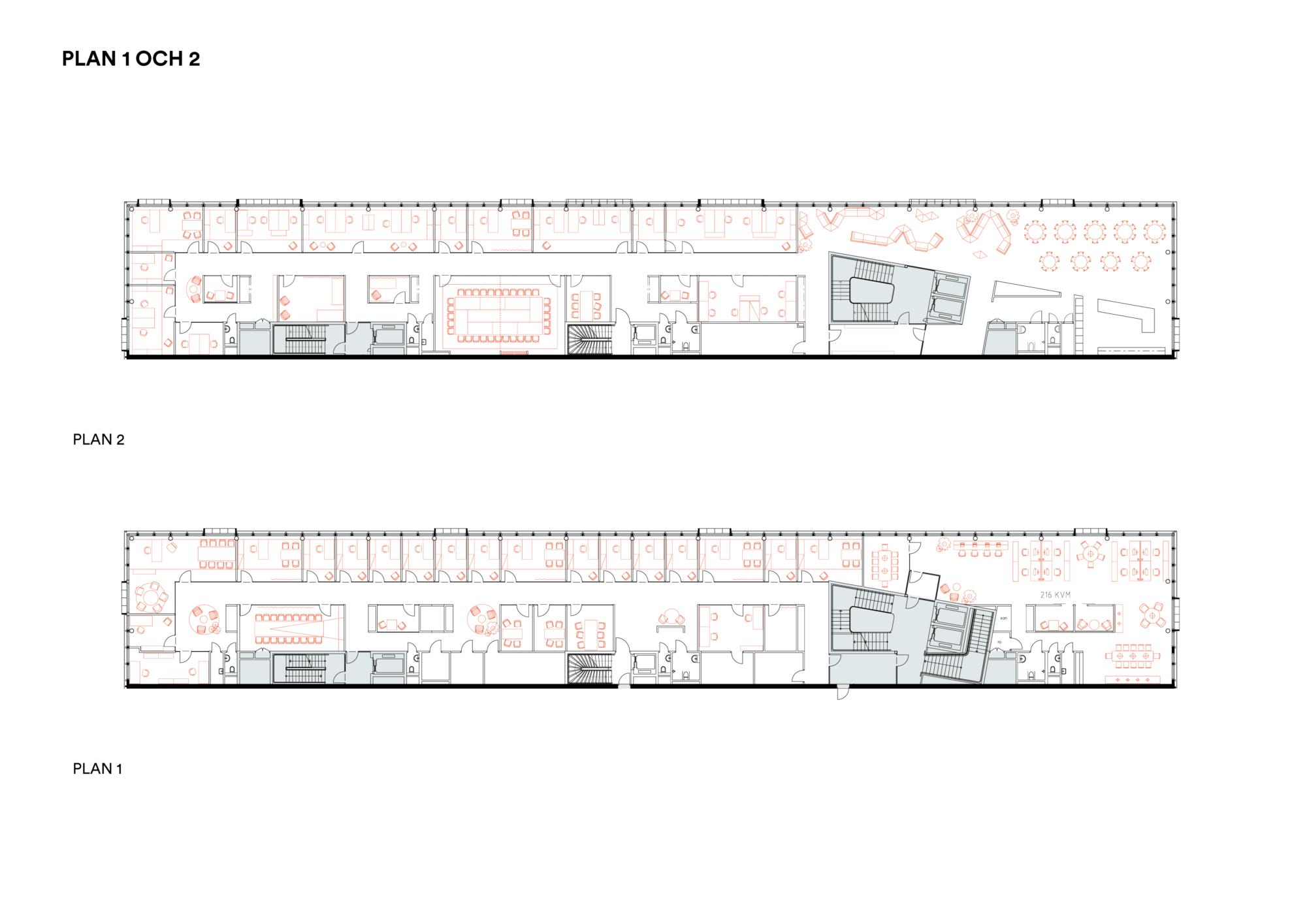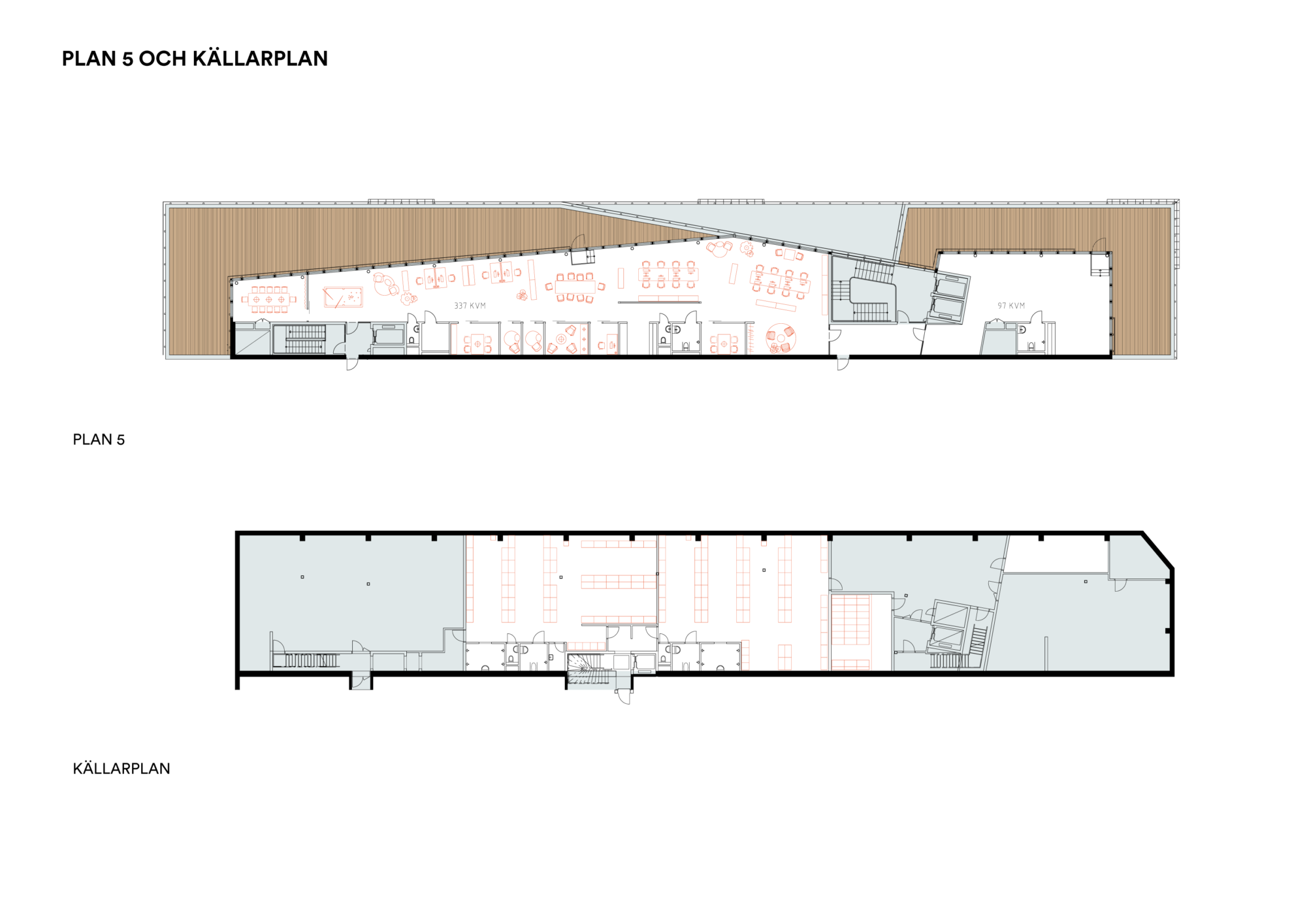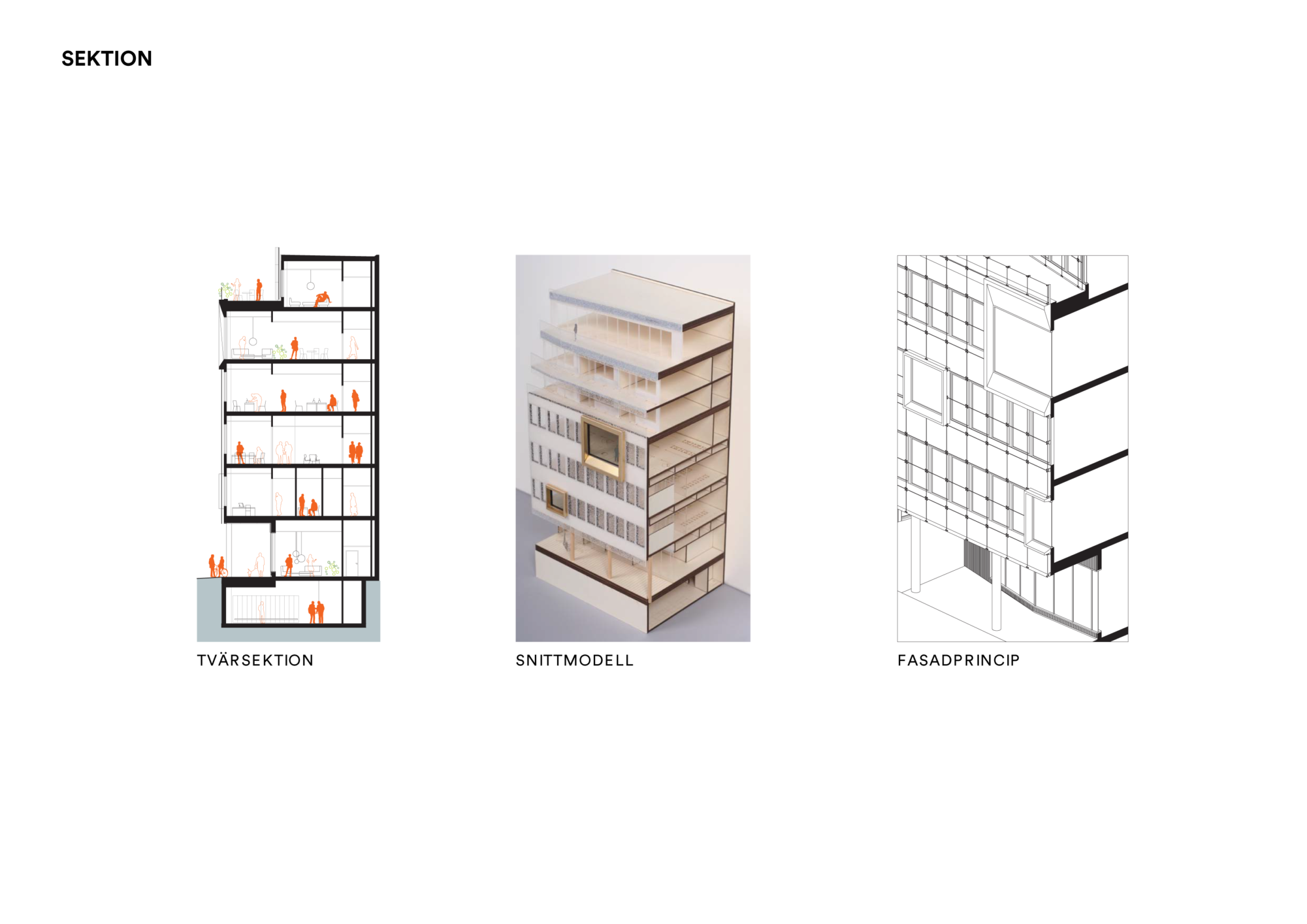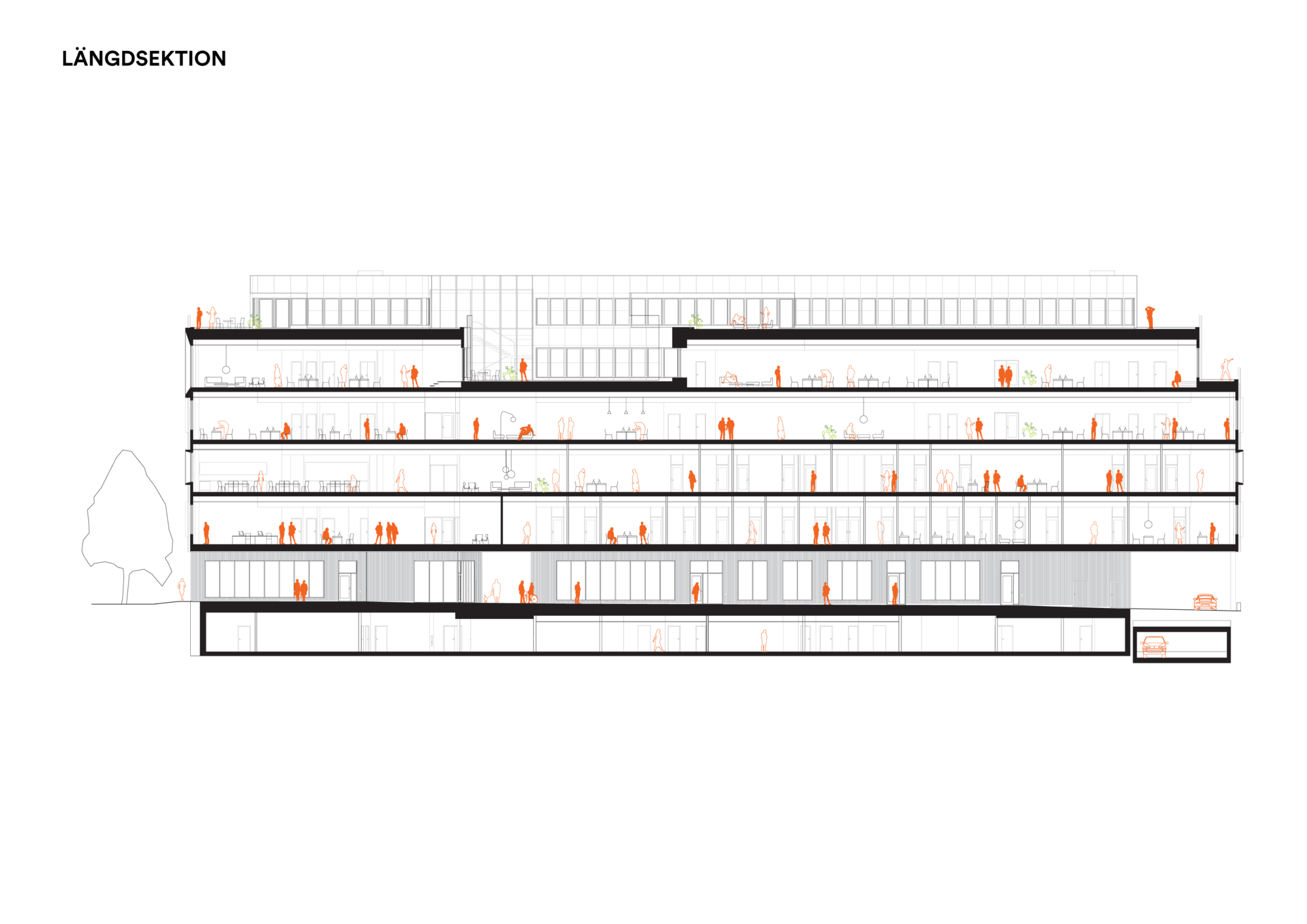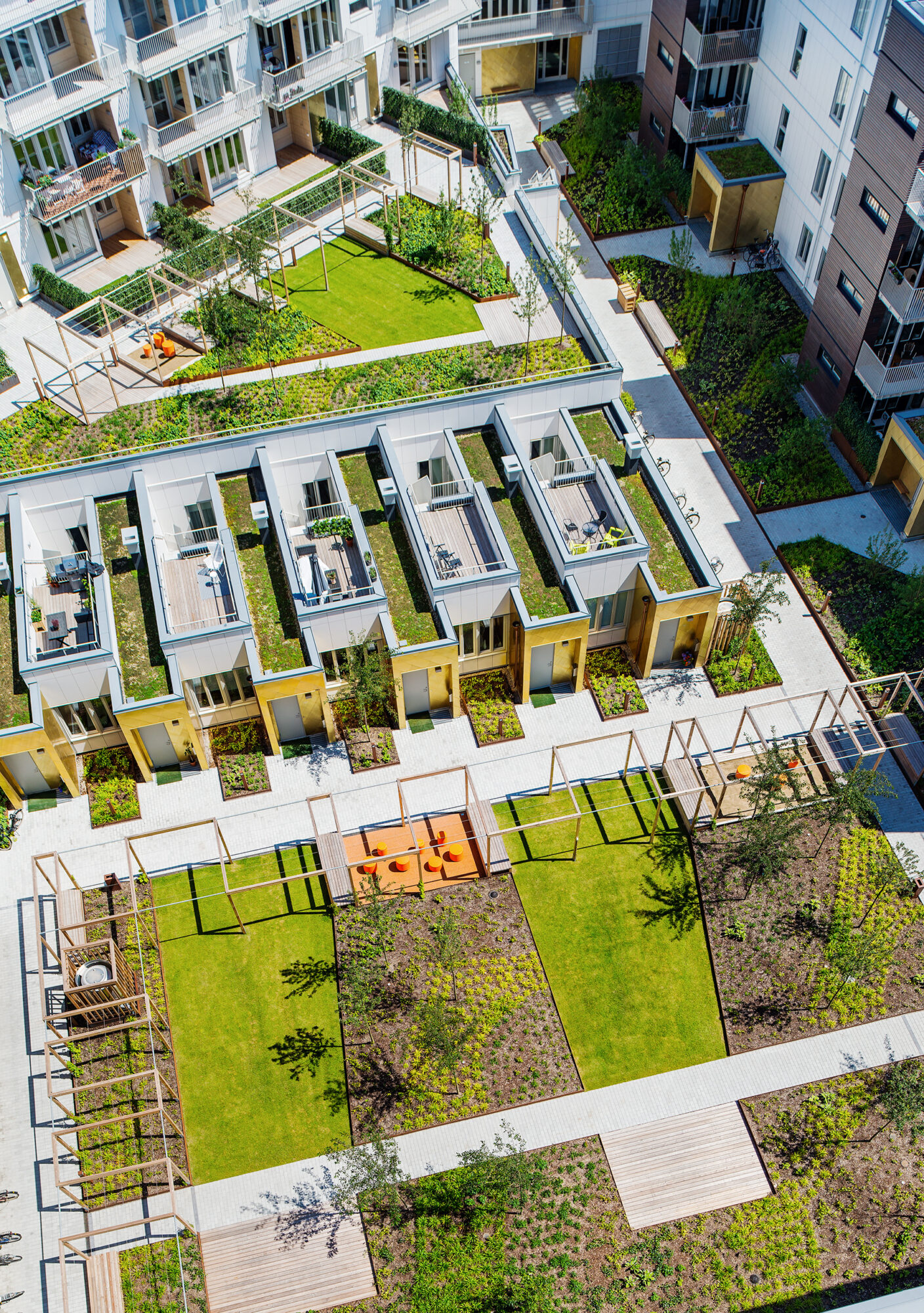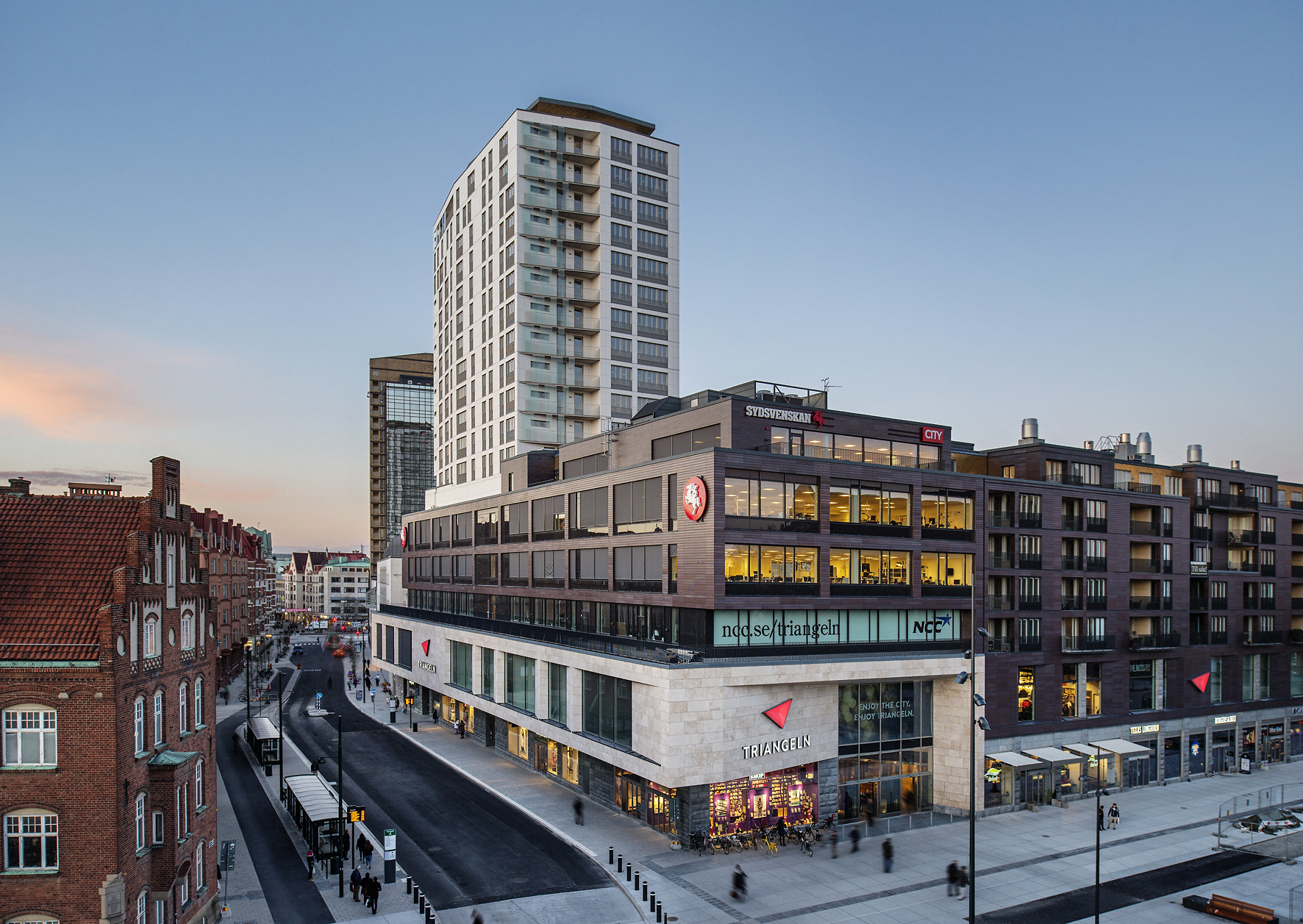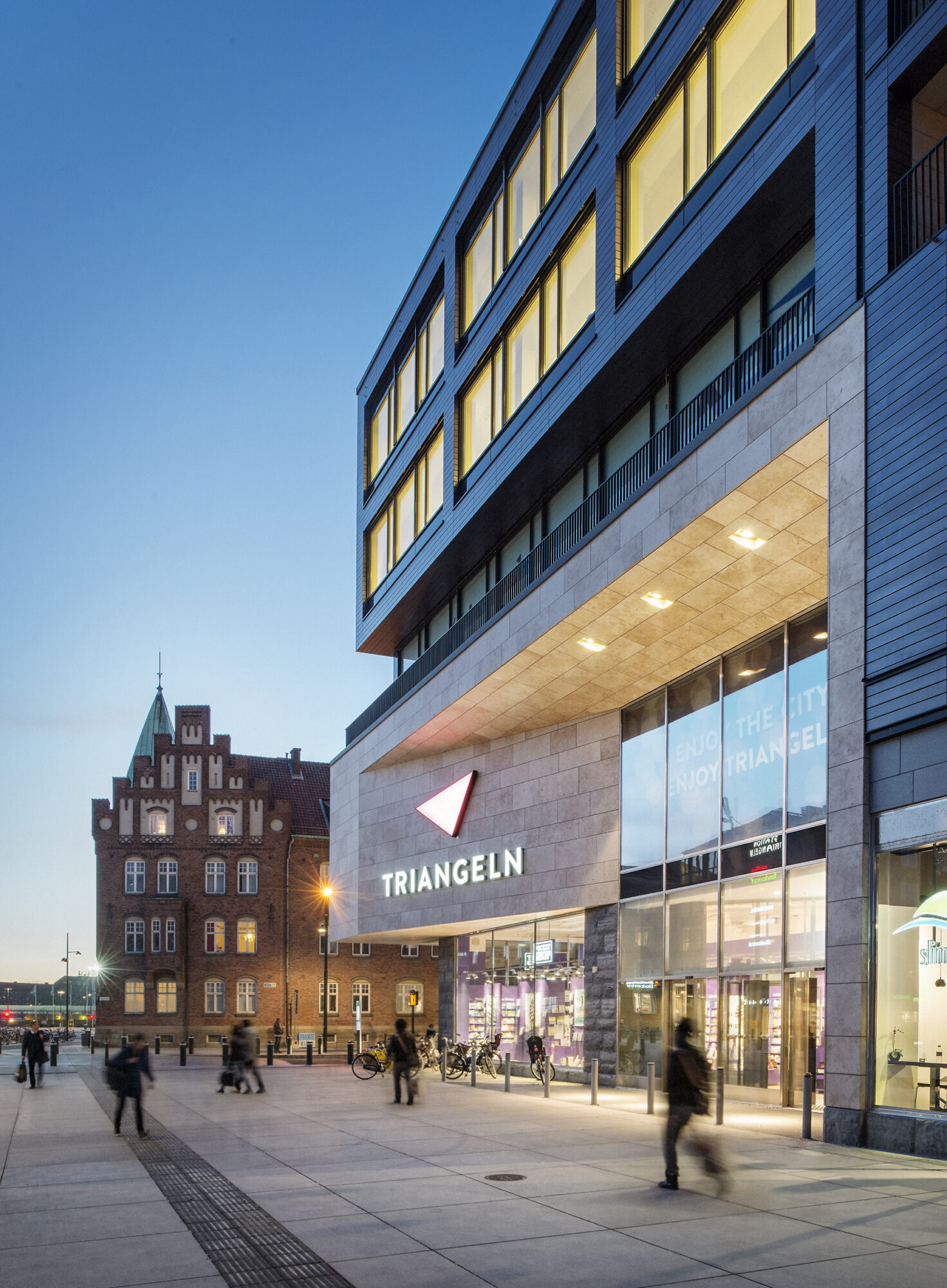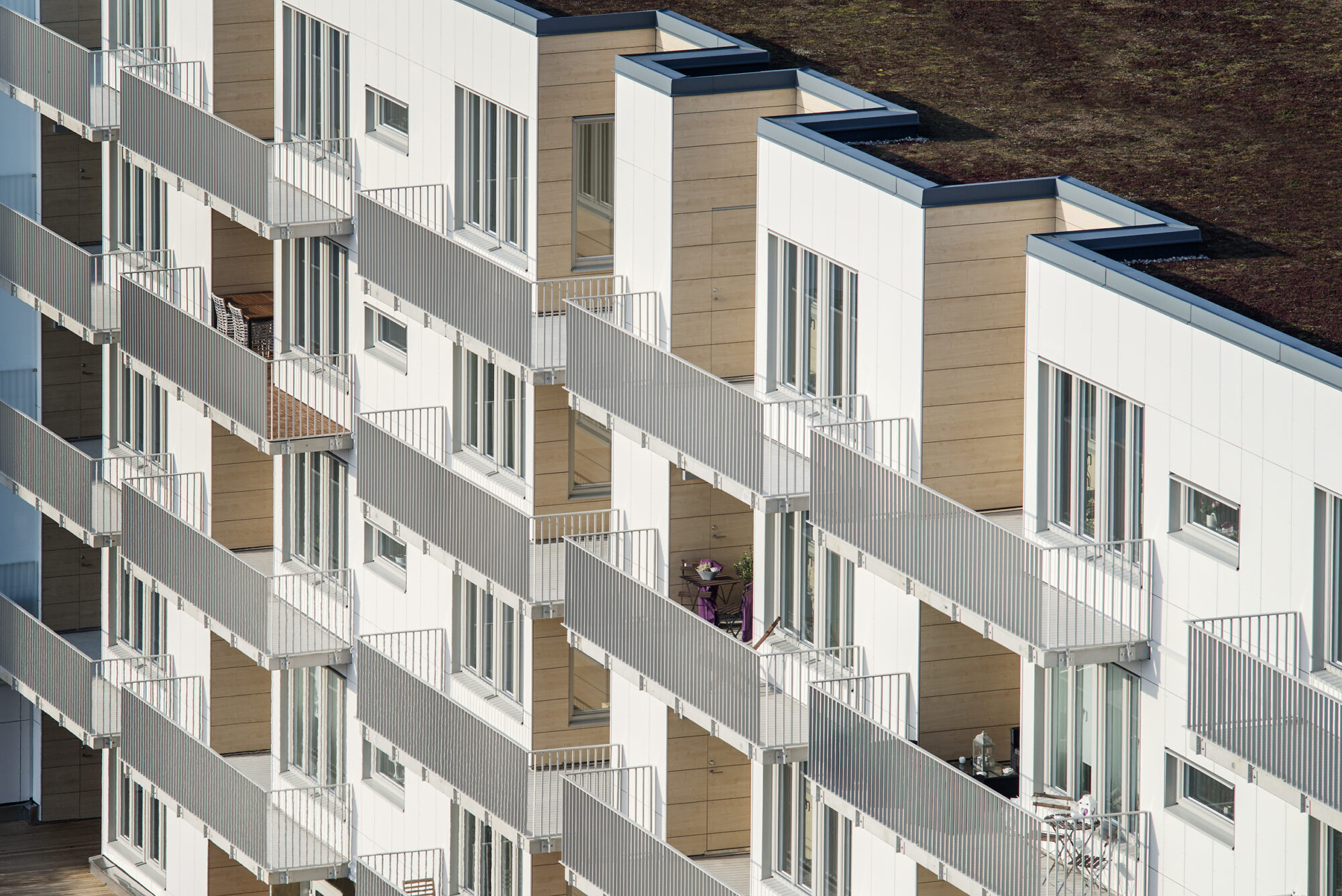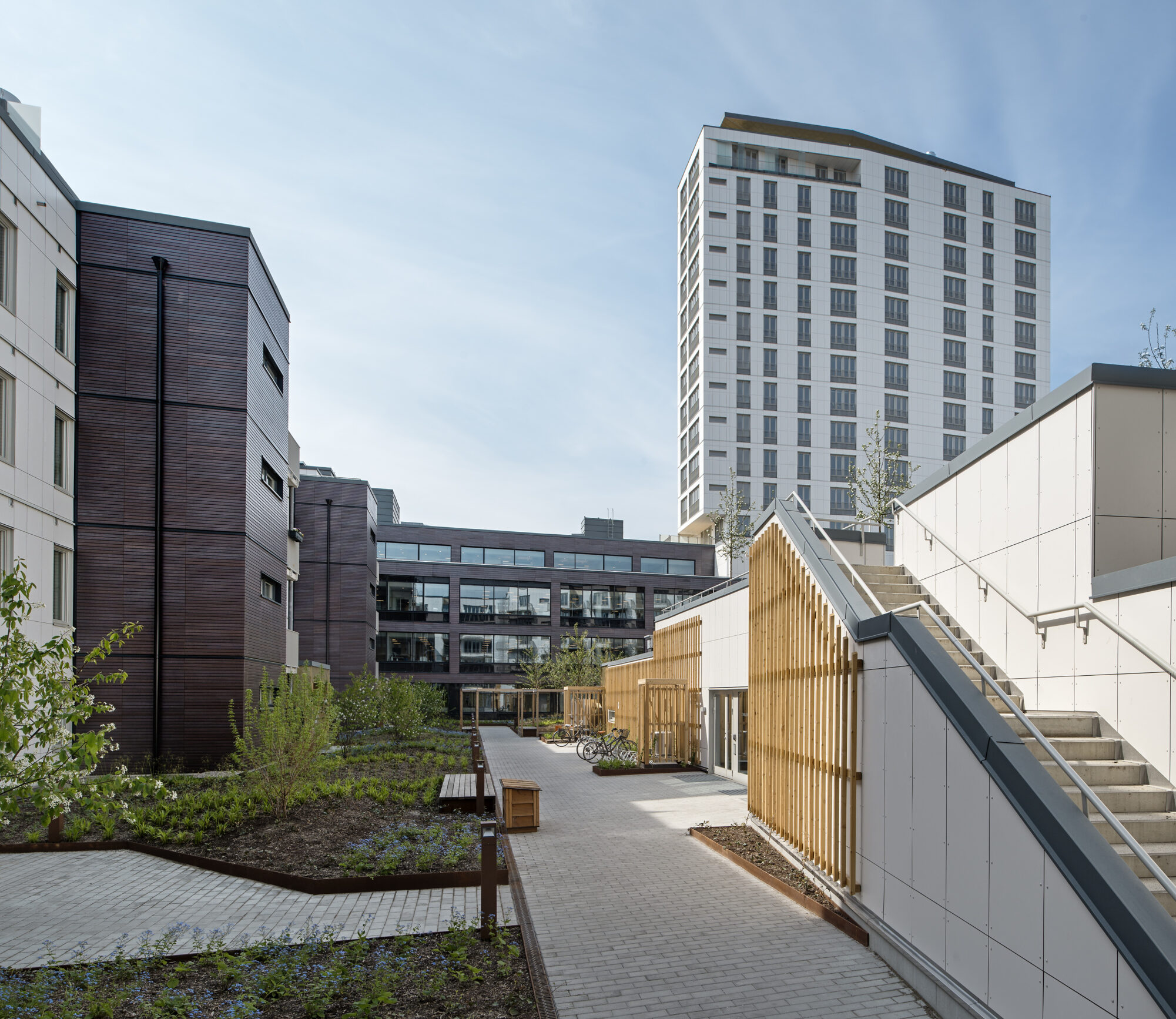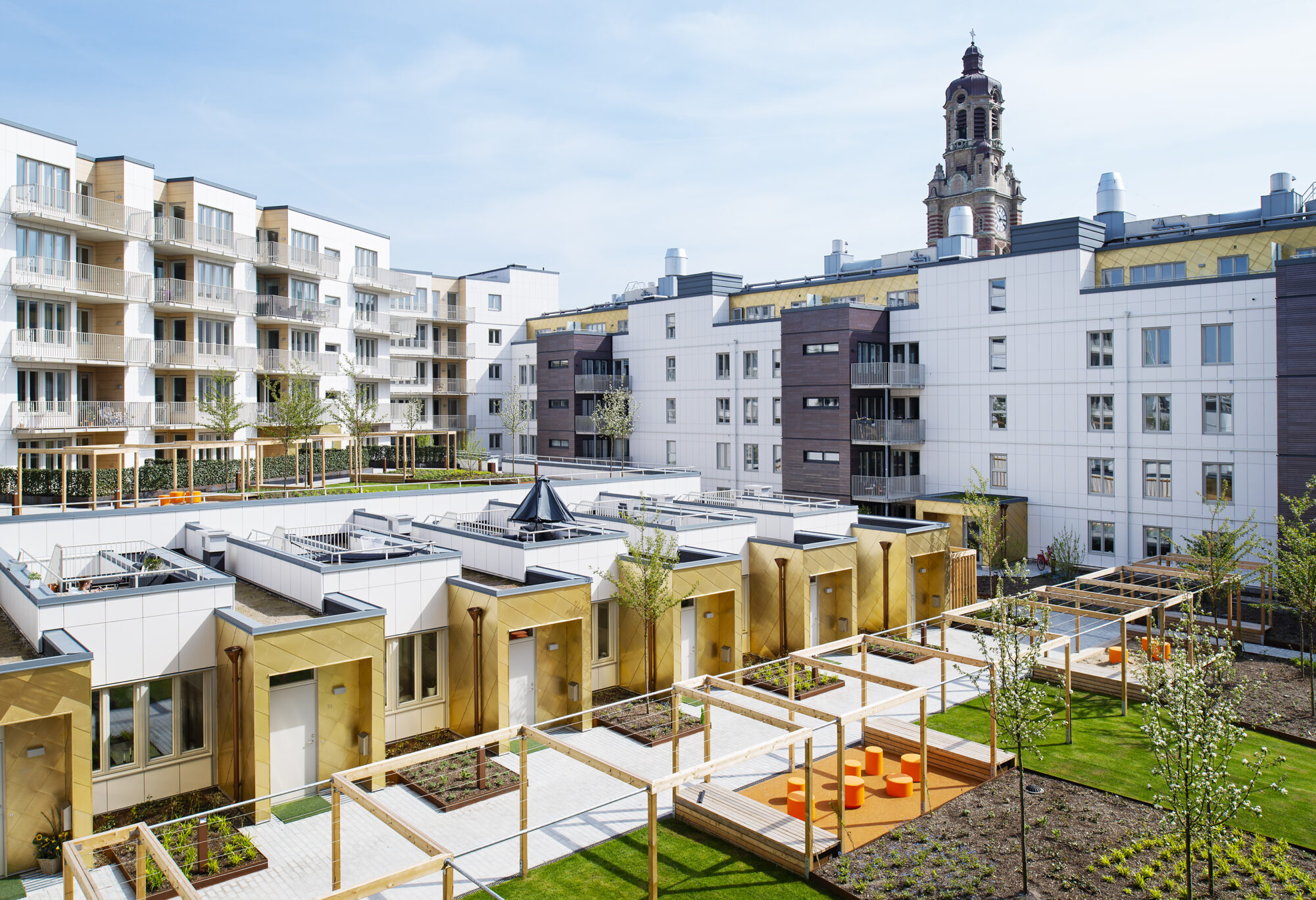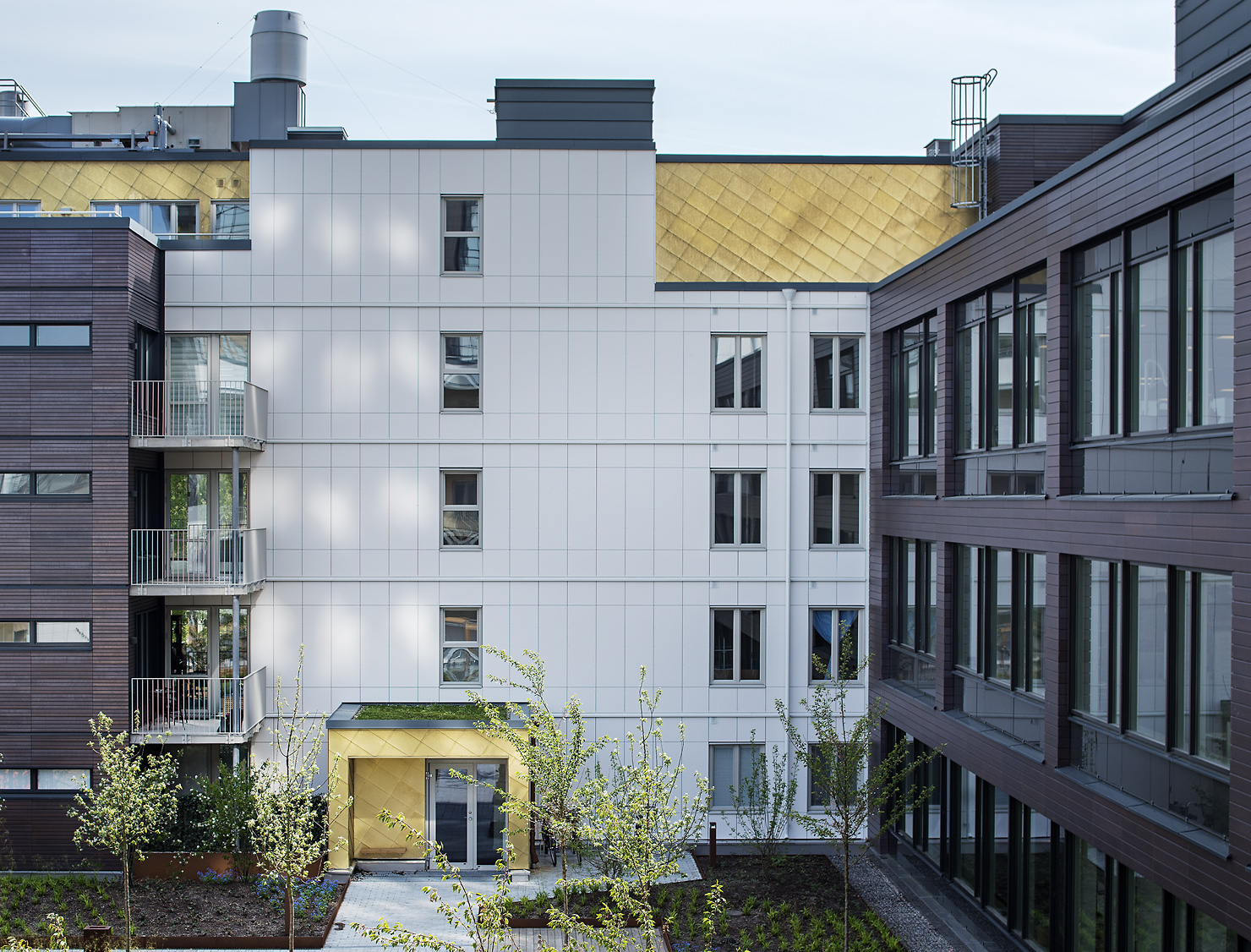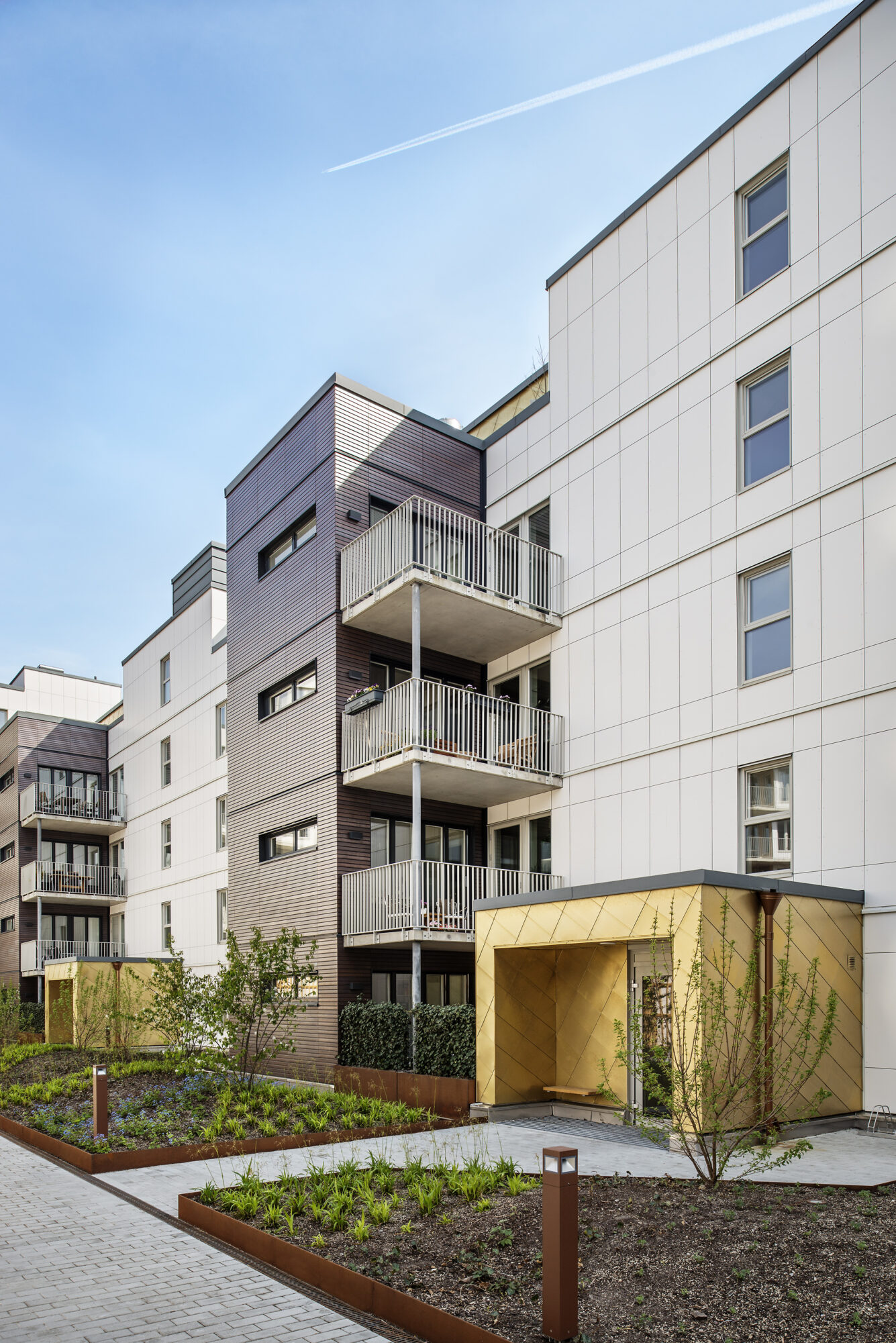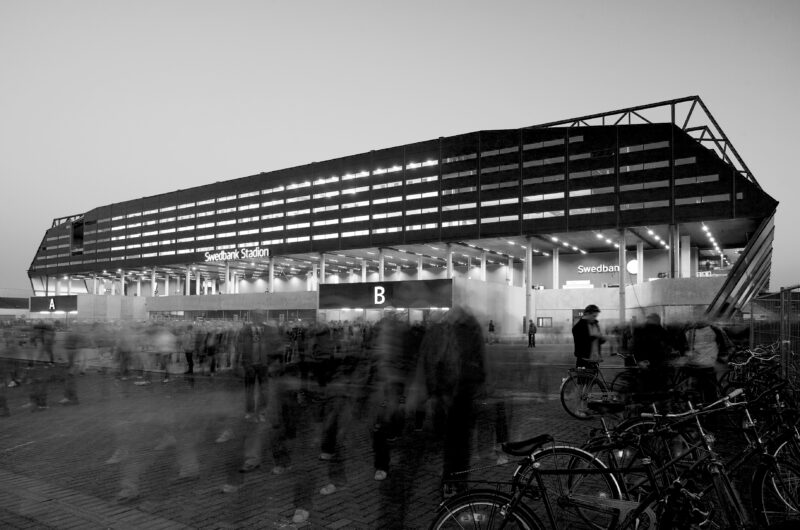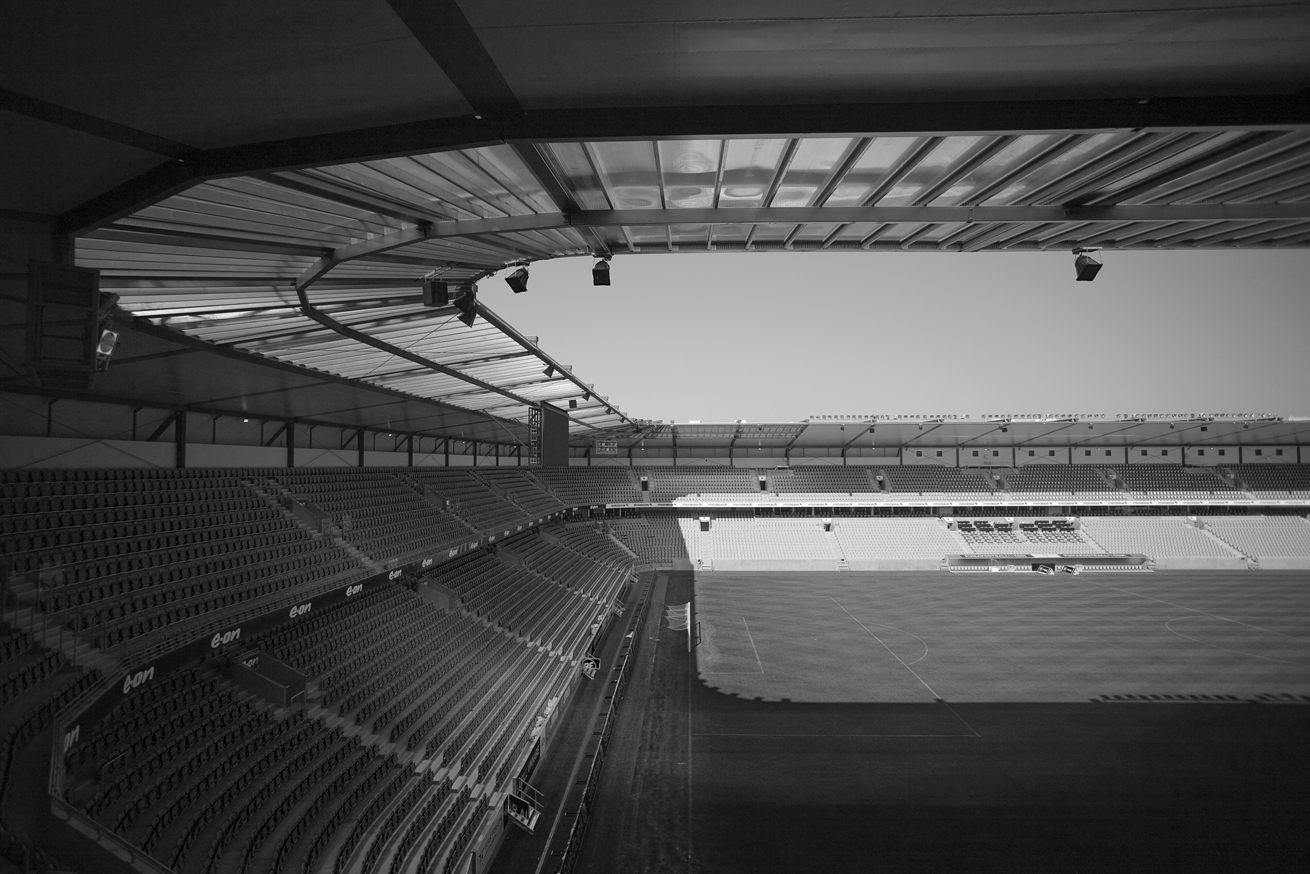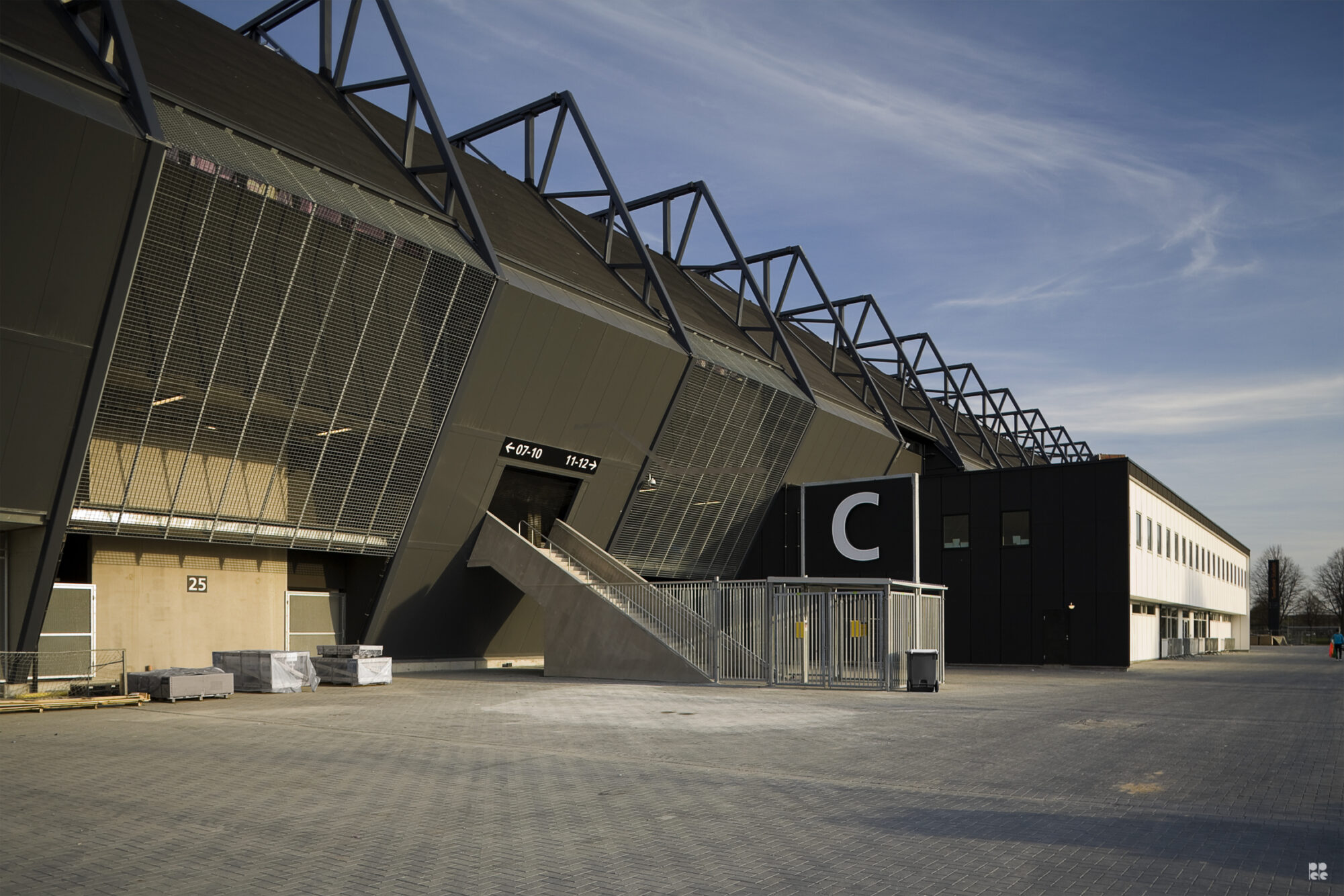Milleniumhuset, Marievik
Millenniumhuset is an architectural landmark with the task of signaling the entrance to the Stockholm district of Marievik, monumental in scale and design but at the same time part of the larger whole. There is now a first vision for an upgrade of the Millennium House, which will be an important piece of the puzzle in the development of the whole Marievik.
Most of the buildings in Marievik were designed and built during postmodernism, mainly in the 1980s and 1990s. Like other buildings in the area, Millenniumhuset is characterized by strong geometric shapes, unexpected details and clear colors. As the most modern building in the area, built in 1998-2000, the Millennium House stands out somewhat with its more austere expression, and together with the rest of the family it contributes to the image of a diverse but coherent neighborhood.
Millenniumhuset is about to undergo a major transformation that will both renew the building and reinforce its importance as a gateway to Marievik. The vision is to replace the existing top floor with three new floors, creating a new silhouette in the cityscape. The Millennium Street - which runs through the building - will be developed into a more public and vibrant place through new activities, clearer entrances and increased visual openness on the ground floor. A glazed arcade facing Årstaängsvägen gives the building a more welcoming front, while new entrances, elevators and evacuation stairs increase accessibility and capacity. The goal is an attractive office building that contributes to the vision of an open, diverse and vibrant Marievik.
The project is characterized by the desire to develop the existing rather than replace it. By preserving the building's structure and character while adding office space with high spatial and functional qualities, sustainability is combined with architectural ambition. Millenniumhuset will be an important part of the whole - a new layer in Marievik's development.
Norrgavel Stockholm
With the cultural environment as a sounding board, we have, in close collaboration with Norrgavel, optimized flows, tightened the material palette and created a new store experience. On the exterior, the expression has returned to the original ideas and facade decorations have been renovated.
The 1911 building on Birger Jarlsgatan in Stockholm was designed by architect Carl Bergsten, who also designed the Liljevalchs konsthall. The design language is heavily national romantic but at the same time with a certain playfulness and with several unconventional approaches. The building is considered particularly valuable and worth preserving.
The building was built as a theater but with the idea that it could be converted into a department store. In 1938 the building became a cinema and in 1985 the rock club Gino moved in. For a few years in the 1990s, an office was housed here before Norrgavel took over the premises twenty-five years ago. Numerous changes have been made both internally and externally over the years, but it is only now that the building is really being adapted for retail operations.
Inside, space has been freed up, accessibility has been improved and lines have been cleaned up. A new floor opening in the atrium and a former outdoor staircase have now become part of the shop floor. The space feels contemporary and modern but in harmony with Carl Bergsten's intentions.
On the exterior, the building has been restored to its original design in terms of materials and colors in consultation with the architectural antiquarian. The facade's large windows have been restored, the entrance has been moved and decorations have been restored.
Riksby sports hall
Riksby Idrottshall is part of a larger detailed plan for Linta Gårdsväg in Riksby, right next to Bromma Airport. Linta Gårdsväg will be developed into a mixed neighborhood with housing, workplaces, schools and sports. On behalf of Hemsö, FOJAB has conducted the detailed planning work for the district's new sports hall in close cooperation with the City of Stockholm. Riksby sports hall will be a completely new place for sports and socializing with a main focus on girl-dominated sports.
The ground floor houses an ice rink specially adapted for figure skating with a foyer and stands for about 400 people, as well as side functions. The ground floor also houses two rooms that can either be linked to the business or stand alone. Additional premises can be accommodated along the main street.
The top floor is devoted to gymnastics, mainly team gymnastics, where the sloping roof provides ceiling heights of between about 2.4 and 14 meters. The floor is organized so that each type of exercise is given the right conditions and the area can be used to the maximum despite large differences in ceiling height. In the middle of the floor there is a social square where the practitioners of both sports can stay before and after training for homework, meals, etc.
Parking and access for approximately 70 cars is provided on a mezzanine level between the ground floor and the upper level.
The proximity to the airport has left its mark on the design of the hall. The total height of the building follows the obstacle limitation area and is limited to just under +21 m at the lowest point in the northeast corner and rises linearly to just over +35 m in the southwest corner. The north-eastern facade, which is otherwise parallel to the runway, is folded so as not to affect the radio waves of the approach systems.
The curvature of the rear creates an interesting link with the surroundings and follows the whole building around the ground floor. The upper levels are kept straight, to adapt to the cityscape and provide more efficient internal spaces. The two longest street facades are divided into two by a slightly deeper fold that cuts through the entire building, a "notch". These mark the entrances on the long facades.
The facade is created by an envelope of sheet metal sandwich elements covered with a wooden grid, which in turn is divided vertically and horizontally to create order, variety and rhythm. Large parts of the ground floor are glazed towards the main street, while the volume as a whole is more closed. A number of giant windows create views of the neighborhood while providing some insight into the building, full of life and movement.
Marenplan Hotel
Södertälje's city center will become more attractive and vibrant, and an important piece of the puzzle is the new hotel building next to Lake Maren. The building - with a hotel, several restaurants, a conference department and a training facility - will be a landmark for the city and a meeting place for both Södertälje residents and visitors.
Marenplan is a favorite place for many Södertälje residents but has not been used to its full potential for many years. The area around Maren is a priority development area according to the program for Södertälje's city center 2009-2029 and the vision is to develop Marenplan into a more appealing place with more water contact, which invites people to stay, socialize and attend events.
Here, the new hotel building will contribute to creating a vibrant meeting place where the city opens up to the water. The design of the building in relation to neighboring properties and the interaction with the public environment has been in focus in the work on a new detailed plan. The building should have high architectural quality, represent its time and take into account the urban environment.
The hotel contains 200 guest rooms, a lounge, bars, a restaurant, outdoor seating on a terrace facing the lake, a conference area and a training facility. The three lower floors are public and are designed with a focus on openness in design and experience to create movement and security in the surrounding area. The hotel and restaurant entrances are placed on the two floors that connect to the street and Marenplan respectively, creating a natural path down to the water.
The ground floor will house three restaurants and the floor above can accommodate the hotel's larger restaurant with space for conference guests. The third floor is intended to be used as a restaurant and event venue with access to terraces overlooking Maren.
The hotel's sky bar is located at the top of the building with great views. A lower terrace, at the same level as Ekdalsgatan, runs around the building and will be open to the public.
Kv. Twilight
A clear identity and pronounced environmental profile characterize the new headquarters of Lund's municipal real estate company. It has created innovative workplaces for LKF's staff and attractive housing in an expansive context where both people and the environment are in focus.
LKF's new headquarters is located in the Brunnshög development area, a district that aims to be the world's leading research and innovation environment and a model of sustainable urban development. In the future, 40 000 people from all over the world are expected to live and work here.
FOJAB has been involved from initial detailed planning to final design and has also designed the floor plan and interior design for LKF's own office. The property is classified Miljöbyggnad Gold and contains, in addition to offices, also 49 rental apartments and a gym.
The building consists of a continuous brick volume that wraps around a raised, glazed atrium courtyard with greenery that visually appears through the building's facades facing the street. A playful interplay of volumes in symbiosis with solid materials and elaborate brick details creates a dignified end to the block facing the busy Solbjersvägen in the north. From a distance, the building creates a clear silhouette.
Difficult conditions such as large height differences, noise, high environmental requirements, construction logistics and the relocation of existing office operations have resulted in a highly site-adapted building with unusual and activity-promoting solutions. Both offices and homes have technically innovative solutions, including a newly developed ventilation system in the facade and creative indoor and outdoor environments.
The office contains multiple environments that are flexible and designed to inspire and support a modern and creative way of working. Materials, colors and lighting are chosen to be durable and create a comfortable working environment that can withstand change. Three important parameters define the basic ideas of the concept developed for the interior environment: LKF 75 years, activity-based workplace and reuse.
LKF 75 years: The starting point is LKF's long history, where the design of the loose furniture follows a timeline that extends from 1945 to 2020. The furniture in the concept should represent the different decades that have passed, but should also show a modern and attractive office for both employees and visitors.
Activity-based workplace: The design and furnishings have been tailor-made for LKF's operations. Different types of furniture and environments support different types of work tasks. The balance between the different functions, such as traditional workplaces in open solutions and rooms for separate work, open meeting places and meeting rooms, etc. is well balanced.
Recycling and sustainability: LKF had a clear goal that the loose furniture should be reused as much as possible and has been procured according to LOU for reused furniture. By referring to the timeline of LKF's 75 years in Lund, we were able to ensure that quality and durability in materials as well as durability in layout and design would be included in the final result.
The Crown Prince
Kronprinsens höghus is the first completed part of a redevelopment of the entire city block. The inner courtyard will be reclaimed as a recreational area for residents and will be upgraded with vegetation, lighting and social areas for all ages, from pre-school children to pensioners. Kronprinsen comprises more than 750 apartments from one to six rooms and kitchens. The variation in apartment size provides good conditions for a mix of different housing constellations.
Kronprinsen from 1964 is one of Malmö's tallest buildings and most important landmarks. The building's characteristic facade has few equivalents in contemporary architecture in Sweden. It consists of nearly two million mosaic tiles in varying shades with a gradual transition from dark to light. The windows are almost square in size, except in a few cases where they are replaced by window bands to break the monotonous grid of the prefabricated facade.
Client Hugo Åberg was inspired by the Palazzo Pirelli in Milan, whose glass mosaic façade was perceived as shimmering. FOJAB has now renovated the worn façade. Using a new method, we have been able to recreate unique architectural values and extend the life of the building so that it can delight the people of Malmö for another fifty years.
The starting point for the renovation was to retain the building's character, streamline the patterning of 1.9 million clinker tiles and minimize disruption to tenants during construction. Together with the collaborative contractor NCC and Fasadglas, which manufactured the façade elements, FOJAB developed a system for installing a completely new façade, including windows, on top of the old one. Only when the new facade was in place were the old windows taken down.
The new ceramic tiles has been developed in collaboration with IFÖ, which through its archive has helped with original recipes for colors, glazing and execution. In the original facade, there were some visible joints in the pattern, but on the new facade, the design and placement of the clinker sheets have been optimized using a specially written algorithm and a completely seamless blue gradient has been created from base to top. Sills, sills and cills are made of extruded aluminium profiles, which are designed to minimize gaps that would otherwise create shadowing on the façade.
The top floors have been converted to residential use, which places new demands on the window layout. An additional band of windows above the existing one is a horizontal marker of the building's upward termination.
One of the most important sustainability tasks facing property owners, the construction industry and the city is to preserve buildings from the 1950s, 1960s and 1970s. Relying on new construction in a rapidly growing city is not economically, socially or climatically sustainable. With the Crown Prince, we took on the most difficult challenge directly. We show that it is possible to renovate our old buildings, even if they are worn out and the challenges are complex, and refine them for a new age.
The Crown Prince has won a prize for Facade of the year.
Read more about how we work with computational design within FOJABcode.
Dockan car park
P-huset Dockan is a mobility facility in central Västerås, with an innovative facade of three-dimensional aluminum panels. The facade consists of 378 bent sheets that together create undulating vertical lines and surfaces along the facade. The building's location by Lake Mälaren and its sparkling water surface has provided inspiration for an articulated and unique façade design, which captures and reflects the light of the sky.
At night, when the parking garage is illuminated, small perforated holes in the surface of the sheet metal appear as water splashes. The innovative bending technique has developed in prototype stage in close cooperation between FOJAB and Plåtexpressen, partly as a stand at Plåt16 in Gothenburg. The technology has now been taken forward to full-scale application by FOJAB and LW Sverige AB. In order to understand on the drawing board what the facade will look like when completed, and what shapes are possible to bend, a digital model of the bending process has been developed that simulates the actual behavior of the sheet metal. Using the bending technique, expressive facades can be created with relatively simple means in a resource-efficient way, and contribute to increased care in the built environment.
The Mobility House serves as a meeting place and identity builder for local areas, with a gym and bakery on the ground floor, car pool cars for sharing and a high proportion of parking spaces with the possibility to charge electric cars.
Award:
Finalist Sheet Metal Prize 2021
Studenternas and Södra Åstråket
Studenternas in Uppsala is a mythical place, the historic home of Sirius and host of the Swedish Championship final in bandy. The area is beautifully situated along the Fyrisån river and the site is established in the city. Here, FOJAB has designed the football stadium, new parts of the bandy arena, two new squares - together it has become a completely new meeting place in central Uppsala.
Studenternas is part of the work to develop the southern riverside area. The aim is to create a more attractive, well-attended and safer arena area while giving the arena access to more services. The central location of the Studenternas makes it important to integrate the area into the city and make it a year-round meeting place.
The idea has been to embrace the open values of the surrounding park and thus become a natural part of Uppsala. The goal is an active arena area that is never closed. An arena area with strong appeal that can be used in everyday life and is only partially closed on match days. In addition to the arena, which can accommodate up to 10,500 spectators at all-Swedish matches, there is also a café/restaurant, gym, shops, health care, conference facilities and offices. The artificial grass pitch makes it possible to use the arena more frequently, this is utilized and today the arena is used as a home arena for three elite teams (Sirius, IK Uppsala and Dalkurd) both for matches and training.
The football stadium is connected to an office building that makes the facility flexible. The main stand is integrated into the higher office volume located along Sjukhusvägen on the west side of the stadium. This connection provides a natural division between the hot and cold public areas of football. Football's VIP rooms are located in the warm areas of the main stand, with their own terrace in the upper stand and a view of the pitch. Premises located on the ground floor towards the entrance square on Sjukhusvägen and the arena square towards the park, are outward-looking to create attractive environments around the arena.
The stadium space is dense and enveloping to achieve proximity to the pitch for a better football experience from the stands. The foyers on the north and west sides are positioned so that the audience never loses contact with the football in the inner court. They have been placed at the level of the entrance square on Sjukhusvägen so that the foyer area can also function as a meeting place in everyday life.
On the eastern side towards the river, the building heights are kept lower for a more human scale towards the park. Arenatorget is an open gathering place that works for large crowds at matches and for various everyday activities. Arenatorget forms the link to Stadsträdgården and becomes part of the park and the places along the river. The arena is more urban in its choice of materials towards Sjukhusvägen where the facades, ground treatment and main stands are built in processed concrete with glass facades. The lower stands with roofs that are more in a park environment are built in wood, which fits better in this calmer environment. Kiosks, toilets and restaurant facades have been given a high-pressure laminate board in wood color as a facade material, these volumes become visible and keep the identity of the facility together.
It has been important to preserve and enhance the quality of the park adjacent to the new football stadium. By allowing the park and its character to spill over into the slightly more urban environment at the football stadium, the park path is widened and provides a more generous green environment around the stadium. The spaces between the buildings are also enhanced by designing them for different activities so that they can be included in the park path in a natural way.
Uppsala was named Sports Municipality of the Year 2023 and Studenternas was awarded Sports venue of the year. From the explanatory memorandum: "The arena [...] has quickly become an important meeting place for Uppsala residents. [...] The fact that the stands are built in glulam instead of concrete is sustainable both economically and environmentally, while creating a welcoming atmosphere for the audience."
Mobilia
FOJAB, together with Jais arkitekter, has been commissioned to transform Mobilia into a vibrant urban quarter, as part of Malmö's growing inner city. In 2010, a new zoning plan came into force, which enables the future development of an additional 35,000 m² for trade, service, housing and parking for about 650 people.
The word collage is the key word in the design; the facades are detailed material compositions that link the present with the history of Mobilia - Malmö's oldest shopping center. The variation of different red bricks connects to the area's brick tradition, which in interaction with the newly built parts and the preserved buildings gives a unique and strong identity.
The design provides an urban character on a human scale and with experiential spaces. Based on the urban character, new streets, cycle paths and squares are created around the new buildings.
The entire project has been Breeam certified.
Winners of the 2014 Malmö Urban Design Award of the Year
Helsingborg Hospital
FOJAB and BSK Arkitekter have been jointly responsible for the major transformation of Helsingborg Lasarett's main building. Between 2014 and 2024, a total renovation has been carried out at an estimated value of 4.5 billion.
The first phase of the assignment included the design of program, system and construction documents for the approximately 12,000 m² eastern wing of the hospital's characteristic cruciform building.
Furthermore, the north wing has been rebuilt with three general wards, a maternity/gynecology ward and a pediatric ward on five floors.
In April 2024, the psychiatric ward was completed.
The refurbishment enables the hospital to meet future demands for modern wards and treatment methods. The refurbishment also means that all technical systems have been replaced and all interiors have been replaced except for columns, stairs and elevators. An important starting point - in addition to functionality - has been to create generous views and plenty of daylight, giving staff and patients direct contact with the outdoor environment and the opportunity to follow the rhythm of the day and the changing seasons.
A simultaneous operation has placed high demands on good logistics and well-functioning flows throughout the process.
Klagshamn Riding School
Klagshamn's cape is located about 10 km south of Malmö and protrudes a good distance into the Öresund. It forms in the south shallow sandy beaches excellent for riding. For a long time Klagshamns Ryttarsällskap was housed here in a disused concrete factory. When the City of Malmö planned for a new riding facility, it was natural to build on the same site as the concrete factory, with its proximity to sandy beaches and riding paths along the sea. The municipality also chose to turn the demolished concrete factory into a ruin park.
The location of the buildings is parallel to the ruins of the concrete factory. The two main buildings, the stables and the riding hall have distinctive cohesive roof surfaces that bridge different functions in the facility. The buildings are staggered so that different site formations arise in interaction with the ruins, entrance courtyard plan, operating courtyard plan, riding arena plan, etc. The location of the buildings also provides fine views of the nearby Öresund. There are gardens east of the ruin park.
The buildings have the character of open shell buildings with clearly defined spaces (house in house) depending on temperature and functional requirements. The use of horses means that movement in and out of the buildings feels natural and without a sharp boundary between outside and inside.
Roof and wall materials are simple and directly linked to function and building physics. Concrete elements closest to the ground in the base and wall that can withstand stresses from machines/horses/snow/rain/wind etc. Walls and roofs are glulam structures in the form of columns and beams that clearly reflect the load-bearing structure of the buildings. Perforated sheet metal in the facade provides several interacting effects - natural ventilation, daylight, views - insights, sound absorption. It is also cost-effective. Above all, perforated sheeting ensures moisture balance through natural air exchange. Robust building materials such as concrete, glulam, brick can withstand the forces of the harsh environment in which the houses are located and will wear/age naturally and beautifully.
The site was previously occupied by brick buildings whose bricks are recycled in parts of the stables and riding hall. The ground/floor covering consists not only of gravel pitches, but also of wooden cubes, concrete and concrete slabs that are both outside and inside, which further reinforces the dissolved meeting between outdoors and indoors.
Nomination:
Region Skåne Architecture Prize 2018
Sports area South Kristianstad
FOJAB has designed a functional and attractive sports area adjacent to Kristianstad Arena. The project was a turnkey contract with partnering, where the client, the contractor, users and the operating organization contributed with their experiences and were involved in designing the project.
FOJAB has done the conceptual work for the entire area. The sports area was expanded to include new football pitches, refurbished athletics facilities and new tennis courts. The new 1200-seat football stadium meets the requirements for elite-level football and American football. In addition, kiosks, a VIP restaurant and changing rooms were created.
The football stand is the main building in the project. It has a heavy base in raw concrete on the ground floor, with associated rooms for players and officials. Levels two and three contrast with a light character and are intended for the audience.
Kristianstad Arena was completed in 2010, but the sports ground as a whole was old and worn out. South of the arena was a run-down industrial area. When this area was demolished and included in the plan, a nice connection was formed to Björket - a lovely green area with running trails.
Work began in the fall of 2016 and was completed in 2018.
Hansa
FOJAB has been responsible for the design and planning of the transformation of the central shopping area Hansa in Malmö. In close collaboration with the client, we have gilded the commercial areas and the old NK building has once again become a strong meeting place in the city center. The quarters have been given more entrances and refreshed facades for offices, schools, housing, a medical center, services, parking and about 20,000 m² of retail space.
The large department store between Stora Nygatan and Södra promenaden in Malmö opened in 1963, but then as NK. During the 1990s, the department store changed its name to Hansacompagniet.
Kv. Stadt Hamburg, Hansagallerian, was largely already rebuilt with several new players and a completely new design. The block has changed with more shop entrances and major facade changes to open up for a more active city life around the buildings. In this way, the walk from Gustav Adolfs torg becomes more exciting and full of experiences.
Kv. Lybeck, the Hansa department store, was fundamentally changed to return to a more open department store of the NK character. The upper floor contains mainly clothing and fashion stores, while the ground floor includes restaurants and shops for cosmetics, accessories, books and shoes, with new store entrances opening up the ground floor to the city streets.
Major changes and redesign were also made to the lower floor, including a market hall format, a new restaurant square and cooking-related shops. The concept changed the opening hours of the neighborhood, with more people in the evenings, which the city needs. The work also included a new facade and a rebuilt garage. The project started in 2014 and the shopping area was rebuilt and ready for opening in the fall of 2017.
The district contains much more than just retail space. There are offices, homes, a school and a medical center. Many of these activities have been planned and rebuilt in parallel with the redevelopment of the shopping area. The aim has been to create a better whole and an opportunity for all activities in the district to develop as a result of the extensive redevelopment.
Grand Hotel
FOJAB has been responsible for the design of the Grand Hotel in Lund's new verandas. In close cooperation with Grand's owners, two new glass verandas have now been built, as well as an outdoor terrace and a back pocket adjacent to Bantorget. The new verandas have been given their own character from the building and become a natural part of the adjacent square.
Grand Hotel is one of Lund's oldest and most classic hotels and also has a restaurant. The hotel was designed by the city architect in Helsingborg, Alfred Hellerström, and was built in 1896-98. The building and verandas have undergone several renovations over the years.
The assignment involved the addition of glass verandas, a back pocket and an outdoor dining area adjacent to Bantorget. The ambition has been to give the verandas a modern expression and functionality, while at the same time linking to the hotel's history and meeting the high requirements for antiquarian preservation. To support the careful handling of the building, FOJAB has collaborated with an antiquarian expert.
The verandas have high opening glass sections that create good contact with the patio and the square. In the western veranda, outside the Piraten foyer, there is room for a small stage. Large differences in level in the ground have made it possible to use the area for a back pocket under the western veranda. Drinks are served from the back pocket to the outdoor terrace. There are seats at wall-mounted benches with tables, below the two verandas, and on an outdoor seating area facing Lilla Fiskaregatan.
The verandas are built with sustainable and character-building materials that age beautifully. The granite base interacts with the copper plate of the windows and the sandstone facade of the building. The adjacent Bantorget has simultaneously been rebuilt to be an inviting entrance to the city and contribute to a vibrant city center.
Awards:
Lund Municipality's Urban Design Award 2019
Ice block
In the rapidly expanding district of Hyllie, FOJAB was commissioned to plan and design a new office building at the station square. The building is linked to the parking garage behind it and connects on every other floor. On the ground floor there are retail premises and a passage through the block.
The heart of the building is the generous stairwell, whose strong form winds upwards over the glass floor. The building's facade consists of a double-glazed structure where the outer layer uses white dots to create a pattern that mimics the cracking of ice. The pattern varies in density across the floors and creates a soft transition between transparent and dense surfaces in the façade inside.
A composition of stainless steel frames breaks through the outer layer of glass in places, creating breathing space in an otherwise smooth and shiny facade. In the arcade courtyard facing the square, the facade is clad with oiled oak ribs whose warm color tone contrasts with the otherwise cold facade at the top.
The volume of the building, with its broken facade lines, reinforces the character of a block of ice and at the same time relates to the stepping up of the parking garage behind it. The interplay of volumes creates large terrace areas with views of the square in the west, the city in the north and the Scanian rapeseed fields in the south.
Triangles
From a large parking lot and a desolate backside to a public transport hub with vibrant city life in a cultural-historical environment. FOJAB has built a brand new city block in central Malmö with 190 apartments, 200 workplaces and commercial activities on the ground floors.
At street level is a two-storey shopping mall, linked to the existing shopping center. A further five floors facing the surrounding streets are residential and office buildings. From this building rises a 19-storey residential building. In the interior of the block there are further residential units and green gardens at different levels, while the car parks are two levels below ground.
In Triangelgallerian, FOJAB created a square to enhance the environment for the many commuters who move in traffic, but also to provide a harmonious place for relaxation in a small-scale, dense and intense environment. To create variety and enhance the urban feel, the shops are accessed through three portals in winding aisles at street level. The square, which is located in the center and opens up through both floors, is formed by playfully placed shop boxes.
The office is located on four levels on top of the mall, two to five steps up. The main entrance is located on Rådmansgatan. Outdoor spaces in the form of roof terraces are available both in connection with the lowest floor of the office and at the top of the recessed penthouse. Secure bicycle parking is available in a raised courtyard between the new and old Triangeln. The office's tenants have a nice view of S:t Johannesplan and also visual contact with the lush inner courtyard.
At the top, both street and high-rise buildings are crowned with sections of golden brass plate. The courtyard environments are built on the roof of the mall, on three different levels with a wide range of spaces and experiences. The character and composition of the plant material provides greenery and beauty throughout much of the year and highlights the changing seasons. There are sheltered places in the shade of the pergola's creepers, offering seating via integrated benches and special play areas for children. There are also spacious grassy areas and several wooden decks to accommodate larger groups.
Eleda Stadium
FOJAB, in collaboration with Berg Arkitektkontor, won the winning proposal for the construction of Malmö FF's new football stadium.
Eleda Stadium in figures:
The stadium is 27 meters high, 150 meters wide and 215 meters long. The playing field is 105 meters long and 68 meters wide. The stadium can accommodate 21,000 seats or 18,000 seats + 6,000 standing places, and 144 press seats. All sides of the stands consist of two levels, except for the north stand which has a standing area. On the short sides there are two big screens of 50 m² each and on the ground floor there is a 200 meter running track.
In addition to souvenir shops, kiosks, restaurants, offices and conference rooms, the stadium has 55 boxes and 2000 club seats. The "1910" restaurant in the north stand is one of Sweden's largest with a capacity of 2000 guests.
2450 m² in the interior can be rented out to the education administration within the city of Malmö. A total of 420 students from various sports classes have their education in parts of these premises, including MFF's football academy.








